The Project Gutenberg eBook of A Text-Book of the History of Architecture, by Alfred D. F. Hamlin
Author: Alfred D. F. Hamlin
Produced by: Louise Hope, Joseph R. Hauser and the Online Distributed Proofreading Team
1
PRIMITIVE AND PREHISTORIC ARCHITECTURE.
Books Recommended: Desor, Les
constructions lacustres du lac de Neufchatel. Fergusson, Rude
Stone Monuments. R. C. Hoare, Ancients Wiltshire. Lyell,
The Antiquity of Man. Lubbock, Prehistoric Times.
Nadaillac, Prehistoric America. Rougemont, L’age du
Bronze. Tylor, Primitive Culture.
EARLY BEGINNINGS. It is impossible to trace the early stages
of the process by which true architecture grew out of the first rude
attempts of man at building. The oldest existing monuments of
architecture—those of Chaldæa and Egypt—belong to an
advanced civilization. The rude and elementary structures built by
savage and barbarous peoples, like the Hottentots or the tribes of
Central Africa, are not in themselves works of architecture, nor is any
instance known of the evolution of a civilized art from such beginnings.
So far as the monuments testify, no savage people ever raised itself to
civilization, and no primitive method of building was ever developed
into genuine architecture, except by contact with some existing
civilization of which it appropriated the spirit, the processes, and the
forms. How the earliest architecture came into existence is as yet an
unsolved problem.
PRIMITIVE ARCHITECTURE is therefore a subject for the
archæologist rather than the historian of art, and needs here only the
briefest mention. If we may judge of the condition of the primitive
races of antiquity by that of the savage and barbarous peoples of our
own time, they required
2
only the simplest kinds of buildings, though the purposes which they
served were the same as those of later times in civilized communities.
A hut or house for shelter, a shrine of some sort for worship,
a stockade for defence, a cairn or mound over the grave of the
chief or hero, were provided out of the simplest materials, and these
often of a perishable nature. Poles supplied the framework; wattles,
skins, or mud the walls; thatching or stamped earth the roof. Only the
simplest tools were needed for such elementary construction. There was
ingenuity and patient labor in work of this kind; but there was no
planning, no fitting together into a complex organism of varied
materials shaped with art and handled with science. Above all, there was
no progression toward higher ideals of fitness and beauty. Rudimentary
art displayed itself mainly in objects of worship, or in carvings on
canoes and weapons, executed as talismans to ward off misfortune or to
charm the unseen powers; but even this art was sterile and never grew of
itself into civilized and progressive art.
Yet there must have been at some point in the remote past an
exception to this rule. Somewhere and somehow the people of Egypt must
have developed from crude beginnings the architectural knowledge and
resource which meet us in the oldest monuments, though every vestige of
that early age has apparently perished. But although nothing has come
down to us of the actual work of the builders who wrought in the
primitive ages of mankind, there exist throughout Europe and Asia almost
countless monuments of a primitive character belonging to relatively
recent times, but executed before the advent of historic civilization to
the regions where they are found. A general resemblance among them
suggests a common heritage of traditions from the hoariest antiquity,
and throws light on the probable character of the transition from
barbaric to civilized architecture.
3
PREHISTORIC MONUMENTS. These monuments vary widely as well as
in excellence; some of them belong to Roman or even Christian times;
others to a much remoter period. They are divided into two principal
classes, the megalithic structures and lake dwellings. The latter class
may be dismissed with the briefest mention. It comprises a considerable
number of very primitive houses or huts built on wooden piles in the
lakes of Switzerland and several other countries in both hemispheres,
and forming in some cases villages of no mean size. Such villages, built
over the water for protection from attack, are mentioned by the writers
of antiquity and portrayed on Assyrian reliefs. The objects found in
them reveal an incipient but almost stationary civilization, extending
back from three thousand to five thousand years or more, and lasting
through the ages of stone and bronze down into historic times.
The megalithic remains of Europe and Asia are far more
important. They are very widely distributed, and consist in most cases
of great blocks of stone arranged in rows, circles, or avenues,
sometimes with huge lintels resting upon them. Upright stones without
lintels are called menhirs; standing in pairs with lintels they
are known as dolmens; the circles are called cromlechs.
Some of the stones are of gigantic size, some roughly hewn into shape;
others left as when quarried. Their age and purpose have been much
discussed without reaching positive results. It is probable that, like
the lake dwellings, they cover a long range of time, reaching from the
dawn of recorded history some thousands of years back into the unknown
past, and that they were erected by races which have disappeared before
the migrations to which Europe owes her present populations. That most
of them were in some way connected with the worship of these prehistoric
peoples is generally admitted; but whether as temples, tombs, or
memorials
4
of historical or mythical events cannot, in all cases, be positively
asserted. They were not dwellings or palaces, and very few were even
enclosed buildings. They are imposing by the size and number of their
immense stones, but show no sign of advanced art, or of conscious
striving after beauty of design. The small number of “carved stones,”
bearing singular ornamental patterns, symbolic or mystical rather than
decorative in intention, really tends to prove this statement rather
than to controvert it. It is not impossible that the dolmens were
generally intended to be covered by mounds of earth. This would group
them with the tumuli referred to below, and point to a sepulchral
purpose in their erection. Some antiquaries, Fergusson among them,
contend that many of the European circles and avenues were intended as
battle-monuments or trophies.
There are also walls of great antiquity in various parts of
Europe, intended for fortification; the most important of these in
Greece and Italy will be referred to in later chapters. They belong to a
more advanced art, some of them even deserving to be classed among works
of archaic architecture.
The tumuli, or burial mounds, which form so large a part of
the prehistoric remains of both continents, are interesting to the
architect only as revealing the prototypes of the pyramids of Egypt and
the subterranean tombs of Mycenæ and other early Greek centres. The
piling of huge cairns or commemorative heaps of stone is known from the
Scriptures and other ancient writings to have been a custom of the
greatest antiquity. The pyramids and the Mausoleum at Halicarnassus are
the most imposing and elaborate outgrowths of this practice, of which
the prehistoric tumuli are the simpler manifestations.
These crude and elementary products of undeveloped civilizations have
no place, however, in any list of genuine architectural works. They
belong rather to the domain of
5
archæology and ethnology, and have received this brief mention only as
revealing the beginnings of the builder’s art, and the wide gap that
separates them from that genuine architecture which forms the subject of
the following chapters.
MONUMENTS: The most celebrated in England are at Avebury, an
avenue, large and small circles, barrows, and the great tumuli of
Bartlow and Silbury “Hills;” at Stonehenge, on Salisbury Plain, great
megalithic circles and many barrows; “Sarsen stones” at Ashdown; tumuli,
dolmens, chambers, and circles in Derbyshire. In Ireland, many cairns
and circles. In Scotland, circles and barrows in the Orkney Islands. In
France, Carnac and Lokmariaker in Brittany are especially rich in
dolmens, circles, and avenues. In Scandinavia, Germany, and Italy, in
India and in Africa, are many similar remains.
6
EGYPTIAN ARCHITECTURE.
Books Recommended: Champollion,
Monuments de l’Egypte et de la Nubie. Choisy, L’art de bâtir
chez les Egyptiens. Flinders-Petrie, History of Egypt; Ten Years
Digging in Egypt, 1881–91. Jomard, Description de l’Egypte,
Antiquités. Lepsius, Denkmäler aus Aegypten und Aethiopien.
Mariette, Monuments of Upper Egypt. Maspero, Egyptian
Archæology. Perrot and Chipiez, History of Art in Ancient
Egypt. Prisse d’Avennes, Histoire de l’art égyptien. Reber,
History of Ancient Art. Rossellini, Monumenti del Egitto.
Wilkinson, Manners and Customs of Ancient Egyptians.
LAND AND PEOPLE. As long ago as 5000 B.C., the Egyptians were a people already highly
civilized, and skilled in the arts of peace and war. The narrow valley
of the Nile, fertilized by the periodic overflow of the river, was
flanked by rocky heights, nearly vertical in many places, which afforded
abundance of excellent building stone, while they both isolated the
Egyptians and protected them from foreign aggression. At the Delta,
however, the valley widened out, with the falling away of these heights,
into broad lowlands, from which there was access to the outer world.
The art history of Egypt may be divided into five periods as
follows:
I. The Ancient Empire (cir.
4500?-3000 B.C.), comprising the first
ten dynasties, with Memphis as the capital.
II. The First Theban Monarchy or
Middle Empire (3000–2100 B.C.) comprising the eleventh, twelfth, and
thirteenth dynasties reigning at Thebes.
7
The Hyksos invasion, or incursion of the Shepherd Kings, interrupted
the current of Egyptian art history for a period of unknown length,
probably not less than four or five centuries.
III. The Second Theban Monarchy
(1700?-1000 B.C.), comprising the
eighteenth to twentieth dynasties inclusive, was the great period of
Egyptian history; the age of conquests and of vast edifices.
IV. The Decadence or Saitic Period (1000–324 B.C.), comprising the dynasties twenty-one to thirty
(Saitic, Bubastid, Ethiopic, etc.), reigning at Sais, Tanis, and
Bubastis, and the Persian conquest; a period almost barren of
important monuments.
(Periods III. and IV. constitute together the period of the New Empire, if we omit the Persian
dominion.)
V. The Revival (from 324 B.C. to cir. 330 A.D.) comprises the Ptolemaic or Macedonian and
Roman dominations.
THE ANCIENT EMPIRE: THE PYRAMIDS. The great works of this
period are almost exclusively sepulchral, and include the most ancient
buildings of which we have any remains. While there is little of
strictly architectural art, the overwhelming size and majesty of the
Pyramids, and the audacity and skill shown in their construction,
entitle them to the first place in any sketch of this period. They
number over a hundred, scattered in six groups, from Abu-Roash in the
north to Meidoum in the south, and are of various shapes and sizes. They
are all royal tombs and belong to the first twelve dynasties; each
contains a sepulchral chamber, and each at one time possessed a small
chapel adjacent to it, but this has, in almost every case, perished.
Three pyramids surpass all the rest by their prodigious size; these
are at Ghizeh and belong to the fourth dynasty. They are known by the
names of their builders; the oldest and greatest being that of
Cheops, or Khufu;1 the second,
8
that of Chephren, or Khafra; and the third, that of
Mycerinus, or Menkhara. Other smaller ones stand at the feet of
these giants.

FIG. 1.—SECTION OF GREAT PYRAMID.
a, King’s Chamber; b, Queen’s Chamber; c, Chamber cut in
Rock.
The base of the “Great Pyramid” measures 764 feet on a side; its
height is 482 feet, and its volume must have originally been nearly
three and one-half million cubic yards (Fig. 1). It is constructed
of limestone upon a plateau of rock levelled to receive it, and was
finished externally, like its two neighbors, with a coating of polished
stone, supposed by some to have been disposed in bands of different
colored granites, but of which it was long ago despoiled. It contained
three principal chambers and an elaborate system of inclined passages,
all executed in finely cut granite and limestone. The sarcophagus was in
the uppermost chamber, above which the superincumbent weight was
relieved by open spaces and a species of rudimentary arch of Λ-shape (Fig. 2). The other two pyramids differ
from that of Cheops in the details of their arrangement and in size, not
in the principle of their construction. Chephren is 454 feet high, with
a base 717
9
feet square. Mycerinus, which still retains its casing of pink granite,
is but 218 feet in height, with a base 253 feet on a side.

FIG. 2.—SECTION OF KING’S CHAMBER.
Among the other pyramids there is considerable variety both of type
and material. At Sakkarah is one 190 feet high, constructed in six
unequal steps on a slightly oblong base measuring nearly 400 × 357 feet.
It was attributed by Mariette to Ouenephes, of the first dynasty, though
now more generally ascribed to Senefrou of the third. At Abu-Seir and
Meidoum are other stepped pyramids; at Dashour is one having a broken
slope, the lower part steeper than the upper. Several at Meroë with
unusually steep slopes belong to the Ethiopian dynasties of the
Decadence. A number of pyramids are built of brick.

FIG. 3.—PLAN OF SPHINX TEMPLE.
TOMBS. The Ancient Empire has also left us a great number of
tombs of the type known as Mastabas. These are oblong rectangular
structures of stone or brick with slightly inclined sides and flat
ceilings. They uniformly face the east, and are internally divided into
three parts; the chamber or chapel, the serdab, and the well. In
the first of these, next the entrance, were placed the offerings made to
the Ka or “double,” for whom
10
also scenes of festivity or worship were carved and painted on its walls
to minister to his happiness in his incorporeal life. The serdabs, or
secret inner chambers, of which there were several in each mastaba,
contained statues of the defunct, by which the existence and identity of
the Ka were preserved. Finally came the well, leading to the mummy
chamber, deep underground, which contained the sarcophagus. The
sarcophagi, both of this and later ages, are good examples of the minor
architecture of Egypt; many of them are panelled in imitation of wooden
construction and richly decorated with color, symbols, and
hieroglyphs.

FIG. 4.—RUINS OF SPHINX TEMPLE.
OTHER MONUMENTS. Two other monuments of the Ancient Empire
also claim attention: the Sphinx and the adjacent so-called
“Sphinx temple” at Ghizeh. The first of these, a huge
sculpture carved from the rock, represents Harmachis in the form of a
human-headed lion. It is ordinarily partly buried in the sand; is 70
feet long by 66 feet high, and forms one of the most striking monuments
of Egyptian art. Close to it lie the nearly buried ruins of the temple
once supposed to be that of the Sphinx, but now proved by Petrie to have
been erected in connection with the second pyramid. The plan and present
aspect of this venerable edifice are shown in Figs. 3 and 4. The
hall was roofed with stone lintels carried on sixteen square monolithic
piers of alabaster. The whole was buried in a rectangular mass of
masonry and revetted internally with alabaster, but was wholly destitute
internally as well as externally of decoration or even of mouldings.
With the exception of scanty remains of a few of the pyramid-temples or
chapels, and the
11
temple discovered by Petrie in Meidoum, it is the only survival from the
temple architecture of that early age.

FIG. 5.—TOMB AT ABYDOS.
THE MIDDLE EMPIRE: TOMBS. The monuments of this period, as of
the preceding, are almost wholly sepulchral. We now encounter two types
of tombs. One, structural and pyramidal, is represented by many examples
at Abydos, the most venerated of all the burial grounds of Egypt
(Fig. 5). All of these are built of brick, and are of moderate size
and little artistic interest. The second type is that of tombs cut in
the vertical cliffs of the west bank of the Nile Valley. The entrance to
these faces eastward as required by tradition; the remoter end of the
excavation pointing toward the land of the Sun of Night. But such
tunnels only become works of architecture when, in addition to the
customary mural paintings, they receive a decorative treatment in the
design of their structural forms.

FIG. 6.—TOMB AT BENI-HASSAN.
Such a treatment appears in several tombs at Beni-Hassan, in which
columns are reserved in cutting away the rock, both in the
chapel-chambers and in the vestibules or porches which precede them.
These columns are polygonal in some cases, clustered
12
in others. The former type, with eight, sixteen, or thirty-two sides (in
these last the arrises or edges are emphasized by a slight
concavity in each face, like embryonic fluting), have a square abacus,
suggesting the Greek Doric order, and giving rise to the name
proto-Doric (Fig. 6). Columns of this type are also found at
Karnak, Kalabshé, Amada, and Abydos. A reminiscence of primitive
wood construction is seen in the dentils over the plain architrave of
the entrance, which in other respects recalls the triple entrances to
certain mastabas of the Old Empire. These dentils are imitations of the
ends of rafters, and to some archæologists suggest a wooden origin for
the whole system of columnar design. But these rock-cut shafts and heavy
architraves in no respect resemble wooden prototypes, but point rather
to an imitation cut in the rock of a well-developed, pre-existing system
of stone construction, some of whose details, however, were undoubtedly
derived from early methods of building in wood. The vault was below the
chapel and reached by a separate entrance. The serdab was replaced by a
niche in which was the figure of the defunct carved from the native
rock. Some of the
13
tombs employed in the chapel-chamber columns of quatrefoil section with
capitals like clustered buds (Fig. 7), and this type became in the
next period one of the most characteristic forms of Egyptian
architecture.

FIG. 7.—SECTION AND HALF-PLAN OF A TOMB AT BENI-HASSAN.
TEMPLES. Of the temples of this period only two have left any
remains of importance. Both belong to the twelfth dynasty (cir. 2200
B.C.). Of one of these many badly
shattered fragments have been found in the ruins of Bubastis; these show
the clustered type of lotus-bud column mentioned above. The other, of
which a few columns have been identified among the ruins of the Great
Temple at Karnak, constituted the oldest part of that vast agglomeration
of religious edifices, and employed columns of the so-called proto-Doric
type. From these remains it appears that structural stone columns as
well as those cut in the rock were used at this early period (2200 B.C.). Indeed, it is probable that the whole
architectural system of the New Empire was based on models developed in
the age we are considering; that the use of multiplied columns of
various types and the building of temples of complex plan adorned with
colossal statues, obelisks, and painted reliefs, were perfectly
understood and practised in this period. But the works it produced have
perished, having been most probably demolished to make way for the more
sumptuous edifices of later times.
THE NEW EMPIRE. This was the grand age of Egyptian
architecture and history. An extraordinary series of mighty men ruled
the empire during a long period following the expulsion of the Hyksos
usurpers. The names of Thothmes, Amenophis, Hatasu, Seti, and Rameses
made glorious the eighteenth and nineteenth dynasties. Foreign conquests
in Ethiopia, Syria, and Assyria enlarged the territory and increased the
splendor of the empire. The majority of the most impressive ruins of
Egypt belong to this period, and it was in these buildings that the
characteristic
14
elements of Egyptian architecture were brought to perfection and carried
out on the grandest scale.

FIG. 8.—PLAN OF THE RAMESSEUM.
a, Sanctuary; b, Hypostyle Hall; c, Second court; d, Entrance court;
e, Pylons.
TOMBS OF THE NEW EMPIRE. Some of these are structural, others
excavated; both types displaying considerable variety in arrangement and
detail. The rock-cut tombs of Bab-el-Molouk, among which are twenty-five
royal sepulchres, are striking both by the simplicity of their openings
and the depth and complexity of their shafts, tunnels, and chambers.
From the pipe-like length of their tunnels they have since the time of
Herodotus been known by the name syrinx. Every precaution was
taken to lead astray and baffle the intending violator of their
sanctity. They penetrated hundreds of feet into the rock; their
chambers, often formed with columns and vault-like roofs, were
resplendent with colored reliefs and ornament destined to solace and
sustain the shadowy Ka until the soul itself, the Ba, should arrive
before the tribunal of Osiris, the Sun of Night. Most impressively do
these brilliant pictures,2 intended to be forever shut away from human eyes,
attest the sincerity of the Egyptian belief and the conscientiousness of
the art which it inspired.
While the tomb of the private citizen was complete in itself,
containing the Ka-statues and often the chapel, as well as the mummy,
the royal tomb demanded something more elaborate in scale and
arrangement. In some cases
15
external structures of temple-form took the place of the underground
chapel and serdab. The royal effigy, many times repeated in painting and
sculpture throughout this temple-like edifice, and flanking its gateways
with colossal seated figures, made buried Ka-statues unnecessary. Of
these sepulchral temples three are of the first magnitude. They are that
of Queen Hatasu (XVIIIth dynasty) at Deir-el-Bahari; that of
Rameses II. (XIXth dynasty), the Ramesseum, near by to the
southwest; and that of Rameses III. (XXth dynasty) at Medinet
Abou still further to the southwest. Like the tombs, these were all on
the west side of the Nile; so also was the sepulchral temple of
Amenophis III. (XVIIIth dynasty), the
Amenopheum, of which hardly a trace remains except the two seated
colossi which, rising from the Theban plain, have astonished travellers
from the times of Pausanias and Strabo down to our own. These mutilated
figures, one of which has been known ever since classic times as the
“vocal Memnon,” are 56 feet high, and once flanked the entrance to the
forecourt of the temple of Amenophis. The plan of the Ramesseum, with
its sanctuary, hypostyle hall, and forecourts, its pylons and obelisks,
is shown in Figure 8, and may be compared with those of other
temples given on pp. 17 and 18. That of Medinet Abou resembles it
closely. The Ramesseum occupies a rectangle of 590 × 182 feet; the
temple of Medinet Abou measures 500 × 160 feet, not counting the extreme
width of the entrance pylons. The temple of Hatasu at Deir-el-Bahari is
partly excavated and partly structural, a model which is also
followed on a smaller scale in several lesser tombs. Such an edifice is
called a hemispeos.
16
EGYPTIAN ARCHITECTURE—Continued.
Books Recommended: Same as for
Chapter II.
TEMPLES. The surpassing glory of the New Empire was its great
temples. Some of them were among the most stupendous creations of
structural art. To temples rather than palaces were the resources and
energies of the kings devoted, and successive monarchs found no more
splendid outlet for their piety and ambition than the founding of new
temples or the extension and adornment of those already existing. By the
forced labor of thousands of fellaheen (the system is in force to this
day and is known as the corvée) architectural piles of vast
extent could be erected within the lifetime of a monarch. As in the
tombs the internal walls bore pictures for the contemplation of the Ka,
so in the temples the external walls, for the glory of the king and the
delectation of the people, were covered with colored reliefs reciting
the monarch’s glorious deeds. Internally the worship and attributes of
the gods were represented in a similar manner, in endless iteration.

FIG. 9.—TEMPLE OF EDFOU. PLAN.
THE TEMPLE SCHEME. This is admirably shown in the temple of
Khonsu, at Karnak, built by Rameses III. (XXth dynasty), and in the
temple of Edfou (Figs. 9 and 10), though this belongs to the Roman
period. It comprised a sanctuary or sekos, a hypostyle
(columnar) hall, known as the “hall of assembly,” and a forecourt
preceded by a double pylon or
17
gateway. Each of these parts might be made more or less complex in
different temples, but the essential features are encountered everywhere
under all changes of form. The building of a temple began with the
sanctuary, which contained the sacred chamber and the shrine of the god,
with subordinate rooms for the priests and for various rites and
functions. These chambers were low, dark, mysterious, accessible only to
the priests and king. They were given a certain dignity by being raised
upon a sort of platform above the general level, and reached by a few
steps. They were sumptuously decorated internally with ritual pictures
in relief. The hall was sometimes loftier, but set on a slightly lower
level; its massive columns supported a roof of stone lintels, and light
was admitted either through clearstory windows under the roof of a
central portion higher than the sides, as at Karnak, or over a low
screen-wall built between the columns of the front row, as at Edfou and
Denderah. This method was peculiar to the Ptolemaic and Roman periods.
The court was usually surrounded
18
by a single or double colonnade; sometimes, however, this colonnade only
flanked the sides or fronted the hall, or again was wholly wanting. The
pylons were twin buttress-like masses flanking the entrance gate
of the court. They were shaped like oblong truncated pyramids, crowned
by flaring cornices, and were decorated on the outer face with masts
carrying banners, with obelisks, or with seated colossal figures of the
royal builder. An avenue of sphinxes formed the approach to the
entrance, and the whole temple precinct was surrounded by a wall,
usually of crude brick, pierced by one or more gates with or without
pylons. The piety of successive monarchs was displayed in the addition
of new hypostyle halls, courts, pylons, or obelisks, by which the temple
was successively extended in length, and sometimes also in width, by the
increased dimensions of the new courts. The great Temple of Karnak most
strikingly illustrates this growth. Begun by Osourtesen (XIIth dynasty)
more than 2000 years B.C., it was not
completed in its present form until the time of the Ptolemies, when the
last of the pylons and external gates were erected.

FIG. 10.—TEMPLE OF EDFOU. SECTION.
The variations in the details of this general type were numerous.
Thus, at El Kab, the temple of Amenophis III.
19
has the sekos and hall but no forecourt. At Deir-el-Medineh the hall of
the Ptolemaic Hathor-temple is a mere porch in two parts, while the
enclosure within the circuit wall takes the place of the forecourt. At
Karnak all the parts were repeated several times, and under Amenophis
III. (XVIIIth dynasty) a wing was built at a nearly right angle to
the main structure. At Luxor, to a complete typical temple were added
three aisles of an unfinished hypostyle hall, and an elaborate
forecourt, whose axis is inclined to that of the other buildings, owing
to a bend of the river at that point. At Abydos a complex sanctuary of
many chambers extends southeast at right angles to the general mass, and
the first court is without columns. But in all these structures a
certain unity of effect is produced by the lofty pylons, the flat roofs
diminishing in height over successive portions from the front to the
sanctuary, the sloping windowless walls covered with carved and painted
pictures, and the dim and massive interiors of the columnar halls.

FIG. 11.—TEMPLE OF KARNAK. PLAN.
Larger View
TEMPLES OF KARNAK. Of these various temples that of
Amen-Ra is incomparably the largest and most imposing. Its
construction extended through the whole duration of the New Empire, of
whose architecture it is a splendid résumé (Fig. 11). Its extreme
length is 1,215 feet, and its greatest width 376 feet. The sanctuary and
its accessories, mainly built by Thothmes I. and Thothmes III.,
cover an area nearly 456 × 290 feet in extent, and comprise two
hypostyle halls and countless smaller halls and chambers. It is preceded
by a narrow columnar vestibule and two pylons enclosing a columnar
atrium and two obelisks. This is entered from the Great Hypostyle
Hall (h in Fig. 11; Fig. 12), the noblest single work of
Egyptian architecture, measuring 340 × 170 feet, and containing 134
columns in sixteen rows, supporting a massive stone roof. The central
columns with bell-capitals are 70 feet high and nearly 12 feet in
diameter; the others are smaller and lower, with lotus-bud capitals,
supporting
20
a roof lower than that over the three central aisles.
A clearstory of stone-grated windows makes up the difference in
height between these two roofs. The interior, thus lighted, was splendid
with painted reliefs, which helped not only to adorn the hall but to
give scale to its massive parts. The whole stupendous creation was the
work of three kings—Rameses I., Seti I., and Rameses II.
(XIXth dynasty).

FIG. 12.—CENTRAL PORTION OF HYPOSTYLE HALL AT KARNAK.
(From model in Metropolitan Museum, New York.)
In front of it was the great court, flanked by columns, and still
showing the ruins of a central avenue of colossal pillars begun, but
never completed, by the Bubastid kings of the XXIId dynasty. One or two
smaller structures and the curious lateral wing built by Amenophis III.,
interrupt the otherwise orderly and symmetrical advance of this plan
from the sanctuary to the huge first pylon (last in point of date)
erected by the Ptolemies.
The smaller temple of Khonsu, south of that of Amen-Ra, has already
been alluded to as a typical example of templar design. Next to Karnak
in importance comes the Temple of Luxor in its immediate
neighborhood. It has two forecourts adorned with double-aisled
colonnades and
21
connected by what seems to be an unfinished hypostyle hall. The
Ramesseum and the temples of Medinet Abou and
Deir-El-Bahari have already been mentioned (p. 15). At Gournah and Abydos are the next most
celebrated temples of this period; the first famous for its rich
clustered lotus-columns, the latter for its beautiful sanctuary
chambers, dedicated each to a different deity, and covered with delicate
painted reliefs of the time of Seti I.

FIG. 13.—GREAT TEMPLE OF IPSAMBOUL.
GROTTO TEMPLES. Two other styles of temple remain to be
noticed. The first is the subterranean or grotto temple, of which the
two most famous, at Ipsamboul (Abou-simbel), were excavated by Rameses
II. They are truly colossal conceptions, reproducing in the native rock
the main features of structural temples, the court being represented by
the larger of two chambers in the Greater Temple (Fig. 13)
22
Their façades are adorned with colossal seated figures of the builder;
the smaller has also two effigies of Nefert-Ari, his consort. Nothing
more striking and boldly impressive is to be met with in Egypt than
these singular rock-cut façades. Other rock-cut temples of more modest
dimensions are at Addeh, Feraig, Beni-Hassan (the “Speos Artemidos”),
Beit-el-Wali, and Silsileh. At Gherf-Hossein, Asseboua, and Derri are
temples partly excavated and partly structural.
PERIPTERAL TEMPLES. The last type of temple to be noticed is
represented by only three or four structures of moderate size; it is the
peripteral, in which a small chamber is surrounded by columns,
usually mounted on a terrace with vertical walls. They were mere
chapels, but are among the most graceful of existing ruins. At Philæ are
two structures, one by Nectanebo, the other Ptolemaic, resembling
peripteral temples, but without cella-chambers or roofs. They may have
been waiting-courts for the adjoining temples. That at Elephantine
(Amenophis III.) has square piers at the sides, and columns only at the
ends. Another by Thothmes II., at Medinet Abou, formed only a part (the
sekos?) of a larger plan. At Edfou is another, belonging to the
Ptolemaic period.
LATER TEMPLES. After the architectural inaction of the
Decadence came a marvellous recrudescence of splendor under the
Ptolemies, whose Hellenic origin and sympathies did not lead them into
the mistaken effort to impose Greek models upon Egyptian art. The
temples erected under their dominion, and later under Roman rule, vied
with the grandest works of the Ramessidæ, and surpassed them in the rich
elaboration and variety of their architectural details. The temple at
Edfou (Figs. 9, 10, 14) is
the most perfectly preserved, and conforms most closely to the typical
plan; that of Isis, at Philæ, is the most elaborate and ornate. Denderah
also possesses a group of admirably
23
preserved temples of the same period. At Esneh, and at Kalabshé and
Kardassy or Ghertashi in Nubia are others. In all
these one notes innovations of detail and a striving for effect quite
different from the simpler majesty of the preceding age (Fig. 14). One
peculiar feature is the use of screen walls built into the front rows of
columns of the hypostyle hall. Light was admitted above these walls,
which measured about half the height of the columns and were interrupted
at the centre by a curious doorway cut through their whole height and
without any lintel. Long disused types of capital were revived and
others greatly elaborated; and the wall-reliefs were arranged in bands
and panels with a regularity and symmetry rather Greek than
Egyptian.

FIG. 14.—EDFOU. FRONT OF HYPOSTYLE HALL.
ARCHITECTURAL DETAILS. With the exception of a few purely
utilitarian vaulted structures, all Egyptian architecture was based on
the principle of the lintel. Artistic splendor depended upon the use of
painted and carved pictures, and the decorative treatment of the very
simple supports
24
employed. Piers and columns sustained the roofs of such chambers as were
too wide for single lintels, and produced, in halls like those of
Karnak, of the Ramesseum, or of Denderah, a stupendous effect by
their height, massiveness, number, and colored decoration. The simplest
piers were plain square shafts; others, more elaborate, had lotus stalks
and flowers or heads of Hathor carved upon them. The most striking were
those against whose front faces were carved colossal figures of Osiris,
as at Luxor, Medmet Abou, and Karnak (Fig. 15). The columns, which were
seldom over six diameters in height, were treated with greater variety;
the shafts, slightly tapering upward, were either round or clustered in
section, and usually contracted at the base. The capitals with which
they were crowned were usually of one of the five chief types described
below. Besides round and clustered shafts, the Middle Empire and a few
of the earlier monuments of the New Empire employed polygonal or
slightly fluted shafts (see p. 11), as at
Beni Hassan and Karnak; these had a plain square abacus, with sometimes
a cushion-like echinus beneath it. A round plinth served as a base
for most of the columns.

FIG. 15.—OSIRID PIER (MEDINET ABOU).
CAPITALS. The five chief types of capital were:
a, the plain lotus bud, as at Karnak (Great Hall);
b, the clustered lotus bud (Beni-Hassan, Karnak, Luxor,
Gournah, etc.); c, the campaniform or inverted bell
(central aisles at Karnak, Luxor, the Ramesseum); d, the
palm-capital, frequent in the later temples; and e, the
Hathor-headed, in which heads of Hathor adorn the four faces of a
cubical mass surmounted by a model of a shrine (Sedinga, Edfou,
Denderah,
25
Esneh). These types were richly embellished and varied by the Ptolemaic
architects, who gave a clustered or quatrefoil plan to the bell-capital,
or adorned its surface with palm leaves. A few other forms are met
with as exceptions. The first four are shown in Fig. 16.
Every part of the column was richly decorated in color. Lotus-leaves
or petals swathed the swelling lower part of the shaft, which was
elsewhere covered with successive bands of carved pictures and of
hieroglyphics. The capital was similarly covered with carved and painted
ornament, usually of lotus-flowers or leaves, or alternate stalks of
lotus and papyrus.

FIG. 16.—TYPES OF COLUMN.
a, Campaniform; b, Clustered Lotus-Column;
c, Simple Lotus-Column; d, Palm-Column.
The lintels were plain and square in section, and often of prodigious
size. Where they appeared externally they were crowned with a simple
cavetto cornice, its curved surface covered with colored flutings
alternating with cartouches of hieroglyphics. Sometimes,
especially on the screen walls of the Ptolemaic age, this was surmounted
by a cresting of adders or uræi in closely serried rank. No other form
of cornice or cresting is met with. Mouldings as a means of
architectural effect were singularly lacking in Egyptian architecture.
The only moulding known is the clustered torus (torus = a convex
moulding of semicircular profile), which resembles a bundle of reeds
tied together with cords or ribbons. It forms an astragal under the
cavetto cornice and runs down the angles of the pylons and walls.

FIG. 17.—EGYPTIAN FLORAL
ORNAMENT-FORMS.
POLYCHROMY AND ORNAMENT. Color was absolutely
26
essential to the decorative scheme. In the vast and dim interiors, as
well as in the blinding glare of the sun, mere sculpture or relief would
have been wasted. The application of brilliant color to pictorial forms
cut in low relief, or outlined by deep incision with the edges of the
figures delicately rounded (intaglio rilievo) was the most
appropriate treatment possible. The walls and columns were covered with
pictures treated in this way, and the ceilings and lintels were
embellished with symbolic forms in the same manner. All the ornaments,
as distinguished from the paintings, were symbolical, at least in their
origin. Over the gateway was the solar disk or globe with wide-spread
wings, the symbol of the sun winging its way to the conquest of night;
upon the ceiling were sacred vultures, zodiacs, or stars spangled on a
blue ground. Externally the temples presented only masses of unbroken
wall; but these, as well as the pylons, were covered with huge pictures
of a historical character. Only in the tombs do we find painted ornament
of a purely conventional sort (Fig. 17). Rosettes, diaper patterns,
spirals, and checkers are to be met with in them; but many of these can
be traced to symbolic origins.3
DOMESTIC ARCHITECTURE. The only remains of palaces are the
pavilion of Rameses III. at Medinet Abou, and another at Semneh. The
Royal Labyrinth has so completely perished that even its site is
uncertain. The Egyptians lived so much out of doors that the house was a
less important edifice than in colder climates. Egyptian dwellings were
probably in most cases built of wood or crude
27
brick, and their disappearance is thus easily explained. Relief pictures
on the monuments indicate the use of wooden framing for the walls, which
were probably filled in with crude brick or panels of wood. The
architecture was extremely simple. Gateways like those of the temples on
a smaller scale, the cavetto cornice on the walls, and here and there a
porch with carved columns of wood or stone, were the only details
pretending to elegance. The ground-plans of many houses in ruined
cities, as at Tel-el-Amarna and a nameless city of Amenophis IV., are
discernible in the ruins; but the superstructures are wholly wanting. It
was in religious and sepulchral architecture that the constructive and
artistic genius of the Egyptians was most fully manifested.
MONUMENTS: The principal necropolis regions of Egypt are
centred about Ghizeh and ancient Memphis for the Old Empire (pyramids
and mastabas), Thebes for the Middle Empire (Silsileh, Beni Hassan), and
Thebes (Vale of the Kings, Vale of the Queens) and Abydos for the New
Empire.
The Old Empire has also left us the Sphinx, Sphinx temple, and the
temple at Meidoum.
The most important temples of the New Empire were those of Karnak
(the great temple, the southern or temple of Khonsu), of Luxor, Medinet
Abou (great temple of Rameses III., lesser temples of Thothmes II. and
III. with peripteral sekos; also Pavilion of Rameses III.); of Abydos;
of Gournah; of Eilithyia (Amenophis III.); of Soleb and Sesebi in Nubia;
of Elephantine (peripteral); the tomb temple of Deir-el-Bahari, the
Ramesseum, the Amenopheum; hemispeos at Gherf Hossein; two grotto
temples at Ipsamboul.
At Meroë are pyramids of the Ethiopic kings of the Decadence.
Temples of the Ptolemaic period: Philæ, Denderah.
Temples of the Roman period: Koum Ombos, Edfou; Kalabshé, Kardassy and Dandour in Nubia; Esneh.
28
CHALDÆAN AND ASSYRIAN ARCHITECTURE.
Books Recommended: As before, Reber.
Also, Babelon, Manual of Oriental Antiquities. Botta and Flandin,
Monuments de Ninive. Layard, Discoveries in Nineveh;
Nineveh and its Remains. Loftus, Travels and Researches in
Chaldæa and Susiana. Perrot and Chipiez, History of Art in
Chaldæa and Assyria. Peters, Nippur. Place, Ninive et
l’Assyrie.
SITUATION; HISTORIC PERIODS. The Tigro-Euphrates valley was
the seat of a civilization nearly or quite as old as that of the Nile,
though inferior in its monumental art. The kingdoms of Chaldæa and
Assyria which ruled in this valley, sometimes as rivals and sometimes as
subjects one of the other, differed considerably in character and
culture. But the scarcity of timber and the lack of good building-stone
except in the limestone table-lands and more distant mountains of upper
Mesopotamia, the abundance of clay, and the flatness of the country,
imposed upon the builders of both nations similar restrictions of
conception, form, and material. Both peoples, moreover, were probably,
in part at least, of Semitic race.4 The Chaldæans attained civilization as
early as 4000 B.C., and had for
centuries maintained fixed institutions and practised the arts and
sciences when the Assyrians began their career as a nation of conquerors
by reducing Chaldæa to subjection.
29
The history of Chaldæo-Assyrian art may be divided into three main
periods, as follows:
1. The Early Chaldæan, 4000 to 1250
B.C.
2. The Assyrian, 1250 to 606 B.C.
3. The Babylonian, 606 to 538 B.C.
In 538 the empire fell before the Persians.
GENERAL CHARACTER OF MONUMENTS. Recent excavations at Nippur
(Niffer), the sacred city of Chaldæa, have uncovered ruins older than
the Pyramids. Though of slight importance architecturally, they reveal
the early knowledge of the arch and the possession of an advanced
culture. The poverty of the building materials of this region afforded
only the most limited resources for architectural effect. Owing to the
flatness of the country and the impracticability of building lofty
structures with sun-dried bricks, elevation above the plain could be
secured only by erecting buildings of moderate height upon enormous
mounds or terraces, built of crude brick and faced with hard brick or
stone. This led to the development of the stepped pyramid as the typical
form of Chaldæo-Assyrian architecture. Thick walls were necessary both
for stability and for protection from the burning heat of that climate.
The lack of stone for columns and the difficulty of procuring heavy
beams for long spans made broad halls and chambers impossible. The plans
of Assyrian palaces look like assemblages of long corridors and small
cells (Fig. 18). Neither the wooden post nor the column played any part
in this architecture except for window-mullions and subordinate
members.5 It is probable that the vault was
used for roofing many of the halls; the arch was certainly employed for
doors and the barrel-vault for the drainage-tunnels
30
under the terraces, made necessary by the heavy rainfall. What these
structures lacked in durability and height was made up in decorative
magnificence. The interior walls were wainscoted to a height of eight or
nine feet with alabaster slabs covered with those low-relief pictures of
hunting scenes, battles, and gods, which now enrich the museums of
London, Paris, and other modern cities. Elsewhere painted plaster or
more durable enamelled tile in brilliant colors embellished the walls,
and, doubtless, rugs and tapestries added their richness to this
architectural splendor.

FIG. 18.—PALACE OF SARGON AT KHORSABAD.
CHALDÆAN ARCHITECTURE. The ruins at Mugheir (the Biblical Ur),
dating, perhaps, from 2200 B.C.,
belong to the two-storied terrace or platform of a temple to Sin or
Hurki.
31
The wall of sun-dried brick is faced with enamelled tile. The shrine,
which was probably small, has wholly disappeared from the summit of the
mound. At Warka (the ancient Erech) are two terrace-walls of palaces,
one of which is ornamented with convex flutings and with a species of
mosaic in checker patterns and zigzags, formed by terra-cotta cones or
spikes driven into the clay, their exposed bases being enamelled in the
desired colors. The other shows a system of long, narrow panels, in a
style suggesting the influence of Egyptian models through some as yet
unknown channel. This panelling became a common feature of the later
Assyrian art (see Fig. 19). At Birs-Nimroud are the ruins of a stepped
pyramid surmounted by a small shrine. Its seven stages are said to have
been originally faced with glazed tile of the seven planetary colors,
gold, silver, yellow, red, blue, white, and black. The ruins at Nippur,
which comprise temples, altars, and dwellings dating from 4000 B.C., have been alluded to. Babylon, the
later capital of Chaldæa, to which the shapeless mounds of Mujehbeh and
Kasr seem to have belonged, has left no other recognizable vestige of
its ancient magnificence.
ASSYRIAN ARCHITECTURE. Abundant ruins exist of Nineveh, the
Assyrian capital, and its adjacent palace-sites. Excavations at
Koyunjik, Khorsabad, and Nimroud have laid bare a number of these royal
dwellings. Among them are the palace of Assur-nazir-pal (885 B.C.) and two palaces of Shalmaneser II. (850 B.C.) at Nimroud; the great palace of Sargon at Khorsabad (721
B.C.); that
of Sennacherib at Koyunjik (704 B.C.);
of Esarhaddon at Nimroud (650 B.C.);
and of Assur-bani-pal at Koyunjik (660 B.C.). All of these palaces are designed on the same
general principle, best shown by the plan (Fig. 18) of the palace of
Sargon at Khorsabad, excavated by Botta and Place.
In this palace two large and several smaller courts are surrounded by
a complex series of long, narrow halls and
32
small, square chambers. One court probably belonged to the harem,
another to the king’s apartments, others to dependents and to the
service of the palace. The crude brick walls are immensely thick and
without windows, the only openings being for doors. The absence of
columns made wide halls impossible, and great size could only be
attained in the direction of length. A terraced pyramid supported
an altar or shrine to the southwest of the palace; at the west corner
was a temple, the substructure of which was crowned by a cavetto cornice
showing plainly the influence of Egyptian models. The whole palace stood
upon a stupendous platform faced with cut stone, an unaccustomed
extravagance in Assyria.

FIG. 19.—GATE, KHORSABAD.
ARCHITECTURAL DETAILS. There is no evidence that the Assyrians
ever used columnar supports except in minor or accessory details. There
are few halls in any of the ruins too wide to be spanned by good Syrian
cedar beams or palm timbers, and these few cases seem to have had
vaulted ceilings. So clumsy a feature as the central wall in the great
hall of Esarhaddon’s palace at Nimroud would never have been resorted to
for the support of the ceiling, had
33
the Assyrians been familiar with the use of columns. That they
understood the arch and vault is proved by their admirable
terrace-drains and the fine arched gate in the walls of Khorsabad (Fig.
19), as well as by bas-reliefs representing dwellings with domes of
various forms. Moreover, a few vaulted chambers of moderate size,
and fallen fragments of crude brick vaulting of larger span, have been
found in several of the Assyrian ruins.
The construction was extremely simple. The heavy clay walls were
faced with alabaster, burned brick, or enamelled tiles. The roofs were
probably covered with stamped earth, and sometimes paved on top with
tiles or slabs of alabaster to form terraces. Light was introduced most
probably through windows immediately under the roof and divided by small
columns forming mullions, as suggested by certain relief pictures. No
other system seems consistent with the windowless walls of the ruins. It
is possible that many rooms depended wholly on artificial light or on
the scant rays coming through open doors. To this day, in the hot season
the population of Mosul takes refuge from the torrid heats of summer in
windowless basements lighted only by lamps.
ORNAMENT. The only structural decorations seem to have been
the panelling of exterior walls in a manner resembling the Chaldæan
terrace-walls, and a form of parapet like a stepped cresting. There were
no characteristic mouldings, architraves, capitals, or cornices. Nearly
all the ornament was of the sort called applied, i.e.,
added after the completion of the structure itself. Pictures in low
relief covered the alabaster revetment. They depicted hunting-scenes,
battles, deities, and other mythological subjects, and are interesting
to the architect mainly for their occasional representations of
buildings and details of construction. Above this wainscot were friezes
of enamelled brick ornamented with symbolic forms used as decorative
34
motives; winged bulls, the “sacred tree” and mythological monsters, with
rosettes, palmettes, lotus-flowers, and guilloches (ornaments of
interlacing bands winding about regularly spaced buttons or eyes). These
ornaments were also used on the archivolts around the great arches of
palace gates. The most singular adornments of these gates were the
carved “portal guardians” set into the deep jambs—colossal
monsters with the bodies of bulls, the wings of eagles, and human heads
of terrible countenance. Of mighty bulk, they were yet minutely wrought
in every detail of head-dress, beard, feathers, curly hair, and
anatomy.

FIG. 20.—ASSYRIAN ORNAMENT.
The purely conventional ornaments mentioned above—the rosette,
guilloche, and lotus-flower, and probably also the palmette, were
derived from Egyptian originals. They were treated, however, in a quite
new spirit and adapted to the special materials and uses of their
environment. Thus the form of the palmette, even if derived, as is not
unlikely, from the Egyptian lotus-motive, was assimilated to the more
familiar palm-forms of Assyria (Fig. 20).
Assyrian architecture never rivalled the Egyptian in grandeur or
constructive power, in seriousness, or the higher artistic qualities. It
did, however, produce imposing results with the poorest resources, and
in its use of the arch and its development of ornamental forms it
furnished prototypes for some of the most characteristic features of
later Asiatic art, which profoundly influenced both Greek and Byzantine
architecture.
MONUMENTS: The most important Chaldæan and Assyrian monuments of
which there are extant remains, have already been enumerated in the
text. It is therefore unnecessary to duplicate the list here.
35
PERSIAN, LYCIAN AND JEWISH ARCHITECTURE.
Books Recommended: As before, Babelon;
Bliss, Excavations at Jerusalem. Reber. Also Dieulafoy, L’Art
antique de la Perse. Fellows, Account of Discoveries in
Lycia. Fergusson, The Temple at Jerusalem. Flandin et Coste,
Perse ancienne. Perrot and Chipiez, History of Art in
Persia; History of Art in Phrygia, Lydia, Caria, and Lycia;
History of Art in Sardinia and Judæa. Texier, L’Arménie et la
Perse; L’Asie Mineure. De Vogüé, Le Temple de
Jérusalem.
PERSIAN ARCHITECTURE. With the Persians, who under Cyrus (536
B.C.) and Cambyses (525 B.C.) became the masters of the Orient, the Aryan
race superseded the Semitic, and assimilated in new combinations the
forms it borrowed from the Assyrian civilization. Under the Achæmenidæ
(536 to 330 B.C.) palaces were built
in Persepolis and Susa of a splendor and majesty impossible in
Mesopotamia, and rivalling the marvels in the Nile Valley. The
conquering nation of warriors who had overthrown the Egyptians and
Assyrians was in turn conquered by the arts of its vanquished foes, and
speedily became the most luxurious of all nations. The Persians were not
great innovators in art; but inhabiting a land of excellent building
resources, they were able to combine the Egyptian system of interior
columns with details borrowed from Assyrian art, and suggestions,
derived most probably from the general use in Persia and Central Asia,
of wooden posts or columns as intermediate supports. Out of these
elements they evolved an architecture which
36
has only become fully known to us since the excavations of M. and Mme.
Dieulafoy at Susa in 1882.
ELEMENTS OF PERSIAN ARCHITECTURE. The Persians used both crude
and baked bricks, the latter far more freely than was practicable in
Assyria, owing to the greater abundance of fuel. Walls when built of the
weaker material were faced with baked brick enamelled in brilliant
colors, or both moulded and enamelled, to form colored pictures in
relief. Stone was employed for walls and columns, and, in conjunction
with brick, for the jambs and lintels of doors and windows. Architraves
and ceiling-beams were of wood. The palaces were erected, as in Assyria,
upon broad platforms, partly cut in the rock and partly structural,
approached by imposing flights of steps. These palaces were composed of
detached buildings, propylæa or gates of honor, vast audience-halls open
on one or two sides, and chambers or dwellings partly enclosing or
flanking these halls, or grouped in separate buildings. Temples appear
to have been of small importance, perhaps owing to habits of out-of-door
worship of fire and sun. There are few structural tombs, but there are a
number of imposing royal sepulchres cut in the rock at
Naksh-i-Roustam.
ARCHITECTURAL DETAILS. The Persians, like the Egyptians, used
the column as an internal feature in hypostyle halls of great size, and
externally to form porches, and perhaps, also, open kiosks without
walls. The great Hall of Xerxes at Persepolis covers 100,000
square feet—more than double the area of the Hypostyle Hall at
Karnak. But the Persian column was derived from wooden prototypes and
used with wooden architraves, permitting a wider spacing than is
possible with stone. In the present instance thirty-six columns sufficed
for an area which in the Karnak hall contained one hundred and
thirty-four. The shafts being slender and finely fluted instead of
painted or carved, the effect produced was totally different from that
37
sought by the Egyptians. The most striking peculiarity of the column was
the capital, which was forked (Fig. 21). In one of
the two principal types the fork, formed by the coupled fore-parts of
bulls or symbolic monsters, rested directly on the top of the shaft. In
the other, two singular members were interposed between the fork and the
shaft; the lower, a sort of double bell or bell-and-palm capital,
and above it, just beneath the fork, a curious combination of
vertical scrolls or volutes, resembling certain ornaments seen in
Assyrian furniture. The transverse architrave rested in the fork; the
longitudinal architrave was supported on the heads of the monsters.
A rich moulded base, rather high and in some cases adorned with
carved leaves or flutings, supported the columns, which in the Hall of
Xerxes were over 66 feet high and 6 feet in diameter. The architraves
have perished, but the rock-cut tomb of Darius at Naksh-i-Roustam
reproduces in its façade a palace-front, showing a banded architrave
with dentils—an obvious imitation of the ends of wooden rafters on
a lintel built up of several beams.

FIG. 21.—COLUMN FROM PERSEPOLIS.
These features of the architrave, as well as the fine flutings and
moulded bases of the columns, are found in Ionic architecture, and in
part, at least, in Lycian tombs. As all these examples date from nearly
the same period, the origin of these forms and their mutual relations
have not been fully determined. The Persian capitals, however, are
38
unique, and so far as known, without direct prototypes or derivatives.
Their constituent elements may have been borrowed from various sources.
One can hardly help seeing the Egyptian palm-capital in the lower member
of the compound type (Fig. 21).
The doors and windows had banded architraves or trims and cavetto
cornices very Egyptian in character. The portals were flanked, as in
Assyria, by winged monsters; but these were built up in several courses
of stone, not carved from single blocks like their prototypes. Plaster
or, as at Susa, enamelled bricks, replaced as a wall-finish the Assyrian
alabaster wainscot. These bricks, splendid in color, and moulded into
relief pictures covering large surfaces, are the oldest examples of the
skill of the Persians in a branch of ceramic art in which they have
always excelled down to our own day.
LYCIAN ARCHITECTURE. The architecture of those Asiatic peoples
which served as intermediaries between the ancient civilizations of
Egypt and Assyria on the one hand and of the Greeks on the other, need
occupy us only a moment in passing. None of them developed a complete
and independent style or produced monuments of the first rank. Those
chiefly concerned in the transmission of ideas were the Cypriotes,
Phœnicians, and Lycians. The part played by other Asiatic nations is too
slight to be considered here. From Cyprus the Greeks could have learned
little beyond a few elementary notions regarding sculpture and pottery,
although it is possible that the volute-form in Ionic architecture was
originally derived from patterns on Cypriote pottery and from certain
Cypriote steles, where it appears as a modified lotus motive. The
Phœnicians were the world’s traders from a very early age down to the
Persian conquest. They not only distributed through the Mediterranean
lands the manufactures of Egypt and Assyria, but also counterfeited them
and adopted their forms in decorating
39
their own wares. But they have bequeathed us not a single architectural
ruin of importance, either of temples or palaces, nor are the few tombs
still extant of sufficient artistic interest to deserve even brief
mention in a work of this scope.
In Lycia, however, there arose a system of tomb-design which came
near creating a new architectural style, and which doubtless influenced
both Persia and the Ionian colonies. The tombs were mostly cut in the
rock, though a few are free-standing monolithic monuments, resembling
sarcophagi or small shrines mounted on a high base or pedestal.
In all of these tombs we recognize a manifest copying in stone of
framed wooden structures. The walls are panelled, or imitate open
structures framed of squared timbers. The roofs are often gabled,
sometimes in the form of a pointed arch; they generally show a banded
architrave, dentils, and a raking cornice, or else an imitation of
broadly projecting eaves with small round rafters. There are several
with porches of Ionic columns; of these, some are of late date and
evidently copied from Asiatic Greek models. Others, and notably one at
Telmissus, seem to be examples of a primitive Ionic, and may indeed have
been early steps in the development of that splendid style which the
Ionic Greeks, both in Asia Minor and in Attica, carried to such
perfection.
JEWISH ARCHITECTURE. The Hebrews borrowed from the art of
every people with whom they had relations, so that we encounter in the
few extant remains of their architecture Egyptian, Assyrian, Phœnician,
Greek, Roman, and Syro-Byzantine features, but nothing like an
independent national style. Among the most interesting of these remains
are tombs of various periods, principally occurring in the valleys near
Jerusalem, and erroneously ascribed by popular tradition to the judges,
prophets, and kings of
40
Israel. Some of them are structural, some cut in the rock; the former
(tomb of Absalom, of Zechariah) decorated with Doric and Ionic engaged
orders, were once supposed to be primitive types of these orders and of
great antiquity. They are now recognized to be debased imitations of
late Greek work of the third or second century B.C. They have Egyptian cavetto cornices and
pyramidal roofs, like many Asiatic tombs. The openings of the rock-cut
tombs have frames or pediments carved with rich surface ornament showing
a similar mixture of types—Roman triglyphs and garlands,
Syrian-Greek acanthus leaves, conventional foliage of Byzantine
character, and naturalistic carvings of grapes and local plant-life. The
carved arches of two of the ancient city gates (one the so-called Golden
Gate) in Jerusalem display rich acanthus foliage somewhat like that of
the tombs, but more vigorous and artistic. If of the time of Herod or
even of Constantine, as claimed by some, they would indicate that Greek
artists in Syria created the prototypes of Byzantine ornament. They are
more probably, however, Byzantine restorations of the 6th
century A.D.
The one great achievement of Jewish architecture was the national
Temple of Jehovah, represented by three successive edifices on
Mount Moriah, the site of the present so-called “Mosque of Omar.” The
first, built by Solomon (1012 B.C.)
appears from the Biblical description6 to have combined Egyptian conceptions
(successive courts, lofty entrance-pylons, the Sanctuary and the sekos
or “Holy of Holies”) with Phœnician and Assyrian details and workmanship
(cedar woodwork, empaistic decoration or overlaying with repoussé
metal work, the isolated brazen columns Jachin and Boaz). The whole
stood on a mighty platform built up with stupendous masonry and vaulted
chambers from the valley surrounding the rock on three
41
sides. This precinct was nearly doubled in size by Herod (18 B.C.) who extended it southward by a terrace-wall
of still more colossal masonry. Some of the stones are twenty-two feet
long; one reaches the prodigious length of forty feet. The “Wall of
Lamentations” is a part of this terrace, upon which stood the Temple on
a raised platform. As rebuilt by Herod, the Temple reproduced in part
the antique design, and retained the porch of Solomon along the east
side; but the whole was superbly reconstructed in white marble with
abundance of gilding. Defended by the Castle of Antonia on the
northwest, and embellished with a new and imposing triple colonnade on
the south, the whole edifice, a conglomerate of Egyptian, Assyrian,
and Roman conceptions and forms, was one of the most singular and yet
magnificent creations of ancient art.
The temple of Zerubbabel (515 B.C.), intermediate between those above described,
was probably less a re-edification of the first, than a new design.
While based on the scheme of the first temple, it appears to have
followed more closely the pattern described in the vision of Ezekiel
(chapters xl.-xlii.). It was far inferior to its predecessor in splendor
and costliness. No vestiges of it remain.
MONUMENTS. Persian: at
Murghab, the tomb of Cyrus, known as
Gabré-Madré-Soleiman—a gabled structure on a seven-stepped
pyramidal basement (525 B.C.). At
Persepolis the palace of Darius (521 B.C.); the Propylæa of Xerxes, his palace and his
harem (?) or throne-hall (480 B.C.).
These splendid structures, several of them of vast size, resplendent
with color and majestic with their singular and colossal columns, must
have formed one of the most imposing architectural groups in the world.
At various points, tower-like tombs, supposed erroneously by Fergusson
to have been fire altars. At Naksh-i-Roustam, the tomb of Darius, cut in
the rock. Other tombs near by at Persepolis proper and at Pasargadæ. At
the latter place remains of the palace of Cyrus. At Susa the palace of
Xerxes and Artaxerxes (480–405 B.C.).
There are no remains of private houses or temples.
Lycian: the principal Lycian
monuments are found in Myra, Antiphellus,
42
and Telmissus. Some of the monolithic tombs have been removed to the
British and other European museums.
Jewish: the temples have been
mentioned above. The palace of Solomon. The rock-cut monolithic tomb of
Siloam. So-called tombs of Absalom and Zechariah, structural; probably
of Herod’s time or later. Rock-cut Tombs of the Kings; of the Prophets,
etc. City gates (Herodian or early Christian period).
43
GREEK ARCHITECTURE.
Books Recommended: As before, Reber.
Also, Anderson and Spiers, Architecture of Greece and Rome.
Baumeister, Denkmäler der Klassischen
Alterthums. Bötticher, Tektonik der Hellenen. Chipiez,
Histoire critique des ordres grecs. Curtius, Adler and Treu,
Die Ausgrabungen zu Olympia. Durm, Antike Baukunst (in
Handbuch d. Arch.). Frazer, Pausanias’
Description of Greece. Hitorff, L’architecture polychrome chez
les Grecs. Michaelis, Der Parthenon. Penrose, An
Investigation, etc., of Athenian Architecture. Perrot and Chipiez,
History of Art in Primitive Greece; La Grèce de l’Epopée;
La Grèce archaïque. Stuart and Revett, Antiquities of
Athens. Tarbell, History of Greek Art. Texier, L’Asie
Mineure. Wilkins, Antiquities of Magna Græcia.
GENERAL CONSIDERATIONS. Greek art marks the beginning of
European civilization. The Hellenic race gathered up influences and
suggestions from both Asia and Africa and fused them with others, whose
sources are unknown, into an art intensely national and original, which
was to influence the arts of many races and nations long centuries after
the decay of the Hellenic states. The Greek mind, compared with the
Egyptian or Assyrian, was more highly intellectual, more logical, more
symmetrical, and above all more inquiring and analytic. Living nowhere
remote from the sea, the Greeks became sailors, merchants, and
colonizers. The Ionian kinsmen of the European Greeks, speaking a
dialect of the same language, populated the coasts of Asia Minor and
many of the islands, so that through them the
44
Greeks were open to the influences of the Assyrian, Phœnician, Persian,
and Lycian civilizations. In Cyprus they encountered Egyptian
influences, and finally, under Psammetichus, they established in Egypt
itself the Greek city of Naukratis. They were thus by geographical
situation, by character, and by circumstances, peculiarly fitted to
receive, develop, and transmit the mingled influences of the East and
the South.

FIG. 22.—LION GATE AT MYCENÆ.
PREHISTORIC MONUMENTS.7 Authentic Greek history begins with the
first Olympiad, 776 B.C. The earliest
monuments of that historic architecture which developed into the
masterpieces of the Periclean and Alexandrian ages, date from the middle
of the following century. But there are a number of older buildings,
belonging presumably to the so-called Heroic Age, which, though
seemingly unconnected with the later historic development of Greek
architecture, are still worthy of note. They are the work of a people
somewhat advanced in civilization, probably the Pelasgi, who preceded
the Dorians on Greek soil, and consist mainly of fortifications, walls,
gates, and tombs, the most important of which are at Mycenæ and
Tiryns. At the latter place is a well-defined acropolis, with
massive walls in which are passages covered by stones successively
overhanging or corbelled until they meet. The masonry is of huge stones
piled without cement. At Mycenæ the city wall is pierced by the
remarkable Lion Gate (Fig. 22), consisting of two jambs and a
huge lintel,
45
over which the weight is relieved by a triangular opening. This is
filled with a sculptured group, now much defaced, representing two
rampant lions flanking a singular column which tapers downward. This
symbolic group has relations with Hittite and Phrygian sculptures, and
with the symbolism of the worship of Rhea Cybele. The masonry of the
wall is carefully dressed but not regularly coursed. Other primitive
walls and gates showing openings and embryonic arches of various forms,
are found widely scattered, at Samos and Delos, at Phigaleia, Thoricus,
Argos and many other points.

FIG. 23.—POLYGONAL MASONRY.
The very earliest are hardly more than random piles of rough stone.
Those which may fairly claim notice for their artistic masonry are of a
later date and of two kinds: the coursed, and the polygonal or
Cyclopean, so called from the tradition that they were built by the
Cyclopes. These Cyclopean walls were composed of large, irregular
polygonal blocks carefully fitted together and dressed to a fairly
smooth face (Fig. 23). Both kinds were used contemporaneously, though in
the course of time the regular coursed masonry finally superseded the
polygonal.

FIG. 24.—THOLOS OF ATREUS. PLAN AND SECTION.
THOLOS OF ATREUS. All these structures present, however, only
the rudiments of architectural art. The so-called Tholos (or
Treasury) of Atreus, at Mycenæ, on the other hand, shows the
germs of truly artistic design (Fig. 24). It is in reality a tomb, and
is one of a large class of prehistoric tombs found in almost every part
of the globe, consisting of a circular stone-walled and stone-roofed
chamber buried under a tumulus of earth. This one is a beehive-shaped
construction of horizontal courses of masonry, with a stone-walled
passage, the dromos, leading to the entrance door.
46
Though internally of domical form, its construction with horizontal beds
in the masonry proves that the idea of the true dome with the beds of
each course pitched at an angle always normal to the curve of the vault,
was not yet grasped. A small sepulchral chamber opens from the
great one, by a door with the customary relieving triangle
over it.

FIG. 25.—THOLOS OF ATREUS. DOORWAY.
Traces of a metal lining have been found on the inner surface of the
dome and on the jambs of the entrance door. This entrance is the most
artistic and elaborate part of the edifice (Fig. 25). The main opening
is enclosed in a three-banded frame, and was once flanked by columns
which, as shown by fragments still existing and by marks on either side
the door, tapered downward as in the sculptured column over the Lion
Gate. Shafts, bases, and capitals were covered with zig-zag bands or
chevrons of fine spirals. This well-studied decoration, the banded
jambs, and the curiously inverted columns (of which several other
examples exist in or near Mycenæ), all point to a fairly developed art,
derived partly from Egyptian and partly from Asiatic sources. That
Egyptian influences had affected this early art is further
47
proved by a fragment of carved and painted ornament on a ceiling in
Orchomenos, imitating with remarkable closeness certain ceiling
decorations in Egyptian tombs.
HISTORIC MONUMENTS; THE ORDERS. It was the Dorians and Ionians
who developed the architecture of classic Greece. This fact is
perpetuated in the traditional names, Doric and Ionic, given to the two
systems of columnar design which formed the most striking feature of
that architecture. While in Egypt the column was used almost exclusively
as an internal support and decoration, in Greece it was chiefly employed
to produce an imposing exterior effect. It was the most important
element in the temple architecture of the Greeks, and an almost
indispensable adornment of their gateways, public squares, and temple
enclosures. To the column the two races named above gave each a special
and radically distinct development, and it was not until the Periclean
age that the two forms came to be used in conjunction, even by the mixed
Doric-Ionic people of Attica. Each of the two types had its own special
shaft, capital, entablature, mouldings, and ornaments, although
considerable variation was allowed in the proportions and minor details.
The general type, however, remained substantially unchanged from first
to last. The earliest examples known to us of either order show it
complete in all its parts, its later development being restricted to the
refining and perfecting of its proportions and details. The probable
origin of these orders will be separately considered later on.

FIG. 26.—GREEK DORIC ORDER.
A, Crepidoma, or stylobate; b, Column; c, Architrave; d, Tænia; e,
Frieze; f, Horizontal cornice; g, Raking cornice; h, Tympanum of
pediment; k, Metope.
THE DORIC. The column of the Doric order (Figs. 26, 27)
consists of a tapering shaft rising directly from the stylobate or
platform and surmounted by a capital of great simplicity and beauty. The
shaft is fluted with sixteen to twenty shallow channellings of segmental
or elliptical section, meeting in sharp edges or arrises. The
capital is made up of a circular cushion or echinus adorned with
fine
48
grooves called annulæ, and a plain square abacus or cap
Upon this rests a plain architrave or epistyle, with a narrow
fillet, the tænia, running along its upper edge. The frieze above
it is divided into square panels, called the metopes, separated
by vertical triglyphs having each two vertical grooves and
chamfered edges. There is a triglyph over each column and one over each
intercolumniation, or two in rare instances where the columns are widely
spaced. The cornice consists of a broadly projecting corona
resting on a bed-mould of one or two simple mouldings. Its under
surface, called the soffit, is adorned with mutules,
square, flat projections having each eighteen guttæ depending
from its under side. Two or three small mouldings run along the upper
edge of the corona, which has in addition, over each slope of the gable,
a gutter-moulding or cymatium. The cornices along the
horizontal edges of the roof have instead of the cymatium a row of
antefixæ, ornaments of terra-cotta or marble placed opposite the
foot of each tile-ridge of the roofing. The enclosed triangular field of
the gable, called the tympanum, was in the larger monuments
adorned with sculptured groups resting on the shelf formed by the
horizontal cornice below. Carved ornaments called acroteria
commonly embellished the three angles of the gable or pediment.
POLYCHROMY. It has been fully proved, after a century of
debate, that all this elaborate system of parts, severe
49
and dignified in their simplicity of form, received a rich decoration of
color. While the precise shades and tones employed cannot be predicated
with certainty, it is well established that the triglyphs were painted
blue and the metopes red, and that all the mouldings were decorated with
leaf-ornaments, “eggs-and-darts,” and frets, in red, green, blue, and
gold. The walls and columns were also colored, probably with pale tints
of yellow or buff, to reduce the glare of the fresh marble or the
whiteness of the fine stucco with which the surfaces of masonry of
coarser stone were primed. In the clear Greek atmosphere and outlined
against the brilliant sky, the Greek temple must have presented an
aspect of rich, sparkling gayety.

FIG. 27.—DORIC ORDER OF THE PARTHENON.
ORIGIN OF THE ORDER. It is generally believed that the details
of the Doric frieze and cornice were reminiscences of a primitive wood
construction. The triglyph suggests the chamfered ends of cross-beams
made up of three planks each; the mutules, the sheathing of the eaves;
and the guttæ, the heads of the spikes or trenails by which the
sheathing was secured. It is known that in early astylar temples the
metopes were left open like the spaces between the ends of
ceiling-rafters. In the earlier peripteral temples, as at Selinus, the
triglyph-frieze is retained around the cella-wall under the ceiling of
the colonnade, where it has no functional significance, as a survival
from times antedating the adoption of the colonnade, when
50
the tradition of a wooden roof-construction showing externally had not
yet been forgotten.
A similar wooden origin for the Doric column has been advocated by
some, who point to the assertion of Pausanias that in the Doric Heraion
at Olympia the original wooden columns had with one exception been
replaced by stone columns as fast as they decayed. (See p. 62.) This, however, only proves that wooden
columns were sometimes used in early buildings, not that the Doric
column was derived from them. Others would derive it from the Egyptian
columns of Beni Hassan (p. 12), which it
certainly resembles. But they do not explain how the Greeks could have
been familiar with the Beni Hassan column long before the opening of
Egypt to them under Psammetichus; nor why, granting them some knowledge
of Egyptian architecture, they should have passed over the splendors of
Karnak and Luxor to copy these inconspicuous tombs perched high up on
the cliffs of the Nile. It would seem that the Greeks invented this form
independently, developing it in buildings which have perished; unless,
indeed, they brought the idea with them from their primitive Aryan home
in Asia.
THE IONIC ORDER was characterized by greater slenderness of
proportion and elegance of detail than the Doric, and depended more on
carving than on color for the decoration of its members (Fig. 28). It
was adopted in the fifth century B.C.
by the people of Attica, and used both for civic and religious
buildings, sometimes alone and sometimes in conjunction with the Doric.
The column was from eight to ten diameters in height, against four and
one-third to seven for the Doric. It stood on a base which was usually
composed of two tori (see p. 25 for
definition) separated by a scotia (a concave moulding of
semicircular or semi-elliptical profile), and was sometimes provided
also with a square flat base-block, the plinth. There was much
variety in the proportions and details of these mouldings, which were
often
51
enriched by flutings or carved guilloches. The tall shaft bore
twenty-four deep narrow flutings separated by narrow fillets. The
capital was the most peculiar feature of the order. It consisted of a
bead or astragal and echinus, over which was a horizontal band
ending on either side in a scroll or volute, the sides of which
presented the aspect shown in Fig. 29. A thin moulded abacus was
interposed between this member and the architrave.

FIG. 28.—GREEK IONIC ORDER. (MILETUS.)
The Ionic capital was marked by two awkward features which all its
richness could not conceal. One was the protrusion of the echinus beyond
the face of the band above it, the other was the disparity between the
side and front views of the capital, especially noticeable at the
corners of a colonnade. To obviate this, various contrivances were
tried, none wholly successful. Ordinarily the two adjacent exterior
sides of the corner capital were treated alike, the scrolls at their
meeting being bent out at an angle of 45°, while the two inner faces
simply intersected, cutting each other in halves.
The entablature comprised an architrave of two or three flat bands
crowned by fine mouldings; an uninterrupted frieze, frequently
sculptured in relief; and a simple cornice of great beauty. In addition
to the ordinary bed-mouldings there was in most examples a row of narrow
blocks or dentils under the corona, which was itself crowned by a
high cymatium of extremely graceful profile, carved with the rich
“honeysuckle” (anthemion) ornament. All the mouldings were carved
with the “egg-and-dart,” heart-leaf and anthemion ornaments, so designed
as to recall by their outline
52
the profile of the moulding itself. The details of this order were
treated with much more freedom and variety than those of the Doric. The
pediments of Ionic buildings were rarely or never adorned with groups of
sculpture. The volutes and echinus of the capital, the fluting of the
shaft, the use of a moulded circular base, and in the cornice the high
corona and cymatium, these were constant elements in every Ionic order,
but all other details varied widely in the different examples.

FIG. 29.—SIDE VIEW OF IONIC CAPITAL.
ORIGIN OF THE IONIC ORDER. The origin of the Ionic order has
given rise to almost as much controversy as that of the Doric. Its
different elements were apparently derived from various sources. The
Lycian tombs may have contributed the denticular cornice and perhaps
also the general form of the column and capital. In the Persian
architecture of the sixth century B.C., the high moulded base, the narrow flutings of
the shaft, the carved bead-moulding and the use of scrolls in the
capital are characteristic features, which may have been borrowed by the
Ionians during the same century, unless, indeed, they were themselves
the work of Ionic or Lycian workmen in Persian employ. The banded
architrave and the use of the volute in the decoration of stele-caps
(from στηλη = a memorial
stone or column standing isolated and upright), furniture, and minor
structures are common features in Assyrian, Lycian, and other Asiatic
architecture of early date. The volute or scroll itself as an
independent decorative
53
motive may have originated in successive variations of Egyptian
lotus-patterns.8 But the combination of these diverse elements and their
development into the final form of the order was the work of the Ionian
Greeks, and it was in the Ionian provinces of Asia Minor that the most
splendid examples of its use are to be found (Halicarnassus, Miletus,
Priene, Ephesus), while the most graceful and perfect are those of
Doric-Ionic Attica.

FIG. 30.—GREEK CORINTHIAN ORDER.
(From the monument of Lysicrates.)
THE CORINTHIAN ORDER. This was a late outgrowth of the Ionic
rather than a new order, and up to the time of the Roman conquest was
only used for monuments of small size (see Fig. 38). Its entablature in pure Greek examples was
identical with the Ionic; the shaft and base were only slightly changed
in proportion and detail. The capital, however, was a new departure,
based probably on metallic embellishments of altars, pedestals, etc., of
Ionic style. It consisted in the best examples of a high bell-shaped
core surrounded by one or two rows of acanthus leaves, above which were
pairs of branching scrolls meeting at the corners in spiral volutes.
These served to support the angles of a moulded abacus with concave
sides (Fig. 30). One example, from the Tower of the Winds (the clepsydra
of Andronicus Cyrrhestes) at Athens, has only smooth pointed palm-leaves
and no scrolls above a single row of acanthus leaves. Indeed, the
variety and disparity among the different
54
examples prove that we have here only the first steps toward the
evolution of an independent order, which it was reserved for the Romans
to fully develop.
GREEK TEMPLES; THE TYPE. With the orders as their chief
decorative element the Greeks built up a splendid architecture of
religious and secular monuments. Their noblest works were temples, which
they designed with the utmost simplicity of general scheme, but carried
out with a mastery of proportion and detail which has never been
surpassed. Of moderate size in most cases, they were intended primarily
to enshrine the simulacrum of the deity, and not, like Christian
churches, to accommodate great throngs of worshippers. Nor were they, on
the other hand, sanctuaries designed, like those of Egypt, to exclude
all but a privileged few from secret rites performed only by the priests
and king. The statue of the deity was enshrined in a chamber, the
naos (see plan, Fig. 31), often of considerable size, and
accessible to the public through a columnar porch the pronaos.
A smaller chamber, the opisthodomus, was sometimes added in
the rear of the main sanctuary, to serve as a treasury or depository for
votive offerings. Together these formed a windowless structure called
the cella, beyond which was the rear porch, the posticum
or epinaos. This whole structure was in the larger temples
surrounded by a colonnade, the peristyle, which formed the most
splendid feature of Greek architecture. The external aisle on either
side of the cella was called the pteroma. A single gabled
roof covered the entire building.

FIG. 31.—TYPES OF GREEK TEMPLE PLANS.
a, In Antis; b, Prostyle; c, Amphiprostyle; d, Peripteral (The
Parthenon); N, Naos; O, Opisthodomus; S, Statue.
Larger View of plan d
The Greek colonnade was thus an exterior feature, surrounding
55
the solid cella-wall instead of being enclosed by it as in Egypt. The
temple was a public, not a royal monument; and its builders aimed, not
as in Egypt at size and overwhelming sombre majesty, but rather at sunny
beauty and the highest perfection of proportion, execution, and detail
(Fig. 34).
There were of course many variations of the general type just
described. Each of these has received a special name, which is given
below with explanations and is illustrated in Fig. 31.
In antis; with a porch having two or more columns enclosed
between the projecting side-walls of the cella.
Prostylar (or prostyle); with a columnar porch in front and no
peristyle.
Amphiprostylar (or -style); with columnar porches at both ends
but no peristyle.
Peripteral; surrounded by columns.
Pseudoperipteral; with false or engaged columns built into the
walls of the cella, leaving no pteroma.
Dipteral; with double lateral ranges of columns (see Fig. 39).
Pseudodipteral; with a single row of columns on each side,
whose distance from the wall is equal to two intercolumniations of the
front.
Tetrastyle, hexastyle, octastyle,
decastyle, etc.; with four, six, eight, or ten columns in the end
rows.
CONSTRUCTION. All the temples known to us are of stone, though
it is evident from allusions in the ancient writers that wood was
sometimes used in early times. (See p. 62.)
The finest temples, especially those of Attica, Olympia, and Asia Minor,
were of marble. In Magna Græcia, at Assos, and in other places where
marble was wanting, limestone, sandstone, or lava was employed and
finished with a thin, fine stucco. The roof was almost invariably of
wood and gabled, forming at the ends pediments decorated in most cases
with sculpture. The disappearance of these inflammable
56
and perishable roofs has given rise to endless speculations as to the
lighting of the cellas, which in all known ruins, except one at
Agrigentum, are destitute of windows. It has been conjectured that light
was admitted through openings in the roof, and even that the central
part of the cella was wholly open to the sky. Such an arrangement is
termed hypæthral, from an expression used in a description by
Vitruvius;9 but this description corresponds to no known structure,
and the weight of opinion now inclines against the use of the hypæthral
opening, except possibly in one or two of the largest temples, in which
a part of the cella in front of the statue may have been thus left open.
But even this partial hypæthros is not substantiated by direct
evidence. It hardly seems probable that the magnificent chryselephantine
statues of such temples were ever thus left exposed to the extremes of
the climate, which are often severe even in Greece. In the model of the
Parthenon designed by Ch. Chipiez for the Metropolitan Museum in New
York, a small clerestory opening through the roof admits a moderate
amount of light to the cella; but this ingenious device rests on no
positive evidence (see Frontispiece).
It seems on the whole most probable that the cella was lighted entirely
by artificial illumination; but the controversy in its present state is
and must be wholly speculative.
The wooden roof was covered with tiles of terra-cotta or marble. It
was probably ceiled and panelled on the under side, and richly decorated
with color and gold. The pteroma had under the exterior roof a ceiling
of stone or marble, deeply panelled between transverse architraves.
The naos and opisthodomus being in the larger temples too wide to be
spanned by single beams, were furnished with interior columns to afford
intermediate support. To avoid the extremes of too great massiveness and
excessive slenderness in these columns, they were built in two stages,
57
and advantage was taken of this arrangement, in some cases, at least, to
introduce lateral galleries into the naos.

FIG. 32.—CARVED ANTHEMION ORNAMENT. ATHENS.
SCULPTURE AND CARVING. All the architectural membering was
treated with the greatest refinement of design and execution, and the
aid of sculpture, both in relief and in the round, was invoked to give
splendor and significance to the monument. The statue of the deity was
the focus of internal interest, while externally, groups of statues
representing the Olympian deities or the mythical exploits of gods,
demigods, and heroes, adorned the gables. Relief carvings in the friezes
and metopes commemorated the favorite national myths. In these
sculptures we have the finest known adaptations of pure
sculpture—i.e., sculpture treated as such and complete in
itself—to an architectural framework. The noblest examples of this
decorative sculpture are those of the Parthenon, consisting of figures
in the full round from the pediments, groups in high relief from the
metopes, and the beautiful frieze of the Panathenaic procession from the
cella-wall under the pteroma ceiling. The greater part of these splendid
works are now in the British Museum, whither they were removed by Lord
Elgin in 1801. From Olympia, Ægina, and
58
Phigaleia, other master-works of the same kind have been transferred to
the museums of Europe. In the Doric style there was little carving other
than the sculpture, the ornament being mainly polychromatic. Greek Ionic
and Corinthian monuments, however, as well as minor works such as
steles, altars, etc., were richly adorned with carved mouldings and
friezes, festoons, acroteria, and other embellishments executed with the
chisel. The anthemion ornament, a form related to the Egyptian
lotus and Assyrian palmette, most frequently figures in these. It was
made into designs of wonderful vigor and beauty (Fig. 32).
DETAIL AND EXECUTION. In the handling and cutting of stone the
Greeks displayed a surpassing skill and delicacy. While ordinarily they
were content to use stones of moderate size, they never hesitated at any
dimension necessary for proper effect or solid construction. The lower
drums of the Parthenon peristyle are 6 feet 6½ inches in diameter,
and 2 feet 10 inches high, cut from single blocks of Pentelic
marble. The architraves of the Propylæa at Athens are each made up of
two lintels placed side by side, the longest 17 feet 7 inches long,
3 feet 10 inches high, and 2 feet 4 inches thick. In the
colossal temples of Asia Minor, where the taste for the vast and
grandiose was more pronounced, blocks of much greater size were used.
These enormous stones were cut and fitted with the most scrupulous
exactness. The walls of all important structures were built in regular
courses throughout, every stone carefully bedded with extremely close
joints. The masonry was usually laid up without cement and clamped with
metal; there is no filling in with rubble and concrete between mere
facings of cut stone, as in most modern work. When the only available
stone was of coarse texture it was finished with a coating of fine
stucco, in which sharp edges and minute detail could be worked.
The details were, in the best period, executed with the
59
most extraordinary refinement and care. The profiles of capitals and
mouldings, the carved ornament, the arrises of the flutings, were cut
with marvellous precision and delicacy. It has been rightly said that
the Greeks “built like Titans and finished like jewellers.” But this
perfect finish was never petty nor wasted on unworthy or vulgar design.
The just relation of scale between the building and all its parts was
admirably maintained; the ornament was distributed with rare judgment,
and the vigor of its design saved it from all appearance of
triviality.
The sensitive taste of the Greeks led them into other refinements
than those of mere mechanical perfection. In the Parthenon especially,
but also in lesser degree in other temples, the seemingly straight lines
of the building were all slightly curved, and the vertical faces
inclined. This was done to correct the monotony and stiffness of
absolutely straight lines and right angles, and certain optical
illusions which their acute observation had detected. The long
horizontal lines of the stylobate and cornice were made convex upward;
a similar convexity in the horizontal corona of the pediment
counteracted the seeming concavity otherwise resulting from its meeting
with the multiplied inclined lines of the raking cornice. The columns
were almost imperceptibly inclined toward the cella, and the corner
intercolumniations made a trifle narrower than the rest; while the
vertical lines of the arrises of the flutings were made convex outward
with a curve of the utmost beauty and delicacy. By these and other like
refinements there was imparted to the monument an elasticity and vigor
of aspect, an elusive and surprising beauty impossible to describe and
not to be explained by the mere composition and general proportions, yet
manifest to every cultivated eye.10
60
GREEK ARCHITECTURE—Continued.
Books Recommended: Same as for Chapter
VI. Also, Bacon and Clarke, Investigations at Assos. Espouy,
Fragments d’architecture antique. Harrison and Verrall,
Mythology and Monuments of Ancient Athens. Hitorff et Zanth,
Recueil des Monuments de Ségeste et Sélinonte. Magne, Le
Parthénon. Koldewey and Puchstein, Die griechischen Tempel in
Unteritalien und Sicilien. Waldstein, The Argive Heræum.
HISTORIC DEVELOPMENT. The history of Greek architecture,
subsequent to the Heroic or Primitive Age, may be divided into periods
as follows:
The Archaic; from 650 to 500 B.C.
The Transitional; from 500 to 460
B.C., or to the revival of prosperity
after the Persian wars.
The Periclean; from 460 to 400 B.C.
The Florid or Alexandrian; from 400 to 300 B.C.
The Decadent; 300 to 100 B.C.
The Roman; 100 B.C. to 200 A.D.
These dates are, of course, somewhat arbitrary; it is impossible to
set exact bounds to style-periods, which must inevitably overlap at
certain points, but the dates, as given above, will assist in
distinguishing the successive phases of the history.
ARCHAIC PERIOD. The archaic period is characterized by the
exclusive use of the Doric order, which appears in the earliest
monuments complete in all its parts, but heavy in its proportions and
coarse in its execution. The oldest known temples of this period are the
Apollo Temple at Corinth (650 B.C.?), and the Northern Temple on the
acropolis at Selinus in Sicily (cir. 610–590 B.C.). They are both of a coarse limestone covered
with stucco. The columns are low and massive (4⅓ to 4⅔ diameters in
height), widely spaced, and
61
carry a very high entablature. The triglyphs still appear around the
cella wall under the pteroma ceiling, an illogical detail destined to
disappear in later buildings. Other temples at Selinus date from the
middle or latter part of the sixth century; they have higher columns and
finer profiles than those just mentioned. The great Temple of
Zeus at Selinus was the earliest of five colossal Greek
temples of very nearly identical dimensions; it measured 360 feet by 167
feet in plan, but was never completed. During the second half of the
sixth century important Doric temples were built at Pæstum in South
Italy, and Agrigentum in Sicily; the somewhat primitive temple at Assos
in Asia Minor, with uncouth carvings of centaurs and monsters on its
architrave, belongs to this same period. The Temple of Zeus at
Agrigentum (Fig. 33) is another singular and exceptional design,
and was the second of the five colossal temples mentioned above. The
pteroma was entirely enclosed by walls with engaged columns showing
externally, and was of extraordinary width. The walls of the narrow
cella were interrupted by heavy piers supporting atlantes, or applied
statues under the ceiling. There seem to have been windows between these
figures, but it is not clear whence they borrowed their light, unless it
was admitted by the omission of the metopes between the external
triglyphs.

FIG. 33.—TEMPLE OF ZEUS. AGRIGENTUM.
THE TRANSITION. During the transitional period there was a
marked improvement in the proportions, detail, and workmanship of the
temples. The cella was made broader, the columns more slender, the
entablature lighter. The triglyphs disappeared from the cella wall, and
sculpture of a higher order enhanced the architectural effect. The
profiles
62
of the mouldings and especially of the capitals became more subtle and
refined in their curves, while the development of the Ionic order in
important monuments in Asia Minor was preparing the way for the
splendors of the Periclean age. Three temples especially deserve notice:
the Athena Temple on the island of Ægina, the Temple of
Zeus at Olympia, and the so-called
Theseum—perhaps a temple of Heracles—in Athens. They
belong to the period 470–450 B.C.; they are all hexastyle and peripteral, and
without triglyphs on the cella wall. Of the three the second in the list
is interesting as the scene of those rites which preceded and
accompanied the Panhellenic Olympian games, and as the central feature
of the Altis, the most complete temple-group and enclosure among all
Greek remains. It was built of a coarse conglomerate, finished with fine
stucco, and embellished with sculpture by the greatest masters of the
time. The adjacent Heraion (temple of Hera) was a highly
venerated and ancient shrine, originally built with wooden columns
which, according to Pausanias, were replaced one by one, as they
decayed, by stone columns. The truth of this statement is attested by
the discovery of a singular variety of capitals among its ruins,
corresponding to the various periods at which they were added. The
Theseum is the most perfectly preserved of all Greek temples, and in the
refinement of its forms is only surpassed by those of the Periclean
age.

FIG. 34.—RUINS OF THE PARTHENON.
THE PERICLEAN AGE. The Persian wars may be taken as the
dividing line between the Transition period and the Periclean age. The
élan of national enthusiasm that followed the expulsion of the
invader, and the glory and wealth which accrued to Athens as the
champion of all Hellas, resulted in a splendid reconstruction of the
Attic monuments as well as a revival of building activity in Asia Minor.
By the wise administration of Pericles and by the genius of Ictinus,
Phidias, and other artists of surpassing
63
skill, the Acropolis at Athens was crowned with a group of buildings and
statues absolutely unrivalled. Chief among them was the
Parthenon, the shrine of Athena Parthenos, which the critics of
all schools have agreed in considering the most faultless in design and
execution of all buildings erected by man (Figs. 31, 34, and Frontispiece). It was an octastyle peripteral
temple, with seventeen columns on the side, and measured 220 by 100 feet
on the top of the stylobate. It was the work of Ictinus and Callicrates,
built to enshrine the noble statue of the goddess by Phidias,
a standing chryselephantine figure forty feet high. It was the
masterpiece of Greek architecture not only by reason of its refinements
of detail, but also on account of the beauty of its sculptural
adornments. The frieze about the cella wall under the pteroma ceiling,
representing in low relief
64
with masterly skill the Panathenaic procession; the sculptured groups in
the metopes, and the superb assemblages of Olympic and symbolic figures
of colossal size in the pediments, added their majesty to the perfection
of the architecture.

FIG. 35.—PLAN OF ERECHTHEUM.

FIG. 36.—WEST END OF ERECHTHEUM,
RESTORED.
Here also the horizontal curvatures and other refinements are found in
their highest development. Northward from it, upon the Acropolis, stood
the Erechtheum, an excellent example of the Attic-Ionic style
(Figs. 35, 36). Its singular irregularities of plan and level, and the
variety of its detail, exhibit in a striking way the Greek indifference
to mere formal symmetry when confronted by practical considerations. The
motive in this case was the desire to include in one design several
existing and venerated shrines to Attic deities and heroes—Athena
Polias, Poseidon, Pandrosus, Erechtheus, Boutes, etc. Begun by unknown
architects in 479 B.C., and not
completed until 408 B.C., it remains
in its ruin still one of the most interesting and attractive of ancient
buildings. Its two colonnades of differing design, its beautiful north
doorway, and the unique and noble caryatid porch or balcony on the south
side are unsurpassed in delicate beauty combined with vigor of design.11
A smaller monument of the Ionic order, the amphiprostyle temple to
Nike Apteros—the
65
Wingless Victory—stands on a projecting spur of the Acropolis to
the southwest. It measures only 27 feet by 18 feet in plan; the cella is
nearly square; the columns are sturdier than those of the Erechtheum,
and the execution of the monument is admirable. It was the first
completed of the extant buildings of the group of the Acropolis and
dates from 466 B.C.

FIG. 37.—PROPYLÆA AT ATHENS. PLAN.
In the Propylæa (Fig. 37), the monumental gateway to the
Acropolis, the Doric and Ionic orders appear to have been combined for
the first time (437 to 432 B.C.). It
was the master work of Mnesicles. The front and rear façades were Doric
hexastyles; adjoining the front porch were two projecting lateral wings
employing a smaller Doric order. The central passageway led between two
rows of Ionic columns to the rear porch, entered by five doorways and
crowned, like the front, with a pediment. The whole was executed with
the same splendor and perfection as the other buildings of the
Acropolis, and was a worthy gateway to the group of noble monuments
which crowned that citadel of the Attic capital. The two orders were
also combined in the temple of Apollo Epicurius at
Phigalæa (Bassæ). This temple was erected in 430 B.C. by Ictinus, who used the Ionic order internally
to decorate a row of projecting piers instead of free-standing columns
in the naos, in which there was also a single Corinthian column of
rather archaic design, which may have been used as a support for a
statue or votive offering.
66
ALEXANDRIAN AGE. A period of reaction followed the splendid
architectural activity of the Periclean age. A succession of
disastrous wars—the Sicilian, Peloponnesian, and
Corinthian—drained the energies and destroyed the peace of
European Greece for seventy-five years, robbing Athens of her supremacy
and inflicting wounds from which she never recovered. In the latter part
of the fourth century, however, the triumph of the Macedonian empire
over all the Mediterranean lands inaugurated a new era of architectural
magnificence, especially in Asia Minor. The keynote of the art of this
time was splendor, as that of the preceding age was artistic perfection.
The Corinthian order came into use, as though the Ionic were not rich
enough for the sumptuous taste of the time, and capitals and bases of
novel and elaborate design embellished the Ionic temples of Asia Minor.
In the temple of Apollo Didymæus at Miletus, the plinths of the
bases were made octagonal and panelled with rich scroll-carvings; and
the piers which buttressed the interior faces of the cella-walls were
given capitals of singular but elegant form, midway between the Ionic
and Corinthian types. This temple belongs to the list of colossal
edifices already referred to; its dimensions were 366 by 163 feet,
making it the largest of them all. The famous Artemisium (temple
of Artemis or Diana) measured 342 by 163 feet. Several of the columns of
the latter were enriched with sculptured figures encircling the lower
drums of the colossal shafts.

FIG. 38.—CHORAGIC
MONUMENT OF LYSICRATES.
(Restored model, N.Y.)
The most lavish expenditure was bestowed upon small structures, shrines,
and sarcophagi. The graceful monument still visible in Athens, erected
by the choragus Lysicrates in token of his victory in the
choral competitions, belongs to this period (330 B.C.). It is circular,
with a slightly domical imbricated roof, and is decorated with elegant
engaged Corinthian columns (Fig. 38). In the Imperial Museum at
Constantinople are several sarcophagi of this period found at Sidon, but
67
executed by Greek artists, and of exceptional beauty. They are in the
form of temples or shrines; the finest of them, supposed by some to have
been made for Alexander’s favorite general Perdiccas, and by others for
the Persian satrap who figures prominently on its sculptured reliefs, is
the most sumptuous work of the kind in existence. The exquisite
polychromy of its beautiful reliefs and the perfection of its rich
details of cornice, pediment, tiling, and crestings, make it an
exceedingly interesting and instructive example of the minor
architecture of the period.
THE DECADENCE. After the decline of Alexandrian magnificence
Greek art never recovered its ancient glory, but the flame was not
suddenly extinguished. While in Greece proper the works of the second
and third centuries B.C., are for the
most part weak and lifeless, like the Stoa of Attalus (175 B.C.) and the Tower of the Winds (the
Clepsydra of Andronicus Cyrrhestes, 100 B.C.) at Athens or the Portico of Philip in Delos,
there were still a few worthy works built in Asia Minor. The splendid
Altar erected at Pergamon by Eumenes II. (circ. 180 B.C.) in the Ionic order, combined sculpture
of extraordinary vigor with imposing architecture in masterly fashion.
At Aizanoi an Ionic Temple to Zeus, by some attributed to
the Roman period, but showing rather the character of good late Greek
work, deserves mention for its elegant details, and especially for its
frieze-decoration of acanthus leaves and scrolls resembling those of a
Corinthian capital.
68

FIG. 39.—TEMPLE OF OLYMPIAN ZEUS. ATHENS.
Larger View
ROMAN PERIOD. During this period, i.e., throughout the
second and first centuries B.C., the
Roman dominion was spreading over Greek territory, and the structures
erected subsequent to the conquest partake of the Roman character and
mingle Roman conceptions with Greek details and vice versâ. The
temple of the Olympian Zeus at Athens (Fig. 39), a mighty
dipteral Corinthian edifice measuring 354 by 171 feet, standing on a
vast terrace or temenos surrounded by a buttressed wall, was begun by
Antiochus Epiphanes (170 B.C.) on the
site of an earlier unfinished Doric temple of the time of Pisistratus,
and carried out under the direction of the Roman architect, Cossutius.
It was not, however, finally completed until the time of Hadrian, 130
A.D. Meanwhile Sulla had despoiled it
of several columns12 which he carried to Rome (86 B.C.), to use in the rebuilding of the temple of
Jupiter on the Capitol, where they undoubtedly served as models in the
development of the Roman Corinthian order. The columns were 57 feet
high, with capitals of the most perfect Corinthian type; fifteen are now
standing, and one lies prostrate near by. To the Roman period also
belong the Agora Gate (circ. 35 B.C.), the Arch of Hadrian (117 A.D.), the Odeon of Regilla or of Herodes
Atticus (143 A.D.), at Athens, and
many temples and tombs, theatres, arches, etc., in the Greek
provinces.
69
SECULAR MONUMENTS; PROPYLÆA. The stately gateway by which the
Acropolis was entered has already been described. It was the noblest and
most perfect of a class of buildings whose prototype is found in the
monumental columnar porches of the palace-group at Persepolis. The
Greeks never used the arch in these structures, nor did they attach to
them the same importance as did most of the other nations of antiquity.
The Altis of Olympia, the national shrine of Hellenism, appears to have
had no central gateway of imposing size, but a number of insignificant
entrances disposed at random. The Propylæa of Sunium,
Priene and Eleusis are the most conspicuous, after those
of the Athenian Acropolis. Of these the Ionic gateway at Priene is the
finest, although the later of the two at Eleusis is interesting for its
anta-capitals. (Anta = a flat pilaster decorating the end of a
wing-wall and treated with a base and capital usually differing from
those of the adjacent columns.) These are of Corinthian type, adorned
with winged horses, scrolls, and anthemions of an exuberant richness of
design, characteristic of this late period.
COLONNADES, STOÆ. These were built to connect public monuments
(as the Dionysiac theatre and Odeon at Athens); or along the sides of
great public squares, as at Assos and Olympia (the so-called Echo
Hall); or as independent open public halls, as the Stoa Diple
at Thoricus. They afforded shelter from sun and rain, places for
promenading, meetings with friends, public gatherings, and similar
purposes. They were rarely of great size, and most of them are of rather
late date, though the archaic structure at Pæstum, known as the
Basilica, was probably in reality an open hall of this kind.

FIG. 40.—PLAN OF GREEK THEATRE.
o, Orchestra; l, Logeion; p, Paraskenai; s, s, Stoa.
Larger View
THEATRES, ODEONS. These were invariably cut out of the rocky
hillsides, though in a few cases (Mantinæa, Myra, Antiphellus)
a part of the seats were sustained by a built-up substructure and
walls to eke out the deficiency of the hill-slope
70
under them. The front of the excavation was enclosed by a stage and a
set scene or background, built up so as to leave somewhat over a
semicircle for the orchestra or space enclosed by the lower tier
of seats (Fig. 40). An altar to Dionysus (Bacchus) was the essential
feature in the foreground of the orchestra, where the Dionysiac choral
dance was performed. The seats formed successive steps of stone or
marble sweeping around the sloping excavation, with carved marble
thrones for the priests, archons, and other dignitaries. The only
architectural decoration of the theatre was that of the set scene or
skene, which with its wing-walls (paraskenai) enclosing
the stage (logeion) was a permanent structure of stone or marble
adorned with doors, cornices, pilasters, etc. This has perished in
nearly every case; but at Aspendus, in Asia Minor, there is one still
fairly well preserved, with a rich architectural decoration on its inner
face. The extreme diameter of the theatres varied greatly; thus at
Aizanoi it is 187 feet, and at Syracuse 495 feet. The theatre of
Dionysus at Athens (finished 325 B.C.)
could accommodate thirty thousand spectators.
The odeon differed from the theatre principally in being smaller and
entirely covered in by a wooden roof. The Odeon of Regilla, built
by Herodes Atticus in Athens (143 A.D.), is a well-preserved specimen of this class,
but all traces of its cedar ceiling and of its intermediate supports
have disappeared.
BUILDINGS FOR ATHLETIC CONTESTS. These comprised stadia and
hippodromes for races, and gymnasia and
71
palæstræ for individual exercise, bathing, and amusement. The
stadia and hippodromes were oblong enclosures surrounded
by tiers of seats and without conspicuous architectural features. The
palæstra or gymnasium—for the terms are not clearly
distinguished—was a combination of courts, chambers, tanks
(piscinæ) for bathers and exedræ or semicircular recesses
provided with tiers of seats for spectators and auditors, destined not
merely for the exercises of athletes preparing for the stadium, but also
for the instruction and diversion of the public by recitations,
lectures, and discussions. It was the prototype of the Roman thermæ, but
less imposing, more simple in plan and adornment. Every Greek city had
one or more of them, but they have almost wholly disappeared, and the
brief description by Vitruvius and scanty remains at Alexandria Troas
and Ephesus furnish almost the only information we possess regarding
their form and arrangement.
TOMBS. These are not numerous, and the most important are
found in Asia Minor. The greatest of these is the famed Mausoleum
at Halicarnassus in Caria, the monument erected to the king Mausolus by
his widow Artemisia (354 B.C.; Fig.
41). It was designed by Satyrus and Pythius in the Ionic style, and
comprised a podium or base 50 feet high and measuring 80 feet by 100
feet, in which was the sepulchre. Upon this base stood a cella
surrounded by thirty-six Ionic columns; and crowned by a pyramidal roof,
on the peak of which was a colossal marble quadriga at a height of 130
feet. It was superbly decorated by Scopas and other great sculptors with
statues, marble lions, and a magnificent frieze. The British Museum
possesses fragments of this most imposing monument. At Xanthus the
Nereid Monument, so called from its sculptured figures of
Nereides, was a somewhat similar design on a smaller scale, with sixteen
Ionic columns. At Mylassa was another tomb with an open Corinthian
colonnade supporting a roof formed
72
in a stepped pyramid. Some of the later rock-cut tombs of Lycia at Myra
and Antiphellus may also be counted as Hellenic works.

FIG. 41.—MAUSOLEUM AT HALICARNASSUS.
(As restored by the author.)
DOMESTIC ARCHITECTURE. This never attained great importance in
Greece, and our knowledge of the typical Greek house is principally
derived from literary sources. Very few remains of Greek houses have
been found sufficiently well preserved to permit of restoring even the
plan. It is probable that they resembled in general arrangement the
houses of Pompeii (see p. 107); but that
they were generally insignificant in size and decoration. The exterior
walls were pierced only by the entrance doors, all light being derived
from one or more interior courts. In the Macedonian epoch there must
have been greater display and luxury in domestic architecture, but no
remains have
73
come down to us of sufficient importance or completeness to warrant
further discussion.
MONUMENTS. In addition to those already mentioned in the text
the following should be enumerated:
Prehistoric Period. In the Islands
about Santorin, remains of houses antedating 1500 B.C.; at Tiryns the Acropolis, walls, and
miscellaneous ruins; the like also at Mycenæ, besides various tombs;
walls and gates at Samos, Thoricus, Menidi, Athens, etc.
Archaic Period. Doric Temples at
Metapontium (by Durm assigned to 610 B.C.), Selinus, Agrigentum, Pæstum; at Athens the
first Parthenon; in Asia Minor the primitive Ionic Artemisium at Ephesus
and the Heraion at Samos, the latter the oldest of colossal Greek
temples.
Transitional Period. At Agrigentum,
temples of Concord, Castor and Pollux, Demeter, Æsculapius, all
circ. 480 B.C.; temples at Selinus and
Segesta.
Periclean Period. In Athens the
Ionic temple on the Illissus, destroyed during the present century; on
Cape Sunium the temple of Athena, 430 B.C., partly standing; at Nemea, the temple of Zeus;
at Tegea, the temple of Athena Elea (400? B.C.); at Rhamnus, the temples of Themis and of
Nemesis; at Argos, two temples, stoa, and other buildings; all these
were Doric.
Alexandrian Period. The temple of
Dionysus at Teos; temple of Artemis Leucophryne at Magnesia, both about
330 B.C. and of the Ionic order.
Decadence and Roman Period. At
Athens the Stoa of Eumenes, circ. 170 B.C.; the monument of Philopappus on the Museum
hill, 110 A.D.; the Gymnasium of
Hadrian, 114 to 137 A.D.; the last two
of the Corinthian order.
Theatres. Besides those already
mentioned there are important remains of theatres at Epidaurus, Argos,
Segesta, Iassus (400? B.C.), Delos,
Sicyon, and Thoricus; at Aizanoi, Myra, Telmissus, and Patara, besides
many others of less importance scattered through the Hellenic world. At
Taormina are extensive ruins of a large Greek theatre rebuilt in the
Roman period.
74
ROMAN ARCHITECTURE.
Books Recommended: As before, Anderson
and Spiers, Baumeister, Reber. Choisy, L’Art de bâtir chez les
Romains. Desgodetz, Rome in her Ancient Grandeur. Durm,
Die Baukunst der Etrusker; Die Baukunst der Romer.
Lanciani, Ancient Rome in the Light of Modern Discovery; New
Tales of Old Rome; Ruins and Excavations of Ancient Rome. De
Martha, Archéologie étrusque et romaine. Middleton, Ancient
Rome in 1888.
LAND AND PEOPLE. The geographical position of Italy conferred
upon her special and obvious advantages for taking up and carrying
northward and westward the arts of civilization. A scarcity of good
harbors was the only drawback amid the blessings of a glorious climate,
fertile soil, varied scenery, and rich material resources. From a remote
antiquity Dorian colonists had occupied the southern portion and the
island of Sicily, enriching them with splendid monuments of Doric art;
and Phœnician commerce had brought thither the products of Oriental art
and industry. The foundation of Rome in 753 B.C. established the nucleus about which the sundry
populations of Italy were to crystallize into the Roman nation, under
the dominating influence of the Latin element. Later on, the absorption
of the conquered Etruscans added to this composite people a race of
builders and engineers, as yet rude and uncouth in their art, but
destined to become a powerful factor in developing the new architecture
that was to spring from the contact of the practical Romans with the
noble art of the Greek centres.
75
GENERAL CHARACTERISTICS. While the Greeks bequeathed to
posterity the most perfect models of form in literary and plastic art,
it was reserved for the Romans to work out the applications of these to
every-day material life. The Romans were above all things a practical
people. Their consummate skill as organizers is manifest in the
marvellous administrative institutions of their government, under which
they united the most distant and diverse nationalities. Seemingly
deficient in culture, they were yet able to recast the forms of Greek
architecture in new moulds, and to evolve therefrom a mighty
architecture adapted to wholly novel conditions. They brought
engineering into the service of architecture, which they fitted to the
varied requirements of government, public amusement, private luxury, and
the common comfort. They covered the antique world with arches and
amphitheatres, with villas, baths, basilicas, and temples, all bearing
the unmistakable impress of Rome, though wrought by artists and artisans
of divers races. Only an extraordinary genius for organization could
have accomplished such results.
The architects of Rome marvellously extended the range of their art,
and gave it a flexibility by which it accommodated itself to the widest
variety of materials and conditions. They made the arch and vault the
basis of their system of design, employing them on a scale previously
undreamed of, and in combinations of surpassing richness and majesty.
They systematized their methods of construction so that soldiers and
barbarians could execute the rough mass of their buildings, and
formulated the designing of the decorative details so that artisans of
moderate skill could execute them with good effect. They carried the
principle of repetition of motives to its utmost limit, and sought to
counteract any resulting monotony by the scale and splendor of the
design. Above all they developed planning into a fine art, displaying
their genius in a wonderful
76
variety of combinations and in an unfailing sense of the demands of
constructive propriety, practical convenience, and artistic effect.
Where Egyptian or Greek architecture shows one type of plan, the Roman
shows a score.
GREEK INFLUENCE. Previous to the closing years of the Republic
the Romans had no art but the Etruscan. The few buildings of importance
they possessed were of Etruscan design and workmanship, excepting a
small number built by Greek hands. It was not until the Empire that
Roman architecture took on a truly national form. True Roman
architecture is essentially imperial. The change from the primitive
Etruscan style to the splendors of the imperial age was due to the
conquest of the Greek states. Not only did the Greek campaigns enrich
Rome with an unprecedented wealth of artistic spoils; they also brought
into Italy hosts of Greek artists, and filled the minds of the
campaigners with the ambition to realize in their own dominions the
marble colonnades, the temples, theatres, and propylæa of the Greek
cities they had pillaged. The Greek orders were adopted, altered, and
applied to arcaded designs as well as to peristyles and other open
colonnades. The marriage of the column and arch gave birth to a system
of forms as characteristic of Roman architecture as the Doric or Ionic
colonnade is of the Greek.

FIG. 42.—ROMAN DORIC ORDER. (THEATRE OF MARCELLUS).
THE ROMAN ORDERS. To meet the demands of Roman taste the
Etruscan column was retained with its simple entablature; the Doric and
Ionic were adopted in a modified form; the Corinthian was developed into
a complete and independent order, and the Composite was added to the
list. A regular system of proportions for all these five orders was
gradually evolved, and the mouldings were profiled with arcs of circles
instead of the subtler Greek curves. In the building of many-storied
structures the
77
orders were superposed, the more slender over the sturdier, in an
orderly and graded succession. The immense extent and number of the
Roman buildings, the coarse materials often used, the relative scarcity
of highly trained artisans, and above all, the necessity of making a
given amount of artistic design serve for the largest possible amount of
architecture, combined to direct the designing of detail into uniform
channels. Thus in time was established a sort of canon of proportions,
which was reduced to rules by Vitruvius, and revived in much more
detailed and precise form by Vignola in the sixteenth century.

FIG. 43.—ROMAN IONIC ORDER.
In each of the orders, including the Doric, the column was given a
base one half of a diameter in height (the unit of measurement being the
diameter of the lower part of the shaft, the crassitudo of
Vitruvius). The shaft was made to contract about one-sixth in diameter
toward the capital, under which it was terminated by an astragal
or collar of small mouldings; at the base it ended in a slight flare and
fillet called the cincture. The entablature was in all cases
given not far from one quarter the height of the whole column. The
Tuscan order was a rudimentary or Etruscan Doric with a column
seven diameters high and a simple entablature without triglyphs,
mutules, or dentils. But few examples of its use are known. The
Doric (Fig. 42) retained the triglyphs and metopes, the mutules
and guttæ of the Greek; but the column was made eight diameters high,
78
the shaft was smooth or had deep flutings separated by narrow fillets,
and was usually provided with a simple moulded base on a square plinth.
Mutules were used only over the triglyphs, and were even replaced in
some cases by dentils; the corona was made lighter than the Greek, and a
cymatium replaced the antefixæ on the lateral cornices. The Ionic
underwent fewer changes, and these principally in the smaller mouldings
and details of the capital. The column was nine diameters high (Fig.
43). The Corinthian was made into an independent order by the
designing of a special base of small tori and scotiæ, and
by sumptuously carved modillions or brackets enriching the
cornice and supporting the corona above a denticulated bed-mould (Fig.
44). Though the first designers of the modillion were probably Greeks,
it must, nevertheless, be taken as really a Roman device, worthily
completing the essentially Roman Corinthian order. The Composite
was formed by combining into one capital portions of the Ionic and
Corinthian, and giving to it a simplified form of the Corinthian
cornice. The Corinthian order remained, however, the favorite order of
Roman architecture.

FIG. 44.—CORINTHIAN ORDER (TEMPLE OF CASTOR AND POLLUX).
USE OF THE ORDERS. The Romans introduced many innovations in
the general use and treatment of the orders. Monolithic shafts were
preferred to those built up of superposed drums. The fluting was omitted
on these, and when hard and semi-precious stone like porphyry or
verd-antique was the material, it was highly polished to bring out its
color. These polished monoliths were often
79
of great size, and they were used in almost incredible numbers.
Another radical departure from Greek usage was the mounting of
columns on pedestals to secure greater height without increasing the
size of the column and its entablature. The Greek anta was
developed into the Roman pilaster or flattened wall-column, and every
free column, or range of columns perpendicular to the façade, had its
corresponding pilaster to support the wall-end of the architrave. But
the most radical innovation was the general use of engaged columns as
wall-decorations or buttresses. The engaged column projected from the
wall by more than half its diameter, and was built up with the wall as a
part of its substance (Fig. 45). The entablature was in many cases
advanced only over the columns, between which it was set back almost to
the plane of the wall. This practice is open to the obvious criticism
that it makes the column appear superfluous by depriving it of its
function of supporting the continuous entablature. The objection has
less weight when the projecting entablature over the column serves as a
pedestal for a statue or
80
similar object, which restores to the column its function as a support
(see the Arch of Constantine, Fig. 63).
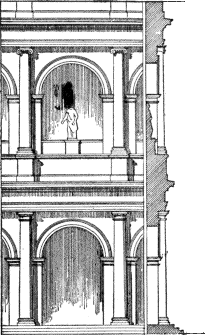
FIG. 45.—ROMAN ARCADE WITH ENGAGED COLUMNS
(From the Colosseum.)
ARCADES. The orders, though probably at first used only as
free supports in porticos and colonnades, were early applied as
decorations to arcaded structures. This practice became general with the
multiplication of many-storied arcades like those of the amphitheatres,
the engaged columns being set between the arches as buttresses,
supporting entablatures which marked the divisions into stories (Fig.
45). This combination has been assailed as a false and illogical device,
but the criticism proceeds from a too narrow conception of architectural
propriety. It is defensible upon both artistic and logical grounds; for
it not only furnishes a most desirable play of light and shade and a
pleasing contrast of rectangular and curved lines, but by emphasizing
the constructive divisions and elements of the building and the vertical
support of the piers, it also contributes to the expressiveness and
vigor of the design.
VAULTING. The Romans substituted vaulting in brick, concrete,
or masonry for wooden ceilings wherever possible, both in public and
private edifices. The Etruscans were
81
the first vault-builders, and the Cloaca Maxima, the great sewer of
Republican Rome (about 500 B.C.) still
remains as a monument of their engineering skill. Probably not only
Etruscan engineers (whose traditions were perhaps derived from Asiatic
sources in the remote past), but Asiatic builders also from conquered
eastern provinces, were engaged together in the development of the
wonderful system of vaulted construction to which Roman architecture so
largely owed its grandeur. Three types of vault were commonly used: the
barrel-vault, the groined or four-part vault, and the dome.

FIG. 46.—BARREL VAULT.
The barrel vault (Fig. 46) was generally semi-cylindrical in section,
and was used to cover corridors and oblong halls, like the
temple-cellas, or was bent around a curve, as in amphitheatre
passages.
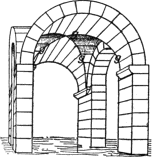
FIG. 47.—GROINED VAULT.
g, g, Groins.
The groined vault is formed by the intersection of two barrel-vaults
(Fig. 47). When several compartments of groined vaulting are placed
together over an oblong plan, a double advantage is secured.
Lateral windows can be carried up to the full height of the vaulting
instead of being stopped below its springing; and the weight and thrust
of the vaulting are concentrated upon a number of isolated points
instead of being exerted along the whole extent of the side walls, as
with the barrel-vault. The Romans saw that it was sufficient to dispose
the masonry at these points in masses at right angles to the length of
the hall, to best resist the lateral
82
thrust of the vault. This appears clearly in the plan of the Basilica of
Constantine (Fig. 58).
The dome was in almost all Roman examples supported on a circular
wall built up from the ground, as in the Pantheon (Fig. 54). The pendentive dome, sustained by four or
eight arches over a square or octagonal plan, is not found in true Roman
buildings.
The Romans made of the vault something more than a mere constructive
device. It became in their hands an element of interior effect at least
equally important with the arch and column. No style of architecture has
ever evolved nobler forms of ceiling than the groined vault and the
dome. Moreover, the use of vaulting made possible effects of
unencumbered spaciousness and amplitude which could never be compassed
by any combination of piers and columns. It also assured to the Roman
monuments a duration and a freedom from danger of destruction by fire
impossible with any wooden-roofed architecture, however noble its form
or careful its execution.
CONSTRUCTION. The constructive methods of the Romans varied
with the conditions and resources of different provinces, but were
everywhere dominated by the same practical spirit. Their vaulted
architecture demanded for the support of its enormous weights and for
resistance to its disruptive thrusts, piers and buttresses of great
mass. To construct these wholly of cut stone appeared preposterous and
wasteful to the Roman. Italy abounds in clay, lime, and a volcanic
product, pozzolana (from Puteoli or Pozzuoli, where it has always
been obtained in large quantities), which makes an admirable hydraulic
cement. With these materials it was possible to employ unskilled labor
for the great bulk of this massive masonry, and to erect with the
greatest rapidity and in the most economical manner those stupendous
piles which, even in their ruin, excite the admiration of every
beholder.
83
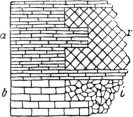
FIG. 48.—ROMAN WALL MASONRY.
a, Brickwork; b, Tufa ashlar; r, Opus reticulatum; i, Opus
incertum.
STONE, CONCRETE, AND BRICK MASONRY. For buildings of an
externally decorative character such as temples, arches of triumph, and
amphitheatres, as well as in all places where brick and concrete were
not easily obtained, stone was employed. The walls were built by laying
up the inner and outer faces in ashlar or cut stone, and filling
in the intermediate space with rubble (random masonry of uncut stone)
laid up in cement, or with concrete of broken stone and cement dumped
into the space in successive layers. The cement converted the whole into
a conglomerate closely united with the face-masonry. In Syria and Egypt
the local preference for stones of enormous size was gratified, and even
surpassed, as in Herod’s terrace-walls for the temple at Jerusalem (p. 41), and in the splendid structures of
Palmyra and Baalbec. In Italy, however, stones of moderate size were
preferred, and when blocks of unusual dimensions occur, they are in many
cases marked with false joints, dividing them into apparently smaller
blocks, lest they should dwarf the building by their large scale. The
general use in the Augustan period of marble for a decorative lining or
wainscot in interiors led in time to the objectionable practice of
coating buildings of concrete with an apparel of sham marble masonry, by
carving false joints upon an external veneer of thin slabs of that
material. Ordinary concrete walls were frequently faced with small
blocks of tufa, called, according to the manner of its application,
opus reticulatum, opus incertum, opus spicatum,
etc. (Fig. 48). In most cases, however, the facing was of carefully
executed brickwork, covered sometimes by a coating of stucco. The bricks
were large, measuring from one to two feet square where used for quoins
or arches, but triangular
84
where they served only as facings. Bricks were also used in the
construction of skeleton ribs for concrete vaults of large span.
VAULTING. Here, as in the wall-masonry, economy and common
sense devised methods extremely simple for accomplishing vast designs.
While the smaller vaults were, so to speak, cast in concrete upon moulds
made of rough boards, the enormous weight of the larger vaults precluded
their being supported, while drying or “setting,” upon timber centrings
built up from the ground. Accordingly, a skeleton of light ribs was
first built on wooden centrings, and these ribs, when firmly “set,”
became themselves supports for intermediate centrings on which to cast
the concrete fillings between the ribs. The whole vault, once hardened,
formed really a monolithic curved lintel, exerting no thrust whatever,
so that the extraordinary precautions against lateral disruption
practised by the Romans were, in fact, in many cases quite
superfluous.
DECORATION. The temple of Castor and Pollux in the Forum (long
miscalled the temple of Jupiter Stator), is a typical example of Roman
architectural decoration, in which richness was preferred to the subtler
refinements of design (see Fig. 44). The
splendid figure-sculpture which adorned the Greek monuments would have
been inappropriate on the theatres and thermæ of Rome or the provinces,
even had there been the taste or the skill to produce it. Conventional
carved ornament was substituted in its place, and developed into a
splendid system of highly decorative forms. Two principal elements
appear in this decoration—the acanthus-leaf, as the basis of a
whole series of wonderfully varied motives; and symbolism, represented
principally by what are technically termed
grotesques—incongruous combinations of natural forms, as
when an infant’s body terminates in a bunch of foliage (Fig. 49). Only
to a limited extent do we find true sculpture employed as
85
decoration, and that mainly for triumphal arches or memorial
columns.

FIG. 49—ROMAN CARVED ORNAMENT.
(Lateran Museum.)
The architectural mouldings were nearly always carved, the Greek
water-leaf and egg-and-dart forming the basis of most of the
enrichments; but these were greatly elaborated and treated with more
minute detail than the Greek prototypes. Friezes and bands were commonly
ornamented with the foliated scroll or rinceau (a convenient
French term for which we have no equivalent). This motive was as
characteristic of Roman art as the anthemion was of the Greek. It
consists of a continuous stem throwing out alternately on either side
branches which curl into spirals and are richly adorned with rosettes,
acanthus-leaves, scrolls, tendrils, and blossoms. In the best examples
the detail was modelled with great care and minuteness, and the motive
itself was treated with extraordinary variety and fertility of
invention. A derived and enriched form of the anthemion was
sometimes used for bands and friezes; and grotesques, dolphins,
griffins, infant genii, wreaths,
86
festoons, ribbons, eagles, and masks are also common features in Roman
relief carving.
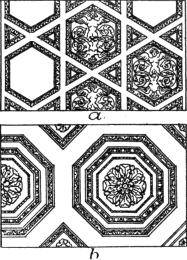
FIG. 50.—ROMAN CEILING PANELS.
(a, From Palmyra; b, Basilica of Constantine.)
The Romans made great use of panelling and of moulded plaster in
their interior decoration, especially for ceilings. The panelling of
domes and vaults was usually roughly shaped in their first construction
and finished afterward in stucco with rich moulding and rosettes. The
panels were not always square or rectangular, as in Greek ceilings, but
of various geometric forms in pleasing combinations (Fig. 50). In works
of a small scale the panels and decorations were wrought in relief in a
heavy coating of plaster applied to the finished structure, and these
stucco reliefs are among the most refined and charming products of Roman
art. (Baths of Titus; Baths at Pompeii; Palace of the Cæsars and tombs
at Rome.)
COLOR DECORATION. Plaster was also used as a ground for painting,
executed in distemper or by the encaustic process, wax liquefied by a hot iron
being the medium for applying the color in the latter case. Pompeii and
Herculaneum furnish countless examples of brilliant wall-painting in which
strong primary colors form the ground, and a semi-naturalistic, semi-fantastic
representation of figures, architecture and landscape is mingled with festoons,
vines, and purely conventional ornament. Mosaic was also employed to decorate
floors and wall-spaces, and sometimes for ceilings.13 The later imperial baths and palaces were especially
87
rich in mosaic of the kind called opus Grecanicum, executed with
numberless minute cubes of stone or glass, as in the Baths of Caracalla
and the Villa of Hadrian at Tivoli.
To the walls of monumental interiors, such as temples, basilicas, and
thermæ, splendor of color was given by veneering them with thin slabs of
rare and richly colored marble. No limit seems to have been placed upon
the costliness or amount of these precious materials. Byzantine
architecture borrowed from this practice its system of interior color
decoration.
88
ROMAN ARCHITECTURE—Continued.
Books Recommended: Same as for Chapter
VIII. Also, Guhl and Kohner, Life of the Ancient Greeks and
Romans. Adams, Ruins of the Palace of Spalato. Burn, Rome and the
Campagna. Cameron, Roman Baths. Mau, tr. by Kelcey,
Pompeii, its Life and Art. Mazois, Ruines de Pompeii. Von
Presuhn, Die neueste Ausgrabungen zu Pompeii. Wood, Ruins of
Palmyra and Baalbec.
THE ETRUSCAN STYLE. Although the first Greek architects were
employed in Rome as early as 493 B.C.,
the architecture of the Republic was practically Etruscan until nearly
100 B.C. Its monuments, consisting
mainly of city walls, tombs, and temples, are all marked by a general
uncouthness of detail, denoting a lack of artistic refinement, but they
display considerable constructive skill. In the Etruscan walls we meet
with both polygonal and regularly coursed masonry; in both kinds the
true arch appears as the almost universal form for gates and openings.
A famous example is the Augustan Gate at Perugia, a late work
rebuilt about 40 B.C., but thoroughly
Etruscan in style. At Volaterræ (Volterra) is another arched gate, and
in Perugia fragments of still another appear built into the modern
walls.
The Etruscans built both structural and excavated tombs; they
consisted in general of a single chamber with a slightly arched or
gabled roof, supported in the larger tombs on heavy square piers. The
interiors were covered with pictures; externally there was little
ornament except about the gable and doorway. The latter
89
had a stepped or moulded frame with curious crossettes or ears
projecting laterally at the top. The gable recalled the wooden roofs of
Etruscan temples, but was coarse in detail, especially in its mouldings.
Sepulchral monuments of other types are also met with, such as
cippi or memorial pillars, sometimes in groups of five on a
single pedestal (tomb at Albano).
Among the temples of Etruscan style that of Jupiter
Capitolinus on the Capitol at Rome, destroyed by fire in 80 B.C., was the chief. Three narrow chambers
side by side formed a cella nearly square in plan, preceded by a
hexastyle porch of huge Doric, or rather Tuscan, columns arranged in
three aisles, widely spaced and carrying ponderous wooden architraves.
The roof was of wood; the cymatium and ornaments, as well as the statues
in the pediment, were of terra-cotta, painted and gilded. The details in
general showed acquaintance with Greek models, which appeared in debased
and awkward imitations of triglyphs, cornices, antefixæ, etc.

FIG. 51.—TEMPLE FORTUNA VIRILIS. PLAN.
GREEK STYLE. The victories of Marcellus at Syracuse, 212 B.C., Fabius Maximus at Tarentum (209 B.C.), Flaminius (196 B.C.), Mummius (146 B.C.), Sulla (86 B.C.), and others in the various Greek provinces,
steadily increased the vogue of Greek architecture and the number of
Greek artists in Rome. The temples of the last two centuries B.C., and some of earlier date, though still
Etruscan in plan, were in many cases strongly Greek in the character of
their details. A few have remained to our time in tolerable
preservation. The temple of Fortuna
90
Virilis (really of Fors Fortuna), of the second century (?) B.C., is a tetrastyle prostyle
pseudoperipteral temple with a high podium or base,
a typical Etruscan cella, and a deep porch, now walled up, but
thoroughly Greek in the elegant details of its Ionic order (Fig. 51).
Two circular temples, both called erroneously Temples of Vesta,
one at Rome near the Cloaca Maxima, the other at Tivoli, belong among
the monuments of Greek style. The first was probably dedicated to
Hercules, the second probably to the Sibyls; the latter being much the
better preserved of the two. Both were surrounded by peristyles of
eighteen Corinthian columns, and probably covered by domical roofs with
gilded bronze tiles. The Corinthian order appears here complete with its
modillion cornice, but the crispness of the detail and the fineness of
the execution are Greek and not Roman. These temples date from about 72
B.C., though the one at Rome was
probably rebuilt in the first century A.D. (Fig. 52).

FIG. 52.—CIRCULAR TEMPLE. TIVOLI.
IMPERIAL ARCHITECTURE; AUGUSTAN AGE. Even in the temples of
Greek style Roman conceptions of plan and composition are dominant. The
Greek architect was not free to reproduce textually Greek designs or
details, however strongly he might impress with the Greek character
whatever he touched. The demands of imperial splendor
91
and the building of great edifices of varied form and complex structure,
like the thermæ and amphitheatres, called for new adaptations and
combinations of planning and engineering. The reign of Augustus (27
B.C.-14 A.D.) inaugurated the imperial epoch, but many works
erected before and after his reign properly belong to the Augustan age
by right of style. In general, we find in the works of this period the
happiest combination of Greek refinement with Roman splendor. It was in
this period that Rome first assumed the aspect of an opulent and
splendid metropolis, though the way had been prepared for this by the
regularization and adornment of the Roman Forum and the erection of many
temples, basilicas, fora, arches, and theatres during the generation
preceding the accession of Augustus. His reign saw the inception or
completion of the portico of Octavia, the Augustan forum, the Septa
Julia, the first Pantheon, the adjoining Thermæ of Agrippa, the theatre
of Marcellus, the first of the imperial palaces on the Palatine, and a
long list of temples, including those of the Dioscuri (Castor and
Pollux), of Mars Ultor, of Jupiter Tonans on the Capitol, and others in
the provinces; besides colonnades, statues, arches, and other
embellishments almost without number.
LATER IMPERIAL WORKS. With the successors of Augustus splendor
increased to almost fabulous limits, as, for instance, in the vast
extent and the prodigality of ivory and gold in the famous Golden House
of Nero. After the great fire in Rome, presumably kindled by the agents
of this emperor, a more regular and monumental system of
street-planning and building was introduced, and the first municipal
building-law was decreed by him. To the reign of Vespasian (68–79
A.D.) we owe the rebuilding in Roman
style and with the Corinthian order of the temple of Jupiter
Capitolinus, the Baths of Titus, and the beginning of the Flavian
amphitheatre or Colosseum. The two last-named
92
edifices both stood on the site of Nero’s Golden House, of which the
greater part was demolished to make way for them. During the last years
of the first century the arch of Titus was erected, the Colosseum
finished, amphitheatres built at Verona, Pola, Reggio, Tusculum, Nîmes
(France), Constantine (Algiers), Pompeii and Herculanum (these last two
cities and Stabiæ rebuilt after the earthquake of 63 A.D.), and arches, bridges, and temples erected all
over the Roman world.
The first part of the second century was distinguished by the
splendid architectural achievements of the reign of Hadrian
(117–138 A.D.) in Rome and the
provinces, especially Athens. Nearly all his works were marked by great
dignity of conception as well as beauty of detail. During the latter
part of the century a very interesting series of buildings were erected
in the Hauran (Syria), in which Greek and Arab workmen under Roman
direction produced examples of vigorous stone architecture of a mingled
Roman and Syrian character.
The most-remarkable thermæ of Rome belong to the third
century—those of Caracalla (211–217 A.D.) and of Diocletian (284–305 A.D.)—their ruins to-day ranking among the
most imposing remains of antiquity. In Syria the temples of the Sun at
Baalbec and Palmyra (273 A.D., under
Aurelian), and the great palace of Diocletian at Spalato, in Dalmatia
(300 A.D.), are still the wonder of
the few travellers who reach those distant spots.
While during the third and fourth centuries there was a marked
decline in purity and refinement of detail, many of the later works of
the period display a remarkable freedom and originality in conception.
But these works are really not Roman, they are foreign, that is,
provincial products; and the transfer of the capital to Byzantium
revealed the increasing degree in which Rome was coming to look to the
East for her strength and her art.
93
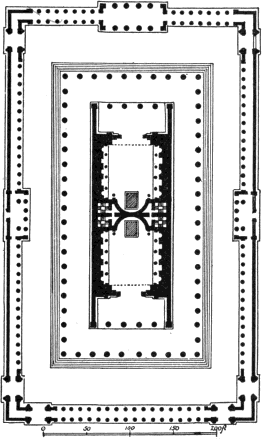
FIG. 53.—TEMPLE OF VENUS AND ROME. PLAN.
TEMPLES. The Romans built both rectangular and circular
temples, and there was much variety in their treatment. In the
rectangular temples a high podium, or basement, was substituted
for the Greek stepped stylobate, and the prostyle plan was more common
than the peripteral. The cella was relatively short and wide, the front
porch inordinately deep, and frequently divided by longitudinal rows of
columns into three aisles. In most cases the exterior of the cella in
prostyle temples was decorated by engaged columns. A barrel vault
gave the interior an aspect of spaciousness impossible with the Greek
system of a wooden ceiling supported on double ranges of columns. In the
place of these, free or engaged columns along the side-walls received
the ribs of the vaulting. Between these ribs the ceiling was richly
panelled, or coffered and sumptuously gilded. The temples of Fortuna
Virilis and of Faustina at Rome (the latter built 141 A.D., and its ruins incorporated into the
modern church of S. Lorenzo in Miranda), and the beautiful and
admirably preserved Maison
94
Carrée, at Nîmes (France) (4 A.D.) are examples of this type. The temple of
Concord, of which only the podium remains, and the small temple
of Julius (both of these in the Forum) illustrate another form of
prostyle temple in which the porch was on a long side of the cella. Some
of the larger temples were peripteral. The temple of the Dioscuri
(Castor and Pollux) in the Forum, was one of the most magnificent of
these, certainly the richest in detail (Fig. 44). Very remarkable was the double temple of
Venus and Rome, east of the Forum, designed by the Emperor
Hadrian about 130 A.D. (Fig. 53). It
was a vast pseudodipteral edifice containing two cellas in one
structure, their statue-niches or apses meeting back to back in the
centre. The temple stood in the midst of an imposing columnar peribolus
entered by magnificent gateways. Other important temples have already
been mentioned on p. 91.
Besides the two circular temples already described, the temple of
Vesta, adjoining the House of the Vestals, at the east end of the Forum
should be mentioned. At Baalbec is a circular temple whose entablature
curves inward between the widely-spaced columns until it touches the
cella in the middle of each intercolumniation. It illustrates the
caprices of design which sometimes resulted from the disregard of
tradition and the striving after originality (273 A.D.).
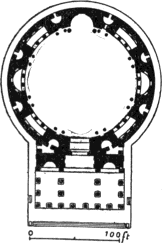
FIG. 54.—PLAN OF THE PANTHEON.
THE PANTHEON. The noblest of all circular temples of Rome and
of the world was the Pantheon. It was built by Hadrian,
117–138 A.D., on the site of the
earlier rectangular temple of the same name erected by Agrippa. It
measures 142 feet in diameter
95
internally; the wall is 20 feet thick and supports a hemispherical dome
rising to a height of 140 feet (Figs. 54, 55). Light is admitted solely
through a round opening 28 feet in diameter at the top of the dome, the
simplest and most impressive method of illumination conceivable.
The rain and snow that enter produce no appreciable effect upon the
temperature of the vast hall. There is a single entrance, with noble
bronze doors, admitting directly to the interior, around which seven
niches, alternately rectangular and semicircular in plan and fronted by
Corinthian columns, lighten, without weakening, the mass of the
encircling wall. This wall was originally incrusted with rich marbles,
and the great dome, adorned with deep coffering in rectangular panels,
was decorated with rosettes and mouldings in gilt stucco. The dome
appears to have been composed of numerous arches and ribs, filled in and
finally coated with concrete. A recent examination of a denuded
portion of its inner surface has convinced the writer that the interior
panelling was executed after, and not during, its construction, by
hewing the panels out of the mass of brick and concrete, without regard
to the form and position of the origin skeleton of ribs.

FIG. 55.—INTERIOR OF THE PANTHEON.
The exterior (Fig. 56) was less successful than the interior.
96
The gabled porch of twelve superb granite columns 50 feet high,
three-aisled in plan after the Etruscan mode, and covered originally by
a ceiling of bronze, was a rebuilding with the materials and on the plan
of the original pronaos of the Pantheon of Agrippa. The circular wall
behind it is faced with fine brickwork, and displays, like the dome,
many curious arrangements of discharging arches, reminiscences of
traditional constructive precautions here wholly useless and fictitious
because only skin-deep. A revetment of marble below and plaster
above once concealed this brick facing. The portico, in spite of its too
steep gable (once filled with a “gigantomachia” in gilt bronze) and its
somewhat awkward association with a round building, is nevertheless a
noble work, its capitals in Pentelic marble ranking among the finest
known examples of the Roman Corinthian. Taken as a whole, the Pantheon
is one of the great masterpieces of the world’s architecture.

FIG. 56.—EXTERIOR OF THE PANTHEON.
(From model in Metropolitan Museum, New York.)
97
FORA AND BASILICAS. The fora were the places for general
public assemblage. The chief of those in Rome, the Forum Magnum,
or Forum Romanum, was at first merely an irregular vacant space,
about and in which, as the focus of the civic life, temples, halls,
colonnades, and statues gradually accumulated. These chance aggregations
the systematic Roman mind reduced in time to orderly and monumental
form; successive emperors extended them and added new fora at enormous
cost and with great splendor of architecture. Those of Julius, Augustus,
Vespasian, and Nerva (or Domitian), adjoining the Roman Forum, were
magnificent enclosures surrounded by high walls and single or double
colonnades. Each contained a temple or basilica, besides gateways,
memorial columns or arches, and countless statues. The Forum of
Trajan surpassed all the rest; it covered an area of thirty-five
thousand square yards, and included, besides the main area, entered
through a triumphal arch, the Basilica Ulpia, the temple of Trajan, and
his colossal Doric column of Victory. Both in size and beauty it ranked
as the chief architectural glory of the city (Fig. 57). The six fora
together contained thirteen temples, three basilicas, eight triumphal
arches, a mile of porticos, and a number of other public
edifices.14 Besides
98
these, a net-work of colonnades covered large tracts of the city,
affording sheltered communication in every direction, and here and there
expanding into squares or gardens surrounded by peristyles.
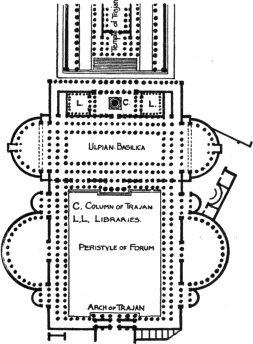
FIG. 57.—FORUM AND BASILICA OF TRAJAN.
Larger View
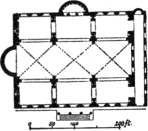
FIG. 58.—BASILICA OF CONSTANTINE. PLAN.
The public business of Rome, both judicial and commercial, was
largely transacted in the basilicas, large buildings consisting
usually of a wide and lofty central nave flanked by lower side-aisles,
and terminating at one or both ends in an apse or semicircular recess
called the tribune, in which were the seats for the magistrates.
The side-aisles were separated from the nave by columns supporting a
clearstory wall, pierced by windows above the roofs of the side-aisles.
In some cases the latter were two stories high, with galleries; in
others the central space was open to the sky, as at Pompeii, suggesting
the derivation of the basilica from the open square surrounded by
colonnades, or from the forum itself, with which we find it usually
associated. The most important basilicas in Rome were the
Sempronian, the Æmilian (about 54 B.C.), the Julian in the Forum Magnum (51
B.C.), and the Ulpian in the
Forum of Trajan (113 A.D.). The last
two were probably open basilicas, only the side-aisles being roofed. The
Ulpian (Fig. 57) was the most magnificent of all, and in conjunction
with the Forum of Trajan formed one of the most imposing of those
monumental aggregations of columnar architecture which contributed so
largely to the splendor of the Roman capital.

FIG. 59.—BASILICA OF CONSTANTINE. RUINS.
These monuments frequently suffered from the burning of their wooden
roofs. It was Constantine who completed the first vaulted and fireproof
basilica, begun by his predecessor and rival, Maxentius, on the site of
the former Temple of Peace (Figs. 58, 59). Its design reproduced on a
99
grand scale the plan of the tepidarium-halls of the thermæ, the
side-recesses of which were converted into a continuous side-aisle by
piercing arches through the buttress-walls that separated them. Above
the imposing vaults of these recesses and under the cross-vaults of the
nave were windows admitting abundant light. A narthex, or
porch, preceded the hall at one end; there were also a side entrance
from the Via Sacra, and an apse or tribune for the magistrates opposite
each of these entrances. The dimensions of the main hall (325 × 85
feet), the height of its vault (117 feet), and the splendor of its
columns and incrustations excited universal admiration, and exercised a
powerful influence on later architecture.
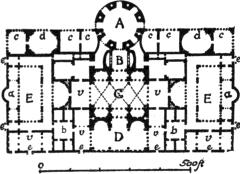
FIG. 60.—THERMÆ OF CARACALLA. PLAN OF CENTRAL BLOCK.
A, Caldarium, or Hot Bath; B, Intermediate Chamber; C, Tepidarium, or
Warm Bath; D, Frigidarium, or Cold Bath; E, Peristyles; a, Gymnastic
Rooms; b, Dressing Rooms; c, Cooling Rooms; d, Small Courts; e,
Entrances; v, Vestibules.
Larger View
THERMÆ. The leisure of the Roman people was largely spent in
the great baths, or thermæ, which took the place substantially of
the modern club. The establishments
100
erected by the emperors for this purpose were vast and complex congeries
of large and small halls, courts, and chambers, combined with a masterly
comprehension of artistic propriety and effect in the sequence of
oblong, square, oval, and circular apartments, and in the relation of
the greater to the lesser masses. They were a combination of the Greek
palæstra with the Roman balnea, and united in one
harmonious design great public swimming-baths, private baths for
individuals and families, places for gymnastic exercises and games,
courts, peristyles, gardens, halls for literary entertainments,
lounging-rooms, and all the complex accommodation required for the
service of the whole establishment. They were built with apparent
disregard of cost, and adorned with splendid extravagance. The earliest
were the Baths of Agrippa (27 B.C.) behind the Pantheon; next may be mentioned
those of Titus, built on the substructions of Nero’s Golden
House. The remains of the Thermæ of Caracalla (211 A.D.) form the most extensive mass of ruins in Rome,
and clearly display the admirable planning of this and similar
establishments. A gigantic block of buildings containing the three
great halls for cold, warm, and hot baths, stood in the centre of a vast
enclosure surrounded by private baths, exedræ, and halls for
lecture-audiences and other gatherings. The enclosure was adorned with
statues, flower-gardens, and places for out-door games. The Baths of
Diocletian (302 A.D.) embodied
this arrangement
101
on a still more extensive scale; they could accommodate 3,500 bathers at
once, and their ruins cover a broad territory near the railway terminus
of the modern city. The church of S. Maria degli Angeli was formed
by Michael Angelo out of the tepidarium of these
baths—a colossal hall 340 × 87 feet, and 90 feet high. The
original vaulting and columns are still intact, and the whole interior
most imposing, in spite of later stucco disfigurements. The circular
laconicum (sweat-room) serves as the porch to the present church.
It was in the building of these great halls that Roman architecture
reached its most original and characteristic expression. Wholly
unrelated to any foreign model, they represent distinctively Roman
ideals, both as to plan and construction.

FIG. 61.—ROMAN THEATRE. (HERCULANUM.)
(From model.)
PLACES OF AMUSEMENT. The earliest Roman theatres differed from
the Greek in having a nearly semicircular plan, and in being built up
from the level ground, not excavated in a hillside (Fig. 61). The first
theatre was of wood, built by Mummius 145 B.C., and it was not until ninety years later that
stone was first substituted for the more perishable material, in the
theatre of Pompey. The Theatre of Marcellus (23–13 B.C.) is in part still extant, and later
theatres in Pompeii, Orange (France), and in the Asiatic provinces are
in excellent preservation. The orchestra was not, as in the Greek
theatre, reserved for the choral dance, but was given up to spectators
of rank; the stage was adorned with a permanent architectural background
of columns and
102
arches, and sometimes roofed with wood, and an arcade or colonnade
surrounded the upper tier of seats. The amphitheatre was a still more
distinctively Roman edifice. It was elliptical in plan, surrounding an
elliptical arena, and built up with continuous encircling tiers of
seats. The earliest stone amphitheatre was erected by Statilius Taurus
in the time of Augustus. It was practically identical in design with the
later and much larger Flavian amphitheatre, commonly known as the
Colosseum, begun by Vespasian and completed 82 A.D. (Fig. 62). This immense structure measured 607
× 506 feet in plan and was 180 feet high; it could accommodate
eighty-seven thousand spectators. Engaged columns of the Tuscan, Ionic,
and Corinthian orders decorated three stories of the exterior; the
fourth was a nearly unbroken wall with slender Corinthian pilasters.
Solidly constructed of travertine, concrete, and tufa, the Colosseum,
with its imposing but monotonous exterior, almost sublime by its scale
and seemingly endless repetition, but lacking in refinement or
originality of detail and dedicated to bloody and cruel sports, was a
characteristic product of the Roman character and civilization. At
Verona, Pola,
103
Capua, and many cities in the foreign provinces there are well-preserved
remains of similar structures.
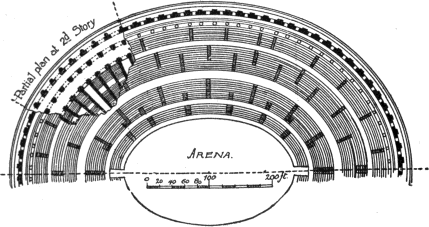
FIG. 62.—COLOSSEUM. HALF PLAN.
Closely related to the amphitheatre were the circus and the stadium.
The Circus Maximus between the Palatine and Aventine hills was
the oldest of those in Rome. That erected by Caligula and Nero on the
site afterward partly occupied by St. Peter’s, was more splendid, and is
said to have been capable of accommodating over three hundred thousand
spectators after its enlargement in the fourth century. The long, narrow
race-course was divided into two nearly equal parts by a low parapet,
the spina, on which were the goals (metæ) and many small
decorative structures and columns. One end of the circus, as of the
stadium also, was semicircular; the other was segmental in the circus,
square in the stadium; a colonnade or arcade ran along the top of
the building, and the entrances and exits were adorned with monumental
arches.

FIG. 63.—ARCH OF CONSTANTINE.
(From model in Metropolitan Museum, New York.)
TRIUMPHAL ARCHES AND COLUMNS. Rome and the provincial cities
abounded in monuments commemorative of victory, usually single or triple
arches with engaged columns and rich sculptural adornments, or single
colossal columns supporting statues. The arches were characteristic
products of Roman design, and some of them deserve high praise for the
excellence of their proportions and the elegance of their details. There
were in Rome in the second century A.D., thirty-eight of these monuments. The Arch
of Titus (71–82 A.D.) is the
simplest and most perfect of those still extant in Rome; the arch of
Septimius Severus in the Forum (203 A.D.) and that of Constantine (330 A.D.) near the Colosseum, are more sumptuous
but less pure in detail. The last-named was in part enriched with
sculptures taken from the earlier arch of Trajan. The statues of Dacian
captives on the attic (attic = a species of subordinate story
added above the main cornice) of this arch were a fortunate addition,
furnishing a raison-d’être
104
for the columns and broken entablatures on which they rest. Memorial
columns of colossal size were erected by several emperors, both in Rome
and abroad. Those of Trajan and of Marcus Aurelius are
still standing in Rome in perfect preservation. The first was 140 feet
high including the pedestal and the statue which surmounted it; its
capital marked the height of the ridge levelled by the emperor for the
forum on which the column stands. Its most striking peculiarity is the
spiral band of reliefs winding around the shaft from bottom to top and
representing the Dacian campaigns of Trajan. The other column is of
similar design and dimensions, but greatly inferior to the first in
execution. Both are really towers, with interior stair-cases leading to
the top.
TOMBS. The Romans developed no special and national type of
tomb, and few of their sepulchral monuments were of large dimensions.
The most important in Rome were the pyramid of Caius Cestius
(late first century B.C.), and the
circular tombs of Cecilia Metella (60 B.C.), Augustus (14 A.D.) and Hadrian, now the Castle of
S. Angelo (138 A.D.). The latter
was composed of a huge cone of marble supported on a cylindrical
structure 230 feet in diameter standing on a square podium 300 feet long
and wide. The cone probably once terminated in the gilt bronze pine-cone
now in the Giardino della Pigna of the Vatican. In the Mausoleum of
Augustus a mound of earth planted with trees
105
crowned a similar circular base of marble on a podium 220 feet square,
now buried.
The smaller tombs varied greatly in size and form. Some were vaulted
chambers, with graceful internal painted decorations of figures and vine
patterns combined with low-relief enrichments in stucco. Others were
designed in the form of altars or sarcophagi, as at Pompeii; while
others again resembled ædiculæ, little temples, shrines, or small towers
in several stories of arches and columns, as at St. Rémy (France).
PALACES AND DWELLINGS. Into their dwellings the Romans carried
all their love of ostentation and personal luxury. They anticipated in
many details the comforts of modern civilization in their furniture,
their plumbing and heating, and their utensils. Their houses may be
divided into four classes: the palace, the villa, the domus or
ordinary house, and the insula or many-storied tenement built in
compact blocks. The first three alone concern us, and will be taken up
in the above order.
The imperial palaces on the Palatine Hill comprised a wide
range in style and variety of buildings, beginning with the first simple
house of Augustus (26 B.C.), burnt and
rebuilt 3 A.D. Tiberius,
Caligula, and Nero added to the Augustan group; Domitian rebuilt a
second time and enlarged the palace of Augustus, and Septimius Severus
remodelled the whole group, adding to it his own extraordinary
seven-storied palace, the Septizonium. The ruins of these successive
buildings have been carefully excavated, and reveal a remarkable
combination of dwelling-rooms, courts, temples, libraries, basilicas,
baths, gardens, peristyles, fountains, terraces, and covered passages.
These were adorned with a profusion of precious marbles, mosaics,
columns, and statues. Parts of the demolished palace of Nero were
incorporated in the substructions of the Baths of Titus. The beautiful
arabesques and plaster reliefs
106
which adorned them were the inspiration of much of the fresco and stucco
decoration of the Italian Renaissance. At Spalato, in Dalmatia, are the
extensive ruins of the great Palace of Diocletian, which was laid
out on the plan of a Roman camp, with two intersecting avenues (Fig.
64). It comprised a temple, mausoleum, basilica, and other structures
besides those portions devoted to the purposes of a royal residence.
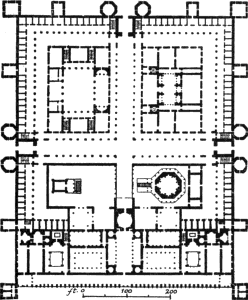
FIG. 64.—PALACE OF DIOCLETIAN. SPALATO.
The villa was in reality a country palace, arranged with
special reference to the prevailing winds, exposure to the sun and
shade, and the enjoyment of a wide prospect. Baths, temples,
exedræ, theatres, tennis-courts, sun-rooms, and shaded porticoes
were connected with the house proper, which was built around two or
three interior courts or peristyles. Statues, fountains, and colossal
vases of marble adorned the grounds, which were laid out in terraces and
treated with all the fantastic arts of the Roman landscape-gardener. The
most elaborate and extensive villa was that of Hadrian, at Tibur
(Tivoli); its ruins, covering hundreds of acres, form one of the most
interesting spots to visit in the neighborhood of Rome.
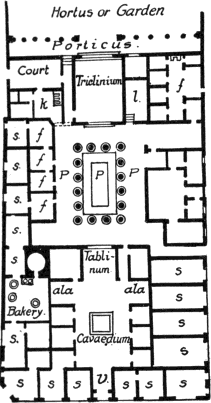
FIG. 65.—HOUSE OF PANSA, POMPEII.
s, Shops; v, Vestibule; f, Family Rooms; k, Kitchen; l, Lavarium;
P, P, P, Peristyles.
There are few remains in Rome of the domus or private house.
Two, however, have left remarkably interesting ruins—the Atrium
Vestæ, or House of the Vestal Virgins,
107
east of the Forum, a well-planned and extensive house surrounding a
cloister or court; and the House of Livia, so-called, on the
Palatine Hill, the walls and decorations of which are excellently
preserved. The typical Roman house in a provincial town is best
illustrated by the ruins of Pompeii and Herculanum, which, buried by an
eruption of Vesuvius in 79 A.D., have
been partially excavated since 1721. The Pompeiian house (Fig. 65)
consisted of several courts or atria, some of which were
surrounded by colonnades and called peristyles. The front portion
was reserved for shops, or presented to the street a wall unbroken save
by the entrance; all the rooms and chambers opened upon the interior
courts, from which alone they borrowed their light. In the brilliant
climate of southern Italy windows were little needed, as sufficient
light was admitted by the door, closed only by portières for the most
part; especially as the family life was passed mainly in the shaded
courts, to which fountains, parterres of shrubbery, statues, and other
adornments lent their inviting charm. The general plan of these houses
seems to have been of Greek origin, as well as the system of decoration
used on the walls. These, when not wainscoted with
108
marble, were covered with fantastic, but often artistic, painted
decorations, in which an imaginary architecture as of metal,
a fantastic and arbitrary perspective, illusory pictures, and
highly finished figures were the chief elements. These were executed in
brilliant colors with excellent effect. The houses were lightly built,
with wooden ceilings and roofs instead of vaulting, and usually with but
one story on account of the danger from earthquakes. That the
workmanship and decoration were in the capital often superior to what
was to be found in a provincial town like Pompeii, is evidenced by
beautiful wall-paintings and reliefs discovered in Rome in 1879 and now
preserved in the Museo delle Terme. More or less fragmentary remains of
Roman houses have been found in almost every corner of the Roman empire,
but nowhere exhibiting as completely as in Pompeii the typical Roman
arrangement.
WORKS OF UTILITY. A word should be said about Roman
engineering works, which in many cases were designed with an artistic
sense of proportion and form which raises them into the domain of
genuine art. Such were especially the bridges, in which a remarkable
effect of monumental grandeur was often produced by the form and
proportions of the arches and piers, and an appropriate use of rough and
dressed masonry, as in the Pons Ælius (Ponte S. Angelo), the great
bridge at Alcantara (Spain), and the Pont du Gard, in southern France.
The aqueducts are impressive rather by their length, scale, and
simplicity, than by any special refinements of design, except where
their arches are treated with some architectural decoration to form
gates, as in the Porta Maggiore, at Rome.
MONUMENTS: (Those which have no important extant remains are
given in italics.) Temples: Jupiter
Capitolinus, 600 B.C.; Ceres,
Liber, and Libera, 494 B.C. (ruins
of later rebuilding in S. Maria in Cosmedin); first T. of
Concord (rebuilt in Augustan age), 254 B.C.; first marble temple in portico of
Metellus, by a Greek, Hermodorus, 143 B.C.; temples of Fortune at
109
Præneste and at Rome, and of “Vesta” at Rome, 83–78 B.C.; of “Vesta” at Tivoli, and of Hercules at Cori,
72 B.C.; first Pantheon, 27
B.C. In Augustan Age temples of
Apollo, Concord rebuilt, Dioscuri, Julius, Jupiter
Stator, Jupiter Tonans, Mars Ultor, Minerva (at Rome
and Assisi), Maison Carrée at Nîmes, Saturn; at Puteoli, Pola, etc.
T. of Peace; T. Jupiter Capitolinus, rebuilt 70
A.D.; temple at Brescia. Temple of
Vespasian, 96 A.D.; also of
Minerva in Forum of Nerva; of Trajan, 117 A.D.; second Pantheon; T. of Venus and Rome at
Rome, and of Jupiter Olympius at Athens, 135–138 A.D.; Faustina, 141 A.D.; many in Syria; temples of Sun at Rome,
Baalbec, and Palmyra, cir. 273 A.D.;
of Romulus, 305 A.D. (porch
S. Cosmo and Damiano). Places of
Assembly: Fora—Roman,
Julian, 46 B.C.; Augustan, 40–42
B.C.; of Peace, 75 A.D.; Nerva, 97 A.D.; Trajan (by Apollodorus of Damascus, 117 A.D.) Basilicas: Sempronian, Æmilian, 1st
century B.C.; Julian, 51 B.C.; Septa Julia, 26 B.C.; the Curia, later rebuilt by Diocletian, 300
A.D. (now Church of S. Adriano);
at Fano, 20 A.D. (?); Forum and
Basilica at Pompeii, 60 A.D.; of
Trajan; of Constantine, 310–324 A.D. Theatres (th.)
and Amphitheatres (amp.): th.
Pompey, 55 B.C.; of
Balbus and of Marcellus, 13 B.C.; th. and amp. at Pompeii and Herculanum;
Colosseum at Rome, 78–82 A.D.;
th. at Orange and in Asia Minor; amp. at Albano, Constantine, Nîmes,
Petra, Pola, Reggio, Trevi, Tusculum, Verona, etc.; amp. Castrense at
Rome, 96 A.D. Circuses and stadia at
Rome. Thermæ: of Agrippa, 27 B.C.; of Nero; of Titus, 78 A.D. Domitian, 90 A.D.; Caracalla, 211 A.D.; Diocletian, 305 A.D.; Constantine, 320 A.D.; “Minerva Medica,” 3d or 4th century A.D. Arches: of Stertinius, 196 B.C.; Scipio, 190 B.C.; Augustus, 30 B.C.; Titus, 71–82 A.D.; Trajan, 117 A.D.; Severus, 203 A.D.; Constantine, 320 A.D.; of Drusus, Dolabella, Silversmiths, 204 A.D.; Janus Quadrifrons, 320 A.D. (?); all at Rome. Others at Benevento, Ancona,
Rimini in Italy; also at Athens, and at Reims and St. Chamas in France.
Columns of Trajan, Antoninus, Marcus Aurelius at Rome, others at
Constantinople, Alexandria, etc. Tombs:
along Via Appia and Via Latina, at Rome; Via Sacra at Pompeii;
tower-tombs at St. Rémy in France; rock-cut at Petra; at Rome, of Caius
Cestius and Cecilia Metella, 1st century B.C.; of Augustus, 14 A.D.; Hadrian, 138 A.D. Palaces and
Private Houses: On Palatine, of
Augustus, Tiberius, Nero, Domitian, Septimius Severus,
Elagabalus; Villa of Hadrian at Tivoli; palaces of Diocletian at
Spalato and of Constantine at Constantinople. House of Livia on
Palatine (Augustan period); of Vestals, rebuilt by Hadrian, cir. 120
A.D. Houses at Pompeii and Herculanum,
cir. 60–79 A.D.; Villas of
Gordianus (“Tor’ de’ Schiavi,” 240 A.D.), and of Sallust at Rome and of
Pliny at Laurentium.
110
EARLY CHRISTIAN ARCHITECTURE.
Books Recommended: Bunsen, Die
Basiliken christlichen Roms. Butler, Architecture and other Arts
in Northern Central Syria. Corroyer, L’architecture romane.
Cummings, A History of Architecture in Italy. Essenwein
(Handbuch d. Architektur), Ausgänge der klassischen Baukunst.
Gutensohn u. Knapp, Denkmäler der
christlichen Religion. Hübsch, Monuments de l’architecture
chrétienne. Lanciani, Pagan and Christian Rome. Mothes,
Die Basilikenform bei den Christen, etc. Okely, Development of
Christian Architecture in Italy. Von Quast, Die altchristlichen
Bauwerke zu Ravenna. De Rossi, Roma Sotterranea. De Vogüé,
Syrie Centrale; Églises de la Terre Sainte.
INTRODUCTORY. The official recognition of Christianity in the
year 328 by Constantine simply legalized an institution which had been
for three centuries gathering momentum for its final conquest of the
antique world. The new religion rapidly enlisted in its service for a
common purpose and under a common impulse races as wide apart in blood
and culture as those which had built up the art of imperial Rome. It was
Christianity which reduced to civilization in the West the Germanic
hordes that had overthrown Rome, bringing their fresh and hitherto
untamed vigor to the task of recreating architecture out of the decaying
fragments of classic art. So in the East its life-giving influence awoke
the slumbering Greek art-instinct to new triumphs in the arts of
building, less refined and perfect indeed, but not less sublime than
those of the Periclean age. Long before the Constantinian edict, the
Christians in the Eastern provinces had enjoyed substantial freedom of
worship. Meeting often in the private basilicas of wealthy converts, and
111
finding these, and still more the great public basilicas, suited to the
requirements of their worship, they early began to build in imitation of
these edifices. There are many remains of these early churches in
northern Africa and central Syria.
EARLY CHRISTIAN ART IN ROME. This was at first wholly
sepulchral, developing in the catacombs the symbols of the new faith.
Once liberated, however, Christianity appropriated bodily for its public
rites the basilica-type and the general substance of Roman architecture.
Shafts and capitals, architraves and rich linings of veined marble, even
the pagan Bacchic symbolism of the vine, it adapted to new uses in its
own service. Constantine led the way in architecture, endowing Bethlehem
and Jerusalem with splendid churches, and his new capital on the
Bosphorus with the first of the three historic basilicas dedicated to
the Holy Wisdom (Hagia Sophia). One of the greatest of innovators, he
seems to have had a special predilection for circular buildings, and the
tombs and baptisteries which he erected in this form, especially that
for his sister Constantia in Rome (known as Santa Costanza, Fig. 66),
furnished the prototype for numberless Italian baptisteries in later
ages.
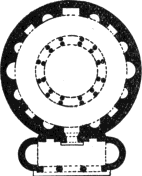
FIG. 66.—STA. COSTANZA, ROME.
The Christian basilica (see Figs. 67, 68) generally comprised a broad
and lofty nave, separated by rows of columns from the single or double
side-aisles. The aisles had usually about half the width and height of
the nave, and like it were covered with wooden roofs and ceilings. Above
the columns which flanked the nave rose the lofty clearstory wall,
pierced with windows above the side-aisle roofs and supporting the
immense trusses of the roof of the nave. The timbering of
112
the latter was sometimes bare, sometimes concealed by a richly panelled
ceiling, carved, gilded, and painted. At the further end of the nave was
the sanctuary or apse, with the seats for the clergy on a raised
platform, the bema, in front of which was the altar. Transepts
sometimes expanded to right and left before the altar, under which was
the confessio or shrine of the titular saint or martyr.
An atrium or forecourt surrounded by a covered arcade preceded
the basilica proper, the arcade at the front of the church forming a
porch or narthex, which, however, in some cases existed without
the atrium. The exterior was extremely plain; the interior, on the
contrary, was resplendent with incrustations of veined marble and with
sumptuous decorations in glass mosaic (called opus Grecanicum) on
a blue or golden ground. Especially rich were the half-dome of the apse
and the wall-space surrounding its arch and called the triumphal
arch; next in decorative importance came the broad band of wall
beneath the clearstory windows. Upon these surfaces the mosaic-workers
wrought with minute cubes of colored glass pictures and symbols almost
imperishable, in which the glow of color and a certain decorative
grandeur of effect in the composition went far to atone for the uncouth
drawing. With growing wealth and an increasingly elaborate ritual, the
furniture and equipments of the church assumed greater architectural
importance. A large rectangular space was retained for the choir in
front of the bema, and enclosed by a breast-high parapet of marble,
richly inlaid. On either side were the pulpits or ambones for the
Gospel and Epistle. A lofty canopy was built over the altar, the
baldaquin, supported on four marble columns. A few basilicas
were built with side-aisles, in two stories, as in S. Lorenzo and
Sta. Agnese. Adjoining the basilica in the earlier examples were the
baptistery and the tomb of the saint, circular or polygonal buildings
usually; but in later times these were replaced
113
by the font or baptismal chapel in the church and the confessio
under the altar.
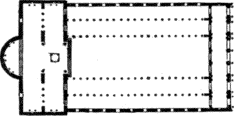
FIG. 67.—PLAN OF THE BASILICA OF ST. PAUL.
Of the two Constantinian basilicas in Rome, the one dedicated to
St. Peter was demolished in the fifteenth century; that of St.
John Lateran has been so disfigured by modern alterations as to be
unrecognizable. The former of the two adjoined the site of the martyrdom
of St. Peter in the circus of Caligula and Nero; it was five-aisled, 380
feet in length by 212 feet in width. The nave was 80 feet wide and 100
feet high, and the disproportionately high clearstory wall rested on
horizontal architraves carried by columns. The impressive dimensions and
simple plan of this structure gave it a majesty worthy of its rank as
the first church of Christendom. St. Paul beyond the Walls
(S. Paolo fuori le mura), built in 386 by Theodosius, resembled St.
Peter’s closely in plan (Figs. 67, 68). Destroyed by fire in 1821, it
has been rebuilt with almost its pristine splendor, and is, next to the
modern St. Peter’s and the Pantheon, the most impressive place of
worship in Rome. Santa Maria Maggiore,15 though smaller in size, is
more interesting because it so largely retains its original aspect, its
Renaissance ceiling happily harmonizing with its simple antique lines.
Ionic columns support architraves to carry the clearstory, as in St.
Peter’s. In most other examples, St. Paul’s included, arches turned from
column to column perform this function. The first known case of such use
of classic columns as arch-bearers was in the palace of Diocletian at
Spalato; it also appears in Syrian buildings of the third and fourth
centuries A.D.

FIG. 68.—ST. PAUL BEYOND THE WALLS. INTERIOR.
114
The basilica remained the model for ecclesiastical architecture in
Rome, without noticeable change either of plan or detail, until the time
of the Renaissance. All the earlier examples employed columns and
capitals taken from ancient ruins, often incongruous and ill-matched in
size and order. San Clemente (1084) has retained almost intact
its early aspect, its choir-enclosure, baldaquin, and ambones having
been well preserved or carefully restored. Other important basilicas are
mentioned in the list of monuments on pages 118, 119.
RAVENNA. The fifth and sixth centuries endowed Ravenna with a
number of notable buildings which, with the exception of the cathedral,
demolished in the last century, have been preserved to our day. Subdued
by the Byzantine emperor Justinian in 537, Ravenna became the
meeting-ground for Early Christian and Byzantine traditions and the
basilican and circular plans are both represented. The two churches
dedicated to St. Apollinaris, S. Apollinare Nuovo (520) in
the city, and S. Apollinare in Classe (538) three miles
distant from the city, in what was formerly the port, are especially
interesting for their fine mosaics, and for the impost-blocks interposed
above the capitals of their columns to receive the springing of the
pier-arches. These blocks appear to be somewhat crude modifications
115
of the fragmentary architraves or entablatures employed in classic Roman
architecture to receive the springing of vaults sustained by columns,
and became common in Byzantine structures (Fig. 73). The use of external arcading to give some
slight adornment to the walls of the second of the above-named churches,
and the round bell-towers of brick which adjoined both of them, were
first steps toward the development of the “wall-veil” or arcaded
decoration, and of the campaniles, which in later centuries became so
characteristic of north Italian churches (see Chapter XIII.). In Rome
the campaniles which accompany many of the mediæval basilicas are square
and pierced with many windows.
The basilican form of church became general in Italy, a large
proportion of whose churches continued to be built with wooden roofs and
with but slight deviations from the original type, long after the
appearance of the Gothic style. The chief departures from early
precedent were in the exterior, which was embellished with marble
incrustations as in S. Miniato (Florence); or with successive
stories of wall-arcades, as in many churches in Pisa and Lucca (see Fig. 90); until finally the introduction of
clustered piers, pointed arches, and vaulting, gradually transformed the
basilican into the Italian Romanesque and Gothic styles.
SYRIA AND THE EAST. In Syria, particularly the central
portion, the Christian architecture of the 3d to 8th centuries produced
a number of very interesting monuments. The churches built by
Constantine in Syria—the Church of the Nativity in Bethlehem
(nominally built by his mother), of the Ascension at Jerusalem, the
magnificent octagonal church on the site of the Temple, and finally the
somewhat similar church at Antioch—were the most notable Christian
monuments in Syria. The first three on the list, still extant in part at
least, have been so altered by later
116
additions and restorations that their original forms are only
approximately known from early descriptions. They were all of large
size, and the octagonal church on the Temple platform was of exceptional
magnificence.16 The columns and a part of the marble incrustations of
the early design are still visible in the “Mosque of Omar,” but most of
the old work is concealed by the decoration of tiles applied by the
Moslems, and the whole interior aspect altered by the wood-and-plaster
dome with which they replaced the simpler roof of the original.
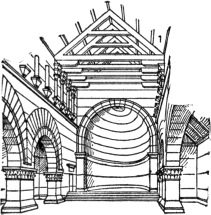
FIG. 69.—CHURCH AT KALB LOUZEH.
Christian architecture in Syria soon, however, diverged from Roman
traditions. The abundance of hard stone, the total lack of clay or
brick, the remoteness from Rome, led to a peculiar independence and
originality in the forms and details of the ecclesiastical as well as of
the domestic architecture of central Syria. These innovations upon Roman
models resulted in the development of distinct types which, but for the
arrest of progress by the Mohammedan conquest in the seventh century,
would doubtless have inaugurated a new and independent style of
architecture. Piers of masonry came
117
to replace the classic column, as at Tafkha (third or fourth century),
Rouheiha and Kalb Louzeh (fifth century? Fig. 69); the ceilings in the
smaller churches were often formed with stone slabs; the apse was at
first confined within the main rectangle of the plan, and was sometimes
square. The exterior assumed a striking and picturesque variety of forms
by means of turrets, porches, and gables. Singularly enough, vaulting
hardly appears at all, though the arch is used with fine effect.
Conventional and monastic groups of buildings appear early in Syria, and
that of St. Simeon Stylites at Kelat Seman is an impressive and
interesting monument. Four three-aisled wings form the arms of a cross,
meeting in a central octagonal open court, in the midst of which stood
the column of the saint. The eastern arm of the cross forms a complete
basilica of itself, and the whole cross measures 330 × 300 feet.
Chapels, cloisters, and cells adjoin the main edifice.
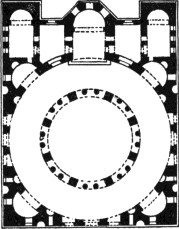
FIG. 70.—CATHEDRAL AT BOZRAH.
Circular and polygonal plans appear in a number of Syrian examples of
the early sixth century. Their most striking feature is the inscribing
of the circle or polygon in a square which forms the exterior outline,
and the use of four niches to fill out the corners. This occurs at Kelat
Seman in a small double church, perhaps the tomb and chapel of a martyr;
in the cathedral at Bozrah (Fig. 70), and in the small domical
church of St. George at Ezra. These were probably the
prototypes of many Byzantine churches like St. Sergius at
Constantinople, and San Vitale at Ravenna (Fig. 74), though the exact dates of the Syrian
118
churches are not known. The one at Ezra is the only one of the three
which has a dome, the others having been roofed with wood.
The interesting domestic architecture of this period is preserved in
whole towns and villages in the Hauran, which, deserted at the Arab
conquest, have never been reoccupied and remain almost intact but for
the decay of their wooden roofs. They are marked by dignity and
simplicity of design, and by the same picturesque massing of gables and
roofs and porches which has already been remarked of the churches. The
arches are broad, the columns rather heavy, the mouldings few and
simple, and the scanty carving vigorous and effective, often strongly
Byzantine in type.
Elsewhere in the Eastern world are many early churches of which even
the enumeration would exceed the limits of this work. Salonica counts a
number of basilicas and several domical churches. The church of St.
George, now a mosque, is of early date and thoroughly Roman in plan
and section, of the same class with the Pantheon and the tomb of Helena,
in both of which a massive circular wall is lightened by eight niches.
At Angora (Ancyra), Hierapolis, Pergamus, and other points in Asia
Minor; in Egypt, Nubia, and Algiers, are many examples of both circular
and basilican edifices of the early centuries of Christianity. In
Constantinople there remains but a single representative of the
basilican type, the church of St. John Studius, now the Emir
Akhor mosque.
MONUMENTS: Rome: 4th century:
St. Peter’s, Sta. Costanza, 330?; Sta. Pudentiana, 335 (rebuilt 1598);
tomb of St. Helena; Baptistery of Constantine; St. Paul’s beyond the
Walls, 386; St. John Lateran (wholly remodelled in modern times). 5th
century: Baptistery of St. John Lateran; Sta. Sabina, 425; Sta. Maria
Maggiore, 432; S. Pietro in Vincoli, 442 (greatly altered in modern
times). 6th century: S. Lorenzo, 580 (the older portion in two
stories); SS. Cosmo e Damiano. 7th century: Sta. Agnese, 625;
S. Giorgio in Velabro, 682. 8th century: Sta. Maria in
119
Cosmedin; S. Crisogono. 9th century: S. Nereo ed Achilleo;
Sta. Prassede; Sta. Maria in Dominica. 12th and 13th centuries:
S. Clemente, 1118; Sta. Maria in Trastevere; S. Lorenzo
(nave); Sta. Maria in Ara Coeli. Ravenna: Baptistery of S. John, 400 (?);
S. Francesco; S. Giovanni Evangelista, 425; Sta. Agata, 430;
S. Giovanni Battista, 439; tomb of Galla Placidia, 450;
S. Apollinare Nuovo, 500–520; S. Apollinare in Classe,
538; St. Victor; Sta. Maria in Cosmedin (the Arian Baptistery); tomb of
Theodoric (Sta. Maria della Rotonda, a decagonal two-storied
mausoleum, with a low dome cut from a single stone 36 feet in diameter),
530–540. Italy in General:
basilica at Parenzo, 6th century; cathedral and Sta. Fosca at Torcello,
640–700; at Naples Sta. Restituta, 7th century; others, mostly of
10th-13th centuries, at Murano near Venice, at Florence
(S. Miniato), Spoleto, Toscanella, etc.; baptisteries at Asti,
Florence, Nocera dei Pagani, and other places. In Syria and The East: basilicas of the Nativity at
Bethlehem, of the Sepulchre and of the Ascension at Jerusalem; also
polygonal church on Temple platform; these all of 4th century. Basilicas
at Bakouzah, Hass, Kelat Seman, Kalb Louzeh, Rouheiha, Tourmanin, etc.;
circular churches, tombs, and baptisteries at Bozrah, Ezra, Hass, Kelat
Seman, Rouheiha, etc.; all these 4th-8th centuries. Churches at
Constantinople (Holy Wisdom, St. John Studius, etc.), Hierapolis,
Pergamus, and Thessalonica (St. Demetrius, “Eski Djuma”); in Egypt and
Nubia (Djemla, Announa, Ibreem, Siout, etc.); at Orléansville in
Algeria. (For churches, etc., of 8th-10th centuries in the West, see
Chapter XIII.)
120
BYZANTINE ARCHITECTURE.
Books Recommended: As before,
Essenwein, Hübsch, Von Quast. Also, Bayet, L’Art Byzantin.
Choisy, L’Art de bâtir chez les Byzantins. Lethaby and Swainson,
Sancta Sophia. Ongania, La Basilica di San Marco. Pulgher,
Anciennes Églises Byzantines de Constantinople. Salzenberg,
Altchristliche Baudenkmäle von
Constantinopel. Texier and Pullan, Byzantine
Architecture.
ORIGIN AND CHARACTER. The decline and fall of Rome arrested
the development of the basilican style in the West, as did the Arab
conquest later in Syria. It was otherwise in the new Eastern capital
founded by Constantine in the ancient Byzantium, which was rising in
power and wealth while Rome lay in ruins. Situated at the strategic
point of the natural highway of commerce between East and West,
salubrious and enchantingly beautiful in its surroundings, the new
capital grew rapidly from provincial insignificance to metropolitan
importance. Its founder had embellished it with an extraordinary wealth
of buildings, in which, owing to the scarcity of trained architects,
quantity and cost doubtless outran quality. But at least the tameness of
blindly followed precedent was avoided, and this departure from
traditional tenets contributed undoubtedly to the originality of
Byzantine architecture. A large part of the artisans employed in
building were then, as now, from Asia Minor and the Ægean Islands, Greek
in race if not in name. An Oriental taste for brilliant and harmonious
color and for minute decoration spread over broad
121
surfaces must have been stimulated by trade with the Far East and by
constant contact with Oriental peoples, costumes, and arts. An Asiatic
origin may also be assigned to the methods of vaulting employed, far
more varied than the Roman, not only in form but also in materials and
processes. From Roman architecture, however, the Byzantines borrowed the
fundamental notion of their structural art; that, namely, of
distributing the weights and strains of their vaulted structures upon
isolated and massive points of support, strengthened by deep buttresses,
internal or external, as the case might be. Roman, likewise, was the use
of polished monolithic columns, and the incrustation of the piers and
walls with panels of variegated marble, as well as the decoration of
plastered surfaces by fresco and mosaic, and the use of opus
sectile and opus Alexandrinum for the production of sumptuous
marble pavements. In the first of these processes the color-figures of
the pattern are formed each of a single piece of marble cut to the shape
required; in the second the pattern is compounded of minute squares,
triangles, and curved pieces of uniform size. Under these combined
influences the artists of Constantinople wrought out new problems in
construction and decoration, giving to all that they touched a new and
striking character.
There is no absolute line of demarcation, chronological,
geographical, or structural, between Early Christian and Byzantine
architecture. But the former was especially characterized by the
basilica with three or five aisles, and the use of wooden roofs even in
its circular edifices; the vault and dome, though not unknown, being
exceedingly rare. Byzantine architecture, on the other hand, rarely
produced the simple three-aisled or five-aisled basilica, and nearly all
its monuments were vaulted. The dome was especially frequent, and
Byzantine architecture achieved its highest triumphs in the use of the
pendentive, as the triangular spherical surfaces are called, by
the aid of which a
122
dome can be supported on the summits of four arches spanning the four
sides of a square, as explained later. There is as little uniformity in
the plans of Byzantine buildings as in the forms of the vaulting.
A few types of church-plan, however, predominated locally in one or
another centre; but the controlling feature of the style was the dome
and the constructive system with which it was associated. The dome, it
is true, had long been used by the Romans, but always on a circular
plan, as in the Pantheon. It is also a fact that pendentives have been
found in Syria and Asia Minor older than the oldest Byzantine examples.
But the special feature characterizing the Byzantine dome on pendentives
was its almost exclusive association with plans having piers and columns
or aisles, with the dome as the central and dominant feature of the
complex design (see plans, Figs. 74, 75, 78). Another strictly Byzantine
practice was the piercing of the lower portion of the dome with windows
forming a circle or crown, and the final development of this feature
into a high drum.
CONSTRUCTION. Still another divergence from Roman methods was
in the substitution of brick and stone masonry for concrete. Brick was
used for the mass as well as the facing of walls and piers, and for the
vaulting in many buildings mainly built of stone. Stone was used either
alone or in combination with brick, the latter appearing in bands of
four or five courses at intervals of three or four feet. In later work a
regular alternation of the two materials, course for course, was not
uncommon. In piers intended to support unusually heavy loads the stone
was very carefully cut and fitted, and sometimes tied and clamped with
iron.
Vaults were built sometimes of brick, sometimes of cut stone; in a
few cases even of earthenware jars fitting into each other, and laid up
in a continuous contracting spiral from the base to the crown of a dome,
as in San Vitale at
123
Ravenna. Ingenious processes for building vaults without centrings were
made use of—processes inherited from the drain-builders of ancient
Assyria, and still in vogue in Armenia, Persia, and Asia Minor. The
groined vault was common, but always approximated the form of a dome, by
a longitudinal convexity upward in the intersecting vaults. The aisles
of Hagia Sophia17 display a remarkable variety of forms in the
vaulting.
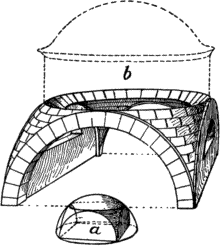
FIG. 71.—DIAGRAM OF PENDENTIVES.
DOMES. The dome, as we have seen, early became the most
characteristic feature of Byzantine architecture; and especially the
dome on pendentives. If a hemisphere be cut by five planes, four
perpendicular to its base and bounding a square inscribed therein, and
the fifth plane parallel to the base and tangent to the semicircular
intersections made by the first four, there will remain of the original
surface only four triangular spaces bounded by arcs of circles. These
are called pendentives (Fig. 71 a). When these are
built up of masonry, each course forms a species of arch, by virtue of
its convexity. At the crown of the four arches on which they rest, these
courses meet and form a complete circle, perfectly stable and capable of
sustaining any superstructure that does not by excessive weight disrupt
the whole fabric by overthrowing
124
the four arches which support it. Upon these pendentives, then,
a new dome may be started of any desired curvature, or even a
cylindrical drum to support a still loftier dome, as in the later
churches (Fig. 71 b). This method of covering a square is
simpler than the groined vault, having no sharp edges or intersections;
it is at least as effective architecturally, by reason of its greater
height in the centre; and is equally applicable to successive bays of an
oblong, cruciform, and even columnar building. In the great cisterns at
Constantinople vast areas are covered by rows of small domes supported
on ranges of columns.
The earlier domes were commonly pierced with windows at the base,
this apparent weakening of the vault being compensated for by strongly
buttressing the piers between the windows, as in Hagia Sophia. Here
forty windows form a crown of light at the spring of the dome, producing
an effect almost as striking as that of the simple oculus of the
Pantheon, and celebrated by ancient writers in the most extravagant
terms. In later and smaller churches a high drum was introduced beneath
the dome, in order to secure, by means of longer windows, more light
than could be obtained by merely piercing the diminutive domes.
Buttressing was well understood by the Byzantines, whose plans were
skilfully devised to provide internal abutments, which were often
continued above the roofs of the side-aisles to prop the main vaults,
precisely as was done by the Romans in their thermæ and similar halls.
But the Byzantines, while adhering less strictly than the Romans to
traditional forms and processes, and displaying much more ready
contrivance and special adaptation of means to ends, never worked out
this pregnant structural principle to its logical conclusion as did the
Gothic architects of Western Europe a few centuries later.
DECORATION. The exteriors of Byzantine buildings (except in
some of the small churches of late date) were
125
generally bare and lacking in beauty. The interiors, on the contrary,
were richly decorated, color playing a much larger part than carving in
the designs. Painting was resorted to only in the smaller buildings, the
more durable and splendid medium of mosaic being usually preferred. This
was, as a rule, confined to the vaults and to those portions of the
wall-surfaces embraced by the vaults above their springing. The colors
were brilliant, the background being usually of gold, though sometimes
of blue or a delicate green. Biblical scenes, symbolic and allegorical
figures and groups of saints adorned the larger areas, particularly the
half-dome of the apse, as in the basilicas. The smaller vaults, the
soffits of arches, borders of pictures, and other minor surfaces,
received a more conventional decoration of crosses, monograms, and set
patterns.

FIG. 72.—SPANDRIL. HAGIA SOPHIA.
The walls throughout were sheathed with slabs of rare marble in
panels so disposed that the veining should produce symmetrical figures.
The panels were framed in billet-mouldings, derived perhaps from classic
dentils; the billets or projections on one side the moulding coming
opposite the spaces on the other. This seems to have been a purely
Byzantine feature.
CARVED DETAILS. Internally the different stories were marked
by horizontal bands and cornices of white or inlaid marble richly
carved. The arch-soffits, the archivolts or
126
bands around the arches, and the spandrils between them were covered
with minute and intricate incised carving. The motives used, though
based on the acanthus and anthemion, were given a wholly new aspect. The
relief was low and flat, the leaves sharp and crowded, and the effect
rich and lacelike, rather than vigorous. It was, however, well adapted
to the covering of large areas where general effect was more important
than detail. Even the capitals were treated in the same spirit. The
impost-block was almost universal, except where its use was rendered
unnecessary by giving to the capital itself the massive pyramidal form
required to receive properly the spring of the arch or vault. In such
cases (more frequent in Constantinople than elsewhere) the surface of
the capital was simply covered with incised carving of foliage,
basketwork, monograms, etc.; rudimentary volutes in a few cases
recalling classic traditions (Figs. 72, 73). The mouldings were weak and
poorly executed, and the vigorous profiles of classic cornices were only
remotely suggested by the characterless aggregations of mouldings which
took their place.

FIG. 73.—CAPITAL WITH IMPOST BLOCK, S. VITALE.
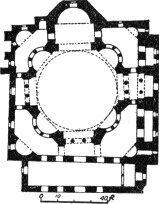
FIG. 74.—ST. SERGIUS, CONSTANTINOPLE.
PLANS. The remains of Byzantine architecture are almost
exclusively of churches and baptisteries, but the plans of these are
exceedingly varied. The first radical departure
127
from the basilica-type seems to have been the adoption of circular or
polygonal plans, such as had usually served only for tombs and
baptisteries. The Baptistery of St. John at Ravenna (early fifth
century) is classed by many authorities as a Byzantine monument. In the
early years of the sixth century the adoption of this model had become
quite general, and with it the development of domical design began to
advance. The church of St. Sergius at Constantinople (Fig. 74),
originally joined to a short basilica dedicated to St. Bacchus
(afterward destroyed by the Turks), as in the double church at Kelat
Seman, was built about 520; that of San Vitale at Ravenna was
begun a few years later; both are domical churches on an octagonal plan,
with an exterior aisle. Semicircular niches—four in St. Sergius
and eight in San Vitale—projecting into the aisle, enlarge
somewhat the area of the central space and give variety to the internal
effect. The origin of this characteristic feature may be traced to the
eight niches of the Pantheon, through such intermediate examples as the
temple of Minerva Medica at Rome. The true pendentive does not appear in
these two churches.
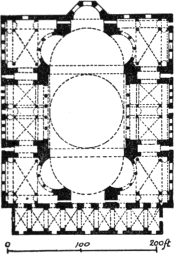
FIG. 75.—PLAN OF HAGIA SOPHIA.
Timidly employed up to that time in small structures, it received a
remarkable development in the magnificent church of Hagia Sophia,
built by Anthemius of Tralles and Isodorus of Miletus, under Justinian,
532–538 A.D. In the plan of this
marvellous edifice (Fig. 75) the dome rests upon four mighty arches
bounding a square, into two of which open the half-domes of semicircular
apses. These apses are penetrated and extended each by two smaller
niches and a central arch, and the whole vast nave, measuring over 200 ×
100 feet, is flanked by
128
enormously wide aisles connecting at the front with a majestic narthex.
Huge transverse buttresses, as in the Basilica of Constantine (with
whose structural design this building shows striking affinities), divide
the aisles each into three sections. The plan suggests that of St.
Sergius cut in two, with a lofty dome on pendentives over a square plan
inserted between the halves. Thus was secured a noble and unobstructed
hall of unrivalled proportions and great beauty, covered by a
combination of half-domes increasing in span and height as they lead up
successively to the stupendous central vault, which rises 180 feet into
the air and fitly crowns the whole. The imposing effect of this
low-curved but loftily-poised dome, resting as it does upon a crown of
windows, and so disposed that its summit is visible from every point of
the nave (as may be easily seen from an examination of the section, Fig.
76), is not surpassed in any interior ever erected.
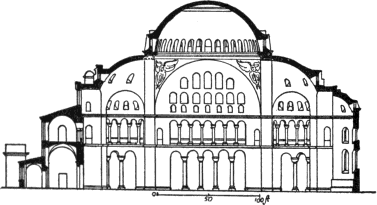
FIG. 76.—SECTION OF HAGIA SOPHIA.
The two lateral arches under the dome are filled by clearstory walls
pierced by twelve windows, and resting on arcades in two stories carried
by magnificent columns taken from ancient ruins. These separate the nave
from the side-aisles, which are in two stories forming galleries, and
are vaulted with a remarkable variety of groined vaults. All the masses
are disposed with studied reference to the resistance required by the
many and complex thrusts exerted by the dome and other vaults. That the
earthquakes of one thousand three hundred and fifty years have not
destroyed the church is the best evidence of the sufficiency of these
precautions.
[129]

FIG. 77.—INTERIOR OF HAGIA SOPHIA, CONSTANTINOPLE.
131
Not less remarkable than the noble planning and construction of this
church was the treatment of scale and decoration in its interior design.
It was as conspicuously the masterpiece of Byzantine architecture as the
Parthenon was of the classic Greek. With little external beauty, it is
internally one of the most perfectly composed and beautifully decorated
halls of worship ever erected. Instead of the simplicity of the Pantheon
it displays the complexity of an organism of admirably related parts.
The division of the interior height into two stories below the spring of
the four arches, reduces the component parts of the design to moderate
dimensions, so that the scale of the whole is more easily grasped and
its vast size emphasized by the contrast. The walls are incrusted with
precious marbles up to the spring of the vaulting; the capitals,
spandrils, and soffits are richly and minutely carved with incised
ornament, and all the vaults covered with splendid mosaics. Dimmed by
the lapse of centuries and disfigured by the vandalism of the Moslems,
this noble interior, by the harmony of its coloring and its impressive
grandeur, is one of the masterpieces of all time (Fig. 77).
LATER CHURCHES. After the sixth century no monuments were
built at all rivalling in scale the creations of the
132
former period. The later churches were, with few exceptions, relatively
small and trivial. Neither the plan nor the general aspect of Hagia
Sophia seems to have been imitated in these later works. The crown of
dome-windows was replaced by a cylindrical drum under the dome, which
was usually of insignificant size. The exterior was treated more
decoratively than before, by means of bands and incrustations of colored
marble, or alternations of stone and brick; and internally mosaic
continued to be executed with great skill and of great beauty until the
tenth century, when the art rapidly declined. These later churches, of
which a number were spared by the Turks, are, therefore, generally
pleasing and elegant rather than striking or imposing.
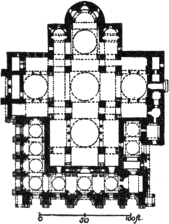
FIG. 78.—PLAN OF ST. MARK’S, VENICE.
FOREIGN MONUMENTS. The influence of Byzantine art was
wide-spread, both in Europe and Asia. The leading city of civilization
through the Dark Ages, Constantinople influenced Italy through her
political and commercial relations with Ravenna, Genoa, and Venice. The
church of St. Mark in the latter city was one result of this
influence (Figs. 78, 79). Begun in 1063 to replace an earlier church
destroyed by fire, it received through several centuries additions not
always Byzantine in character. Yet it was mainly the work of Byzantine
builders, who copied most probably the church of the Apostles at
Constantinople, built by Justinian. The picturesque but wholly
unstructural use of columns in the entrance porches, the upper parts of
the façade, the wooden cupolas over the five domes, and the pointed
arches in the narthex, are deviations from Byzantine traditions dating
in part from the later Middle Ages
133
Nothing could well be conceived more irrational, from a structural point
of view, than the accumulation of columns in the entrance-arches; but
the total effect is so picturesque and so rich in color, that its
architectural defects are easily overlooked. The external veneering of
white and colored marble occurs rarely in the East, but became a
favorite practice in Venice, where it continued in use for five hundred
years. The interior of St. Mark’s, in some respects better preserved
than that of Hagia Sophia, is especially fine in color, though not equal
in scale and grandeur to the latter church. With its five domes it has
less unity of effect than Hagia Sophia, but more of the charm of
picturesqueness, and its less brilliant and simpler lighting enhances
the impressiveness of its more modest dimensions.

FIG. 79.—INTERIOR OF ST. MARK’S.
134
In Russia and Greece the Byzantine style has continued to be the
official style of the Greek Church. The Russian monuments are for the
most part of a somewhat fantastic aspect, the Muscovite taste having
introduced many innovations in the form of bulbous domes and other
eccentric details. In Greece there are few large churches, and some of
the most interesting, like the Cathedral at Athens, are almost toy-like
in their diminutiveness. On Mt. Athos (Hagion Oros) is an ancient
monastery which still retains its Byzantine character and traditions. In
Armenia (as at Ani, Etchmiadzin, etc.) are also interesting examples of
late Armeno-Byzantine architecture, showing applications to exterior
carved detail of elaborate interlaced ornament looking like a re-echo of
Celtic MSS. illumination, itself, no doubt, originating in Byzantine
traditions. But the greatest and most prolific offspring of Byzantine
architecture appeared after the fall of Constantinople (1453) in the new
mosque-architecture of the victorious Turks.
MONUMENTS. Constantinople: St.
Sergius, 520; Hagia Sophia, 532–538; Holy Apostles by Justinian
(demolished); Holy Peace (St. Irene) originally by Constantine, rebuilt
by Justinian, and again in 8th century by Leo the Isaurian; Hagia
Theotokos, 12th century (?); Monétes Choras (“Kahiré Djami”), 10th
century; Pantokrator; “Fetiyeh Djami.” Cisterns, especially the “Bin Bir
Direk” (1,001 columns) and “Yere Batan Serai;” palaces, few vestiges
except the great hall of the Blachernæ palace. Salonica: Churches—of Divine Wisdom (“Aya
Sofia”) St. Bardias, St. Elias. Ravenna: San Vitale, 527–540. Venice: St. Mark’s, 977–1071; “Fondaco dei
Turchi,” now Civic Museum, 12th century. Other churches at Athens and
Mt. Athos; at Misitra, Myra, Ancyra, Ephesus, etc.; in Armenia at Ani,
Dighour, Etchmiadzin, Kouthais, Pitzounda, Usunlar, etc.; tombs at Ani,
Varzhahan, etc.; in Russia at Kieff (St. Basil, Cathedral), Kostroma,
Moscow (Assumption, St. Basil, Vasili Blaghennoi, etc.), Novgorod,
Tchernigoff; at Kurtea Darghish in Wallachia, and many other places.
135
SASSANIAN AND MOHAMMEDAN ARCHITECTURE.
(ARABIAN, MORESQUE, PERSIAN, INDIAN, AND TURKISH.)
Books Recommended: Bourgoin, Les
Arts Arabes. Coste, Monuments du Caire; Monuments modernes
de la Perse. Cunningham, Archæological Survey of India.
Fergusson, Indian and Eastern Architecture. De Forest, Indian
Architecture and Ornament. Flandin et Coste, Voyage en Perse.
Franz-Pasha, Die Baukunst des Islam. Gayet, L’Art Arabe;
L’Art Persan. Girault de Prangey, Essai sur l’architecture des
Arabes en Espagne, etc. Goury and Jones, The Alhambra. Jacob,
Jeypore Portfolio of Architectural Details. Le Bon, La
civilisation des Arabes; Les monuments de l’Inde. Owen Jones,
Grammar of Ornament. Parvillée, L’Architecture Ottomane.
Prisse d’Avennes, L’Art Arabe. Texier, Description de
l’Arménie, la Perse, etc.
GENERAL SURVEY. While the Byzantine Empire was at its zenith,
the new faith of Islam was conquering Western Asia and the Mediterranean
lands with a fiery rapidity, which is one of the marvels of history. The
new architectural styles which grew up in the wake of these conquests,
though differing widely in conception and detail in the several
countries, were yet marked by common characteristics which set them
quite apart from the contemporary Christian styles. The predominance of
decorative over structural considerations, a predilection for
minute surface-ornament, the absence of pictures and sculpture, are
found alike in Arabic, Persian, Turkish, and Indian buildings, though in
varying degree. These new styles, however, were almost entirely the
handiwork of artisans belonging to the
136
conquered races, and many traces of Byzantine, and even after the
Crusades, of Norman and Gothic design, are recognizable in Moslem
architecture. But the Orientalism of the conquerors and their common
faith, tinged with the poetry and philosophic mysticism of the Arab,
stamped these works of Copts, Syrians, and Greeks with an unmistakable
character of their own, neither Byzantine nor Early Christian.
ARABIC ARCHITECTURE. In the building of mosques and tombs,
especially at Cairo, this architecture reached a remarkable degree of
decorative elegance, and sometimes of dignity. It developed slowly, the
Arabs not being at the outset a race of builders. The early monuments of
Syria and Egypt were insignificant, and the sacred Kaabah at
Mecca and the mosque at Medina hardly deserve to be called architectural
monuments at all. The most important early works were the mosques of
’Amrou at Cairo (642, rebuilt and enlarged early in the eighth
century), of El Aksah on the Temple platform at Jerusalem (691,
by Abd-el-Melek), and of El Walid at Damascus (705–732,
recently seriously injured by fire). All these were simple one-storied
structures, with flat wooden roofs carried on parallel ranges of columns
supporting pointed arches, the arcades either closing one side of a
square court, or surrounding it completely. The long perspectives of the
aisles and the minute decoration of the archivolts and ceilings alone
gave them architectural character. The beautiful Dome of the Rock
(Kubbet-es-Sakhrah, miscalled the Mosque of Omar) on the Temple platform
at Jerusalem is either a remodelled Constantinian edifice, or in large
part composed of the materials of one (see p. 116).
The splendid mosque of Ibn Touloun (876–885) was built
on the same plan as that of Amrou, but with cantoned piers instead of
columns and a corresponding increase in variety of perspective and
richness of effect. With the incoming
137
of the Fatimite dynasty, however, and the foundation of the present city
of Cairo (971), vaulting began to take the place of wooden ceilings, and
then appeared the germs of those extraordinary applications of geometry
to decorative design which were henceforth to be the most striking
feature of Arabic ornament. Under the Ayûb dynasty, which began with
Salâh-ed-din (Saladin) in 1172, these elements, of which the great
Barkouk mosque (1149) is the most imposing early example,
developed slowly in the domical tombs of the Karafah at Cairo,
and prepared the way for the increasing richness and splendor of a long
series of mosques, among which those of Kalaoun
(1284–1318), Sultan Hassan (1356), El Mu’ayyad
(1415), and Kaîd Bey (1463), were the most conspicuous examples
(Fig. 80). They mark, indeed, successive advances in complexity of
planning, ingenuity of construction, and elegance of decoration.
Together they constitute an epoch in Arabic architecture, which
coincides closely with the development of Gothic
138
vaulted architecture in Europe, both in the stages and the duration of
its advances.

FIG. 80.—MOSQUE OF SULTAN HASSAN, CAIRO: SANCTUARY.
a, Mihrâb, b, Mimber.
The mosques of these three centuries are, like the mediæval
monasteries, impressive aggregations of buildings of various sorts about
a central court of ablutions. The tomb of the founder, residences for
the imams, or priests, schools (madrassah), and hospitals
(mâristân) rival in importance the prayer-chamber. This last is,
however, the real focus of interest and splendor; in some cases, as in
Sultan Hassan, it is a simple barrel-vaulted chamber open to the court;
in others an oblong arcaded hall with many small domes; or again,
a square hall covered with a high pointed dome on pendentives of
intricately beautiful stalactite-work (see below). The ceremonial
requirements of the mosque were simple. The-court must have its fountain
of ablutions in the centre. The prayer-hall, or mosque proper, must have
its mihrâb, or niche, to indicate the kibleh, the
direction of Mecca; and its mimber, or high, slender pulpit for
the reading of the Kôran. These were the only absolutely indispensable
features of a mosque, but as early as the ninth century the
minaret was added, from which the call to prayer could be sounded
over the city by the mueddin. Not until the Ayubite period,
however, did it begin to assume those forms of varied and picturesque
grace which lend to Cairo so much of its architectural charm.
ARCHITECTURAL DETAILS. While Arabic architecture, in Syria and
Egypt alike, possesses more decorative than constructive originality,
the beautiful forms of its domes, pendentives, and minarets, the simple
majesty of the great pointed barrel-vaults of the Hassan mosque and
similar monuments, and the graceful lines of the universally used
pointed arch, prove the Coptic builders and their later Arabic
successors to have been architects of great ability. The Arabic domes,
as seen both in the mosques and in the remarkable group of tombs
commonly called “tombs of the
139
Khalîfs,” are peculiar not only in their pointed outlines and their rich
external decoration of interlaced geometric motives, but still more in
the external and internal treatment of the pendentives, exquisitely
decorated with stalactite ornament. This ornament, derived, no doubt,
from a combination of minute corbels with rows of small niches, and
presumably of Persian origin, was finally developed into a system of
extraordinary intricacy, applicable alike to the topping of a niche or
panel, as in the great doorways of the mosques, and to the bracketing
out of minaret galleries (Figs. 81, 82). Its
applications show a bewildering variety of forms and an extraordinary
aptitude for intricate geometrical design.

FIG. 81.—MOSQUE OF KAÎD BEY, CAIRO.
DECORATION. Geometry, indeed, vied with the love of color in
its hold on the Arabic taste. Ceiling-beams were carved into highly
ornamental forms before receiving their rich color-decoration of red,
green, blue, and gold. The doors and the mimber were framed in
geometric patterns with slender intersecting bars forming complicated
star-panelling. The voussoirs of arches were cut into curious
interlocking forms; doorways and niches were covered with stalactite
corbelling, and pavements and wall-incrustations,
140
whether of marble or tiling, combined brilliancy and harmony of color
with the perplexing beauty of interlaced star-and-polygon patterns of
marvellous intricacy. Stained glass added to the interior color-effect,
the patterns being perforated in plaster, with a bit of colored glass
set into each perforation—a device not very durable, perhaps,
but singularly decorative.
OTHER WORKS. Few of the mediæval Arabic palaces have remained
to our time. That they were adorned with a splendid prodigality appears
from contemporary accounts. This splendor was internal rather than
external; the palace, like all the larger and richer dwellings in the
East, surrounded one or more courts, and presented externally an almost
unbroken wall. The fountain in the chief court, the diwân
(a great, vaulted reception-chamber opening upon the court and
raised slightly above it), the dâr, or men’s court, rigidly
separated from the hareem for the women, were and are universal
elements in these great dwellings. The more common city-houses show as
their most striking features successively corbelled-out stories and
broad wooden eaves, with lattice-screens covering single windows, or
almost a whole façade, composed of turned work (mashrabiyya), in
designs of great beauty.
The fountains, gates, and minor works of the Arabs display the same
beauty in decoration and color, the same general forms and details which
characterize the larger works, but it is impossible here to
particularize further with regard to them.

FIG. 82.—MOORISH DETAIL, ALHAMBRA.
Showing stalactite and perforated work, Moorish cusped arch,
Hispano-Moresque capitals, and decorative inscriptions.
MORESQUE. Elsewhere in Northern Africa the Arabs produced no
such important works as in Egypt, nor is the architecture of the other
Moslem states so well preserved or so well known. Constructive design
would appear to have been there even more completely subordinated to
decoration; tiling and plaster-relief took the place of more
architectural elements and materials, while horseshoe and cusped
141
arches were substituted for the simpler and more architectural pointed
arch (Fig. 82). The courts of palaces and public buildings were
surrounded by ranges of horseshoe arches on slender columns; these last
being provided with capitals of a form rarely seen in Cairo. Towers were
built of much more massive design than the Cairo minarets, usually with
a square, almost solid shaft and a more open lantern at the top,
sometimes in several diminishing stories.
HISPANO-MORESQUE. The most splendid phase of this branch of
Arabic architecture is found not in Africa but in Spain, which was
overrun in 710–713 by the Moors, who established there the
independent Khalifate of Cordova. This was later split up into petty
kingdoms, of which the most important were Granada, Seville, Toledo, and
Valencia. This dismemberment of the Khalifate led in time to the loss of
these cities, which were one by one recovered by the Christians during
the fourteenth and fifteenth centuries;
142
the capture of Granada, in 1492, finally destroying the Moorish
rule.
The dominion of the Moors in Spain was marked by a high civilization
and an extraordinary activity in building. The style they introduced
became the national style in the regions they occupied, and even after
the expulsion of the Moors was used in buildings erected by Christians
and by Jews. The “House of Pilate,” at Seville, is an example of this,
and the general use of the Moorish style in Jewish synagogues, down to
our own day, both in Spain and abroad, originated in the erection of
synagogues for the Jews in Spain by Moorish artisans and in Moorish
style, both during and after the period of Moslem supremacy.
Besides innumerable mosques, castles, bridges, aqueducts, gates, and
fountains, the Moors erected several monuments of remarkable size and
magnificence. Specially worthy of notice among them are the Great Mosque
at Cordova, the Alcazars of Seville and Malaga, the Giralda at Seville,
and the Alhambra at Granada.

FIG. 83.—INTERIOR OF THE GREAT MOSQUE AT CORDOVA.
The Mosque at Cordova, begun in 786 by ‘Abd-er-Rahman,
enlarged in 876, and again by El Mansour in 976, is a vast arcaded hall
375 feet × 420 feet in extent, but only 30
143
feet high (Fig. 83). The rich wooden ceiling rests upon seventeen rows
of thirty to thirty-three columns each, and two intersecting rows of
piers, all carrying horseshoe arches in two superposed ranges,
a large portion of those about the sanctuary being cusped, the
others plain, except for the alternation of color in the voussoirs. The
mihrâb niche is particularly rich in its minutely carved
incrustations and mosaics, and a dome ingeniously formed by intersecting
ribs covers the sanctuary before it. This form of dome occurs frequently
in Spain.
The Alcazars at Seville and Malaga, which have been restored
in recent years, present to-day a fairly correct counterpart of the
castle-palaces of the thirteenth century. They display the same general
conceptions and decorative features as the Alhambra, which they
antedate. The Giralda at Seville is, on the other hand, unique.
It is a lofty rectangular tower, its exterior panelled and covered with
a species of quarry-ornament in relief; it terminated originally in two
or three diminishing stages or lanterns, which were replaced in the
sixteenth century by the present Renaissance belfry.
The Alhambra is universally considered to be the masterpiece
of Hispano-Moresque art, partly no doubt on account of its excellent
preservation. It is most interesting as an example of the splendid
citadel-palaces built by the Moorish conquerors, as well as for its
gorgeous color-decoration of minute quarry-ornament stamped or moulded
in the wet plaster wherever the walls are not wainscoted with tiles. It
was begun in 1248 by Mohammed-ben-Al-Hamar, enlarged in 1279 by his
successor, and again in 1306, when its mosque was built. Its plan (Fig.
84) shows two large courts and a smaller one next the mosque, with three
great square chambers and many of minor importance. Light arcades
surround the Court of the Lions with its fountain, and adorn the ends of
the other chief court; and the stalactite
144
pendentive, rare in Moorish work, appears in the “Hall of Ambassadors”
and some other parts of the edifice. But its chief glory is its
ornamentation, less durable, less architectural than that of the Cairene
buildings, but making up for this in delicacy and richness. Minute
vine-patterns and Arabic inscriptions are interwoven with waving
intersecting lines, forming a net-like framework, to all of which deep
red, blue, black, and gold give an indescribable richness of effect.
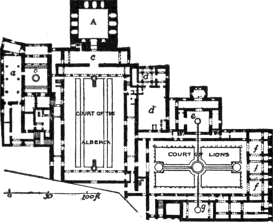
FIG. 84.—PLAN OF THE ALHAMBRA.
A, Hall of Ambassadors; a, Mosque; b, Court of Mosque; c, Sala della
Barca; d, d, Baths; e, Hall of the Two Sisters; f, f, f,
Hall of the Tribunal; g, Hall of the Abencerrages.
Larger View
The Moors also overran Sicily in the eighth century, but while their
architecture there profoundly influenced that of the Christians who
recovered Sicily in 1090, and copied the style of the conquered Moslems,
there is too little of the original Moorish architecture remaining to
claim mention here.
SASSANIAN. The Sassanian empire, which during the four
centuries from 226 to 641 A.D. had
withstood Rome and extended its own sway almost to India, left on
Persian soil a number of interesting monuments which powerfully
influenced the Mohammedan style of that region. The Sassanian buildings
appear to have been principally palaces, and were all vaulted. With
their long barrel-vaulted halls, combined with square domical chambers,
as in Firouz-Abad and Serbistan, they exhibit reminiscences of antique
Assyrian tradition.
145
The ancient Persian use of columns was almost entirely abandoned, but
doors and windows were still treated with the banded frames and
cavetto-cornices of Persepolis and Susa. The Sassanians employed with
these exterior details others derived perhaps from Syrian and Byzantine
sources. A sort of engaged buttress-column and blind arches
repeated somewhat aimlessly over a whole façade were characteristic
features; still more so the huge arches, elliptical or horse-shoe
shaped, which formed the entrances to these palaces, as in the Tâk-Kesra
at Ctesiphon. Ornamental details of a debased Roman type appear, mingled
with more gracefully flowing leaf-patterns resembling early Christian
Syrian carving. The last great monument of this style was the palace at
Mashita in Moab, begun by the last Chosroes (627), but never finished,
an imposing and richly ornamented structure about 500 × 170 feet,
occupying the centre of a great court.
PERSIAN-MOSLEM ARCHITECTURE. These Sassanian palaces must have
strongly influenced Persian architecture after the Arab conquest in 641.
For although the architecture of the first six centuries after that date
suffered almost absolute extinction at the hands of the Mongols under
Genghis Khan, the traces of Sassanian influence are still perceptible in
the monuments that rose in the following centuries. The dome and vault,
the colossal portal-arches, and the use of brick and tile are evidences
of this influence, bearing no resemblance to Byzantine or Arabic types.
The Moslem monuments of Persia, so far as their dates can be
ascertained, are all subsequent to 1200, unless tradition is correct in
assigning to the time of Haroun Ar Rashid (786) certain curious tombs near
Bagdad with singular pyramidal roofs. The ruined mosque at Tabriz
(1300), and the beautiful domical Tomb at Sultaniyeh
(1313) belong to the Mogul period. They show all the essential features
of the later architecture of the Sufis
146
(1499–1694), during whose dynastic period were built the still
more splendid and more celebrated Meidan or square, the great
mosque of Mesjid Shah, the Bazaar and the College or Medress of Hussein
Shah, all at Ispahan, and many other important monuments at Ispahan,
Bagdad, and Teheran. In these structures four elements especially claim
attention; the pointed bulbous dome, the round minaret, the portal-arch
rising above the adjacent portions of the building, and the use of
enamelled terra-cotta tiles as an external decoration. To these may be
added the ogee arch (ogee = double-reversed curve), as an
occasional feature. The vaulting is most ingenious and beautiful, and
its forms, whether executed in brick or in plaster, are sufficiently
varied without resort to the perplexing complications of stalactite
work. In Persian decoration the most striking qualities are the harmony
of blended color, broken up into minute patterns and more subdued in
tone than in the Hispano-Moresque, and the preference of flowing lines
and floral ornament to the geometric puzzles of Arabic design. Persian
architecture influenced both Turkish and Indo-Moslem art, which owe to
it a large part of their decorative charm.
INDO-MOSLEM. The Mohammedan architecture of India is so
distinct from all the native Indian styles and so related to the art of
Persia, if not to that of the Arabs, that it properly belongs here
rather than in the later chapter on Oriental styles. It was in the
eleventh century that the states of India first began to fall before
Mohammedan invaders, but not until the end of the fifteenth century that
the great Mogul dynasty was established in Hindostan as the dominant
power. During the intervening period local schools of Moslem
architecture were developing in the Pathan country of Northern India
(1193–1554), in Jaunpore and Gujerat (1396–1572), in Scinde,
where Persian influence predominated; in Kalburgah and Bidar
(1347–1426). These
147
schools differed considerably in spirit and detail; but under the Moguls
(1494–1706) there was less diversity, and to this dynasty we owe
many of the most magnificent mosques and tombs of India, among which
those of Bijapur retain a marked and distinct style of their own.
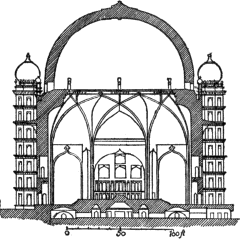
FIG. 85.—TOMB OF MAHMUD, BIJAPUR. SECTION.
The Mohammedan monuments of India are characterized by a grandeur and
amplitude of disposition, a symmetry and monumental dignity of
design which distinguishes them widely from the picturesque but
sometimes trivial buildings of the Arabs and Moors. Less dependent on
color than the Moorish or Persian structures, they are usually built of
marble, or of marble and sandstone, giving them an air of permanence and
solidity wanting in other Moslem styles except the Turkish. The dome,
the round minaret, the pointed arch, and the colossal portal-arch, are
universal, as in Persia, and enamelled tiles are also used, but chiefly
for interior decoration. Externally the more dignified if less
resplendent decoration of surface carving is used, in patterns of minute
and graceful scrolls, leaf forms, and Arabic inscriptions covering large
surfaces. The Arabic stalactite pendentive star-panelling and
geometrical interlace are rarely if ever seen. The dome on the square
plan is almost universal, but neither the Byzantine nor the Arabic
pendentive is used, striking and original combinations of vaulting
surfaces, of corner squinches, of corbelling and ribs, being used in its
place. Many of the Pathan
148
domes and arches at Delhi, Ajmir, Ahmedabad, Shepree, etc., are built in
horizontal or corbelled courses supported on slender columns, and exert
no thrust at all, so that they are vaults only in form, like the dome of
the Tholos of Atreus (Fig. 24). The most
imposing and original of all Indian domes are those of the Jumma
Musjid and of the Tomb of Mahmud, both at Bijapur, the latter
137 feet in span (Fig. 85). These two monuments, indeed, with the Mogul
Taj Mahal at Agra, not only deserve the first rank among Indian
monuments, but in constructive science combined with noble proportions
and exquisite beauty are hardly, if at all, surpassed by the greatest
triumphs of western art. The Indo-Moslem architects, moreover,
especially those of the Mogul period, excelled in providing artistic
settings for their monuments. Immense platforms, superb courts, imposing
flights of steps, noble gateways, minarets to mark the angles of
enclosures, and landscape gardening of a high order, enhance greatly the
effect of the great mosques, tombs, and palaces of Agra, Delhi,
Futtehpore Sikhri, Allahabad, Secundra, etc.
The most notable monuments of the Moguls are the Mosque of
Akbar (1556–1605) at Futtehpore Sikhri, the tomb of that
sultan at Secundra, and his palace at Allahabad; the Pearl Mosque
at Agra and the Jumma Musjid at Delhi, one of the largest and
noblest of Indian mosques, both built by Shah Jehan about 1650; his
immense but now ruined palace in the same city; and finally the
unrivalled mausoleum, the Taj Mahal at Agra, built during his
lifetime as a festal hall, to serve as his tomb after death (Fig. 86).
This last is the pearl of Indian architecture, though it is said to have
been designed by a European architect, French or Italian. It is a white
marble structure 185 feet square, centred in a court 313 feet square,
forming a platform 18 feet high. The corners of this court are marked by
elegant minarets, and the whole is dominated by
149
the exquisite white marble dome, 58 feet in diameter, 80 feet high,
internally rising over four domical corner chapels, and covered
externally by a lofty marble bulb-dome on a high drum. The rich
materials, beautiful execution, and exquisite inlaying of this mausoleum
are worthy of its majestic design. On the whole, in the architecture of
the Moguls in Bijapur, Agra, and Delhi, Mohammedan architecture reaches
its highest expression in the totality and balance of its qualities of
construction, composition, detail, ornament, and settings. The later
monuments show the decline of the style, and though often rich and
imposing, are lacking in refinement and originality.

FIG. 86.—TAJ MAHAL, AGRA.
TURKISH. The Ottoman Turks, who began their conquering career
under Osman I. in Bithynia in 1299, had for a
150
century been occupying the fairest portions of the Byzantine empire
when, in 1453, they became masters of Constantinople. Hagia Sophia was
at once occupied as their chief mosque, and such of the other churches
as were spared, were divided between the victors and the vanquished. The
conqueror, Mehmet II., at the same time set about the building of a new
mosque, entrusting the design to a Byzantine, Christodoulos, whom he
directed to reproduce, with some modifications, the design of the “Great
Church”—Hagia Sophia. The type thus officially adopted has ever
since remained the controlling model of Turkish mosque design, so far,
at least, as general plan and constructive principles are concerned.
Thus the conquering Turks, educated by a century of study and imitation
of Byzantine models in Brusa, Nicomedia, Smyrna, Adrianople, and other
cities earlier subjugated, did what the Byzantines had, during nine
centuries, failed to do. The noble idea first expressed by Anthemius and
Isidorus in the Church of Hagia Sophia had remained undeveloped,
unimitated by later architects. It was the Turk who first seized upon
its possibilities, and developed therefrom a style of architecture less
sumptuous in color and decoration than the sister styles of Persia,
Cairo, or India, but of great nobility and dignity, notwithstanding. The
low-curved dome with its crown of buttressed windows, the plain
spherical pendentives, the great apses at each end, covered by
half-domes and penetrated by smaller niches, the four massive piers with
their projecting buttress-masses extending across the broad lateral
aisles, the narthex and the arcaded atrium in front—all these
appear in the great Turkish mosques of Constantinople. In the
Conqueror’s mosque, however, two apses with half-domes replace the
lateral galleries and clearstory of Hagia Sophia, making a perfectly
quadripartite plan, destitute of the emphasis and significance of a plan
drawn on one main axis (Fig. 87).
151
The same treatment occurs in the mosque of Ahmed I., the
Ahmediyeh (1608; Fig. 88), and the Yeni Djami (“New
Mosque”) at the port (1665). In the mosque of Osman III. (1755)
the reverse change was effected; the mosque has no great apses, four
clearstories filling the four arches under the dome, as also in several
of the later and smaller mosques. The greatest and noblest of the
Turkish mosques, the Suleimaniyeh, built in 1553 by Soliman the
Magnificent, returned to the Byzantine combination of two half-domes
with two clearstories (Fig. 89).
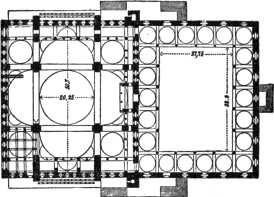
FIG. 87.—MOSQUE OF MEHMET II., CONSTANTINOPLE.
PLAN.
(The dimensions figured in metres.)
In none of these monuments is there the internal magnificence of
marble and mosaic of the Byzantine churches. These are only in a measure
replaced by Persian tile-wainscoting and stained-glass windows of the
Arabic type. The division into stories and the treatment of scale are
less well managed than in the Hagia Sophia; on the other hand, the
proportion of height to width is generally admirable. The exterior
treatment is unique and effective, far superior to the Byzantine
practice. The massing of domes and half-domes and roofs is more
artistically arranged; and while there is little of that minute carved
detail found in Egypt and India, the composition of the lateral arcades,
the simple but impressive domical peristyles of the courts, and the
graceful forms of the pointed arches, with alternating voussoirs of
white and black marble, are artistic in a high degree. The minarets are,
however,
152
inferior to those of Indian, Persian, and Arabic art, though graceful in
their proportions.

FIG. 88.—EXTERIOR AHMEDIYEH MOSQUE.
Nearly all the great mosques are accompanied by the domical tombs
(turbeh) of their imperial founders. Some of these are of noble
size and great beauty of proportion and decoration. The Tomb of
Roxelana (Khourrem), the favorite wife of Soliman the Magnificent
(1553), is the most beautiful of all, and perhaps the most perfect gem
of Turkish architecture, with its elegant arcade surrounding the
octagonal domical mausoleum-chamber. The monumental fountains of
Constantinople also deserve mention. Of these, the one erected by Ahmet
III. (1710), near Hagia
153
Sophia, is the most beautiful. They usually consist of a rectangular
marble reservoir with pagoda-like roof and broad eaves, the four faces
of the fountain adorned each with a niche and basin, and covered with
relief carving and gilded inscriptions.

FIG. 89.—INTERIOR OF SULEIMANIYEH,
CONSTANTINOPLE.
PALACES. In this department the Turks have done little of
importance. The buildings in the Seraglio gardens are low and
insignificant. The Tchinli Kiosque, now the Imperial Museum, is
however, a simple but graceful two-storied edifice, consisting of
four vaulted chambers in the angles of a fine cruciform hall, with domes
treated like those of Bijapur on a small scale; the tiling and the
veranda in front are particularly elegant; the design suggests Persian
handiwork. The later palaces, designed by Armenians, are picturesque
white marble and stucco buildings on the water’s edge; they possess
richly decorated halls, but the details are of a debased European rococo
style, quite unworthy of an Oriental monarch.
MONUMENTS. Arabian: “Mosque
of Omar,” or Dome of the Rock, 638; El Aksah, by ’Abd-el-Melek, 691,
both at Jerusalem; Mosque ’Amrou at Cairo, 642; mosques at Cyrene, 665;
great mosque of El Walîd,
154
Damascus, 705–717. Bagdad built, 755. Great mosque at Kairouân,
737. At Cairo, Ibn Touloun, 876; Gama-El-Azhar, 971; Barkouk, 1149;
“Tombs of Khalîfs” (Karafah), 1250–1400; Moristan Kalaoun, 1284;
Medresseh Sultan Hassan, 1356; El Azhar enlarged; El Mûayed, 1415; Kaïd
Bey, 1463; Sinan Pacha, 1468; “Tombs of Mamelukes,” 16th century. Also
palaces, baths, fountains, mosques, and tombs. Moresque: Mosque at Saragossa, 713; mosque and
arsenal at Tunis, 742; great mosque at Cordova, 786, 876, 975;
sanctuary, 14th century. Mosques, baths, etc., at Cordova, Tarragona,
Segovia, Toledo, 960–980; mosque of Sobeiha at Cordova, 981.
Palaces and mosques at Fez; great mosque at Seville, 1172. Extensive
building in Morocco close of 12th century. Giralda at Seville, 1160;
Alcazars in Malaga and Seville, 1225–1300; Alhambra and Generalife
at Granada, 1248, 1279, 1306; also mosques, baths, etc. Yussuf builds
palace at Malaga, 1348; palaces at Granada. Persian: Tombs near Bagdad, 786 (?); mosque at
Tabriz, 1300; tomb of Khodabendeh at Sultaniyeh, 1313; Meidan Shah
(square) and Mesjid Shah (mosque) at Ispahan, 17th century; Medresseh
(school) of Sultan Hussein, 18th century; palaces of Chehil Soutoun
(forty columns) and Aineh Khaneh (Palace of Mirrors). Baths, tombs,
bazaars, etc., at Cashan, Koum, Kasmin, etc. Aminabad Caravanserai
between Shiraz and Ispahan; bazaar at Ispahan.
Indian: Mosque and “Kutub Minar”
(tower) cir. 1200; Tomb of Altumsh, 1236; mosque at Ajmir,
1211–1236; tomb at Old Delhi; Adina Mosque, Maldah, 1358. Mosques
Jumma Musjid and Lal Durwaza at Jaunpore, first half of 15th century.
Mosque and bazaar, Kalburgah, 1435 (?). Mosques at
Ahmedabad and Sirkedj, middle 15th century. Mosque Jumma Musjid and Tomb
of Mahmûd, Bijapur, cir. 1550. Tomb of Humayûn, Delhi; of
Mohammed Ghaus, Gwalior; mosque at Futtehpore Sikhri; palace at
Allahabad; tomb of Akbar at Secundra, all by Akbar, 1556–1605.
Palace and Jumma Musjid at Delhi; Muti Musjid (Pearl mosque) and Taj
Mahal at Agra, by Shah Jehan, 1628–1658.
Turkish: Tomb of Osman, Brusa, 1326;
Green Mosque (Yeshil Djami) Brusa, cir. 1350. Mosque at Isnik
(Nicæa), 1376. Mehmediyeh (mosque Mehmet II.) Constantinople, 1453;
mosque at Eyoub; Tchinli Kiosque, by Mehmet II., 1450–60; mosque
Bayazid, 1500; Selim I., 1520; Suleimaniyeh, by Sinan, 1553;
Ahmediyeh by Ahmet I., 1608; Yeni Djami, 1665; Nouri Osman, by
Osman III., 1755; mosque Mohammed Ali in Cairo,
1824. Mosque at Adrianople. Khans,
cloistered courts for public business and commercial lodgers, various
dates, 16th and 17th centuries (Validé Khan, Vizir Khan), vaulted
bazaars, fountains, Seraskierat Tower, all at Constantinople.
155
EARLY MEDIÆVAL ARCHITECTURE
IN ITALY AND FRANCE.
Books Recommended: Cattaneo,
L’Architecture en Italie. Chapuy, Le moyen age monumental.
Corroyer, Architecture romane. Cummings, A History of
Architecture in Italy. Enlart, Manuel d’archéologie
française. Hübsch, Monuments de l’architecture chrétienne.
Knight, Churches of Northern Italy. Lenoir, Architecture
monastique. Osten, Bauwerke in der Lombardei. Quicherat,
Mélanges d’histoire et d’archéologie. Reber, History of
Mediæval Architecture. Révoil, Architecture romane du midi de la
France. Rohault de Fleury, Monuments de Pise. Sharpe,
Churches of Charente. De Verneilh, L’Architecture byzantine en
France. Viollet-le-Duc, Dictionnaire raisonné de l’architecture
française (especially in Vol. I., Architecture religieuse);
Discourses on Architecture.
EARLY MEDIÆVAL EUROPE. The fall of the Western Empire in 476
A.D. marked the beginning of a new era
in architecture outside of the Byzantine Empire. The so-called Dark Ages
which followed this event constituted the formative period of the new
Western civilization, during which the Celtic and Germanic races were
being Christianized and subjected to the authority and to the educative
influences of the Church. Under these conditions a new architecture was
developed, founded upon the traditions of the early Christian builders,
modified in different regions by Roman or Byzantine influences. For Rome
recovered early her antique prestige, and Roman monuments covering the
soil of Southern Europe, were a constant
156
object lesson to the builders of that time. To this new architecture of
the West, which in the tenth and eleventh centuries first began to
achieve worthy and monumental results, the generic name of
Romanesque has been commonly given, in spite of the great
diversity of its manifestations in different countries.
CHARACTER OF THE ARCHITECTURE. Romanesque architecture was
pre-eminently ecclesiastical. Civilization and culture emanated from the
Church, and her requirements and discipline gave form to the builder’s
art. But the basilican style, which had so well served her purposes in
the earlier centuries and on classic soil, was ill-suited to the new
conditions. Corinthian columns, marble incrustations, and splendid
mosaics were not to be had for the asking in the forests of Gaul or
Germany, nor could the Lombards and Ostrogoths in Italy or their
descendants reproduce them. The basilican style was complete in itself,
possessing no seeds of further growth. The priests and monks of Italy
and Western Europe sought to rear with unskilled labor churches of stone
in which the general dispositions of the basilica should reappear in
simpler, more massive dress, and, as far as possible, in a fireproof
construction with vaults of stone. This problem underlies all the varied
phases of Romanesque architecture; its final solution was not, however,
reached until the Gothic period, to which the Romanesque forms the
transition and stepping-stone.

FIG. 90.—INTERIOR OF SAN AMBROGIO, MILAN.
MEDIÆVAL ITALY. Italy in the Dark Ages stood midway between
the civilization of the Eastern Empire and the semi-barbarism of the
West. Rome, Ravenna, and Venice early became centres of culture and
maintained continuous commercial relations with the East. Architecture
did not lack either the inspiration or the means for advancing on new
lines. But its advance was by no means the same everywhere. The unifying
influence of the church was
157
counterbalanced by the provincialism and the local diversities of the
various Italian states, resulting in a wide variety of styles. These,
however, may be broadly grouped in four divisions: the Lombard,
the Tuscan-Romanesque, the Italo-Byzantine, and the
unchanged Basilican or Early Christian, which last, as was shown
in Chapter X., continued to be practised in Rome throughout the
Middle Ages.
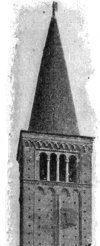
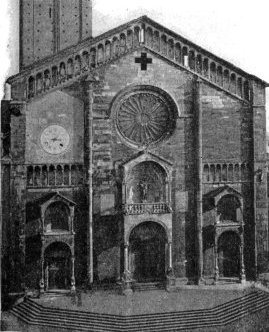
FIG. 91.—WEST FRONT AND CAMPANILE
OF CATHEDRAL, PIACENZA.
LOMBARD STYLE. Owing to the general rebuilding of ancient
churches under the more settled social conditions of the eleventh and
twelfth centuries, little remains to us of the architecture of the three
preceding centuries in Italy, except the Roman basilicas and a few
baptisteries and circular churches, already mentioned in Chapter X.
The so-called Lombard monuments belong mainly to the eleventh and
twelfth centuries. They are found not only in Lombardy, but also in
Venetia and the Æmilia. Milan, Pavia, Piacenza, Bologna, and Verona were
important centres of development of this style. The churches were nearly
all vaulted, but the plans were basilican, with such variations
158
as resulted from efforts to meet the exigencies of vaulted construction.
The nave was narrowed, and instead of rows of columns carrying a thin
clearstory wall, a few massive piers of masonry, connected by broad
pier-arches, supported the heavy ribs of the groined vaulting, as in
S. Ambrogio, Milan (Fig. 90). To resist the thrust of the main
vault, the clearstory was sometimes suppressed, the side aisle carried
up in two stories forming galleries, and rows of chapels added at the
sides, their partitions forming buttresses. The piers were often of
clustered section, the better to receive the various arches and ribs
they supported. The vaulting was in square divisions or
vaulting-bays, each embracing two pier-arches which met upon an
intermediate pier lighter than the others. Thus the whole aspect of the
interior was revolutionized. The lightness, spaciousness, and decorative
elegance of the basilicas were here exchanged for a sombre and massive
dignity severe in its plainness. The Choir was sometimes raised a few
feet above the nave, to allow of a crypt and confessio beneath,
reached by broad flights of steps from the nave. Sta.
159
Maria della Pieve at Arezzo (9th-11th century), S. Michele
at Pavia (late 11th century), the Cathedral of Piacenza (1122),
S. Ambrogio at Milan (12th century), and S. Zeno
at Verona (1139) are notable monuments of this style.
LOMBARD EXTERIORS. The few architectural embellishments
employed on the simple exteriors of the Lombard churches were usually
effective and well composed. Slender columnettes or long pilasters,
blind arcades, and open arcaded galleries under the eaves gave light and
shade to these exteriors. The façades were mere frontispieces with a
single broad gable, the three aisles of the church being merely
suggested by flat or round pilasters dividing the front (Fig 91). Gabled
porches, with columns resting on the backs of lions or monsters, adorned
the doorways. The carving was often of a fierce and grotesque character.
Detached bell-towers or campaniles adjoined many of these
churches; square and simple in mass, but with well-distributed openings
and well-proportioned belfries (Piacenza S. Zeno at Verona,
etc.).18
THE TUSCAN ROMANESQUE. The churches of this style (sometimes
called the Pisan) were less vigorous but more elegant and
artistic in design than the Lombard. They were basilicas in plan, with
timber ceilings and high clearstories on columnar arcades. In their
decoration, both internal and external, they betray the influence of
Byzantine traditions, especially in the use of white and colored marble
in alternating bands or in panelled veneering. Still more striking is
the external decorative application of wall-arcades, sometimes occupying
the whole height of the wall and carried on flat pilasters, sometimes in
superposed stages of small arches on slender columns standing free of
the wall. In general the decorative element prevailed over the
constructive in the design of these picturesquely beautiful churches,
some of which are of noble size. The Duomo (cathedral) of
Pisa, built 1063–1118, is the finest monument
160
of the style (Figs. 92, 93). It is 312 feet long and 118 wide, with long
transepts and an elliptical dome of later date over the crossing
(the intersection of nave and transepts). Its richly arcaded front and
banded flanks strikingly exemplify the illogical and unconstructive but
highly decorative methods of the Tuscan Romanesque builders. The
circular Baptistery (1153), with its lofty domical central hall
surrounded by an aisle, an imposing development of the type established
by Constantine (p. 111), and the famous
Leaning Tower (1174), both designed with external arcading,
combine with the Duomo to form the most remarkable group of
ecclesiastical buildings in Italy, if not in Europe (Fig. 92).

FIG. 92.—BAPTISTERY, CATHEDRAL, AND LEANING TOWER, PISA.
The same style appears in more flamboyant shape in
161
some of the churches of Lucca. The cathedral S. Martino
(1060; façade, 1204; nave altered in fourteenth century) is the finest
and largest of these; S. Michele (façade, 1288) and
S. Frediano (twelfth century) have the most elaborately decorated
façades. The same principles of design appear in the cathedral and
several other churches in Pistoia and Prato; but these belong, for the
most part, to the Gothic period.

FIG. 93.—INTERIOR OF PISA CATHEDRAL.
FLORENCE. The church of S. Miniato, in the suburbs of
Florence, is a beautiful example of a modification of the Pisan style.
It is in plan a basilica with two piers interrupting the colonnade on
each side of the nave and supporting powerful transverse arches. The
interior is embellished with bands and patterns in black and white, and
the woodwork of the open-timber roof is elegantly decorated with fine
patterns in red, green, blue, and gold—a treatment common in
early mediæval churches, as at Messina, Orvieto, etc. The exterior is
adorned with wall-arches of
162
classic design and with panelled veneering in white and dark marble,
instead of the horizontal bands of the Pisan churches. This system of
external decoration, a blending of Pisan and Italo-Byzantine
methods, became the established practice in Florence, lasting through
the whole Gothic period. The Baptistery of Florence, originally
the cathedral, an imposing polygonal domical edifice of the tenth
century, presents externally one of the most admirable examples of this
practice. Its marble veneering in black and white, with pilasters and
arches of excellent design, is attributed by Vasari to Arnolfo di
Cambio, but is by many considered to be much older, although restored by
that architect in 1294.
Suggestions of the Pisan arcade system are found in widely scattered
examples in the east and south of Italy, mingled with features of
Lombard and Byzantine design. In Apulia, as at Bari, Caserta Vecchia
(1100), Molfetta (1192), and in Sicily, the Byzantine influence is
conspicuous in the use of domes and in many of the decorative details.
Particularly is this the case at Palermo and Monreale, where the
churches erected after the Norman conquest—some of them domical,
some basilican—show a strange but picturesque and beautiful
mixture of Romanesque, Byzantine, and Arabic forms. The Cathedral
of Monreale and the churches of the Eremiti and La
Martorana at Palermo are the most important.
The Italo-Byzantine style has already found mention in the
latter part of Chapter XI. Venice and Ravenna were its chief centres;
while the influence, both of the parent style and of its Italian
offshoot was, as we have just shown, very widespread.
WESTERN ROMANESQUE ARCHITECTURE. In Western Europe the unrest
and lawlessness which attended the unsettled relations of society under
the feudal system long retarded the establishment of that social order
without
163
which architectural progress is impossible. With the eleventh century
there began, however, a great activity in building, principally
among the monasteries, which represented all that there was of culture
and stability amid the prevailing disorder. Undisturbed by war, the only
abodes of peaceful labor, learning, and piety, they had become rich and
powerful, both in men and land. Probably the more or less general
apprehension of the supposed impending end of the world in the year 1000
contributed to this result by driving unquiet consciences to seek refuge
in the monasteries, or to endow them richly.
The monastic builders, with little technical training, but with
plenty of willing hands, sought out new architectural paths to meet
their special needs. Remote from classic and Byzantine models, and
mainly dependent on their own resources, they often failed to realize
the intended results. But skill came with experience, and with advancing
civilization and a surer mastery of construction came a finer taste and
greater elegance of design. Meanwhile military architecture developed a
new science of building, and covered Europe with imposing castles,
admirably constructed and often artistic in design as far as military
exigencies would permit.
CHARACTER OF THE STYLE. The Romanesque architecture of the
eleventh and twelfth centuries in Western Europe (sometimes called the
Round-Arched Gothic) was thus predominantly though not
exclusively monastic. This gave it a certain unity of character in spite
of national and local variations. The problem which the wealthy orders
set themselves was, like that of the Lombard church-builders in Italy,
to adapt the basilica plan to the exigencies of vaulted construction.
Massive walls, round arches stepped or recessed to lighten their
appearance, heavy mouldings richly carved, clustered piers and
jamb-shafts, capitals either of the cushion type or imitated from
the Corinthian,
164
and strong and effective carving—all these are features alike of
French, German, English, and Spanish Romanesque architecture.
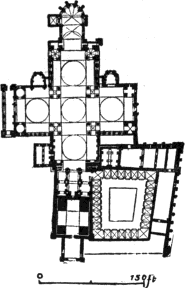
FIG. 94.—PLAN OF ST. FRONT.
THE FRENCH ROMANESQUE. Though monasticism produced remarkable
results in France, architecture there did not wholly depend upon the
monasteries. Southern Gaul (Provence) was full of classic remains and
classic traditions while at the same time it maintained close trade
relations with Venice and the East.19 The church of St. Front at
Perigueux, built in 1120, reproduced the plan of St. Mark’s with
singular fidelity, but without its rich decoration, and with pointed
instead of round arches (Figs. 94, 95). The domical cathedral of
Cahors (1050–1100), an obvious imitation of S. Irene
at Constantinople, and the later and more Gothic Cathedral of
Angoulême display a notable advance in architectural skill
outside of the monasteries. Among the abbeys, Fontevrault
(1101–1119) closely resembles Angoulême, but surpasses it in the
elegance of its choir and chapels. In these and a number of other
domical churches of the same Franco-Byzantine type in Aquitania, the
substitution of the Latin cross in the plan for the Greek cross used in
St. Front, evinces the Gallic tendency to work out to their logical end
new ideas or new applications of old ones. These striking variations on
Byzantine themes might have developed into an independent local style
but for the overwhelming
165
tide of Gothic influence which later poured in from the North.
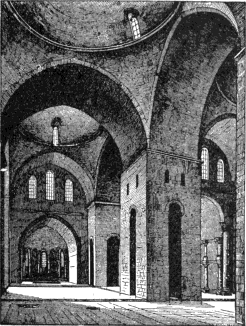
FIG. 95.—INTERIOR OF ST. FRONT, PERIGUEUX.
Meanwhile, farther south (at Arles, Avignon, etc.), classic models
strongly influenced the details, if not the plans, of an interesting
series of churches remarkable especially for their porches rich with
figure sculpture and for their elaborately carved details. The classic
archivolt, the Corinthian capital, the Roman forms of enriched
mouldings, are evident at a glance in the porches of Notre Dame des Doms
at Avignon, of the church of St. Gilles, and of St. Trophime at
Arles.
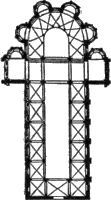
FIG. 96.—PLAN OF NOTRE DAME DU PORT, CLERMONT.
DEVELOPMENT OF VAULTING. It was in Central France, and mainly
along the Loire, that the systematic development of vaulted church
architecture began. Naves covered with barrel-vaults appear in a number
of large churches built during the eleventh and twelfth centuries, with
apsidal and transeptal chapels and aisles carried around the apse, as in
St. Etienne, Nevers, Notre Dame du Port at Clermont-Ferrand (Fig.
96), and St. Paul at Issoire. The thrust of these ponderous
vaults was clumsily resisted by half-barrel vaults over the side-aisles,
transmitting the strain to massive side-walls (Fig. 97), or by high
side-aisles with transverse barrel or groined vaults over each bay. In
either case the clearstory was suppressed—a fact which
mattered
166
little in the sunny southern provinces. In the more cloudy North, in
Normandy, Picardy, and the Royal Domain, the nave-vault was raised
higher to admit of clearstory windows, and its section was in some cases
made like a pointed arch, to diminish its thrust, as at Autun.
But these eleventh-century vaults nearly all fell in, and had to be
reconstructed on new principles. In this work the Clunisians seem to
have led the way, as at Cluny (1089) and Vézelay (1100).
In the latter church, one of the finest and most interesting French
edifices of the twelfth century, a groined vault replaced the
barrel-vault, though the oblong plan of the vaulting-bays, due to the
nave being wider than the pier-arches, led to somewhat awkward twisted
surfaces in the vaulting. But even here the vaults had insufficient
lateral buttressing, and began to crack and settle; so that in the great
ante-chapel, built thirty years later, the side-aisles were made in two
stories, the better to resist the thrust, and the groined vaults
themselves were constructed of pointed section. These seem to be the
earliest pointed groined vaults in France. It was not till the second
half of that century, however (1150–1200), that the flying
buttress was combined with such vaults, so as to permit of high
clearstories for the better lighting of the nave; and
167
the problem of satisfactorily vaulting an oblong space with a groined
vault was not solved until the following century.
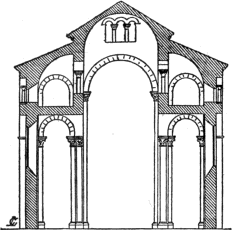
FIG. 97.—SECTION OF NOTRE DAME DU PORT, CLERMONT.
ONE-AISLED CHURCHES. In the Franco-Byzantine churches already
described (p. 164) this difficulty of the
oblong vaulting-bay did not occur, owing to the absence of side-aisles
and pier-arches. Following this conception of church-planning,
a number of interesting parish churches and a few cathedrals were
built in various parts of France in which side-recesses or chapels took
the place of side-aisles. The partitions separating them served as
abutments for the groined or barrel-vaults of the nave. The cathedrals
of Autun (1150) and Langres (1160), and in the fourteenth
century that of Alby, employed this arrangement, common in many earlier
Provençal churches which have disappeared.
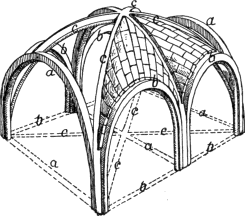
FIG. 98.—A SIX-PART RIBBED VAULT, SHOWING TWO COMPARTMENTS WITH
THE FILLINGS COMPLETE.
a, a, Transverse ribs (doubleaux); b, b, Wall-ribs (formerets);
c, c, Groin-ribs (diagonaux).
(All the ribs are semicircles.)
SIX-PART VAULTING. In the Royal Domain great architectural
activity does not appear to have begun until the beginning of the Gothic
period in the middle of the twelfth century. But in Normandy, and
especially at Caen and Mont St. Michel, there were produced, between
1046 and 1120, some remarkable churches, in which a high clearstory was
secured in conjunction with a vaulted nave, by the use of “six-part”
vaulting (Fig. 98). This was an awkward expedient, by which a square
vaulting-bay was divided into six parts by the groins and by a middle
transverse rib, necessitating two narrow skew vaults meeting at
168
the centre. This unsatisfactory device was retained for over a century,
and was common in early Gothic churches both in France and Great
Britain. It made it possible to resist the thrust by high side-aisles,
and yet to open windows above these under the cross-vaults. The abbey
churches of St. Etienne (the Abbaye aux Hommes) and Ste.
Trinité (Abbaye aux Dames), at Caen, built in the time of William
the Conqueror, were among the most magnificent churches of their time,
both in size and in the excellence and ingenuity of their construction.
The great abbey church of Mont St. Michel (much altered in later
times) should also be mentioned here. At the same time these and other
Norman churches showed a great advance in their internal composition.
A well-developed triforium or subordinate gallery was introduced
between the pier-arches and clearstory, and all the structural membering
of the edifice was better proportioned and more logically expressed than
in most contemporary work.
ARCHITECTURAL DETAILS. The details of French Romanesque
architecture varied considerably in the several provinces, according as
classic, Byzantine, or local influences prevailed. Except in a few of
the Aquitanian churches, the round arch was universal. The walls were
heavy and built of rubble between facings of stones of moderate size
dressed with the axe. Windows and doors were widely splayed to diminish
the obstruction of the massive walls, and were treated with jamb-shafts
and recessed arches. These were usually formed with large cylindrical
mouldings, richly carved with leaf ornaments, zigzags, billets, and
grotesques. Figure-sculpture was more generally used in the South than
in the North. The interior piers were sometimes cylindrical, but more
often clustered, and where square bays of four-part or six-part vaulting
were employed, the piers were alternately lighter and heavier. Each
shaft had its independent capital either of the block type or of a form
169
resembling somewhat that of the Corinthian order. During the eleventh
century it became customary to carry up to the main vaulting one or more
shafts of the compound pier to support the vaulting ribs. Thus the
division of the nave into bays was accentuated, while at the same
time the horizontal three-fold division of the height by a well-defined
triforium between the pier-arches and clearstory began to be likewise
emphasized.
VAULTING. The vaulting was also divided into bays by
transverse ribs, and where it was groined the groins themselves began in
the twelfth century to be marked by groin-ribs. These were constructed
independently of the vaulting, and the four or six compartments of each
vaulting-bay were then built in, the ribs serving, in part at least, to
support the centrings for this purpose. This far-reaching principle,
already applied by the Romans in their concrete vaults (see p. 84), appears as a re-discovery, or rather an
independent invention, of the builders of Normandy at the close of the
eleventh century. The flying buttress was a later invention; in the
round-arched buildings of the eleventh and twelfth centuries the
buttressing was mainly internal, and was incomplete and timid in its
arrangement.
EXTERIORS. The exteriors were on this account plain and flat.
The windows were small, the mouldings simple, and towers were rarely
combined with the body of the church until after the beginning of the
twelfth century. Then they appeared as mere belfries of moderate height,
with pyramidal roofs and effectively arranged openings, the germs of the
noble Gothic spires of later times. Externally the western porches and
portals were the most important features of the design, producing an
imposing effect by their massive arches, clustered piers, richly carved
mouldings, and deep shadows.
CLOISTERS, ETC. Mention should be made of the other monastic
buildings which were grouped around the abbey
170
churches of this period. These comprised refectories, chapter-halls,
cloistered courts surrounded by the conventual cells, and a large number
of accessory structures for kitchens, infirmaries, stores, etc. The
whole formed an elaborate and complex aggregation of connected
buildings, often of great size and beauty, especially the refectories
and cloisters. Most of these conventual buildings have disappeared, many
of them having been demolished during the Gothic period to make way for
more elegant structures in the new style. There remain, however,
a number of fine cloistered courts in their original form,
especially in Southern France. Among the most remarkable of these are
those of Moissac, Elne, and Montmajour.
MONUMENTS. Italy. (For
basilicas and domical churches of 6th-12th centuries see pp. 118,
119.)—Before 11th century: Sta. Maria at Toscanella, altered 1206;
S. Donato, Zara; chapel at Friuli; baptistery at Boella. 11th
century: S. Giovanni, Viterbo; Sta. Maria della Pieve, Arezzo;
S. Antonio, Piacenza, 1014; Eremiti, 1132, and La Martorana, 1143,
both at Palermo; Duomo at Bari, 1027 (much altered); Duomo and
baptistery, Novara, 1030; Duomo at Parma, begun 1058; Duomo at Pisa,
1063–1118; S. Miniato, Florence, 1063–12th century;
S. Michele at Pavia and Duomo at Modena, late 11th
century.—12th century: in Calabria and Apulia, cathedrals of
Trani, 1100; Caserta, Vecchia, 1100–1153; Molfetta, 1162;
Benevento; churches S. Giovanni at Brindisi, S. Niccolo at
Bari, 1139. In Sicily, Duomo at Monreale, 1174–1189. In Northern
Italy, S. Tomaso in Limine, Bergamo, 1100 (?); Sta. Giulia,
Brescia; S. Lorenzo, Milan, rebuilt 1119; Duomo at Piacenza, 1122;
S. Zeno at Verona, 1139; S. Ambrogio, Milan, 1140, vaulted in
13th century; baptistery at Pisa, 1153–1278; Leaning Tower, Pisa,
1174.—14th century: S. Michele, Lucca, 1188; S. Giovanni
and S. Frediano, Lucca. In Dalmatia, cathedral at Zara,
1192–1204. Many castles and early town-halls, as at Bari, Brescia,
Lucca, etc.
France: Previous to 11th century:
St. Germiny-des-Prés, 806, Chapel of the Trinity, St.
Honorat-des-Lérins; Ste. Croix de Montmajour.—11th century:
Cérisy-la-Forêt and abbey church of Mont St. Michel, 1020 (the latter
altered in 12th and 16th centuries); Vignory; St. Genou; porch of St. Bénoit-sur-Loire,
1030; St. Sépulchre at Neuvy, 1045; Ste. Trinité
171
(Abbaye aux Dames) at Caen, 1046, vaulted 1140; St. Etienne (Abbaye aux
Hommes) at Caen, same date; St. Front at Perigueux, 1120; Ste. Croix at
Quimperlé, 1081; cathedral, Cahors, 1050–1110; abbey churches of
Cluny (demolished) and Vézelay, 1089–1100; circular church of
Rieux-Mérinville, church of St. Savin in Auvergne, the churches of St.
Paul at Issoire and Notre-Dame-du-Port at Clermont, St. Hilaire and
Notre-Dame-la-Grande at Poitiers; also St. Sernin (Saturnin) at
Toulouse, all at close of 11th and beginning of 12th century.—12th
century: Domical churches of Aquitania and vicinity; Solignac and
Fontévrault, 1120; St. Etienne (Périgueux), St. Avit-Sénieur; Angoulême,
Souillac, Broussac, etc., early 12th century; St. Trophime at Arles,
1110, cloisters later; church of Vaison; abbeys and cloisters at
Montmajour, Tarascon, Moissac (with fragments of a 10th-century cloister
built into present arcades); St. Paul-du-Mausolée; Puy-en-Vélay, with
fine church. Many other abbeys, parish churches, and a few cathedrals in
Central and Northern France especially.
172
EARLY MEDIÆVAL ARCHITECTURE.—Continued.
IN GERMANY, GREAT BRITAIN, AND SPAIN.
Books Recommended: As before, Hübsch
and Reber. Bond, Gothic Architecture in England. Also Brandon,
Analysis of Gothic Architecture. Boisserée, Nieder Rhein.
Ditchfield, The Cathedrals of England. Hasak, Die romanische
und die gotische Baukunst (in Handbuch d. Arch.). Lübke,
Die Mittelalterliche Kunst in Westfalen. Möller, Denkmäler der
deutschen Baukunst. Puttrich, Baukunst des Mittelalters in
Sachsen. Rickman, An Attempt to Discriminate the Styles of
Architecture. Scott, English Church Architecture. Van
Rensselaer, English Cathedrals.
MEDIÆVAL GERMANY. Architecture developed less rapidly and
symmetrically in Germany than in France, notwithstanding the strong
centralized government of the empire. The early churches were of wood,
and the substitution of stone for wood proceeded slowly. During the
Carolingian epoch (800–919), however, a few important
buildings were erected, embodying Byzantine and classic traditions.
Among these the most notable was the Minster or palatine chapel
of Charlemagne at Aix-la-Chapelle, an obvious imitation of San
Vitale at Ravenna. It consisted of an octagonal domed hall surrounded by
a vaulted aisle in two stories, but without the eight niches of the
Ravenna plan. It was preceded by a porch flanked by turrets. The
Byzantine type thus introduced was repeated in later churches, as in the
Nuns’ Choir at Essen (947) and at Ottmarsheim (1050). In the great
monastery at Fulda a basilica with
173
transepts and with an apsidal choir at either end was built in 803.
These choirs were raised above the level of the nave, to admit of crypts
beneath them, as in many Lombard churches; a practice which, with
the reduplication of the choir and apse just mentioned, became very
common in German Romanesque architecture.
EARLY CHURCHES. It was in Saxony that this architecture first
entered upon a truly national development. The early churches of this
province and of Hildesheim (where architecture flourished under the
favor of the bishops, as elsewhere under the royal influence) were of
basilican plan and destitute of vaulting, except in the crypts. They
were built with massive piers, sometimes rectangular, sometimes
clustered, the two kinds often alternating in the same nave. Short
columns were, however, sometimes used instead of piers, either alone, as
at Paulinzelle and Limburg-on-the-Hardt (1024–39), or alternating
with piers, as at Hecklingen, Gernrode (958–1050), and
St. Godehard at Hildesheim (1133). A triple eastern apse,
with apsidal chapels projecting eastward from the transepts, were common
elements in the plans, and a second apse, choir, and crypt at the west
end were not infrequent. Externally the most striking feature was the
association of two, four, or even six square or circular towers with the
mass of the church, and the elevation of square or polygonal turrets or
cupolas over the crossing. These adjuncts gave a very picturesque aspect
to edifices otherwise somewhat wanting in artistic interest.

FIG. 99.—PLAN OF MINSTER AT WORMS.
RHENISH CHURCHES. It was in the Rhine provinces that vaulting
was first applied to the naves of German churches, nearly a half century
after its general adoption in France. Cologne possesses an
174
interesting trio of churches in which the Byzantine dome on squinches or
on pendentives, with three apses or niches opening into the central
area, was associated with a long three aisled nave (St.
Mary-in-the-Capitol, begun in 9th century; Great St.
Martin’s, 1150–70; Apostles’ Church, 1160–99: the
naves vaulted later). The double chapel at Schwarz-Rheindorf,
near Bonn (1151), also has the crossing covered by a dome on
pendentives.
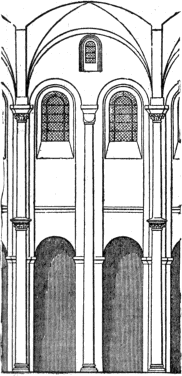
FIG. 100.—ONE BAY OF CATHEDRAL AT SPIRES.
The vaulting of the nave itself was developed in another series of
edifices of imposing size, the cathedrals of Mayence (1036),
Spires (Speyer), and Worms, and the Abbey of Laach,
all built in the 11th century and vaulted early in the 12th. In the
first three the main vaulting is in square bays, each covering two bays
of the nave, the piers of which are alternately lighter and heavier
(Figs. 99, 100). At Laach the vaulting-bays are oblong, both in nave and
aisles. There was no triforium gallery, and stability was secured only
by excessive thickness in the piers and clearstory walls, and by
bringing down the main vault as near to the side-aisle roofs as
possible.
RHENISH EXTERIORS. These great churches, together with those
of Bonn and Limburg-on-the-Lahn and the cathedral of
Treves (Trier, 1047), are interesting, not only by their size and
dignity of plan and the somewhat rude massiveness of their construction,
but even more so by the picturesqueness
175
of their external design (Fig. 101). Especially successful is the
massing of the large and small turrets with the lofty nave-roof and with
the apses at one or both ends. The systematic use of arcading to
decorate the exterior walls, and the introduction of open arcaded dwarf
galleries under the cornices of the apses, gables, and dome-turrets,
gave to these Rhenish churches an external beauty hardly equalled in
other contemporary edifices. This method of exterior design, and the
system of vaulting in square bays over double bays of the nave, were
probably derived from the Lombard churches of Northern Italy, with which
the Hohenstauffen emperors had many political
relations.

FIG. 101.—EAST END OF CHURCH OF THE APOSTLES, COLOGNE.
The Italian influence is also encountered in a number of circular
churches of early date, as at Fulda (9th-11th century), Drügelte, Bonn
(baptistery, demolished), and in façades like that at Rosheim, which is
a copy in little of San Zeno at Verona.
Elsewhere in Germany architecture was in a backward state, especially
in the southern provinces. Outside of Saxony, Franconia, and the Rhine
provinces, very few works of importance were erected until the
thirteenth century.
176
SECULAR ARCHITECTURE. Little remains to us of the secular
architecture of this period in Germany, if we except the great feudal
castles, especially those of the Rhine, which were, after all, rather
works of military engineering than of architectural art. The palace of
Charlemagne at Aix (the chapel of which was mentioned on p. 172) is known to have been a vast and splendid
group of buildings, partly, at least of marble; but hardly a vestige of
it remains. Of the extensive Palace of Henry III. at
Goslar there remain well-defined ruins of an imposing hall of
assembly in two aisles with triple-arched windows. At Brunswick the east
wing of the Burg Dankwargerode displays, in spite of modern
alterations, the arrangement of the chapel, great hall, two fortified
towers, and part of the residence of Henry the Lion. The Wartburg
palace (Ludwig III., cir. 1150) is more generally
known—a rectangular hall in three stories, with windows
effectively grouped to form arcades; while at Gelnhausen and Münzenberg
are ruins of somewhat similar buildings. A few of the Romanesque
monasteries of Germany have left partial remains, as at
Maulbronn, which was almost entirely rebuilt in the Gothic
period, and isolated buildings in Cologne and elsewhere. There remain
also in Cologne a number of Romanesque private houses with coupled
windows and stepped gables.
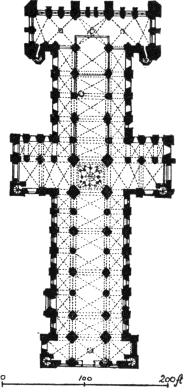
FIG. 102.—PLAN OF DURHAM CATHEDRAL.
GREAT BRITAIN. Previous to the Norman conquest (1066) there
was in the British Isles little or no architecture worthy of mention.
The few extant remains of Saxon and Celtic buildings reveal a singular
poverty of ideas and want of technical skill. These scanty remains are
mostly of towers (those in Ireland nearly all round and tapering, with
conical tops, their use and date being the subjects of much controversy)
and crypts. The tower of Earl’s Barton is the most important and best
preserved of those in England. With the Norman conquest, however, began
an extraordinary activity in the building of churches and abbeys.
177
William the Conqueror himself founded a number of these, and his Norman
ecclesiastics endeavored to surpass on British soil the contemporary
churches of Normandy. The new churches differed somewhat from their
French prototypes; they were narrower and lower, but much longer,
especially as to the choir and transepts. The cathedrals of
Durham (1096–1133) and Norwich (same date) are
important examples (Fig. 102). They also differed from the French
churches in two important particulars externally; a huge tower rose
usually over the crossing, and the western portals were small and
insignificant. Lateral entrances near the west end were given greater
importance and called Galilees. At Durham a Galilee chapel (not
shown in the plan), takes the place of a porch at the west end, like the
ante-churches of St. Benoît-sur-Loire and Vézelay.
THE NORMAN STYLE. The Anglo-Norman builders employed the same
general features as the Romanesque builders of Normandy, but with more
of picturesqueness and less of refinement and technical elegance. Heavy
walls, recessed arches, round mouldings, cubic cushion-caps, clustered
piers, and in doorways a jamb-shaft for each stepping of the arch were
common to both styles. But in England the Corinthian form of capital is
rare, its place being taken by simpler forms.

FIG. 103.—ONE BAY OF TRANSEPT, WINCHESTER CATHEDRAL.
NORMAN INTERIORS. The interior design of the larger churches
of this period shows a close general analogy to
178
contemporaneous French Norman churches, as appears by comparing the nave
of Waltham or Peterboro’ with that of Cérisy-la-Forêt, in Normandy.
Although the massiveness of the Anglo-Norman piers and walls plainly
suggests the intention of vaulting the nave, this intention seems never
to have been carried out except in small churches and crypts. All the
existing abbeys and cathedrals of this period had wooden ceilings or
were, like Durham, Norwich, and Gloucester, vaulted at a later date.
Completed as they were with wooden nave-roofs, the clearstory was,
without danger, made quite lofty and furnished with windows of
considerable size. These were placed near the outside of the thick wall,
and a passage was left between them and a triple arch on the inner face
of the wall—a device imitated from the abbeys at Caen. The
vaulted side-aisles were low, with disproportionately wide pier-arches,
above which was a high triforium gallery under the side-roofs. Thus a
nearly equal height was assigned to each of the three stories of the
bay, disregarding that subordination of minor to major parts which gives
interest to an architectural composition. The piers were quite often
round, as at Gloucester, Hereford, and Bristol. Sometimes round piers
alternated with clustered piers, as at Durham and Waltham; and in some
cases clustered piers alone were employed, as at Peterboro’ and in the
transepts of Winchester (Fig. 103).
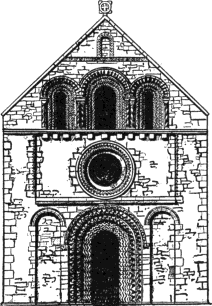
FIG. 104.—FRONT OF IFFLEY CHURCH.
FAÇADES AND DOORWAYS. All the details were of the simplest
character, except in the doorways. These were richly adorned with
clustered jamb-shafts and elaborately carved
179
mouldings, but there was little variety in the details of this carving.
The zigzag was the most common feature, though birds’ heads with the
beaks pointing toward the centre of the arch were not uncommon. In the
smaller churches (Fig. 104) the doorways were better proportioned to the
whole façade than in the larger ones, in which they appear as relatively
insignificant features. Very few examples remain of important Norman
façades in their original form, nearly all of these having been altered
after the round arch was displaced by the pointed arch in the latter
part of the twelfth century. Iffley church (Fig. 104) is a good example
of the style.
SPAIN. During the Romanesque period a large part of Spain was
under Moorish dominion. The capture of Toledo, in 1062, by the
Christians, began the gradual emancipation of the country from Moslem
rule, and in the northern provinces a number of important churches were
erected under the influence of French Romanesque models. The use of
domical pendentives (as in the Panteon of S. Isidoro,
at Leon, and in the cimborio or dome over the choir at the
intersection of nave and transepts in old Salamanca cathedral) was
probably derived from the domical churches of Aquitania and Anjou.
Elsewhere the northern Romanesque type prevailed under various
modifications, with long nave and transepts, a short choir, and a
180
complete chevet with apsidal chapels. The church of St.
Iago at Compostella (1078) is the finest example of this class.
These churches nearly all had groined vaulting over the side-aisles and
barrel-vaults over the nave, the constructive system being substantially
that of the churches of Auvergne and the Loire Valley (p. 165). They differed, however, in the treatment of
the crossing of nave and transepts, over which was usually erected a
dome or cupola or pendentives or squinches, covered externally by an
imposing square lantern or tower, as in the Old Cathedral at
Salamanca, already mentioned (1120–78) and the
Collegiate Church at Toro. Occasional exceptions to these
types are met with, as in the basilican wooden-roofed church of
S. Millan at Segovia; in S. Isidoro at Leon, with
chapels and a later-added square eastern end, and the circular church of
the Templars at Segovia.
The architectural details of these Spanish churches did not differ
radically from contemporary French work. As in France and England, the
doorways were the most ornate parts of the design, the mouldings being
carved with extreme richness and the jambs frequently adorned with
statues, as in S. Vincente at Avila. There was no such
logical and reasoned-out system of external design as in France, and
there is consequently greater variety in the façades. Perhaps the most
remarkable thing about the architecture of this period is its apparent
exemption from the influence of the Moorish monuments which abounded on
every hand. This may be explained by the hatred which was felt by the
Christians for the Moslems and all their works.
MONUMENTS. Germany: Previous
to 11th century: Circular churches of Holy Cross at Münster, and of
Fulda; palace chapel of Charlemagne at Aix-la-Chapelle, 804; St.
Stephen, Mayence, 990; primitive nave and crypt of St. Gereon, Cologne,
10th century; Lorsch.—11th century: Churches of Gernrode, Goslar,
and Merseburg in Saxony; cathedral
181
of Bremen; first restoration of cathedral of Treves (Trier), 1010, west
front, 1047; Limburg-on-Hardt, 1024; St. Willibrod, Echternach, 1031;
east end of Mayence Cathedral, 1036; Church of Apostles and nave St.
Mary-in-Capitol at Cologne, 1036; cathedral of Spires (Speyer) begun
1040; Cathedral Hildesheim, 1061; St. Joseph, Bamberg, 1073; Abbey of
Laach, 1093–1156; round churches of Bonn, Drügelte, Nimeguen;
cathedrals of Paderborn and Minden.—12th century: Churches of
Klus, Paulinzelle, Hamersleben, 1100–1110; Johannisberg, 1130; St.
Godehard. Hildesheim, 1133; Worms, the Minster, 1118–83; Jerichau,
1144–60; Schwarz-Rheindorf, 1151; St. Michael, Hildesheim, 1162;
Cathedral Brunswick, 1172–94; Lubeck, 1172; also churches of
Gaudersheim, Würzburg, St. Matthew at Treves, Limburg-on-Lahn, Sinzig,
St. Castor at Coblentz, Diesdorf, Rosheim; round churches of Ottmarsheim
and Rippen (Denmark); cathedral of Basle, cathedral and cloister of
Zurich (Switzerland).
England: Previous to 11th century:
Scanty vestiges of Saxon church architecture, as tower of Earl’s Barton,
round towers and small chapels in Ireland.—11th century: Crypt of
Canterbury Cathedral, 1070; chapel St. John in Tower of London, 1070;
Winchester Cathedral, 1076–93 (nave and choir rebuilt later);
Gloucester Cathedral nave, 1089–1100 (vaulted later); Rochester
Cathedral nave, west front cloisters, and chapter-house,
1090–1130; Carlisle Cathedral nave, transepts, 1093–1130;
Durham Cathedral, 1095–1133, vaulted 1233; Galilee and
chapter-house, 1133–53; Norwich Cathedral, 1096, largely rebuilt
1118–93; Hereford Cathedral, nave and choir,
1099–1115.—12th century: Ely Cathedral, nave, 1107–33;
St. Alban’s Abbey, 1116; Peterboro’ Cathedral, 1117–45; Waltham
Abbey, early 12th century; Church of Holy Sepulchre, Cambridge,
1130–35; Worcester Cathedral chapter-house, 1140 (?); Oxford
Cathedral (Christ Church), 1150–80; Bristol Cathedral
chapter-house (square), 1155; Canterbury Cathedral, choir of present
structure by William of Sens, 1175; Chichester Cathedral,
1180–1204; Romsey Abbey, late 12th century; St. Cross Hospital
near Winchester, 1190 (?). Many more or less important parish churches
in various parts of England.
Spain. For principal monuments of
9th-12th centuries, see text, latter part of this chapter.
182
GOTHIC ARCHITECTURE.
Books Recommended: Adamy,
Architektonik des gotischen Stils. Corroyer, L’Architecture
gothique. Enlart, Manuel d’archéologie française. Hasak,
Einzelheiten des Kirchenbaues (in Hdbuch d. Arch.). Moore,
Development and Character of Gothic Architecture. Parker,
Introduction to Gothic Architecture. Scott, Mediæval
Architecture. Viollet-le-Duc, Discourses on Architecture;
Dictionnaire raisonné de l’architecture française.
INTRODUCTORY. The architectural styles which were developed in
Western Europe during the period extending from about 1150 to 1450 or
1500, received in an unscientific age the wholly erroneous and inept
name of Gothic. This name has, however, become so fixed in common usage
that it is hardly possible to substitute for it any more scientific
designation. In reality the architecture to which it is applied was
nothing more than the sequel and outgrowth of the Romanesque, which we
have already studied. Its fundamental principles were the same; it was
concerned with the same problems. These it took up where the Romanesque
builders left them, and worked out their solution under new conditions,
until it had developed out of the simple and massive models of the early
twelfth century the splendid cathedrals of the thirteenth and fourteenth
centuries in England, France, Germany, the Low Countries and Spain.
THE CHURCH AND ARCHITECTURE. The twelfth century was an era of
transition in society, as in architecture. The ideas of Church and State
were becoming more clearly defined in the common mind. In the conflict
between feudalism
183
and royalty the monarchy was steadily gaining ground. The problem of
human right was beginning to present itself alongside of the problem of
human might. The relations between the crown, the feudal barons, the
pope, bishops, and abbots, differed widely in France, Germany, England,
and other countries. The struggle among them for supremacy presented
itself, therefore, in varied aspects; but the general outcome was
essentially the same. The church began to appear as something behind and
above abbots, bishops, kings, and barons. The supremacy of the papal
authority gained increasing recognition, and the episcopacy began to
overshadow the monastic institutions; the bishops appearing generally,
but especially in France, as the champions of popular rights. The
prerogatives of the crown became more firmly established, and thus the
Church and the State emerged from the social confusion as the two
institutions divinely appointed for the government of men.
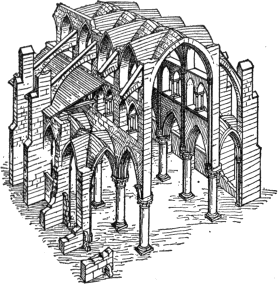
FIG. 105.—CONSTRUCTIVE SYSTEM OF GOTHIC CHURCH,
ILLUSTRATING PRINCIPLES OF ISOLATED SUPPORTS AND BUTTRESSING.
Under these influences ecclesiastical architecture advanced with
rapid strides. No longer hampered by monastic restrictions, it called
into its service the laity, whose guilds of masons and builders carried
from one diocese to another their constantly increasing stores of
constructive
184
knowledge. By a wise division of labor, each man wrought only such parts
as he was specially trained to undertake. The
master-builder—bishop, abbot, or mason—seems to have planned
only the general arrangement and scheme of the building, leaving the
precise form of each detail to be determined as the work advanced,
according to the skill and fancy of the artisan to whom it was
intrusted. Thus was produced that remarkable variety in unity of the
Gothic cathedrals; thus, also, those singular irregularities and
makeshifts, those discrepancies and alterations in the design, which are
found in every great work of mediæval architecture. Gothic architecture
was constantly changing, attacking new problems or devising new
solutions of old ones. In this character of constant flux and
development it contrasts strongly with the classic styles, in which the
scheme and the principles were easily fixed and remained substantially
unchanged for centuries.
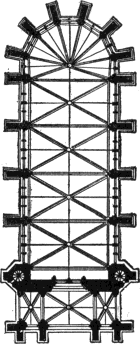
FIG. 106.—PLAN OF SAINTE CHAPELLE, PARIS, SHOWING SUPPRESSION OF
SIDE-WALLS.
STRUCTURAL PRINCIPLES. The pointed arch, so commonly regarded
as the most characteristic feature of the Gothic styles, was merely an
incidental feature of their development. What really distinguished them
most strikingly was the systematic application of two principles which
the Roman and Byzantine builders had recognized and applied, but which
seem to have been afterward forgotten until they were revived by the
later Romanesque architects. The first of these was the concentration
of strains upon isolated points of support, made possible by the
substitution
185
of groined for barrel vaults. This led to a corresponding concentration
of the masses of masonry at these points; the building was constructed
as if upon legs (Fig. 105). The wall became a mere filling-in between
the piers or buttresses, and in time was, indeed, practically
suppressed, immense windows filled with stained glass taking its place.
This is well illustrated in the Sainte Chapelle at Paris, built
1242–47 (Figs. 106, 122). In this
remarkable edifice, a series of groined vaults spring from slender
shafts built against deep buttresses which receive and resist all the
thrusts. The wall-spaces between them are wholly occupied by superb
windows filled with stone tracery and stained glass. It would be
impossible to combine the materials used more scientifically or
effectively. The cathedrals of Gerona (Spain) and of Alby (France; Fig. 123) illustrate the same principle,
though in them the buttresses are internal and serve to separate the
flanking chapels.
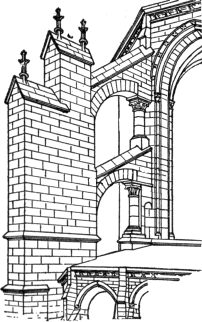
FIG. 107.—EARLY GOTHIC FLYING BUTTRESS.
The second distinctive principle of Gothic architecture was that of
balanced thrusts. In Roman buildings the thrust of the vaulting
was resisted wholly by the inertia of mass in the abutments. In Gothic
architecture thrusts were as far as possible resisted by
counter-thrusts, and the final resultant pressure was transmitted by
flying half-arches across the intervening portions of the structure to
external buttresses placed at convenient points. This combination
186
of flying half-arches and buttresses is called the
flying-buttress (Fig. 107). It reached its highest development in
the thirteenth and fourteenth centuries in the cathedrals of central and
northern France.
RIBBED VAULTING. These two principles formed the structural
basis of the Gothic styles. Their application led to the introduction of
two other elements, second only to them in importance, ribbed
vaulting and the pointed arch.
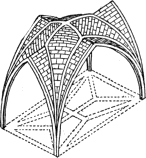
FIG. 108.—RIBBED VAULT, ENGLISH TYPE, WITH DIVIDED GROIN-RIBS AND
RIDGE-RIBS.
The first of these resulted from the effort to overcome certain
practical difficulties encountered in the building of large groined
vaults. As ordinarily constructed, a groined vault like that in Fig. 47, must be built as one structure, upon
wooden centrings supporting its whole extent. The Romanesque architects
conceived the idea of constructing an independent skeleton of ribs. Two
of these were built against the wall (wall-ribs), two across the
nave (transverse ribs); and two others were made to coincide with the
groins (Figs. 98, 108). The groin-ribs,
intersecting at the centre of the vault, divided each bay into four
triangular portions, or compartments, each of which was really an
independent vault which could be separately constructed upon light
centrings supported by the groin-ribs themselves. This principle, though
identical in essence with the Roman system of brick skeleton-ribs for
concrete vaults, was, in application and detail, superior to it, both
from the scientific and artistic point of view. The ribs, richly
moulded, became, in the hands of the Gothic architects, important
decorative features. In practice the builder gave to each set of ribs
independently the curvature he desired. The vaulting-surfaces were then
easily twisted or warped so as to fit the
187
various ribs, which, being already in place, served as guides for their
construction.
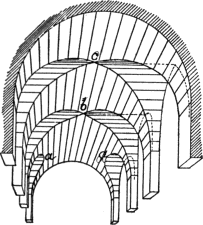
FIG. 109.—PENETRATIONS AND INTERSECTIONS OF VAULTS.
a, a, Penetrations by small semi-circular vaults sprung from same
level. b, Intersection by small semi-circular vault sprung from higher
level; groins form wavy lines. c, Intersection by narrow pointed vault
sprung from same level; groins are plane curves.
THE POINTED ARCH was adopted to remedy the difficulties
encountered in the construction of oblong vaults. It is obvious that
where a narrow semi-cylindrical vault intersects a wide one, it produces
either what are called penetrations, as at a (Fig. 109),
or intersections like that at b, both of which are awkward
in aspect and hard to construct. If, however, one or both vaults be
given a pointed section, the narrow vault may be made as high as the
wide one. It is then possible, with but little warping of the vaulting
surfaces, to make them intersect in groins c, which are
vertical plane curves instead of wavy loops like a
and b.
The Gothic architects availed themselves to the full of these two
devices. They built their groin-ribs of semi-circular or pointed form,
but the wall-ribs and the transverse ribs were, without exception,
pointed arches of such curvature as would bring the apex of each nearly
or quite to the level of the groin intersection. The pointed arch, thus
introduced as the most convenient form for the vaulting-ribs, was soon
applied to other parts of the structure. This was a
necessity with the windows and pier-arches, which would not otherwise
fit well the wall-spaces under the wall-ribs of the nave and aisle
vaulting.
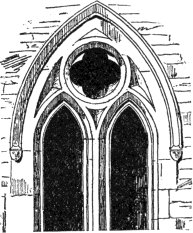
FIG. 110.—PLATE TRACERY, CHARLTON-ON-OXMORE.
TRACERY AND GLASS. With the growth in the size of the windows
and the progressive suppression of the lateral walls
188
of vaulted structures, stained glass came more and more generally into
use. Its introduction not only resulted in a notable heightening and
enriching of the colors and scheme of the interior decoration, but
reacted on the architecture, intensifying the very causes which led to
its introduction. It stimulated the increase in the size of windows, and
the suppression of the walls, and contributed greatly to the development
of tracery. This latter feature was an absolute necessity for the
support of the glass. Its evolution can be traced (Figs, 110, 111, 112)
from the simple coupling of twin windows under a single hood-mould, or
discharging arch, to the florid net-work of the fifteenth century. In
its earlier forms it consisted merely of decorative openings, circles,
and quatrefoils, pierced through slabs of stone (plate-tracery),
filling the window-heads over coupled windows. Later attention was
bestowed upon the form of the stonework, which was made lighter and
richly moulded (bar-tracery), rather than upon that of the
openings (Fig. 111). Then the circular and geometric patterns employed
were abandoned for more flowing and capricious designs
(Flamboyant tracery, Fig. 112) or (in England) for more rigid and
rectangular arrangements (Perpendicular, Fig. 134). It will be shown later that the periods
and styles of Gothic architecture are more easily identified by the
tracery than by any other feature.
CHURCH PLANS. The original basilica-plan underwent radical
modifications during the 12th-15th centuries. These resulted in part
from the changes in construction
189
which have been described, and in part from altered ecclesiastical
conditions and requirements. Gothic church architecture was based on
cathedral design; and the requirements of the cathedral differed in many
respects from those of the monastic churches of the preceding
period.

FIG. 111.—BAR TRACERY, ST. MICHAEL’S, WARFIELD.
The most important alterations in the plan were in the choir and
transepts. The choir was greatly lengthened, the transepts often
shortened. The choir was provided with two and often four side-aisles,
and one or both of these was commonly carried entirely around the
apsidal termination of the choir, forming a single or double
ambulatory. This combination of choir, apse, and ambulatory was
called, in French churches, the chevet.
Another advance upon Romanesque models was the multiplication of
chapels—a natural consequence of the more popular character
of the cathedral as compared with the abbey. Frequently lateral chapels
were built at each bay of the side-aisles, filling up the space between
the deep buttresses, flanking the nave as well as the choir. They were
also carried around the chevet in most of the French cathedrals
(Paris, Bourges, Reims, Amiens, Beauvais, and many others); in many of
those in Germany (Magdeburg, Cologne, Frauenkirche at Treves), Spain
(Toledo, Leon, Barcelona,
190
Segovia, etc.), and Belgium (Tournay, Antwerp). In England the choir had
more commonly a square eastward termination. Secondary transepts occur
frequently, and these peculiarities, together with the narrowness and
great length of most of the plans, make of the English cathedrals a
class by themselves.
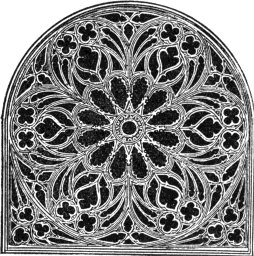
FIG. 112.—ROSE WINDOW, CHURCH OF ST. OUEN, ROUEN.
PROPORTIONS AND COMPOSITION. Along with these modifications of
the basilican plan should be noticed a great increase in the height and
slenderness of all parts of the structure. The lofty clearstory, the
arcaded triforium-passage or gallery beneath it, the high pointed
pier-arches, the multiplication of slender clustered shafts, and the
reduction in the area of the piers, gave to the Gothic churches an
interior aspect wholly different from that of the simpler, lower, and
more massive Romanesque edifices. The perspective effects of the plans
thus modified, especially of the complex choir and chevet with
their lateral and radial chapels, were remarkably enriched and
varied.
The exterior was even more radically transformed by these changes,
and by the addition of towers and spires to the fronts, and sometimes to
the transepts and to their intersection with the nave. The deep
buttresses, terminating in pinnacles, the rich traceries of the great
lateral windows, the triple portals profusely sculptured, rose-windows
of great size under the front and transept gables, combined to produce
191
effects of marvellously varied light and shadow, and of complex and
elaborate structural beauty, totally unlike the broad simplicity of the
Romanesque exteriors.

FIG. 113.—FLAMBOYANT DETAIL FROM PULPIT IN STRASBURG
CATHEDRAL.
DECORATIVE DETAIL. The mediæval designers aimed to enrich
every constructive feature with the most effective play of lights and
shades, and to embody in the decorative detail the greatest possible
amount of allegory and symbolism, and sometimes of humor besides. The
deep jambs and soffits of doors and pier-arches were moulded with a rich
succession of hollow and convex members, and adorned with carvings of
saints, apostles, martyrs, and angels. Virtues and vices, allegories of
reward and punishment, and an extraordinary world of monstrous and
grotesque beasts, devils, and goblins filled the capitals and
door-arches, peeped over tower-parapets, or leered and grinned from
gargoyles and corbels. Another source of decorative detail was the
application of tracery like that of the windows to wall-panelling, to
balustrades, to open-work gables, to spires, to choir-screens, and other
features, especially in
192
the late fourteenth and fifteenth centuries (cathedrals of York, Rouen,
Cologne; Henry VII.’s Chapel, Westminster). And finally in the carving
of capitals and the ornamentation of mouldings the artists of the
thirteenth century and their successors abandoned completely the classic
models and traditions which still survived in the early twelfth
century. The later monastic builders began to look
directly to nature for suggestions of decorative form. The lay builders
who sculptured the capitals and crockets and finials of the early Gothic
cathedrals adopted and followed to its finality this principle of
recourse to nature, especially to plant life. At first the budding
shoots of early spring were freely imitated or skilfully
conventionalized, as being by their thick and vigorous forms the best
adapted for translation into stone (Fig. 114). During the thirteenth
century the more advanced stages of plant growth, and leaves more
complex and detailed, furnished the models for the carver, who displayed
his skill in a closer and more literal imitation of their minute
veinings and indentations (Fig. 115).
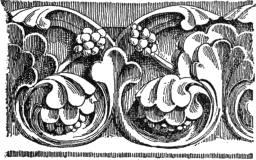
FIG. 114.—EARLY GOTHIC CARVING.
This artistic adaptation of natural forms to architectural decoration
degenerated later into a minutely realistic copying of natural foliage,
in which cleverness of execution took the place of original invention.
The spirit of display is characteristic of all late Gothic work.
Slenderness, minuteness of detail, extreme complexity and intricacy of
design, an unrestrained profusion of decoration covering every surface,
a lack of largeness and vigor in the conceptions, are conspicuous
traits of Gothic design in the fifteenth century,
193
alike in France, England, Germany, Spain, and the Low Countries. Having
worked out to their conclusion the structural principles bequeathed to
them by the preceding centuries, the authors of these later works seemed
to have devoted themselves to the elaboration of mere decorative detail,
and in technical finish surpassed all that had gone before (Fig.
113).

FIG. 115.—CARVING, DECORATED PERIOD, FROM SOUTHWELL MINSTER.
CHARACTERISTICS SUMMARIZED. In the light of the preceding
explanations Gothic architecture may be defined as that system of
structural design and decoration which grew up out of the effort to
combine, in one harmonious and organic conception, the basilican plan
with a complete and systematic construction of groined vaulting. Its
development was controlled throughout by considerations of stability and
structural propriety, but in the application of these considerations the
artistic spirit was allowed full scope for its exercise. Refinement,
good taste, and great fertility of imagination characterize the details
and ornaments of Gothic structures. While the Greeks in harmonizing the
requirements of utility and beauty in architecture approached the
problem from the æsthetic side, the Gothic architects did the same from
the structural side. Their admirably reasoned structures express as
perfectly the idea of vastness, mystery, and complexity as do the Greek
temples that of simplicity and monumental repose.
194
The excellence of Gothic architecture lay not so much in its
individual details as in its perfect adaptation to the purposes for
which it was developed—its triumphs were achieved in the building
of cathedrals and large churches. In the domain of civil and domestic
architecture it produced nothing comparable with its ecclesiastical
edifices, because it was the requirements of the cathedral and not of
the palace, town-hall, or dwelling, that gave it its form and
character.
PERIODS. The history of Gothic architecture is commonly
divided into three periods, which are most readily distinguished by the
character of the window-tracery. These periods were not by any means
synchronous in the different countries; but the order of sequence was
everywhere the same. They are here given, with a summary of the
characteristics of each.
Early Pointed Period. [Early
French; Early English or Lancet Period in England;
Early German, etc.] Simple groined vaults; general simplicity and
vigor of design and detail; conventionalized foliage of small plants;
plate tracery, and narrow windows coupled under pointed arch with
circular foiled openings in the window-head. (In France, 1160 to
1275.)
Middle Pointed Period.
[Rayonnant in France; Decorated or Geometric in
England.] Vaults more perfect; in England multiple ribs and liernes;
greater slenderness and loftiness of proportions; decoration much
richer, less vigorous; more naturalistic carving of mature foliage;
walls nearly suppressed, windows of great size, bar tracery with slender
moulded or columnar mullions and geometric combinations (circles and
cusps) in window-heads, circular (rose) windows. (In France, 1275 to
1375.)
Florid Gothic Period.
[Flamboyant in France; Perpendicular in England.] Vaults
of varied and richly decorated design; fan-vaulting and pendants in
England, vault-ribs
195
curved into fanciful patterns in Germany and Spain; profuse and minute
decoration and cleverness of technical execution substituted for dignity
of design; highly realistic carving and sculpture, flowing or flamboyant
tracery in France; perpendicular bars with horizontal transoms and
four-centred arches in England; “branch-tracery” in Germany. (In France,
1375 to 1525.)
196
GOTHIC ARCHITECTURE IN FRANCE.
Books Recommended: As before, Adamy,
Corroyer, Enlart, Hasak, Moore, Reber, Viollet-le-Duc.20 Also Chapuy, Le
moyen age monumental. Chateau, Histoire et caractères de
l’architecture française. Davies, Architectural Studies in
France. Ferree, The Chronology of the Cathedral Churches of
France. Johnson, Early French Architecture. King, The
Study book of Mediæval Architecture and Art. Lassus and
Viollet-le-Duc, Notre Dame de Paris. Nesfield, Specimens of
Mediæval Architecture. Pettit, Architectural Studies in
France.
CATHEDRAL-BUILDING IN FRANCE. In the development of the
principles outlined in the foregoing chapter the church-builders of
France led the way. They surpassed all their contemporaries in readiness
of invention, in quickness and directness of reasoning, and in artistic
refinement. These qualities were especially manifested in the
extraordinary architectural activity which marked the second half of the
twelfth century and the first half of the thirteenth. This was the great
age of cathedral-building in France. The adhesion of the bishops to the
royal cause, and their position in popular estimation as the champions
of justice and human rights, led to the rapid advance of the episcopacy
in power and influence. The cathedral, as the throne-church of the
bishop, became a truly popular institution. New cathedrals were founded
on every side, especially in the
197
Royal Domain and the adjoining provinces of Normandy, Burgundy, and
Champagne, and their construction was warmly seconded by the people, the
communes, and the municipalities. “Nothing to-day,” says
Viollet-le-Duc,21 “unless it be the commercial movement which has covered
Europe with railway lines, can give an idea of the zeal with which the
urban populations set about building cathedrals; . . .
a necessity at the end of the twelfth century because it was an
energetic protest against feudalism.” The collapse of the unscientific
Romanesque vaulting of some of the earlier cathedrals and the
destruction by fire of others stimulated this movement by the necessity
for their immediate rebuilding. The entire reconstruction of the
cathedrals of Bayeux, Bayonne, Cambray, Evreux, Laon, Lisieux, Le Mans,
Noyon, Poitiers, Senlis, Soissons, and Troyes was begun between 1130 and
1200.22 The cathedrals of Bourges, Chartres, Paris, and Tours,
and the abbey of St. Denis, all of the first importance, were begun
during the same period, and during the next quarter-century those of
Amiens, Auxerre, Rouen, Reims, Séez, and many others. After 1250 the
movement slackened and finally ceased. Few important cathedrals were
erected during the latter half of the thirteenth century, the chief
among them being at Beauvais (actively begun 1247), Clermont, Coutances,
Limoges, Narbonne, and Rodez. During this period, and through the
fourteenth and fifteenth centuries, French architecture was concerned
rather with the completion and remodelling of existing cathedrals than
the founding of new ones. There were, however, many important parish
churches and civil or domestic edifices erected within this period.
STRUCTURAL DEVELOPMENT: VAULTING. By the middle of the twelfth
century the use of barrel-vaulting over the nave had been generally
abandoned and groined vaulting with
198
its isolated points of support and resistance had taken its place. The
timid experiments of the Clunisian architects at Vézelay in the use of
the pointed arch and vault-ribs also led, in the second half of the
twelfth century, to far-reaching results. The builders of the great
Abbey Church of St. Denis, near Paris, begun in 1140 by
the Abbot Suger, appear to have been the first to develop these
tentative devices into a system. In the original choir of this noble
church all the arches, alike of the vault-ribs (except the groin-ribs,
which were semi-circles) and of the openings, were pointed and the
vaults were throughout constructed with cross-ribs, wall-ribs, and
groin-ribs. Of this early work only the chapels remain. In other
contemporary monuments, as for instance in the cathedral of Sens, the
adoption of these devices was only partial and hesitating.
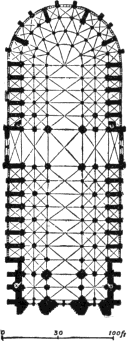
FIG. 116.—PLAN OF NOTRE DAME, PARIS.
NOTRE DAME AT PARIS. The next great step in advance was taken
in the cathedral of Notre Dame23 at Paris (Figs. 116, 117, 125). This was begun, under Maurice de Sully in 1163, on
the site of the twin cathedrals of Ste. Marie and St. Étienne, and the
choir was, as usual, the first portion erected. By 1196 the choir,
transepts, and one or two bays of the nave were substantially finished.
The completeness, harmony, and vigor of conception of this remarkable
church contrast strikingly with the makeshifts and hesitancy displayed
in many contemporary monuments
199
in other provinces. The difficult vaulting over the radiating bays of
the double ambulatory was here treated with great elegance. By doubling
the number of supports in the exterior circuit of each aisle (Fig. 116)
each trapezoidal bay of the vaulting was divided into three easily
managed triangular compartments. Circular shafts were used between the
central and side aisles. The side aisles were doubled and those next the
centre were built in two stories, providing ample galleries behind a
very open triforium. The nave was unusually lofty and covered with
six-part vaults of admirable execution. The vault-ribs were vigorously
moulded and each made to spring from a distinct vaulting-shaft, of which
three rested upon the cap of each of the massive piers below (Fig. 117).
The Cathedral of Bourges, begun 1190, closely resembled
that of Paris in plan. Both were designed to accommodate vast throngs in
their exceptionally broad central aisles and double side aisles, but
Bourges has no side-aisle galleries, though the inner aisles are much
loftier than the outer ones. Though
200
later in date the vaulting of Bourges is inferior to that of Notre Dame,
especially in the treatment of the trapezoidal bays of the
ambulatory.

FIG. 117.—INTERIOR OF NOTRE DAME, PARIS.
The masterly examples set by the vault-builders of St. Denis and
Notre Dame were not at once generally followed. Noyon, Senlis, and
Soissons, contemporary with these, are far less completely Gothic in
style. At Le Mans the groined vaulting which in 1158 was
substituted for the original barrel-vault of the cathedral is of very
primitive design, singularly heavy and awkward, although nearly
contemporary with that of Notre Dame (Fig. 118).
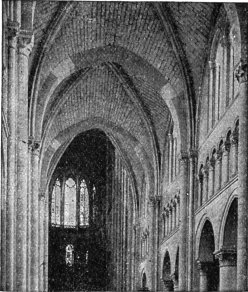
FIG. 118.—LE MANS CATHEDRAL. NAVE.
DOMICAL GROINED VAULTING. The builders of the South and West,
influenced by Aquitanian models, adhered to the square plan and domical
form of vaulting-bay, even after they had begun to employ groin-ribs.
The latter, as at first used by them in imitation of Northern examples,
had no organic function in the vault, which was still built like a dome.
About 1145–1160 the cathedral of St. Maurice at
Angers was vaulted with square, groin-ribbed vaults, domical in
form but not in construction. The joints no longer described horizontal
circles as in a dome, but oblique lines perpendicular to the groins and
meeting in zigzag lines at the ridge (Fig. 119). This method became
common in the West and was afterward generally adopted
201
by the English architects. The Cathedrals of Poitiers
(1162) and Laval (La Trinité, 1180–1185) are examples of
this system, which at Le Mans met with the Northern system and produced
in the cathedral the awkward compromise described above.
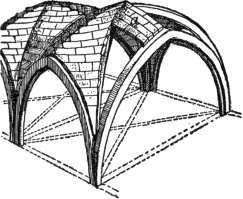
FIG. 119.—GROINED VAULT WITH ZIG-ZAG RIDGE-JOINTS.
a shows a small section of filling with courses parallel to the
ridge, for comparison with the other compartments.
THIRTEENTH-CENTURY VAULTING. Early in the thirteenth century
the church-builders of Northern France abandoned the use of square
vaulting-bays and six-part vaults. By the adoption of groin-ribs and the
pointed arch, the building of vaults in oblong bays was greatly
simplified. Each bay of the nave could now be covered with its own
vaulting-bay, thus doing away with all necessity for alternately light
and heavy piers. It is not quite certain when and where this system was
first adopted for the complete vaulting of a church. It is, however,
probable that the Cathedral of Chartres, begun in 1194 and
completed before 1240, deserves this distinction, although it is
possible that the vaults of Soissons and Noyon may slightly antedate it.
Troyes (1170–1267), Rouen (1202–1220),
Reims (1212–1242), Auxerre (1215–1234, nave
fourteenth century), Amiens (1220–1288), and nearly all the
great churches and chapels begun after 1200, employ the fully developed
oblong vault.
BUTTRESSING. Meanwhile the increasing height of the
clearstories and the use of double aisles compelled the bestowal of
especial attention upon the buttressing. The nave and choir of Chartres,
the choirs of Notre Dame,
202
Bourges, Rouen, and Reims, the chevet and later the choir of St. Denis,
afford early examples of the flying-buttress (Fig. 107). These were at first simple and of moderate
height. Single half-arches spanned the side aisles; in Notre Dame they
crossed the double aisles in a single leap. Later the buttresses were
given greater stability by the added weight of lofty pinnacles. An
intermediate range of buttresses and pinnacles was built over the
intermediate piers where double aisles flanked the nave and choir, thus
dividing the single flying arch into two arches. At the same time a
careful observation of statical defects in the earlier examples led to
the introduction of subordinate arches and of other devices to stiffen
and to beautify the whole system. At Reims and Amiens
these features received their highest development, though later examples
are frequently much more ornate.
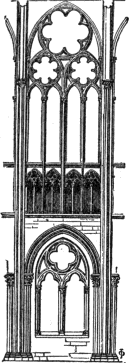
FIG. 120.—ONE BAY, ABBEY OF ST. DENIS.
INTERIOR DESIGN. The progressive change outlined in the last
chapter, by which the wall was practically suppressed, the windows
correspondingly enlarged, and every part of the structure made loftier
and more slender, resulted in the evolution of a system of interior
design well represented by the nave of Amiens. The second story or
gallery over the side aisle disappeared, but the aisle itself was very
high. The triforium was no longer a gallery, but a richly arcaded
passage in the thickness of the wall, corresponding to the roofing-space
over the aisle, and generally treated like a lower stage of the
clearstory. Nearly the whole space above it was occupied in each bay by
the vast clearstory window filled with simple but effective geometric
tracery over slender mullions. The side aisles were lighted by windows
which, like those in the clearstory, occupied nearly the whole available
wall-space under the vaulting. The piers and shafts were all clustered
and remarkably slender. The whole construction of this vast edifice,
which covers nearly eighty thousand square feet, is a marvel of
203
lightness, of scientific combinations, and of fine execution. Its great
vault rises to a height of one hundred and forty feet. The nave of St.
Denis, though less lofty, resembles it closely in style (Fig. 120).
Earlier cathedrals show less of the harmony of proportion, the perfect
working out of the relation of all parts of the composition of each bay,
so conspicuous in the Amiens type, which was followed in most of the
later churches.
WINDOWS: TRACERY. The clearstory windows of Noyon, Soissons,
Sens, and the choir of Vézelay (1200) were simple arched openings
arranged singly, in pairs, or in threes. In the cathedral of Chartres
(1194–1220) they consist of two arched windows with a circle above
them, forming a sort of plate tracery under a single arch. In the chapel
windows of the choir at Reims (1215) the tracery of mullions and circles
was moulded inside and out, and the intermediate triangular spaces all
pierced and glazed. Rose windows were early used in front and transept
façades. During the thirteenth and fourteenth centuries they were made
of vast size and great lightness of tracery, as in the transepts of
Notre Dame (1257) and the west front of Amiens (1288). From the design
of these windows is derived the name Rayonnant, often applied to
the French Gothic style of the period 1275–1375.

FIG. 121.—THE STE. CHAPELLE, PARIS.
THE SAINTE CHAPELLE. In this beautiful royal chapel at Paris,
built 1242–47, Gothic design was admirably exemplified in the
noble windows 15 by 50 feet in size, which perhaps furnished the models
for those of Amiens and St.
204
Denis. Each was divided by slender mullions into four lancet-like lights
gathered under the rich tracery of the window-head. They were filled
with stained glass of the most brilliant but harmonious hues. They
occupy the whole available wall-space, so that the ribbed vault
internally seems almost to rest on walls of glass, so slender are the
visible supports and so effaced by the glow of color in the windows.
Certainly lightness of construction and the suppression of the
wall-masonry could hardly be carried further than here (Fig. 121). Among
other chapels of the same type are those in the palace of St.
Germain-en-Laye (1240), and a later example in the château of Vincennes,
begun by Charles VI., but not finished till 1525.
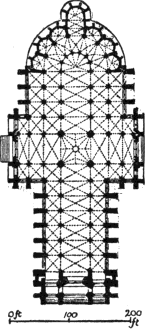
FIG. 122.—PLAN OF AMIENS CATHEDRAL.
PLANS. The most radical change from the primitive basilican
type was, as already explained in the last chapter, the continuation of
the side aisles around the apse to form a chevet; and later, the
addition of chapels between the external buttresses. Radiating chapels,
usually semi-octagons or semi-decagons in plan, early appeared as
additions to the chevet (Fig. 122). These may have originated in
the apsidal chapels of Romanesque churches in Auvergne and the South, as
at Issoire, Clermont-Ferrand, Le Puy, and Toulouse.
205
They generally superseded the transept-chapels of earlier churches, and
added greatly to the beauty of the interior perspective, especially when
the encircling aisles of the chevet were doubled. Notre Dame, as at
first erected, had a double ambulatory, but no chapels. Bourges has only
five very small semicircular chapels. Chartres (choir 1220) and Le Mans,
as reconstructed about the same date, have double ambulatories and
radial chapels. After 1220 the second ambulatory no longer appears.
Noyon, Soissons, Reims, Amiens, Troyes, and Beauvais, Tours, Bayeux, and
Coutances, Clermont, Limoges, and Narbonne all have the single
ambulatory and radiating chevet-chapels. The Lady-chapel in the axis of
the church was often made longer and more important than the other
chapels, as at Amiens, Le Mans, Rouen, Bayeux, and Coutances. Chapels
also flanked the choir in most of the cathedrals named above, and Notre
Dame and Tours also have side chapels to the nave. The only cathedrals
with complete double side aisles alike to nave, choir, and chevet, were
Notre Dame and Bourges. It is somewhat singular that the German
cathedral of Cologne is the only one in which all these various
characteristic French features were united in one design (see Fig. 140).

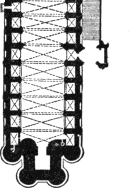
FIG. 123.—PLAN OF
CATHEDRAL OF ALBY.
Local considerations had full sway in France, in spite of the
tendency toward unity of type. Thus Dol, Laon, and Poitiers have square
eastward terminations; Châlons has no ambulatory; Bourges no transept.
In Notre Dame the transept was almost suppressed. At Soissons one
transept, at Noyon both, had semicircular ends. Alby, a late
cathedral of brick,
206
founded in 1280, but mostly built during the fourteenth century, has
neither side aisles nor transepts, its wide nave being flanked by
chapels separated by internal buttresses (Fig. 123).
SCALE. The French cathedrals were nearly all of imposing
dimensions. Noyon, one of the smallest, is 333 feet long; Sens measures
354. Laon, Bourges, Troyes, Notre Dame, Le Mans, Rouen, and Chartres
vary from 396 to 437 feet in extreme length; Reims measures 483, and
Amiens, the longest of all, 521 feet. Notre Dame is 124 feet wide across
the five aisles of the nave; Bourges, somewhat wider. The central aisles
of these two cathedrals, and of Laon, Amiens, and Beauvais, have a span
of not far from 40 feet from centre to centre of the piers; while the
ridge of the vaulting, which in Notre Dame is 108 feet above the
pavement, and in Bourges 125, reaches in Amiens a height of 140 feet,
and of nearly 160 in Beauvais. This emphasis of the height, from 3 to 3½
times the clear width of the nave or choir, is one of the most striking
features of the French cathedrals. It produces an impressive effect, but
tends to dwarf the great width of the central aisle.

FIG. 124.—WEST FRONT OF NOTRE DAME,
PARIS.
EXTERIOR DESIGN. Here, as in the interior, every feature had
its constructive raison d’être, and the total effect was
determined by the fundamental structural scheme. This was especially
true of the lateral elevations, in which the pinnacled buttresses, the
flying arches, and the traceried windows of the side aisle and
clearstory, repeated uniformly at each bay, were the principal elements
of the design.
207
The transept façades and main front allowed greater scope for invention
and fancy, but even here the interior membering gave the key to the
composition. Strong buttresses marked the division of the aisles and
resisted the thrust of the terminal pier arches, and rose windows filled
the greater part of the wall space under the end of the lofty vaulting.
The whole structure was crowned by a steep-pitched roof of wood, covered
with lead, copper, or tiles, to protect the vault from damage by snow
and moisture. This roof occasioned the steep gables which crowned the
transept and main façades. The main front was frequently adorned, above
the triple portal, with a gallery of niches or tabernacles filled with
statues of kings. Different types of composition are represented by
Chartres, Notre Dame, Amiens, Reims, and Rouen, of which Notre Dame
(Fig. 124) and Reims are perhaps the finest. Notre Dame is especially
remarkable for its stately simplicity and the even balancing of
horizontal and vertical elements.
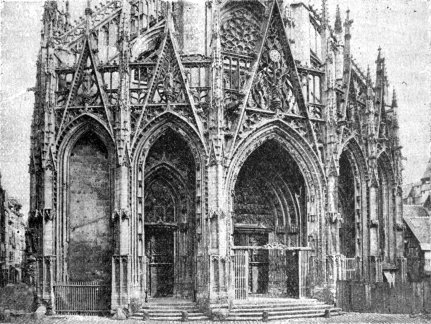
FIG. 125.—WEST FRONT OF ST. MACLOU, ROUEN.
PORCHES. In most French church façades the porches were the
most striking features, with their deep shadows and sculptured
arches. The Romanesque porches were
208
usually limited in depth to the thickness of the front wall. The Gothic
builders secured increased depth by projecting the portals out beyond
the wall, and crowned them with elaborate gables. The vast central door
was divided in two by a pier adorned with a niche and statue. Over this
the tympanum of the arch was carved with scriptural reliefs; the jambs
and arches were profusely adorned with figures of saints, apostles,
martyrs, and angels, under elaborate canopies. The porches of Laon,
Bourges, Amiens, and Reims are especially deep and majestic in effect,
the last-named (built 1380) being the richest of all. Some of the
transept façades also had imposing portals. Those of Chartres
(1210–1245) rank among the finest works of Gothic decorative
architecture, the south porch in some respects surpassing that of the
north transept. The portals
209
of the fifteenth and early sixteenth centuries were remarkable for the
extraordinary richness and minuteness of their tracery and sculpture, as
at Abbeville, Alençon, the cathedral and St. Maclou at Rouen (Fig. 125),
Tours, Troyes, Vendôme, etc.
TOWERS AND SPIRES. The emphasizing of vertical elements
reached its fullest expression in the towers and spires of the churches.
What had been at first merely a lofty belfry roof was rapidly developed
into the spire, rising three hundred feet or more into the air. This
development had already made progress in the Romanesque period, and the
south spire of Chartres is a notable example of late twelfth-century
steeple design. The transition from the square tower to the slender
octagonal pyramid was skilfully effected by means of corner pinnacles
and dormers. During and after the thirteenth century the development was
almost wholly in the direction of richness and complexity of detail, not
of radical constructive modification. The northern spire of Chartres
(1515) and the spires of Bordeaux, Coutances, Senlis, and the Flamboyant
church of St. Maclou at Rouen, illustrate this development. In Normandy
central spires were common, rising over the crossing of nave and
transepts. In some cases the designers of cathedrals contemplated a
group of towers; this is evident at Chartres, Coutances, and Reims. This
intention was, however, never realized; it demanded resources beyond
even the enthusiasm of the thirteenth century. Only in rare instances
were the spires of any of the towers completed, and the majority of the
French towers have square terminations, with low-pitched wooden roofs,
generally invisible from below. In general, French towers are marked by
their strong buttresses, solid lower stories, twin windows in each side
of the belfry proper—these windows being usually of great
size—and a skilful management of the transition to an octagonal
plan for the belfry or the spire.
210
CARVING AND SCULPTURE. The general superiority of French
Gothic work was fully maintained in its decorative details. Especially
fine is the figure sculpture, which in the thirteenth and fourteenth
centuries attained true nobility of expression, combined with great
truthfulness and delicacy of execution. Some of its finest productions
are found in the great doorway jambs of the west portals of the
cathedrals, and in the ranks of throned and adoring angels which adorned
their deep arches. These reach their highest beauty in the portals of
Reims (1380). The tabernacles or carved niches in which such
statues were set were important elements in the decoration of the
exteriors of churches.
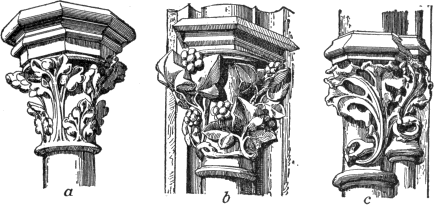
FIG. 126.—FRENCH GOTHIC CAPITALS.
a, From Sainte Chapelle, Paris, 13th century. b,
14th-century capital from transept of Notre Dame, Paris. c,
15th-century capital from north spire of Chartres.
Foliage forms were used for nearly all the minor carved ornaments,
though grotesque and human figures sometimes took their place. The
gargoyles through which the roof-water was discharged clear of the
building, were almost always composed in the form of hideous monsters;
and symbolic beasts, like the oxen in the towers of Laon, or monsters
like those which peer from the tower balustrades
211
of Notre Dame, were employed with some mystical significance in various
parts of the building. But the capitals corbels, crockets, and finials
were mostly composed of floral or foliage forms. Those of the twelfth
and thirteenth centuries were for the most part simple in mass, and
crisp and vigorous in design, imitating the strong shoots of early
spring. The capitals were tall and slender, concave in profile,
with heavy square or octagonal abaci. With the close of the thirteenth
century this simple and forcible style of detail disappeared. The
carving became more realistic; the leaves, larger and more mature, were
treated as if applied to the capital or moulding, not as if they grew
out of it. The execution and detail were finer and more delicate, in
harmony with the increasing slenderness and lightness of the
architecture (Fig. 126 a, b). Tracery forms
now began to be profusely applied to all manner of surfaces, and
open-work gables, wholly unnecessary from the structural point of view,
but highly effective as decorations, adorned the portals and crowned the
windows.
LATE GOTHIC MONUMENTS. So far our attention has been mainly
occupied with the masterpieces erected previous to 1250. Among the
cathedrals, relatively few in number, whose construction is referable to
the second half of the century, that of Beauvais stands first in
importance. Designed on a colossal scale, its foundations were laid in
1225, but it was never completed, and the portion built—the choir
and chapels—belonged really to the second half of the century,
having been completed in 1270. But the collapse in 1284 of the central
tower and vaulting of this incomplete cathedral, owing to the excessive
loftiness and slenderness of its supports, compelled its entire
reconstruction, the number of the piers being doubled and the span of
the pier arches correspondingly reduced. As thus rebuilt, the cathedral
aisle was 47 feet wide from centre to centre of opposite piers, and 163
feet high to the top of the vault.
212
Transepts were added after 1500. Limoges and Narbonne,
begun in 1272 on a large scale (though not equal in size to Beauvais),
were likewise never completed. Both had choirs of admirable plan, with
well-designed chevet-chapels. Many other cathedrals begun during this
period were completed only after long delays, as, for instance, Meaux,
Rodez (1277), Toulouse (1272), and Alby (1282), finished in the
sixteenth century, and Clermont (1248), completed under Napoleon III.
But between 1260 or 1275 and 1350, work was actively prosecuted on many
still incomplete cathedrals. The choirs of Beauvais (rebuilding),
Limoges, and Narbonne were finished after 1330; and towers,
transept-façades, portals, and chapels added to many others of earlier
date.
The style of this period is sometimes designated as Rayonnant,
from the characteristic wheel tracery of the rose-windows, and the
prevalence of circular forms in the lateral arched windows, of the late
thirteenth and early fourteenth centuries. The great rose windows in the
transepts of Notre Dame, dating from 1257, are typical examples of the
style. Those of Rouen cathedral belong to the same category, though of
later date. The façade of Amiens, completed by 1288, is one of the
finest works of this style, of which an early example is the elaborate
parish church of St. Urbain at Troyes.
THE FLAMBOYANT STYLE. The geometric treatment of the tracery
and the minute and profuse decoration of this period gradually merged
into the fantastic and unrestrained extravagances of the
Flamboyant style, which prevailed until the advent of the
Renaissance—say 1525. The continuous logical development of forms
ceased, and in its place caprice and display controlled the arts of
design. The finest monument of this long period is the fifteenth-century
nave and central tower of the church of St. Ouen at Rouen,
a parish church of the first rank, begun in 1318, but not finished
213
until 1515. The tracery of the lateral windows is still chiefly
geometric, but the western rose window (Fig. 112) and the magnificent central tower or
lantern, exhibit in their tracery the florid decoration and wavy,
flame-like lines of this style. Slenderness of supports and the
suppression of horizontal lines are here carried to an extreme; and the
church, in spite of its great elegance of detail, lacks the vital
interest and charm of the earlier Gothic churches. The cathedral of
Alençon and the church of St. Maclou at Rouen, have portals with
unusually elaborate detail of tracery and carving; while the façade of
Rouen cathedral (1509) surpasses all other examples in the lace-like
minuteness of its open-work and its profusion of ornament. The churches
of St. Jacques at Dieppe, and of St. Wulfrand at
Abbeville, the façades of Tours and Troyes, are among the masterpieces
of the style. The upper part of the façade of Reims (1380–1428)
belongs to the transition from the Rayonnant to the Flamboyant. While
some works of this period are conspicuous for the richness of their
ornamentation, others are noticeably bare and poor in design, like St.
Merri and St. Séverin in Paris.
SECULAR AND MONASTIC ARCHITECTURE. The building of cathedrals
did not absorb all the architectural activity of the French during the
Gothic period, nor did it by any means put an end to monastic building.
While there are few Gothic cloisters to equal the Romanesque cloisters
of Puy-en-Vélay, Montmajour, Elne, and Moissac, many of the abbeys
either rebuilt their churches in the Gothic style after 1150, or
extended and remodelled their conventual buildings. The cloisters of
Fontfroide, Chaise-Dieu, and the Mont St. Michel rival those of
Romanesque times, while many new refectories and chapels were built in
the same style with the cathedrals. The most complete of these Gothic
monastic establishments, that of the Mont St. Michel in Normandy,
presented a remarkable aggregation
214
of buildings clustering around the steep isolated rock on which stands
the abbey church. This was built in the eleventh century, and the choir
and chapels remodelled in the sixteenth. The great refectory and
dormitory, the cloisters, lodgings, and chapels, built in several
vaulted stories against the cliffs, are admirable examples of the
vigorous pointed-arch design of the early thirteenth century.
Hospitals like that of St. Jean at Angers (late twelfth
century), or those of Chartres, Ourscamps, Tonnerre, and Beaune,
illustrate how skilfully the French could modify and adapt the details
of their architecture to the special requirements of civil architecture.
Great numbers of charitable institutions were built in the middle
ages—asylums, hospitals, refuges, and the like—but very few
of those in France are now extant. Town halls were built in the
fifteenth century in some places where a certain amount of popular
independence had been secured. The florid fifteenth-century Palais de
Justice at Rouen (1499–1508) is an example of another
branch of secular Gothic architecture. In all these monuments the
adaptation of means to ends is admirable. Wooden ceilings and roofs
replaced stone, wherever required by great width of span or economy of
construction. There was little sculpture; the wall-spaces were not
suppressed in favor of stained glass and tracery; while the roofs were
usually emphasized and adorned with elaborate crestings and finials in
lead or terra-cotta.
DOMESTIC ARCHITECTURE. These same principles controlled the
designing of houses, farm buildings, barns, granaries, and the like. The
common closely-built French city house of the twelfth and thirteenth
century is illustrated by many extant examples at Cluny, Provins, and
other towns. A shop opening on the street by a large arch,
a narrow stairway, and two or three stories of rooms lighted by
clustered, pointed-arched windows, constituted the common
215
type. The street front was usually gabled and the roof steep. In the
fourteenth or fifteenth century half-timbered construction began to
supersede stone for town houses, as it permitted of encroaching upon the
street by projecting the upper stories. Many of the half-timbered houses
of the fifteenth century were of elaborate design. The heavy oaken
uprights were carved with slender colonnettes; the horizontal sills,
bracketed out over the street, were richly moulded; picturesque dormers
broke the sky-line, and the masonry filling between the beams was
frequently faced with enamelled tiles.
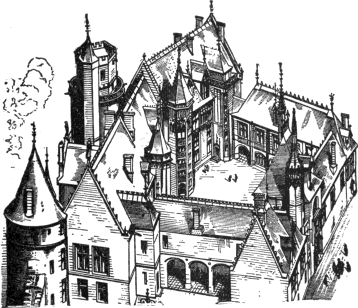
FIG. 127.—HOUSE OF JACQUES CŒUR, BOURGES.
(After Viollet-le-Duc.)
The more considerable houses or palaces of royalty, nobles, and
wealthy citizens rivalled, and in time surpassed, the monastic buildings
in richness and splendor. The earlier examples retain the military
aspect, with moat and donjon, as in the Louvre of Charles V.,
demolished in
216
the sixteenth century. The finest palaces are of late date, and the type
is well represented by the Ducal Palace at Nancy (1476), the Hotel de
Cluny (1485) at Paris, the Hotel Jacques Cœur at Bourges
(Fig. 127), and the east wing of Blois (1498–1515). These palaces
are not only excellently and liberally planned, with large halls, many
staircases, and handsome courts; they are also extremely picturesque
with their square and circular towers, slender turrets, elaborate
dormers, and rich carved detail.
MONUMENTS: (C. = cathedral; A. = abbey; trans. = transept; each
edifice is given under the date of its commencement; subsequent
alterations in parentheses.) Between 1130 and 1200: Vézelay A.,
ante-chapel, 1130; St. Germer-de-Fly C., 1130–1150 (chapel
later); St. Denis A., choir, 1140 (choir rebuilt, nave and trans.,
1240); Sens C., 1140–68 (W. front, 13th century;
chapels, spire, 14th); Senlis C., 1145–83 (trans., spire,
13th century); Noyon C., 1149–1200 (W. front, vaults,
13th century); St. Germain-des-Prés A., Paris, choir, 1150
(Romanesque nave); Angers C., 1150 (choir, trans., 1274); Langres,
1150–1200; Laon C., 1150–1200; Le Mans C., nave,
1150–58 (choir, 1217–54); Soissons C., 1160–70
(choir, 1212; nave chapels, 14th century); Poitiers C.,
1162–1204; Notre Dame, Paris, choir, 1163–96 (nave,
W. front finished, 1235; trans. fronts, and chapels,
1257–75); Chartres C., W. end, 1170; rest, mainly
1194–98 (trans. porches, W. rose, 1210–1260;
N. spire, 1506); Tours C., 1170 (rebuilt, 1267; trans.,
portals, 1375; W. portals, chapels, 15th century; towers finished,
1507–47); Laval C., 1180–85 (choir, 16th century);
Mantes, church Notre Dame, 1180–1200; Bourges C.,
1190–95 (E. end, 1210; W. end, 1275); St. Nicholas at
Caen, 1190 (vaults, 15th century); Reims, church St. Rémy, choir, end of
12th century (Romanesque nave); church St. Leu d’Esserent, choir late
12th century (nave, 13th century); Lyons C., choir, end of 12th
century (nave, 13th and 14th centuries); Etampes, church Notre Dame,
12th and 13th centuries.—13th century: Evreux C.,
1202–75 (trans., central tower, 1417; W. front rebuilt, 16th
century); Rouen C., 1202–20 (trans. portals, 1280;
W. front, 1507); Nevers, 1211, N. portal, 1280 (chapels,
S. portal, 15th century); Reims C., 1212–42
(W. front, 1380; W. towers, 1420); Bayonne C., 1213
(nave, vaults, W. portal, 14th century); Troyes C., choir,
1214 (central tower, nave, W. portal, and towers, 15th century);
Auxerre C., 1215–34 (nave, W. end, trans., 14th
century); Amiens C., 1220–88; St. Etienne at
Chalons-sur-Marne, 1230 (spire, 1520); Séez C.,
217
1230, rebuilt 1260 (remodelled 14th century); Notre Dame de Dijon, 1230;
Reims, Lady chapel of Archbishop’s palace, 1230; Chapel Royal at St.
Germain-en-Laye, 1240; Ste. Chapelle at Paris, 1242–47
(W. rose, 15th century); Coutances C., 1254–74;
Beauvais C., 1247–72 (rebuilt 1337–47; trans. portals,
1500–48); Notre Dame de Grace at Clermont, 1248 (finished 1350);
Dôl C., 13th century; St. Martin-des-Champs at Paris, nave 13th
century (choir Romanesque); Bordeaux C., 1260; Narbonne C.,
1272–1320; Limoges, 1273 (finished 16th century); St. Urbain,
Troyes, 1264; Rodez C., 1277–1385 (altered, completed 16th
century); church St. Quentin, 1280–1300; St. Benigne at Dijon,
1280–91; Alby C., 1282 (nave, 14th; choir, 15th century;
S. portal, 1473–1500); Meaux C., mainly rebuilt 1284
(W. end much altered 15th, finished 16th century); Cahors C.,
rebuilt 1285–93 (W. front, 15th century); Orléans,
1287–1328 (burned, rebuilt 1601–1829).—14th century:
St. Bertrand de Comminges, 1304–50; St. Nazaire at Carcassonne,
choir and trans. on Romanesque nave; Montpellier C., 1364; St. Ouen
at Rouen, choir, 1318–39 (trans., 1400–39; nave,
1464–91; W. front, 1515); Royal Chapel at Vincennes, 1385
(?)-1525.—15th and 16th century: St. Nizier at Lyons rebuilt; St.
Séverin, St. Merri, St. Germain l’Auxerrois, all at Paris; Notre Dame de
l’Epine at Chalons-sur-Marne; choir of St. Etienne at Beauvais;
Saintes C., rebuilt, 1450; St. Maclou at Rouen (finished 16th
century); church at Brou; St. Wulfrand at Abbeville; abbey of St.
Riquier—these three all early 16th century.—Houses, Castles, and Palaces: Bishop’s palace at
Paris, 1160 (demolished); castle of Coucy, 1220–30; Louvre at
Paris (the original château), 1225–1350; Palais de Justice at
Paris, originally the royal residence, 1225–1400; Bishop’s palace
at Laon, 1245 (addition to Romanesque hall); castle Montargis, 13th
century; castle Pierrefonds, Bishop’s palace at Narbonnne, palace of
Popes at Avignon—all 14th century; donjon of palace at Poitiers,
1395; Hôtel des Ambassadeurs at Dijon, 1420; house of Jacques Cœur at
Bourges, 1443; Palace, Dijon, 1467; Ducal palace at Nancy, 1476; Hôtel
Cluny at Paris, 1490; castle of Creil, late 15th century, finished in
16th; E. wing palace of Blois, 1498–1515, for Louis XII.;
Palace de Justice at Rouen, 1499–1508.
218
GOTHIC ARCHITECTURE IN GREAT BRITAIN.
Books Recommended: As before, Corroyer,
Parker, Reber. Also, Bell’s Series of Handbooks of English
Cathedrals. Billings, The Baronial and Ecclesiastical Antiquities
of Scotland. Bond, Gothic Architecture in England. Brandon,
Analysis of Gothic Architecture. Britton, Cathedral
Antiquities of Great Britain. Ditchfield, The Cathedrals of
England. Murray, Handbooks of the English Cathedrals. Parker,
Introduction to Gothic Architecture; Glossary of Architectural
Terms; Companion to Glossary, etc. Rickman, An Attempt to
Discriminate the Styles of English Architecture. Sharpe,
Architectural Parallels; The Seven Periods of English
Architecture. Van Rensselaer, English Cathedrals. Winkles and
Moule, Cathedral Churches of England and Wales. Willis,
Architectural History of Canterbury Cathedral; ditto of
Winchester Cathedral; Treatise on Vaults.
GENERAL CHARACTER. Gothic architecture was developed in
England under a strongly established royal power, with an episcopate in
no sense hostile to the abbots or in arms against the barons. Many of
the cathedrals had monastic chapters, and not infrequently abbots were
invested with the episcopal rank.
English Gothic architecture was thus by no means predominantly an
architecture of cathedrals. If architectural activity in England was on
this account less intense and widespread in the twelfth and thirteenth
centuries than in France, it was not, on the other hand, so soon
exhausted. Fewer new cathedrals were built, but the progressive
rebuilding of those already existing seems not to have ceased until the
middle or end of the fifteenth century. Architecture
219
in England developed more slowly, but more uniformly than in France. It
contented itself with simpler problems; and if it failed to rival Amiens
in boldness of construction and in lofty majesty, it at least never
perpetrated a folly like Beauvais. In richness of internal decoration,
especially in the mouldings and ribbed vaulting, and in the picturesque
grouping of simple masses externally, the British builders went far
toward atoning for their structural timidity.
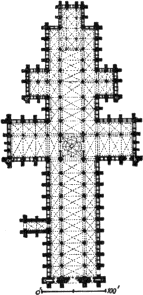
FIG. 128.—PLAN OF SALISBURY CATHEDRAL.
EARLY GOTHIC BUILDINGS. The pointed arch and ribbed vault were
importations from France. Early examples appear in the Cistercian abbeys
of Furness and Kirkstall, and in the Temple Church at London (1185). But
it was in the Choir of Canterbury, as rebuilt by William of Sens,
after the destruction by fire in 1170 of Anselm’s Norman choir, that
these French Gothic features were first applied in a thoroughgoing
manner. In plan this choir resembled that of the cathedral of Sens; and
its coupled round piers, with capitals carved with foliage, its pointed
arches, its six-part vaulting, and its chevet, were distinctly
French. The Gothic details thus introduced slowly supplanted the round
arch and other Norman features. For fifty years the styles were more or
less mingled in many buildings, though Lincoln Cathedral, as
rebuilt in 1185–1200, retained nothing of the earlier round-arched
style. But the first church to be designed and built from the
foundations in the new style was the cathedral of Salisbury
(1220–1258; Fig. 128). Contemporary with Amiens, it is a
homogeneous and typical example of the
220
Early English style. The predilection for great length observable in the
Anglo-Norman churches (as at Norwich and Durham) still prevailed, as it
continued to do throughout the Gothic period; Salisbury is 480 feet
long. The double transepts, the long choir, the square east end, the
relatively low vault (84 feet to the ridge), the narrow grouped windows,
all are thoroughly English. Only the simple four-part vaulting recalls
French models. Westminster Abbey (1245–1269), on the other
hand, betrays in a marked manner the French influence in its internal
loftiness (100 feet), its polygonal chevet and chapels, and its
strongly accented exterior flying-buttresses (Fig. 137).
MIXTURE OF STYLES. Very few English cathedrals are as
homogeneous as the two just mentioned, nearly all having undergone
repeated remodellings in successive periods. Durham, Norwich, and Oxford
are wholly Norman but for their Gothic vaults. Ely, Rochester,
Gloucester, and Hereford have Norman naves and Gothic choirs.
Peterborough has an early Gothic façade and late Gothic retro-choir
added to an otherwise completely Norman structure. Winchester is a
Norman church remodelled with early Perpendicular details. The purely
Gothic churches and cathedrals, except parish churches—in which
England is very rich—are not nearly as numerous in England as in
France.
PERIODS. The development of English Gothic architecture
followed the same general sequence as the French, and like it the
successive stages were most conspicuously characterized by the forms of
the tracery.
The Early English or Lancet period extended roundly from 1175 or 1180 to
1280, and was marked by simplicity, dignity, and purity of design.
The Decorated or Geometric period covered another century, 1280 to
1380, and was characterized by its decorative richness and greater
lightness of construction.
The Perpendicular period extended
from 1380, or
221
thereabout, well into the sixteenth century. Its salient features were
the use of fan-vaulting, four-centred arches, and tracery of
predominantly vertical and horizontal lines. The tardy introduction of
Renaissance forms finally put an end to the Gothic style in England,
after a long period of mixed and transitional architecture.
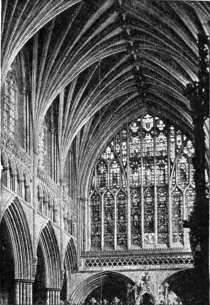
FIG. 129.—RIBBED VAULTING, CHOIR OF EXETER CATHEDRAL.
VAULTING. The richness and variety of English vaulting
contrast strikingly with the persistent uniformity of the French.
A few of the early Gothic vaults, as in the aisles of Peterborough,
and later the naves of Durham, Salisbury, and Gloucester, were simple
four-part, ribbed vaults substantially like the French. But the English
disliked and avoided the twisted and dome-like surfaces of the French
vaults, preferring horizontal ridges, and, in the filling-masonry,
straight courses meeting at the ridge in zigzag lines, as in southwest
France (see p. 200). This may be seen in
Westminster Abbey. The idea of ribbed construction was then seized upon
and given a new application. By springing a large number of ribs from
each point of support, the vaulting-surfaces were divided into long,
narrow, triangles, the filling of which was comparatively easy (Fig.
129). The ridge was itself furnished with a straight rib, decorated with
carved rosettes or bosses at each intersection with a
vaulting-rib. The naves and choirs of Lincoln, Lichfield, Exeter, and
the nave of Westminster
222
illustrate this method. The logical corollary of this practice was the
introduction of minor ribs called liernes, connecting the main
ribs and forming complex reticulated and star-shaped patterns. Vaults of
this description are among the most beautiful in England. One of the
richest is in the choir of Gloucester (1337–1377). Less correct
constructively is that over the choir of Wells, while the choir of Ely,
the nave of Tewkesbury Abbey (Fig. 130), and all the vaulting of
Winchester as rebuilt by William of Wykeham (1390), illustrate the same
system. Such vaults are called lierne or star vaults.
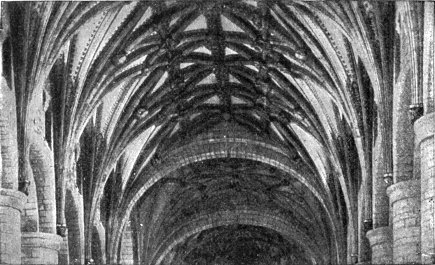
FIG. 130.—NET OR LIERNE VAULTING, TEWKESBURY ABBEY.
FAN-VAULTING. The next step in the process may be observed in
the vaults of the choir of Oxford Cathedral (Christ Church), of the
retro-choir of Peterborough, of the cloisters of Gloucester, and many
other examples. The diverging ribs being made of uniform curvature, the
severeys (the inverted pyramidal vaulting-masses springing from
each support) became a species of concave conoids, meeting at the
223
ridge in such a way as to leave a series of flat lozenge-shaped spaces
at the summit of the vault (Fig. 136). The
ribs were multiplied indefinitely, and losing thus in individual and
structural importance became a mere decorative pattern of tracery on the
severeys. To conceal the awkward flat lozenges at the ridge, elaborate
panelling was resorted to; or, in some cases, long stone pendents were
inserted at those points—a device highly decorative but
wholly unconstructive. At Cambridge, in King’s College Chapel, at
Windsor, in St. George’s Chapel, and in the Chapel of Henry
VII. at Westminster, this sort of vaulting received its most
elaborate development. The fan-vault, as it is called,
illustrates the logical evolution of a decorative element from a
structural starting—point, leading to results far removed from the
original conception. Rich and sumptuous as are these ceilings, they are
with all their ornament less satisfactory than the ribbed vaults of the
preceding period.
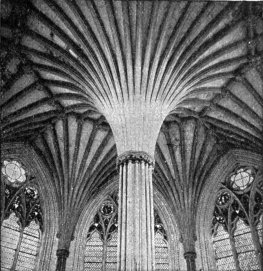
FIG. 131.—VAULT OF CHAPTER-HOUSE, WELLS.
CHAPTER-HOUSES. One of the most beautiful forms of ribbed
vaulting was developed in the polygonal halls erected for the
deliberations of the cathedral chapters of Lincoln (1225), Westminster
(1250), Salisbury (1250), and Wells (1292), in which the vault-ribs
radiated from a central column to the sides and angles of the polygon
(Fig. 131). If
224
these vaults were less majestic than domes of the same diameter, they
were far more decorative and picturesque, while the chapter-houses
themselves were the most original and striking products of English
Gothic art. Every feature was designed with strict regard for the
structural system determined by the admirable vaulting, and the Sainte
Chapelle was not more logical in its exemplification of Gothic
principles. To the four above-mentioned examples should be added that of
York (1280–1330), which differs from them in having no central
column: by some critics it is esteemed the finest of them all. Its
ceiling is a Gothic dome, 57 feet in diameter, but unfortunately
executed in wood. Its geometrical window-tracery and richly canopied
stalls are admirable.
OCTAGON AT ELY. The magnificent Octagon of Ely
Cathedral, at the intersection of the nave and transepts, belongs in the
same category with these polygonal chapter-house vaults. It was built by
Alan of Walsingham in 1337, after the fall of the central tower and the
destruction of the adjacent bays of the choir. It occupies the full
width of the three aisles, and covers the ample space thus enclosed with
a simple but beautiful groined and ribbed vault of wood reaching to a
central octagonal lantern, which rises much higher and shows externally
as well as internally. Unfortunately, this vault is of wood, and would
require important modifications of detail if carried out in stone. But
it is so noble in general design and total effect, that one wonders the
type was not universally adopted for the crossing in all cathedrals,
until one observes that no cathedral of importance was built after
Walsingham’s time, nor did any other central towers opportunely fall to
the ground.
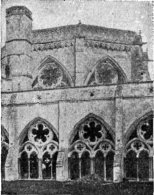
FIG. 132.—CLOISTERS, SALISBURY CATHEDRAL (SHOWING UPPER PART OF
CHAPTER-HOUSE).
WINDOWS AND TRACERY. In the Early English Period
(1200–1280 or 1300) the windows were tall and narrow
(lancet windows), and generally grouped by twos and threes,
though sometimes four and even five are seen together (as
225
the “Five Sisters” in the N. transept of York). In the nave of
Salisbury and the retro-choir of Ely the side aisles are lighted by
coupled windows and the clearstory by triple windows, the central one
higher than the others—a surviving Norman practice.
Plate-tracery was, as in France, an intermediate step leading to the
development of bar-tracery (see Fig. 110).
The English followed here the same reasoning as the French. At first the
openings constituted the design, the intervening stonework being of
secondary importance. Later the forms of the openings were subordinated
to the pattern of the stone framework of bars, arches, circles, and
cusps. Bar-tracery of this description prevailed in England through the
greater part of the Decorated Period (1280–1380), and somewhat
resembled the contemporary French geometric tracery, though more varied
and less rigidly constructive in design. An early example of this
tracery occurs in the cloisters of Salisbury (Fig. 132); others in the
clearstories of the choirs of Lichfield, Lincoln, and Ely, the nave of
York, and the chapter-houses mentioned above, where, indeed, it seems to
have received its earliest development. After the middle of the
fourteenth century lines of double curvature were introduced, producing
what is called flowing tracery, somewhat resembling the French
flamboyant, though earlier in date (Fig. 111). Examples of this style are found in Wells,
in the side aisles and triforium of the choir of Ely, and in the
S. transept rose-window of Lincoln.

FIG. 133.—PERPENDICULAR TRACERY, WEST WINDOW OF ST. GEORGE’S,
WINDSOR.
THE PERPENDICULAR STYLE. Flowing tracery was, however,
a transitional phase of design, and was soon superseded by
Perpendicular tracery, in which the mullions were
226
carried through to the top of the arch and intersected by horizontal
transoms. This formed a very rigid and mechanically correct system of
stone framing, but lacked the grace and charm of the two preceding
periods. The earliest examples are seen in the work of Edington and of
Wykeham in the reconstructed cathedral of Winchester (1360–1394),
where the tracery was thus made to harmonize with the accentuated and
multiplied vertical lines of the interior design. It was at this late
date that the English seem first to have fully appropriated the Gothic
ideas of emphasized vertical elements and wall surfaces reduced to a
minimum. The development of fan-vaulting had led to the adoption of a
new form of arch, the four-centred or Tudor arch (Fig. 133), to
fit under the depressed apex of the vault. The whole design internally
and externally was thenceforward controlled by the form of the vaulting
and of the openings. The windows were made of enormous size, especially
at the east end of the choir, which was square in nearly all English
churches, and in the west windows over the entrance. These windows had
already reached, in the Decorated Period, an enormous size, as at York;
in the Perpendicular Period the two ends of the
227
church were as nearly as possible converted into walls of glass. The
East Window of Gloucester reaches the prodigious dimensions of 38 by 72
feet. The most complete examples of the Perpendicular tracery and of the
style in general are the three chapels already mentioned (p. 223); those, namely, of King’s College at
Cambridge, of St. George at Windsor, and of Henry VII. in
Westminster Abbey.
CONSTRUCTIVE DESIGN. The most striking peculiarity of English
Gothic design was its studious avoidance of temerity or venturesomeness
in construction. Both the height and width of the nave were kept within
very moderate bounds, and the supports were never reduced to extreme
slenderness. While much impressiveness of effect was undoubtedly lost
thereby, there was some gain in freedom of design, and there was less
obtrusion of constructive elements in the exterior composition. The
flying-buttress became a feature of minor importance where the
clearstory was kept low, as in most English churches. In many cases the
flying arches were hidden under the aisle roofs. The English cathedrals
and larger churches are long and low, depending for effect mainly upon
the projecting masses of their transepts, the imposing square central
towers which commonly crown the crossing, and the grouping of the main
structure with chapter-houses, cloisters, and Lady-chapels.
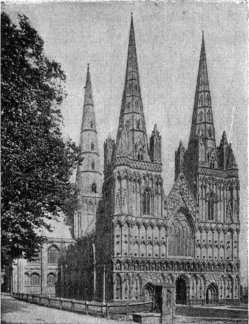
FIG. 134.—WEST FRONT, LICHFIELD CATHEDRAL.
FRONTS. The sides and east ends were, in most cases, more
successful than the west fronts. In these the English displayed a
singular indifference or lack of creative power. They produced nothing
to rival the majestic façades of Notre Dame, Amiens, or Reims, and their
portals are almost ridiculously small. The front of York
Cathedral is the most notable in the list for its size and elaborate
decoration. Those of Lincoln and Peterborough are,
however, more interesting in the picturesqueness and singularity of
their composition. The first-named forms a vast arcaded
228
screen, masking the bases of the two western towers, and pierced by
three huge Norman arches, retained from the original façade. The west
front of Peterborough is likewise a mask or screen, mainly composed of
three colossal recessed arches, whose vast scale completely dwarfs the
little porches which give admittance to the church. Salisbury has a
curiously illogical and ineffective façade. Those of Lichfield
and Wells are, on the other hand, imposing and beautiful designs,
the first with its twin spires and rich arcading (Fig. 134), the second
with its unusual wealth of figure-sculpture, and massive square
towers.
CENTRAL TOWERS. These are the most successful features of
English exterior design. Most of them form lanterns internally over the
crossing, giving to that point a considerable increase of dignity.
Externally they are usually massive and lofty square towers, and having
been for the most part completed during the fourteenth and fifteenth
centuries they are marked by great richness and elegance of detail.
Durham, York, Ely, Canterbury, Lincoln, and Gloucester maybe mentioned
as notable examples of such square towers; that of Canterbury is the
finest. Two or three have lofty spires over the lantern. Among these,
that of Salisbury is chief, rising 424 feet from the ground, admirably
designed in every
229
detail. It was not completed till the middle of the fourteenth century,
but most fortunately carries out with great felicity the spirit of the
earlier style in which it was begun. Lichfield and Chichester have
somewhat similar central spires, but less happy in proportion and detail
than the beautiful Salisbury example.
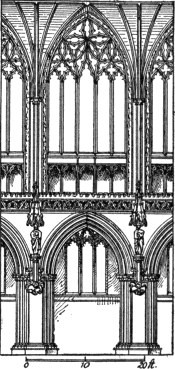
FIG. 135.—ONE BAY OF CHOIR, LICHFIELD CATHEDRAL.
INTERIOR DESIGN. In the Norman churches the pier-arches,
triforium, and clearstory were practically equal. In the Gothic churches
the pier-arches generally occupy the lower half of the height, the upper
half being divided nearly equally between the triforium and clearstory,
as in Lincoln, Lichfield (nave), Ely (choir). In some cases, however (as
at Salisbury, Westminster, Winchester, choir of Lichfield), the
clearstory is magnified at the expense of the triforium (Fig. 135).
Three peculiarities of design sharply distinguish the English treatment
of these features from the French. The first is the multiplicity of fine
mouldings in the pier-arches; the second is the decorative elaboration
of design in the triforium; the third, the variety in the treatment of
the clearstory. In general the English interiors are
much more ornate than the French. Black Purbeck marble is frequently
used for the shafts clustered around the central core of the pier,
giving a striking and somewhat singular effect of contrasted color. The
rich vaulting, the highly decorated triforium, the moulded pier-arches,
and at the
230
end of the vista the great east window, produce an impression very
different from the more simple and lofty stateliness of the French
cathedrals. The great length and lowness of the English interiors
combine with this decorative richness to give the impression of repose
and grace, rather than of majesty and power. This tendency reached its
highest expression in the Perpendicular churches and chapels, in which
every surface was covered with minute panelling.
CARVING. In the Early English Period the details were carved
with a combined delicacy and vigor deserving of the highest praise. In
the capitals and corbels, crockets and finials, the foliage was crisp
and fine, curling into convex masses and seeming to spring from the
surface which it decorated. Mouldings were frequently ornamented with
foliage of this character in the hollows, and another ornament, the
dog-tooth or pyramid, often served the same purpose,
introducing repeated points of light into the shadows of the mouldings.
These were fine and complex, deep hollows alternating with round
mouldings (bowtels) sometimes made pear-shaped in section by a
fillet on one side. Cusping—the decoration of an arch or
circle by triangular projections on its inner edge—was introduced
during this period, and became an important decorative resource,
especially in tracery design. In the Decorated Period the foliage was
less crisp; sea-weed and oak-leaves, closely and confusedly bunched,
were used in the capitals, while crockets were larger, double-curved,
with leaves swelling into convexities like oak-galls. Geometrical and
flowing tracery were developed, and the mouldings of the tracery-bars,
as of other features, lost somewhat in vigor and sharpness. The
ball-flower or button replaced the dog’s-tooth, and the hollows
were less frequently adorned with foliage.
In the Perpendicular Period nearly all flat surfaces were panelled in
designs resembling the tracery of the windows.
231
The capitals were less important than those of the preceding periods,
and the mouldings weaker and less effective. The Tudor rose appears as
an ornament in square panels and on flat surfaces; and moulded
battlements, which first appeared in Decorated work, now become a
frequent crowning motive in place of a cornice. There is less
originality and variety in the ornament, but a great increase in its
amount (Fig. 136).
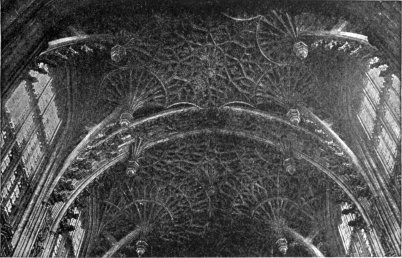
FIG. 136.—FAN-VAULTING, HENRY VII.’S CHAPEL, WESTMINSTER
ABBEY.
PLANS. English church plans underwent, during the Gothic
Period, but little change from the general types established previous to
the thirteenth century. The Gothic cathedrals and abbeys, like the
Norman, were very long and narrow, with choirs often nearly as long as
the nave, and almost invariably with square eastward terminations. There
is no example of double side aisles and side chapels, and apsidal
chapels are very rare. Canterbury and Westminster (Fig. 137) are the
chief exceptions to this, and both show clearly the French influence.
Another striking peculiarity of the English plans is the frequent
occurrence of secondary
232
transepts, adding greatly to the external picturesqueness. These occur
in rudimentary form in Canterbury, and at Durham the Chapel of the Nine
Altars, added 1242–1290 to the eastern end, forms in reality a
secondary transept. This feature is most perfectly developed in the
cathedral of Salisbury (Fig. 128), and
appears also at Lincoln, Worcester, Wells, and a few other examples. The
English cathedral plans are also distinguished by the retention or
incorporation of many conventual features, such as cloisters, libraries,
and halls, and by the grouping of chapter-houses and Lady-chapels with
the main edifice. Thus the English cathedral plans and those of the
great abbey churches present a marked contrast with those of France and
the Continent generally. While Amiens, the greatest of French
cathedrals, is 521 feet long, and internally 140 feet high, Ely measures
565 feet in length, and less than 75 feet in height. Notre Dame is 148
feet wide; the English naves are usually under 80 feet in total width of
the three aisles.
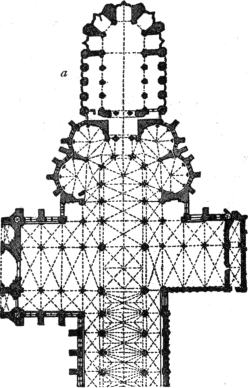
FIG. 137.—EASTERN HALF OF WESTMINSTER ABBEY. PLAN.
a, Henry VII.’s chapel.
PARISH CHURCHES. Many of these were of exceptional beauty of
composition and detail. They display the greatest variety of plan,
churches with two equal-gabled naves
233
side by side being not uncommon. A considerable proportion of them
date from the fourteenth and fifteenth centuries, and are chiefly
interesting for their square, single, west towers and their carved
wooden ceilings (see below). The tower was usually built over the
central western porch; broad and square, with corner buttresses
terminating in pinnacles, it was usually finished without spires.
Crenelated battlements crowned the upper story. When spires were added
the transition from the square tower to the octagonal spire was effected
by broaches or portions of a square pyramid intersecting the base
of the spire, or by corner pinnacles and flying-buttresses.
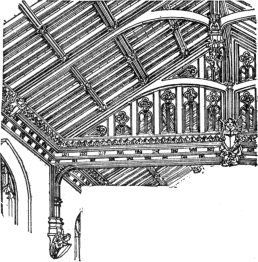
FIG. 138.—ROOF OF NAVE, ST. MARY’S, WESTONZOYLAND.
WOODEN CEILINGS. The English treated woodwork with consummate
skill. They invented and developed a variety of forms of roof-truss in
which the proper distribution of the strains was combined with a highly
decorative treatment of the several parts by carving, moulding, and
arcading. The ceiling surfaces between the trusses were handled
decoratively, and the oaken open-timber ceilings of many of the English
churches and civic or academic halls (Christ Church Hall, Oxford;
Westminster Hall, London) are such noble and beautiful works as quite to
justify the substitution of wooden for vaulted ceilings (Fig. 138). The
hammer-beam truss was in its way as highly scientific, and
æsthetically as satisfactory, as any feature of French Gothic
234
stone construction. Without the use of tie-rods to keep the rafters from
spreading, it brought the strain of the roof upon internal brackets low
down on the wall, and produced a beautiful effect by the repetition of
its graceful curves in each truss.
CHAPELS AND HALLS. Many of these rival the cathedrals in
beauty and dignity of design. The royal chapels at Windsor and
Westminster have already been mentioned, as well as King’s College
Chapel at Cambridge, and Christ Church Hall at Oxford. To these college
halls should be added the chapel of Merton College at Oxford, and the
beautiful chapel of St. Stephen at Westminster, most unfortunately
demolished when the present Parliament House was erected. The
Lady-chapels of Gloucester and Ely, though connected with the
cathedrals, are really independent designs of late date, and remarkable
for the richness of their decoration, their great windows, and elaborate
ribbed vaulting. Some of the halls in mediæval castles and manor-houses
are also worthy of note, especially for their timber ceilings.
MINOR MONUMENTS. The student of Gothic architecture should
also give attention to the choir-screens, tombs, and chantries which
embellish many of the abbeys and cathedrals. The rood-screen at York is
a notable example of the first; the tomb of De Gray in the same
cathedral, and tombs and chantries in Canterbury, Winchester,
Westminster Abbey, Ely, St. Alban’s Abbey, and other churches are
deservedly admired. In these the English love for ornament, for minute
carving, and for the contrast of white and colored marble, found
unrestrained expression. To these should be added the market-crosses of
Salisbury and Winchester, and Queen Eleanor’s Cross at Waltham.
DOMESTIC ARCHITECTURE. The mediæval castles of Great Britain
belong to the domain of military engineering rather than of the history
of art, though occasionally presenting
235
to view details of considerable architectural beauty. The growth of
peace and civic order is marked by the erection of manor-houses, the
residences of wealthy landowners. Some of these houses are of imposing
size, and show the application to domestic requirements, of the late
Gothic style which prevailed in the period to which most of them belong.
The windows are square or Tudor-arched, with stone mullions and transoms
of the Perpendicular style, and the walls terminate in merlons or
crenelated parapets, recalling the earlier military structures. The
palace of the bishop or archbishop, adjoining the cathedral, and the
residences of the dean, canons, and clergy, together with the libraries,
schools, and gates of the cathedral enclosure, illustrate other phases
of secular Gothic work. Few of these structures are of striking
architectural merit, but they possess a picturesque charm which is very
attractive.
Not many stone houses of the smaller class remain from the Gothic
period in England. But there is hardly an old town that does not retain
many of the half-timbered dwellings of the fifteenth or even fourteenth
century, some of them in excellent preservation. They are for the most
part wider and lower than the French houses of the same class, but are
built on the same principle, and, like them, the woodwork is more or
less richly carved.
MONUMENTS: (A. = abbey church; C. = cathedral; r. =
ruined; trans. = transept; each monument is given under the date of the
earliest extant Gothic work upon it, with additions of later periods in
parentheses.)
Early English: Kirkstall A.,
1152–82, first pointed arches; Canterbury C., choir,
1175–84 (nave, 1378–1411; central tower, 1500);
Lincoln C., choir, trans., 1192–1200 (vault, 1250; nave and
E. end, 1260–80); Lichfield C., 1200–50
(W. front, 1275; presbytery, 1325); Worcester C., choir,
1203–18, nave partly Norman (W. end, 1375–95);
Chichester C., 1204–44 (spire rebuilt 17th century);
Fountains A., 1205–46; Salisbury C., 1220–58
(cloister, chapter-h., 1263–84; spire, 1331); Elgin C.,
1224–44; Wells C., 1175–1206 (W. front 1225, choir
later, chapter-h., 1292); Rochester C., 1225–39
236
(nave Norman); York C., S. trans., 1225;
N. trans., 1260 (nave, chapter-h., 1291–1345; W. window,
1338; central tower, 1389–1407; E. window, 1407); Southwell
Minster, 1233–94 (nave Norman); Ripon C., 1233–94
(central tower, 1459); Ely C., choir, 1229–54 (nave Norman;
octagon and presbytery, 1323–62); Peterborough C.,
W. front, 1237 (nave Norman; retro-choir, late 14th century);
Netley A., 1239 (r.); Durham C., “Nine Altars” and E. end
choir, 1235–90 (nave, choir, Norman; W. window, 1341; central
tower finished, 1480); Glasgow C., (with remarkable Early English
crypt), 1242–77; Gloucester C., nave vaulted, 1239–42
(nave mainly Norman; choir, 1337–51; cloisters, 1375–1412;
W. end, 1420–37; central tower, 1450–57);
Westminster A., 1245–69; St. Mary’s A., York, 1272–92
(r.).
Decorated: Merton College Chapel,
Oxford, 1274–1300; Hereford C., N. trans., chapter-h.,
cloisters, vaulting, 1275–92 (nave, choir, Norman);
Exeter C., choir, trans., 1279–91; nave, 1331–50
(E. end remodelled, 1390); Lichfield C., Lady-chapel, 1310;
Ely C., Lady-chapel, 1321–49; Melrose A., 1327–99
(nave, 1500; r.); St. Stephen’s Chapel, Westminster, 1349–64
(demolished); Edington church, 1352–61; Carlisle C.,
E. end and upper parts, 1352–95 (nave in part and
S. trans. Norman; tower finished, 1419); Winchester C.,
W. end remodelled, 1360–66 (nave and aisles, 1394–1410;
trans., partly Norman); York C., Lady-chapel, 1362–72;
churches of Patrington and Hull, late 14th century.
Perpendicular: Holy Cross Church,
Canterbury, 1380; St. Mary’s, Warwick, 1381–91;
Manchester C., 1422; St. Mary’s, Bury St. Edmunds, 1424–33;
Beauchamp Chapel, Warwick, 1439; King’s College Chapel, Cambridge, 1440;
vaults, 1508–15; St. Mary’s Redcliffe, Bristol, 1442; Roslyn
Chapel, Edinburgh, 1446–90; Gloucester C., Lady-chapel,
1457–98; St. Mary’s, Stratford-on-Avon, 1465–91;
Norwich C., upper part and E. end of choir, 1472–99 (the
rest mainly Norman); St. George’s Chapel, Windsor, 1481–1508;
choir vaulted, 1507–20; Bath A., 1500–39; Chapel of
Henry VII., Westminster, 1503–20.
Academic and Secular Buildings:
Winchester Castle Hall, 1222–35; Merton College Chapel, Oxford,
1274–1300; Library Merton College, 1354–78; Norborough Hall,
1356; Windsor Castle, upper ward, 1359–73; Winchester College,
1387–93; Wardour Castle, 1392; Westminster Hall, rebuilt,
1397–99; St. Mary’s Hall, Coventry, 1401–14; Warkworth
Castle, 1440; St. John’s College, All Soul’s College, Oxford, 1437; Eton
College, 1441–1522; Divinity Schools, Oxford, 1445–54;
Magdalen College, Oxford, 1475–80, tower, 1500; Christ Church
Hall, Oxford, 1529.
237
GOTHIC ARCHITECTURE IN GERMANY, THE NETHERLANDS, AND SPAIN.
Books Recommended: As before, Corroyer,
Reber. Also, Adler, Mittelalterliche Backstein-Bauwerke des
preussischen Staates. Essenwein (Hdbuch. d. Arch.), Die
romanische und die gothische Baukunst; der Wohnbau. Hasak, Die
romanische und die gothische Baukunst; Kirchenbau; Einzelheiten
des Kirchenbaues (both in Hdbuch. d. Arch.). Hase and others,
Die mittelalterlichen Baudenkmäler Niedersachsens. Kallenbach,
Chronologie der deutschen mittelalterlichen Baukunst. Lübke,
Ecclesiastical Art in Germany during the Middle Ages.
Redtenbacher, Leitfaden zum Studium der mittelalterlichen
Baukunst. Street, Gothic Architecture in Spain. Uhde,
Baudenkmäler in Spanien. Ungewitter, Lehrbuch der gothischen
Constructionen. Villa Amil, Hispania Artistica y
Monumental.
EARLY GOTHIC WORKS. The Gothic architecture of Germany is less
interesting to the general student than that of France and England, not
only because its development was less systematic and more provincial,
but also because it produced fewer works of high intrinsic merit. The
introduction into Germany of the pointed style was tardy, and its
progress slow. Romanesque architecture had created imposing types of
ecclesiastical architecture, which the conservative Teutons were slow to
abandon. The result was a half-century of transition and a mingling of
Romanesque and Gothic forms. St. Castor, at Coblentz, built as late as
1208, is wholly Romanesque. Even when the pointed arch and vault had
finally come into general use, the plan and the constructive system
still remained predominantly Romanesque. The western apse and short
sanctuary of the earlier plans were retained. There was no triforium,
the
238
clearstory was insignificant, and the whole aspect low and massive. The
Germans avoided, at first, as did the English, the constructive
audacities and difficulties of the French Gothic, but showed less of
invention and grace than their English neighbors. When, however, through
the influence of foreign models, especially of the great French
cathedrals, and through the employment of foreign architects, the Gothic
styles were at last thoroughly domesticated, a spirit of
ostentation took the place of the earlier conservatism. Technical
cleverness, exaggerated ingenuity of detail, and constructive tours
de force characterize most of the German Gothic work of the late
fourteenth and of the fifteenth century. This is exemplified in the
slender mullions of Ulm, the lofty and complicated spire of Strasburg,
and the curious traceries of churches and houses in Nuremberg.
PERIODS. The periods of German mediæval architecture
corresponded in sequence, though not in date, with the movement
elsewhere. The maturing of the true Gothic styles was preceded by more
than a half-century of transition. Chronologically the periods may be
broadly stated as follows:
The Transitional,
1170–1225.
The Early Pointed,
1225–1275.
The Middle or Decorated,
1275–1350.
The Florid, 1350–1530.
These divisions are, however, far less clearly defined than in France
and England. The development of forms was less logical and
consequential, and less uniform in the different provinces, than in
those western lands.
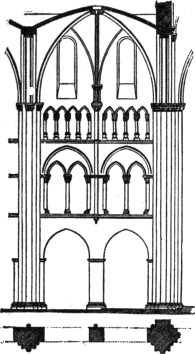
FIG. 139.—ONE BAY OF CATHEDRAL OF ST. GEORGE, LIMBURG.
CONSTRUCTION. As already remarked, a tenacious hold of
Romanesque methods is observable in many German Gothic monuments. Broad
wall-surfaces with small windows and a general massiveness and lowness
of proportions were long preferred to the more slender and lofty forms
of true
239
Gothic design. Square vaulting-bays were persistently adhered to,
covering two aisle-bays. The six-part system was only rarely resorted
to, as at Schlettstadt, and in St. George at Limburg-on-the-Lahn (Fig.
139). The ribbed vault was an imported idea, and was never
systematically developed. Under the final dominance of French models in
the second half of the thirteenth century, vaulting in oblong bays
became more general, powerfully influenced by buildings like Freiburg,
Cologne, Oppenheim, and Ratisbon cathedrals. In the fourteenth century
the growing taste for elaboration and rich detail led to the
introduction of multiplied decorative ribs. These, however, did not come
into use, as in England, through a logical development of constructive
methods, but purely as decorative features. The German multiple-ribbed
vaulting is, therefore, less satisfying than the English, though often
elegant. Conspicuous examples of its application are found in the
cathedrals of Freiburg, Ulm, Prague, and Vienna; in St. Barbara at
Kuttenberg, and many other important churches. But with all the richness
and complexity of these net-like vaults the Germans developed nothing
like the fan-vaulting or chapter-house ceilings of England.
SIDE AISLES. The most notable structural innovation of the
Germans was the raising of the side aisles to the same height as the
central aisle in a number of important
240
churches. They thus created a distinctly new type, to which German
writers have given the name of hall-church. The result of this
innovation was to transform completely the internal perspective of the
church, as well as its structural membering. The clearstory disappeared;
the central aisle no longer dominated the interior; the pier-arches and
side-walls were greatly increased in height, and flying buttresses were
no longer required. The whole design appeared internally more spacious,
but lost greatly in variety and in interest. The cathedral of St.
Stephen at Vienna is the most imposing instance of this treatment,
which first appeared in the church of St. Elizabeth at Marburg
(1235–83; Fig. 140). St. Barbara at Kuttenberg, St. Martin’s at
Landshut (1404), and the cathedral of Munich are others among many
examples of this type.
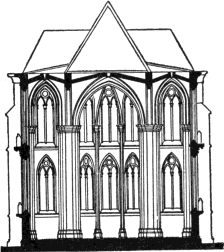
FIG. 140.—SECTION OF ST. ELIZABETH, MARBURG.
TOWERS AND SPIRES. The same fondness for spires which had been
displayed in the Rhenish Romanesque churches produced in the Gothic
period a number of strikingly beautiful church steeples, in which
openwork tracery was substituted for the solid stone pyramids of earlier
examples. The most remarkable of these spires are those of Freiburg
(1300), Strasburg, and Cologne cathedrals, of the church at Esslingen,
St. Martin’s at Landshut, and the cathedral of Vienna. In these the
transition from the simple square tower below to the octagonal belfry
and spire is generally managed with skill. In the remarkable tower of
the cathedral
241
at Vienna (1433) the transition is too gradual, so that the spire seems
to start from the ground and lacks the vigor and accent of a simpler
square lower portion. The over-elaborate spire of Strasburg
(1429, by Junckher of Cologne; lower parts and façade, 1277–1365,
by Erwin von Steinbach and his sons) reaches a height of 468
feet; the spires of Cologne, completed in 1883 from the original
fourteenth-century drawings, long lost but recovered by a happy
accident, are 500 feet high. The spires of Ratisbon and
Ulm cathedrals have also been recently completed in the original
style.
DETAILS. German window tracery was best where it most closely
followed French patterns, but it tended always towards the faults of
mechanical stiffness and of technical display in over-slenderness of
shafts and mullions. The windows, especially in the “hall-churches,”
were apt to be too narrow for their height. In the fifteenth century
ingenuity of geometrical combinations took the place of grace of line,
and later the tracery was often tortured into a stone caricature of
rustic-work of interlaced and twisted boughs and twigs, represented with
all their bark and knots (branch-tracery). The execution was far
superior to the design. The carving of foliage in capitals, finials,
etc., calls for no special mention for its originality or its departure
from French types.
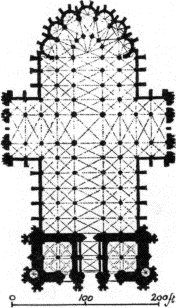
FIG. 141.—COLOGNE CATHEDRAL. PLAN.
PLANS. In these there was more variety than in any other part
of Europe except Italy. Some churches, like Naumburg, retained the
Romanesque system of a second western apse and short choir. The
Cistercian churches generally had square east ends, while the polygonal
eastern apse without ambulatory is seen in St. Elizabeth at Marburg, the
cathedrals of Ratisbon, Ulm and Vienna, and many other churches. The
introduction of French ideas in the thirteenth century led to the
adoption in a number of cases of the chevet with a single ambulatory and
a series of
242
radiating apsidal chapels. Magdeburg cathedral (1208–11)
was the first erected on this plan, which was later followed at
Altenburg, Cologne, Freiburg, Lübeck, Prague and Zwettl, in St. Francis
at Salzburg and some other churches. Side chapels to nave or choir
appear in the cathedrals of Lübeck, Munich, Oppenheim, Prague and
Zwettl. Cologne Cathedral, by far the largest and most
magnificent of all, is completely French in plan, uniting in one design
the leading characteristics of the most notable French churches (Fig.
141). It has complete double aisles in both nave and choir, three-aisled
transepts, radial chevet-chapels and twin western towers. The ambulatory
is, however, single, and there are no lateral chapels. A typical
German treatment was the eastward termination of the church by polygonal
chapels, one in the axis of each aisle, the central one projecting
beyond its neighbors. Where there were five aisles, as at Xanten, the
effect was particularly fine. The plan of the curious polygonal church
of Our Lady (Liebfrauenkirche; 1227–43) built on the site
of the ancient circular baptistery at Treves, would seem to have been
produced by doubling such an arrangement on either side of the
transverse axis (Fig. 142).
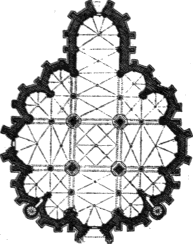
FIG. 142.—CHURCH OF OUR LADY, TREVES.
HISTORICAL DEVELOPMENT. The so-called Golden Portal of
Freiburg in the Erzgebirge is perhaps the first distinctively
Gothic work in Germany, dating from 1190. From that time on, Gothic
details appeared with increasing frequency, especially in the Rhine
provinces, as shown in many
243
transitional structures. Gelnhausen and Aschaffenburg are early
13th-century examples; pointed arches and vaults appear in the Apostles’
and St. Martin’s churches at Cologne; and the great church of St.
Peter and St. Paul at Neuweiler in Alsace has an almost purely
Gothic nave of the same period. The churches of Bamberg,
Fritzlar, and Naumburg, and in Westphalia those of
Münster and Osnabrück, are important examples of the
transition. The French influence, especially the Burgundian, appears as
early as 1212 in the cathedral of Magdeburg, imitating the choir of
Soissons, and in the structural design of the Liebfrauenkirche at Treves
as already mentioned; it reached complete ascendancy in Alsace at
Strasburg (nave 1240–75), in Baden at Freiburg (nave
1270) and in Prussia at Cologne (1248–1320). Strasburg
Cathedral is especially remarkable for its façade, the work of Erwin von
Steinbach and his sons (1277–1346), designed after French models,
and its north spire, built in the fifteenth century. Cologne Cathedral,
begun in 1248 by Gerhard of Riel in imitation of the newly
completed choir of Amiens, was continued by Master Arnold and his
son John, and the choir was consecrated in 1322. The nave and
W. front were built during the first half of the 14th century,
though the towers were not completed till 1883.
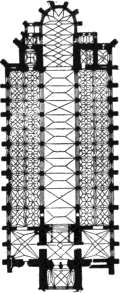
FIG. 143.—PLAN OF
ULM CATHEDRAL.
In spite of its vast size and slow construction, it is in style the most
uniform of all great Gothic cathedrals, as it is the most lofty
(excepting the choir of Beauvais) and the largest excepting Milan and
244
Seville. Unfortunately its details, though pure and correct, are
singularly dry and mechanical, while its very uniformity deprives it of
the picturesque and varied charm which results from a mixture of styles
recording the labors of successive generations. The same criticism may
be raised against the late cathedral of Ulm (choir,
1377–1449; nave, 1477; Fig. 143). The Cologne influence is
observable in the widely separated cathedrals of Utrecht in the
Netherlands, Metz in the W., Minden and Halberstadt (begun 1250;
mainly built after 1327) in Saxony, and in the S. in the church of
St. Catherine at Oppenheim. To the E. and S., in the
cathedrals of Prague (Bohemia) by Matthew of Arras
(1344–52) and Ratisbon (or Regensburg, 1275) the French
influence predominates, at least in the details and construction. The
last-named is one of the most dignified and beautiful of German Gothic
churches—German in plan, French in execution. The French influence
also manifests itself in the details of many of the peculiarly German
churches with aisles of equal height (see p. 240).
More peculiarly German are the brick churches of North Germany, where
stone was almost wholly lacking. In these, flat walls, square towers,
and decoration by colored tiles and bricks are characteristic, as at
Brandenburg (St. Godehard and St. Catherine, 1346–1400), at
Prentzlau, Tängermünde, Königsberg, &c. Lübeck possesses
notable monuments of brick architecture in the churches of St.
Mary and St. Catherine, both much alike in plan and in the flat and
barren simplicity of their exteriors. St. Martin’s at
Landshut in the South is also a notable brick church.
245
LATE GOTHIC. As in France and England, the fourteenth and
fifteenth centuries were mainly occupied with the completion of existing
churches, many of which, up to that time, were still without naves. The
works of this period show the exaggerated attenuation of detail already
alluded to, though their richness and elegance sometimes atone for their
mechanical character. The complicated ribbed vaults of this period are
among its most striking features (see p. 239). Spire-building was as general as was the
erection of central square towers in England, during the same period. To
this time also belong the overloaded traceries and minute detail of the
St. Sebald and St. Lorenz churches and of several secular
buildings at Nuremberg, the façade of Chemnitz Cathedral, and similar
works. The nave and tower of St. Stephen at Vienna (1359–1433),
the church of Sta. Maria in Gestade in the same city, and the cathedral
of Kaschau in Hungary, are Austrian masterpieces of late Gothic
design.
SECULAR BUILDINGS. Germany possesses a number of important
examples of secular Gothic work, chiefly municipal buildings (gates and
town halls) and castles. The first completely Gothic castle or palace
was not built until 1280, at Marienburg (Prussia), and was
completed a century later. It consists of two courts, the earlier of the
two forming a closed square and containing the chapel and chapter-house
of the Order of the German knights. The later and larger court is less
regular, its chief feature being the Great Hall of the Order, in
two aisles. All the vaulting is of the richest multiple-ribbed type.
Other castles are at Marienwerder, Heilsberg (1350) in E. Prussia,
Karlstein in Bohemia (1347), and the Albrechtsburg at Meissen in
Saxony (1471–83).
Among town halls, most of which date from the fourteenth and
fifteenth centuries may be mentioned those of Ratisbon (Regensburg),
Münster and Hildesheim, Halberstadt,
246
Brunswick, Lübeck, and Bremen—the last two of brick. These,
and the city gates, such as the Spahlenthor at Basle
(Switzerland) and others at Lübeck and Wismar, are generally very
picturesque edifices. Many fine guildhalls were also built during the
last two centuries of the Gothic style; and dwelling-houses of the same
period, of quaint and effective design, with stepped or traceried
gables, lofty roofs, openwork balconies and corner turrets, are to be
found in many cities. Nuremberg is especially rich in these.
THE NETHERLANDS, as might be expected from their position,
underwent the influences of both France and Germany. During the
thirteenth century, largely through the intimate monastic relations
between Tournay and Noyon, the French influence became paramount in what
is now Belgium, while Holland remained more strongly German in style. Of
the two countries Belgium developed by far the most interesting
architecture. Some of its cathedrals, notably those of Tournay, Antwerp,
Brussels, Malines (Mechlin), Mons and Louvain, rank high among
structures of their class, both in scale and in artistic treatment. The
Flemish town halls and guildhalls merit particular attention for their
size and richness, exemplifying in a worthy manner the wealth,
prosperity, and independence of the weavers and merchants of Antwerp,
Ypres, Ghent (Gand), Louvain, and other cities in the fifteenth
century.
CATHEDRALS AND CHURCHES. The earliest purely Gothic edifice in
Belgium was the choir of Ste. Gudule (1225) at Brussels, followed
in 1242 by the choir and transepts of Tournay, designed with
pointed vaults, side chapels, and a complete chevet. The
transept-ends are round, as at Noyon. It was surpassed in splendor by
the Cathedral of Antwerp (1352–1422), remarkable for
its seven-aisled nave and narrow transepts. It covers some 70,000 square
feet, but its great size is not as effective internally as it should be,
owing to the poverty of the details and the lack
247
of finely felt proportion in the various parts. The late west front
(1422–1518) displays the florid taste of the wealthy Flemish
burgher population of that period, but is so rich and elegant,
especially its lofty and slender north spire, that its over-decoration
is pardonable. The cathedral of St. Rombaut at Malines (choir,
1366; nave, 1454–64) is a more satisfactory church, though smaller
and with its western towers incomplete. The cathedral of Louvain
belongs to the same period (1373–1433). St. Wandru at Mons
(1450–1528) and St. Jacques at Liège (1522–58) are
interesting parish churches of the first rank, remarkable especially for
the use of color in their internal decoration, for their late tracery
and ribbed vaulting, and for the absence of Renaissance details at that
late period.
TOWN HALLS: GUILDHALLS. These were really the most
characteristic Flemish edifices, and are in most cases the most
conspicuous monuments of their respective cities. The Cloth Hall
of Ypres (1304) is the earliest and most imposing among them;
similar halls were built not much later at Bruges,
Louvain, Malines and Ghent. The town halls were
mostly of later date, the earliest being that of Bruges (1377).
The town halls of Brussels with its imposing
248
and graceful tower, of Louvain (1448–63; Fig. 144) and of
Oudenärde (early 16th century) are conspicuous monuments of this
class.
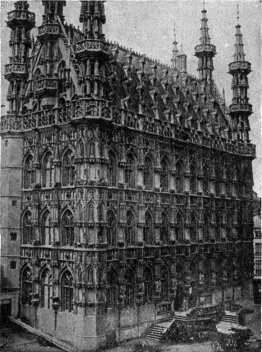
FIG. 144.—TOWN HALL, LOUVAIN.
In general, the Gothic architecture of Belgium presents the traits of
a borrowed style, which did not undergo at the hands of its borrowers
any radically novel or fundamental development. The structural design is
usually lacking in vigor and organic significance, but the details are
often graceful and well designed, especially on the exterior. The
tendency was often towards over-elaboration, particularly in the later
works.
The Gothic architecture of Holland and of the
Scandinavian countries offers so little that is highly artistic
or inspiring in character, that space cannot well be given in this work,
even to an enumeration of its chief monuments.
SPAIN AND PORTUGAL. The beginnings of Gothic architecture in
Spain followed close on the series of campaigns from 1217 to 1252, which
began the overthrow of the Moorish dominion. With the resulting spirit
of exultation and the wealth accruing from booty, came a rapid
development of architecture, mainly under French influence. Gothic
architecture was at this date, under St. Louis, producing in France some
of its noblest works. The great cathedrals of Toledo and
Burgos, begun between 1220 and 1230, were the earliest purely
Gothic churches in Spain. San Vincente at Avila and the Old
Cathedral at Salamanca, of somewhat earlier date, present a mixture
of round- and pointed-arched forms, with the Romanesque elements
predominant. Toledo Cathedral, planned in imitation of Notre Dame
and Bourges, but exceeding them in width, covers 75,000 square feet, and
thus ranks among the largest of European cathedrals. Internally it is
well proportioned and well detailed, recalling the early French
masterworks, but its exterior is less commendable.
249
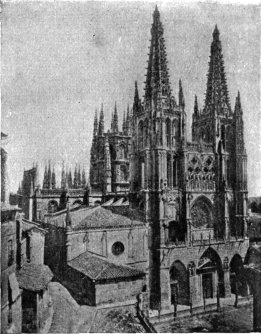
FIG. 145.—FAÇADE OF BURGOS CATHEDRAL.
In the contemporary cathedral of Burgos the exterior is at least as
interesting as the interior. The west front, of German design, suggests
Cologne by its twin openwork spires (Fig. 145); while the crossing is
embellished with a sumptuous dome and lantern or cimborio, added
as late as 1567. The chapels at the east end, especially that of the
Condestabile (1487), are ornate to the point of overloading,
a fault to which late Spanish Gothic work is peculiarly prone.
Other thirteenth-century cathedrals are those of Leon (1260),
Valencia (1262), and Barcelona (1298), all exhibiting
strongly the French influence in the plan, vaulting, and vertical
proportions. The models of Bourges and Paris with their wide naves,
lateral chapels and semicircular chevets were followed in the cathedral
of Barcelona, in a number of fourteenth-century churches both there and
elsewhere, and in the sixteenth-century cathedral of Segovia. In Sta.
Maria del Pi at Barcelona, in the collegiate church at Manresa, and in
the imposing nave of the Cathedral of Gerona (1416, added
to choir of 1312, the latter by a Southern French architect, Henri de
Narbonne), the influence of Alby in southern France (see p. 206) is discernible. These are one-aisled
churches with internal
250
buttresses separating the lateral chapels. The nave of Gerona is 73 feet
wide, or double the average clear width of French or English cathedral
naves. The resulting effect is not commensurate with the actual
dimensions, and shows the inappropriateness of Gothic details for
compositions so Roman in breadth and simplicity.
SEVILLE. The largest single edifice in Spain, and the largest
church built during the Middle Ages in Europe, is the Cathedral of
Seville, begun in 1401 on the site of a Moorish mosque. It covers
124,000 square feet, measuring 415 × 298 feet, and is a simple rectangle
comprising five aisles with lateral chapels. The central aisle is 56 ft.
wide and 145 high; the side aisles and chapels diminish gradually in
height, and with the uniform piers in six rows produce an imposing
effect, in spite of the lack of transepts or chevet. The somewhat
similar New Cathedral of Salamanca (1510–1560) shows the
last struggles of the Gothic style against the incoming tide of the
Renaissance.
LATER MONUMENTS. These all partake of the over-decoration
which characterized the fifteenth century throughout Europe. In Spain
this decoration was even less constructive in character, and more purely
fanciful and arbitrary, than in the northern lands; but this very
rejection of all constructive pretense gives it a peculiar charm and
goes far to excuse its extravagance (Fig. 146). Decorative vaulting-ribs
were made to describe geometric patterns of great elegance. Some of the
late Gothic vaults by the very exuberance of imagination shown in their
designs, almost disarm criticism. Instead of suppressing the walls as
far as possible, and emphasizing all the vertical lines, as was done in
France and England, the later Gothic architects of Spain delighted in
broad wall-surfaces and multiplied horizontal lines. Upon these surfaces
they lavished carving without restraint and without any organic relation
to the structure of the building. The arcades of
251
cloisters and interior courts (patios) were formed with arches of
fantastic curves resting on twisted columns; and internal chapels in the
cathedrals were covered with minute carving of exquisite workmanship,
but wholly irrational design. Probably the influence of Moorish
decorative art accounts in part for these extravagances. The eastern
chapels in Burgos cathedral, the votive church of San Juan de los
Reyes at Toledo and many portals of churches, convents and hospitals
illustrate these tendencies.
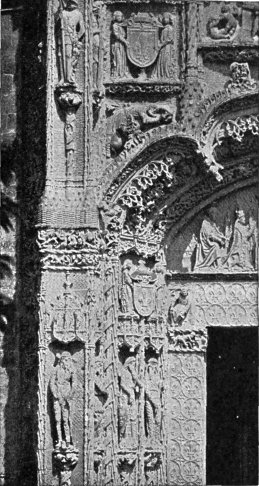
FIG. 146.—DETAIL, PORTAL S. GREGORIO, VALLADOLID.
PORTUGAL is an almost unknown land architecturally. It seems
to have adopted the Gothic styles very late in its history. Two
monuments, however, are conspicuous, the convent churches of Batalha
(1390–1520) and Belem, both marked by an extreme
overloading of carved ornament. The Mausoleum of King Manoel in
the rear of the church at Batalha is, however, a noble creation,
possibly by an English master. It is a polygonal domed edifice, some 67
feet in diameter, and well
252
designed, though covered with a too profuse and somewhat mechanical
decoration of panels, pinnacles, and carving.
MONUMENTS: Germany (C =
cathedral; A = abbey; tr. = transepts).—13th century:
Transitional churches: Bamberg C.; Naumburg C.; Collegiate
Church, Fritzlar; St. George, Limburg-on-Lahn; St. Castor, Coblentz;
Heisterbach A.;—all in early years of 13th century. St.
Gereon, Cologne, choir 1212–27; Liebfrauenkirche, Treves,
1227–44; St. Elizabeth, Marburg, 1235–83; Sts. Peter and
Paul, Neuweiler, 1250; Cologne C., choir 1248–1322 (nave 14th
century; towers finished 1883); Strasburg C., 1250–75
(E. end Romanesque; façade 1277–1365; tower 1429–39);
Halberstadt C., nave 1250 (choir 1327; completed 1490);
Altenburg C., choir 1255–65 (finished 1379); Wimpfen-im-Thal
church 1259–78; St. Lawrence, Nuremberg, 1260 (choir
1439–77); St. Catherine, Oppenheim, 1262–1317 (choir 1439);
Xanten, Collegiate Church, 1263; Freiburg C., 1270 (W. tower
1300; choir 1354); Toul C., 1272; Meissen C., choir 1274 (nave
1312–42); Ratisbon C., 1275; St. Mary’s, Lübeck, 1276;
Dominican churches at Coblentz, Gebweiler; and in Switzerland at Basle,
Berne, and Zurich.—14th century: Wiesenkirche,
Söst, 1313; Osnabrück C., 1318 (choir 1420); St. Mary’s, Prentzlau,
1325; Augsburg C., 1321–1431; Metz C., 1330 rebuilt
(choir 1486); St. Stephen’s C., Vienna, 1340 (nave 15th century; tower
1433); Zwette C., 1343; Prague C., 1344; church at Thann, 1351
(tower finished 16th century); Liebfrauenkirche, Nuremberg,
1355–61; St. Sebaldus Church, Nuremberg, 1361–77 (nave
Romanesque); Minden C., choir 1361; Ulm C., 1377 (choir 1449;
nave vaulted 1471; finished 16th century); Sta. Barbara, Kuttenberg,
1386 (nave 1483); Erfurt C.; St. Elizabeth, Kaschau;
Schlettstadt C.—15th century: St. Catherine’s, Brandenburg,
1401; Frauenkirche, Esslingen, 1406 (finished 1522); Minster at Berne,
1421; Peter-Paulskirche, Görlitz, 1423–97; St. Mary’s, Stendal,
1447; Frauenkirche, Munich, 1468–88; St. Martin’s, Landshut,
1473.
Secular Monuments. Schloss
Marienburg, 1341; Moldau-bridge and tower, Prague, 1344; Karlsteinburg,
1348–57; Albrechtsburg, Meissen, 1471–83; Nassau House,
Nuremberg, 1350; Council houses (Rathhaüser) at Brunswick, 1393;
Cologne, 1407–15; Basle; Breslau; Lübeck; Münster; Prague; Ulm;
City Gates of Basle, Cologne, Ingolstadt, Lucerne.
The Netherlands.
Brussels C. (Ste. Gudule), 1226–80; Tournai C., choir
1242 (nave finished 1380); Notre Dame, Bruges, 1239–97; Notre
Dame, Tongres, 1240; Utrecht C., 1251; St. Martin, Ypres, 1254;
Notre Dame, Dinant, 1255; church at Dordrecht;
church at Aerschot,
253
1337; Antwerp C., 1352–1411 (W. front 1422–1518); St.
Rombaut, Malines, 1355–66 (nave 1456–64); St. Wandru, Mons,
1450–1528; St. Lawrence, Rotterdam, 1472; other 15th century
churches—St. Bavon, Haarlem; St. Catherine, Utrecht; St.
Walpurgis, Sutphen; St. Bavon, Ghent (tower 1461); St. Jaques, Antwerp;
St. Pierre, Louvain; St. Jacques, Bruges; churches at Arnheim, Breda,
Delft; St. Jacques, Liège, 1522.—Secular: Cloth-hall, Ypres, 1200–1304;
cloth-hall, Bruges, 1284; town hall, Bruges, 1377; town hall, Brussels,
1401–55; town hall, Louvain, 1448–63; town hall, Ghent,
1481; town hall, Oudenarde, 1527; Standehuis, Delft, 1528; cloth-halls
at Louvain, Ghent, Malines.
Spain.—13th century: Burgos
C., 1221 (façade 1442–56; chapels 1487; cimborio 1567);
Toledo C., 1227–90 (chapels 14th and 15th centuries);
Tarragona C., 1235; Leon C., 1250 (façade 14th century);
Valencia C., 1262 (N. transept 1350–1404; façade
1381–1418); Avila C., vault and N. portal
1292–1353 (finished 14th century); St. Esteban, Burgos; church at
Las Huelgas.—14th century: Barcelona C., choir
1298–1329 (nave and transepts 1448; façade 16th century);
Gerona C., 1312–46 (nave added 1416); S. M. del Mar,
Barcelona, 1328–83; S. M. del Pino, Barcelona, same date;
Collegiate Church, Manresa, 1328; Oviedo C., 1388 (tower very
late); Pampluna C., 1397 (mainly 15th century).—15th century:
Seville C., 1403 (finished 16th century; cimborio 1517–67);
La Seo, Saragossa (finished 1505); S. Pablo, Burgos, 1415–35;
El Parral, Segovia, 1459; Astorga C., 1471; San Juan de los Reyes,
Toledo, 1476; Carthusian church, Miraflores, 1488; San Juan, and La
Merced, Burgos.—16th century: Huesca C., 1515; Salamanca New
Cathedral, 1510–60; Segovia C., 1522; S. Juan de la
Puerta, Zamorra.
Secular.—Porta Serraños,
Valencia, 1349; Casa Consistorial, Barcelona, 1369–78; Casa de la
Disputacion, same city; Casa de las Lonjas, Valencia, 1482.
Portugal. At Batalha, church and
mausoleum of King Manoel, finished 1515; at Belem, monastery, late
Gothic.
254
GOTHIC ARCHITECTURE IN ITALY.
Books Recommended; As before, Corroyer,
Reber. Also, Cummings, A History of
Architecture in Italy. De Fleury, La Toscane au moyen âge.
Gruner, The Terra Cotta Architecture of Northern Italy. Mothes,
Die Baukunst des Mittelalters in Italien. Norton, Historical
Studies of Church Building in the Middle Ages. Osten, Bauwerke
der Lombardei. Street, Brick and Marble Architecture of
Italy. Willis, Remarks on the Architecture of the Middle Ages,
especially of Italy.
GENERAL CHARACTER. The various Romanesque styles which had
grown up in Italy before 1200 lacked that unity of principle out of
which alone a new and homogeneous national style could have been
evolved. Each province practised its own style and methods of building,
long after the Romanesque had given place to the Gothic in Western
Europe. The Italians were better decorators than builders, and cared
little for Gothic structural principles. Mosaic and carving, sumptuous
altars and tombs, veneerings and inlays of colored marble, broad flat
surfaces to be covered with painting and ornament—to secure these
they were content to build crudely, to tie their insufficiently
buttressed vaults with unsightly iron tie-rods, and to make their church
façades mere screen-walls, in form wholly unrelated to the buildings
behind them.
When, therefore, under foreign influences pointed arches, tracery,
clustered shafts, crockets and finials came into use, it was merely as
an imported fashion. Even when foreign architects (usually Germans) were
employed, the
255
composition, and in large measure the details, were still Italian and
provincial. The church of St. Francis at Assisi (1228–53, by
Jacobus of Meruan, a German, superseded later by an Italian,
Campello), and the cathedral of Milan (begun 1389, perhaps by Henry
of Gmund), are conspicuous illustrations of this. Rome built
basilicas all through the Middle Ages. Tuscany continued to prefer flat
walls veneered with marble to the broken surfaces and deep buttresses of
France and Germany. Venice developed a Gothic style of façade-design
wholly her own (see p. 267). Nowhere but
in Italy could two such utterly diverse structures as the Certosa at
Pavia and the cathedral at Milan have been erected at the same time.
CLIMATE AND TRADITION. Two further causes militated against
the domestication of Gothic art in Italy. The first was the brilliant
atmosphere, which made the vast traceried windows of Gothic design, and
its suppression of the wall-surfaces, wholly undesirable. Cool, dim
interiors, thick walls, small windows and the exclusion of sunlight, all
necessary to Italian comfort, were incompatible with Gothic ideals and
methods. The second obstacle was the persistence of classic traditions
of form, both in construction and decoration. The spaciousness and
breadth of interior planning which characterized Roman design, and its
amplitude of scale in every feature, seem never to have lost their hold
on the Italians. The narrow lofty aisles, multiplied supports and minute
detail of the Gothic style were repugnant to the classic predilections
of the Italian builders. The Roman acanthus and Corinthian capital were
constantly imitated in their Gothic buildings, and the round arch
continued all through the Middle Ages to be used in conjunction with the
pointed arch (Figs. 149, 150).
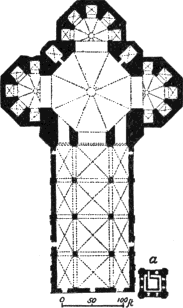
FIG. 147.—DUOMO AT FLORENCE. PLAN.
a, Campanile.
EARLY BUILDINGS. It is hard to determine how and by whom
Gothic forms were first introduced into Italy, but it was most probably
through the agency of the monastic
256
orders. Cistercian churches like that at Chiaravalle near Milan
(1208–21), and most of those erected by the mendicant orders of
the Franciscans (founded 1210) and Dominicans (1216), were built with
ribbed vaults and pointed arches. The example set by
these orders contributed greatly to the general adoption of the foreign
style. S. Francesco at Assisi, already mentioned, was
the first completely Gothic Franciscan church, although
S. Francesco at Bologna, begun a few years later, was
finished a little earlier. The Dominican church of SS. Giovanni e
Paolo and the great Franciscan church of Sta. Maria Gloriosa dei
Frari, both at Venice, were built a little later. Sta. Maria
Novella at Florence (1278), and Sta. Maria sopra Minerva at
Rome (1280), both by the brothers Sisto and Ristoro, and
S. Anastasia at Verona (1261) are the masterpieces of the
Dominican builders. S. Andrea at
Vercelli in North Italy, begun in 1219 under a foreign architect,
is an isolated early example of lay Gothic work. Though somewhat English
in its plan, and (unlike most Italian churches) provided with two
western spires in the English manner, it is in all other respects
thoroughly Italian in aspect. The church at Asti, begun in 1229,
suggests German models by its high side walls and narrow windows.
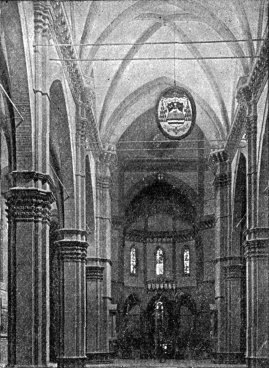
FIG. 148.—NAVE OF DUOMO AT FLORENCE.
CATHEDRALS. The greatest monuments of Italian Gothic design
are the cathedrals, in which, even more than was the case in France, the
highly developed civic pride of the
257
municipalities expressed itself. Chief among these half civic, half
religious monuments are the cathedrals of Sienna (begun in 1243),
Arezzo (1278), Orvieto (1290), Florence (the
Duomo, Sta. Maria del Fiore, begun 1294 by Arnolfo di Cambio),
Lucca (S. Martino, 1350), Milan (1389–1418),
and S. Petronio at Bologna (1390). They
are all of imposing size; Milan is the largest of all Gothic cathedrals
except Seville. S. Petronio was planned to be
600 feet long, the present structure with its three broad aisles and
flanking chapels being merely the nave of the intended edifice. The
Duomo at Florence (Fig. 147) is 500 feet long and covers 82,000 square
feet, while the octagon at the crossing is 143 feet in diameter. The
effect of these colossal dimensions is, however, as in a number of these
large Italian interiors, singularly belittled by the bareness of the
walls, by the great size of the constituent parts of the composition,
and by the lack of architectural subdivisions and multiplied detail to
serve as a scale by which to gauge the scale of the ensemble.
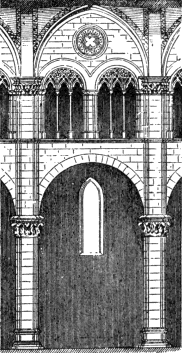
FIG. 149.—ONE BAY, NAVE OF CATHEDRAL OF SAN MARTINO, LUCCA.
INTERIOR TREATMENT. It was doubtless intended to cover these
large unbroken wall-surfaces and the vast expanse of the vaults over
naves of extraordinary breadth,
258
with paintings and color decoration. This would have remedied their
present nakedness and lack of interest, but it was only in a very few
instances carried out. The double church of S. Francesco at Assisi,
decorated by Cimabue, Giotto, and other early Tuscan painters, the Arena
Chapel at Padua, painted by Giotto, the Spanish Chapel of
S. M. Novella, Florence, and the east end of S. Croce,
Florence, are illustrations of the splendor of effect possible by this
method of decoration. The bareness of effect in other, unpainted
interiors was emphasized by the plainness of the vaults destitute of
minor ribs. The transverse ribs were usually broad arches with flat
soffits, and the vaulting was often sprung from so low a point as to
leave no room for a triforium. Mere bull’s-eyes often served for
clearstory windows, as in S. Anastasia at Verona, S. Petronio
at Bologna, and the Florentine Duomo. The cathedral of
S. Martino at Lucca (Fig. 149) is one of the most complete
and elegant of Italian Gothic interiors, having a genuine triforium with
traceried arches. Even here, however, there are round arches without
mouldings, flat pilasters, broad transverse ribs recalling Roman arches,
and insignificant bull’s-eyes in the clearstory.
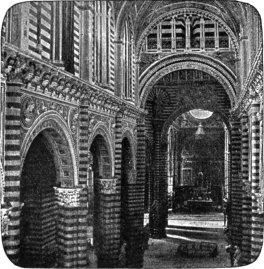
FIG. 150.—INTERIOR OF SIENNA CATHEDRAL.
The failure to produce adequate results of scale in the interiors of
the larger Italian churches, has been already alluded to. It is
strikingly exemplified in the Duomo at Florence, the nave of which is 72
feet wide, with four pier-arches
259
each over 55 feet in span. The immense vault, in square bays, starts
from the level of the tops of these arches. The interior (Fig. 148) is
singularly naked and cold, giving no conception of its vast dimensions.
The colossal dome is an early work of the Renaissance (see p. 276). It is not known how Fr.
Talenti, who in 1357 enlarged and vaulted the nave and planned the
east end, proposed to cover the great octagon. The east end is the most
effective part of the design both internally and externally, owing to
the relatively moderate scale of the 15 chapels which surround the
apsidal arms of the cross. In S. Petronio at Bologna, begun 1390 by
Master Antonio, the scale is better handled. The nave, 300 feet
long, is divided into six bays, each embracing two side chapels. It is
46 feet wide and 132 feet high, proportions which approximate those of
the French cathedrals, and produce an impression of size somewhat
unusual in Italian churches. Orvieto has internally little that
suggests Gothic architecture; like many Franciscan and Dominican
churches it is really a timber-roofed basilica with a few pointed
windows. The mixed Gothic and Romanesque interior of Sienna
Cathedral (Fig. 150), with its round arches and six-sided dome,
unsymmetrically placed over the crossing, is one of the most impressive
creations of Italian mediæval art. Alternate courses of black and white
marble add richness but not
260
repose to the effect of this interior: the same is true of Orvieto, and
of some other churches. The basement baptistery of
S. Giovanni, under the east end of Sienna Cathedral, is much
more purely Gothic in detail.
In these, and indeed in most Italian interiors, the main interest
centres less in the excellence of the composition than in the
accessories of pavements, pulpits, choir-stalls, and sepulchral
monuments. In these the decorative fancy and skill of the Italians found
unrestrained exercise, and produced works of surpassing interest and
merit.
EXTERNAL DESIGN. The greatest possible disparity generally
exists between the sides and west fronts of the Italian churches. With
few exceptions the flanks present nothing like the variety of sky-line
and of light and shade customary in northern and western lands. The side
walls are high and flat, plain, or striped with black and white masonry
(Sienna, Orvieto), or veneered with marble (Duomo at Florence) or
decorated with surface-ornament of thin pilasters and arcades (Lucca).
The clearstory is low; the roof low—pitched and hardly visible
from below. Color, rather than structural richness, is generally sought
for: Milan Cathedral is almost the only exception, and goes to the other
extreme, with its seemingly countless buttresses, pinnacles and
statues.
The façades, on the other hand, were treated as independent
decorative compositions, and were in many cases remarkably beautiful
works, though having little or no organic relation to the main
structure. The most celebrated are those of Sienna (cathedral
begun 1243; façade 1284 by Giovanni Pisano; Fig. 151) and
Orvieto (begun 1290 by Lorenzo Maitani; façade 1310). Both
of these are sumptuous polychromatic compositions in marble, designed on
somewhat similar lines, with three high gables fronting the three
aisles, with deeply recessed portals, pinnacled turrets flanking nave
and aisles, and a central circular window. That
261
of Orvieto is furthermore embellished with mosaic pictures, and is the
more brilliant in color of the two. The mediæval façades of the
Florentine Gothic churches were never completed; but the elegance of the
panelling and of the tracery with twisted shafts in the flanks of the
cathedral, and the florid beauty of its side doorways (late 14th
century) would doubtless if realized with equal success on the façades,
have produced strikingly beautiful results. The modern façade of the
Duomo, by the late De Fabris (1887) is a correct if not highly
imaginative version of the style so applied. The front of Milan
cathedral (soon to be replaced by a new façade), shows a mixture of
Gothic and Renaissance forms. Ferrara Cathedral, although
internally transformed in the last century, retains its fine
13th-century three-gabled and arcaded screen front; one of the most
Gothic in spirit of all Italian façades. The Cathedral of
Genoa presents Gothic windows and deeply recessed portals in a
façade built in black and white bands, like Sienna cathedral and many
churches in Pistoia and Pisa.
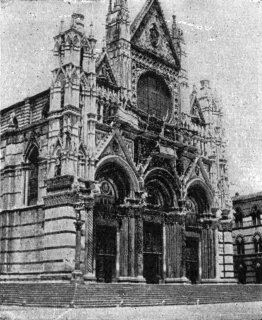
FIG. 151.—FAÇADE OF SIENNA CATHEDRAL.
Externally the most important feature was frequently a cupola or dome
over the crossing. That of Sienna has already been mentioned; that of
Milan is a sumptuous many-pinnacled structure terminating in a spire 300
feet high.
262
The Certosa at Pavia (Fig. 152) and the earlier Carthusian church
of Chiaravalle have internal cupolas or domes covered externally by
many-storied structures ending in a tower dominating the whole edifice.
These two churches, like many others in Lombardy, the Æmilia and
Venetia, are built of brick, moulded terra-cotta being effectively used
for the cornices, string-courses, jambs and ornaments of the exterior.
The Certosa at Pavia is contemporary with the cathedral of Milan, to
which it offers a surprising contrast, both in style and material. It is
wholly built of brick and terra-cotta, and, save for its ribbed
vaulting, possesses hardly a single Gothic feature or detail. Its
arches, mouldings, and cloisters suggest both the Romanesque and the
Renaissance styles by their semi-classic character.
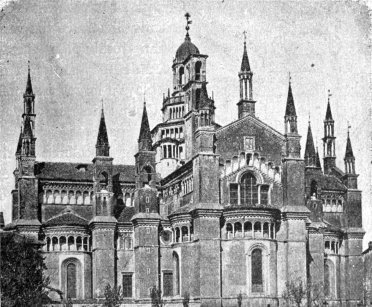
FIG. 152.—EXTERIOR OF THE CERTOSA, PAVIA.
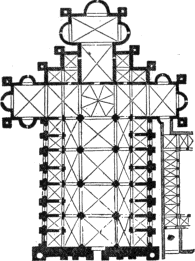
FIG. 153.—PLAN OF CERTOSA AT PAVIA.
PLANS. The wide diversity of local styles in Italian
architecture appears in the plans as strikingly as in the details
263
In general one notes a love of spaciousness which expresses itself in a
sometimes disproportionate breadth, and in the wide spacing of the
piers. The polygonal chevet with its radial chapels is but rarely seen;
S. Lorenzo at Naples, Sta. Maria dei Servi and
S. Francesco at Bologna are among the most important examples. More
frequently the chapels form a range along the east side of the
transepts, especially in the Franciscan churches, which otherwise retain
many basilican features. A comparison of the plans of
S. Andrea at Vercelli, the Duomo at Florence, the cathedrals of
Sienna and Milan, S. Petronio at Bologna and the Certosa at Pavia
(Fig. 153), sufficiently illustrates the variety of Italian Gothic
plan-types.
ORNAMENT. Applied decoration plays a large part in all Italian
Gothic designs. Inlaid and mosaic patterns and panelled veneering in
colored marble are essential features of the exterior decoration of most
Italian churches. Florence offers a fine example of this treatment in
the Duomo, and in its accompanying Campanile or bell-tower,
designed by Giotto (1335), and completed by Gaddi and
Talenti. This beautiful tower is an epitome of Italian Gothic
art. Its inlays, mosaics, and veneering are treated with consummate
elegance, and combined with incrusted reliefs of great beauty. The
tracery of this monument and of the side windows of the adjoining
cathedral is lighter and more graceful than is common in Italy. Its
beauty consists, however, less in movement of line than in richness and
elegance of carved and inlaid ornament. In
264
the Or San Michele—a combined chapel and granary in
Florence dating from 1330—the tracery is far less light and open.
In general, except in churches like the Cathedral of Milan, built under
German influences, the tracery in secular monuments is more successful
than in ecclesiastical structures. Venice developed the designing of
tracery to greater perfection in her palaces than any other Italian city
(see below).
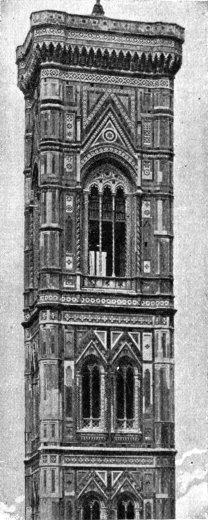
FIG. 154.—UPPER PART OF CAMPANILE, FLORENCE.
MINOR WORKS. Italian Gothic art found freer expression in
semi-decorative works, like tombs, altars and votive chapels, than in
more monumental structures. The fourteenth century was particularly rich
in canopy tombs, mostly in churches, though some were erected in the
open air, like the celebrated Tombs of the Scaligers in Verona
(1329–1380). Many of those in churches in and near Rome, and
others in south Italy, are especially rich in inlay of opus
Alexandrinum upon their twisted columns and panelled sarcophagi. The
family of the Cosmati acquired great fame for work of this kind
during the thirteenth century.
The little marble chapel of Sta. Maria della Spina, on the
Arno, at Pisa, is an instance of the successful decorative use of Gothic
forms in minor buildings.
TOWERS. The Italians always preferred the square tower to the
spire, and in most cases treated it as an independent campanile.
Following Early Christian and Romanesque traditions, these square towers
were usually built with plain sides unbroken by buttresses, and
terminated in a flat roof or a low and inconspicuous cone or pyramid.
The Campanile at Florence already mentioned is by far the most beautiful
of these designs (Fig. 154). The campaniles of Sienna, Lucca, and
Pistoia are built in alternate white and black courses, like the
adjoining cathedrals. Verona and Mantua have towers with octagonal
lanterns. In general, these Gothic towers differ from the earlier
Romanesque models only in the forms of their openings. Though dignified
in
265
their simplicity and size, and usually well proportioned, they lack the
beauty and interest of the French, English, and German steeples and
towers.
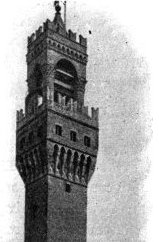
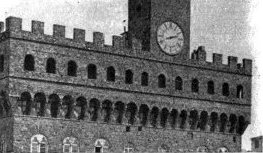
FIG. 155.—UPPER PART OF
PALAZZO VECCHIO, FLORENCE.
SECULAR MONUMENTS. In their public halls, open loggias,
and domestic architecture the Italians were able to develop the
application of Gothic forms with greater freedom than in their
church-building, because unfettered by traditional methods of design.
The early and vigorous growth of municipal and popular institutions led,
as in the Netherlands, to the building of two classes of public
halls—the town hall proper or Podestà, and the council
hall, variously called Palazzo Communale, Pubblico, or
del Consiglio. The town halls, as the seat of authority, usually
have a severe and fortress-like character; the Palazzo Vecchio at
Florence is the most important example (1298, by Arnolfo di Cambio; Fig.
155). It is especially remarkable for its tower, which, rising 308 feet
in the air, overhangs the street nearly 6 feet, its front wall
resting on the face of the powerfully corbelled cornice of the palace.
The court and most of the interior were remodelled in the sixteenth
century. At Sienna is a somewhat
266
similar structure in brick, the Palazzo Pubblico. At Pistoia the
Podestà and the Communal Palace stand opposite each other; in both of
these the courtyards still retain their original aspect. At Perugia,
Bologna, and Viterbo are others of some importance; while in Lombardy,
Bergamo, Como, Cremona, Piacenza and other towns possess smaller halls
with open arcades below, of a more elegant and pleasing aspect. More
successful still are the open loggias or tribunes erected for the
gatherings of public bodies. The Loggia dei Lanzi at Florence
(1376, by Benci di Cione and Simone di Talenti) is the
largest and most famous of these open vaulted halls, of which several
exist in Florence and Sienna. Gothic only in their minor details, they
are Romanesque or semi-classic in their broad round arches and strong
horizontal lines and cornices (Fig. 156).
PALACES AND HOUSES: VENICE. The northern cities, especially
Pisa, Florence, Sienna, Bologna, and Venice, are rich in mediæval public
and private palaces and dwellings in brick or marble, in which pointed
windows and open arcades are used with excellent effect. In Bologna and
Sienna brick is used, in conjunction with details executed in moulded
terra-cotta, in a highly artistic and effective way. Viterbo, nearer
Rome, also possesses many interesting
267
houses with street arcades and open stairways or stoops leading to the
main entrance.
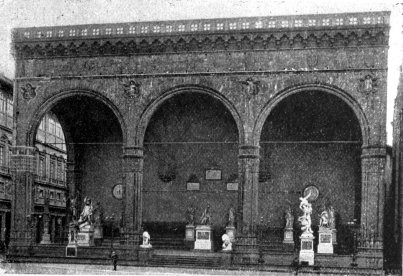
FIG. 156.—LOGGIA DEI LANZI, FLORENCE.
The security and prosperity of Venice in the Middle Ages, and the
ever present influence of the sun-loving East, made the massive and
fortress-like architecture of the inland cities unnecessary. Abundant
openings, large windows full of tracery of great lightness and elegance,
projecting balconies and the freest use of marble veneering and
inlay—a survival of Byzantine traditions of the 12th century
(see p. 133)—give to the Venetian
houses and palaces an air of gayety and elegance found nowhere else.
While there are few Gothic churches of importance in Venice, the number
of mediæval houses and palaces is very large. Chief among these is the
Doge’s Palace (Fig. 157), adjoining the church of St. Mark. The
two-storied arcades of the west and south fronts date from 1354, and
originally stood out from the main edifice, which was
268
widened in the next century, when the present somewhat heavy walls, laid
up in red, white and black marble in a species of quarry-pattern, were
built over the arcades. These arcades are beautiful designs, combining
massive strength and grace in a manner quite foreign to Western Gothic
ideas. Lighter and more ornate is the Ca d’Oro, on the Grand
Canal; while the Foscari, Contarini-Fasan, Cavalli, and Pisani palaces,
among many others, are admirable examples of the style. In most of these
a traceried loggia occupies the central part, flanked by walls incrusted
with marble and pierced by Gothic windows with carved mouldings,
borders, and balconies. The Venetian Gothic owes its success largely to
the absence of structural difficulties to interfere with the purely
decorative development of Gothic details.
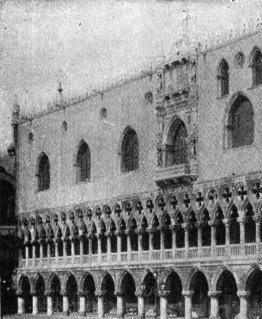
FIG. 157.—WEST FRONT VIEW OF DOGE’S PALACE, VENICE.
MONUMENTS. 13th Century: Cistercian abbeys Fossanova and
Casamari, cir. 1208; S. Andrea, Vercelli, 1209;
S. Francesco, Assisi, 1228–53; Church at Asti, 1229;
Sienna C., 1243–59 (cupola 1259–64; façade 1284);
S. M. Gloriosa dei Frari, Venice, 1250–80 (finished 1388);
Sta. Chiara, Assisi, 1250; Sta. Trinità, Florence, 1250;
S. Antonio, Padua, begun 1256; SS. Giovanni e Paolo, Venice, 1260
(?)-1400; Sta. Anastasia, Verona, 1261; Naples C., 1272–1314
(façade 1299; portal 1407; much altered later); S. Lorenzo, Naples,
1275; Campo Santo, Pisa, 1278–83;
269
Arezzo C., 1278; S. M. Novella, Florence, 1278;
S. Eustorgio, Milan, 1278; S. M. sopra Minerva, Rome, 1280;
Orvieto C., 1290 (façade 1310; roof 1330); Sta. Croce, Florence,
1294 (façade 1863); S. M. del Fiore, or C., Florence,
1294–1310 (enlarged 1357; E. end 1366; dome 1420–64;
façade 1887); S. Francesco, Bologna.—14th century:
Genoa C., early 14th century; S. Francesco, Sienna, 1310; San
Domenico, Sienna, about same date; S. Giovanni in Fonte, Sienna,
1317; S. M. della Spina, Pisa, 1323; Campanile, Florence, 1335; Or
San Michele, Florence, 1337; Milan C., 1386 (cupola 16th century;
façade 16th-19th century; new façade building 1895); S. Petronio,
Bologna, 1390; Certosa, Pavia, 1396 (choir, transepts, cupola,
cloisters, 15th and 16th centuries); Como C., 1396 (choir and
transepts 1513); Lucca C. (S. Martino), Romanesque building
remodelled late in 14th century; Verona C.; S. Fermo,
Maggiore; S. Francesco, Pisa; S. Lorenzo, Vicenza.—15th
century: Perugia C.; S. M. delle Grazie, Milan, 1470 (cupola
and exterior E. part later).
Secular Buildings: Pal. Pubblico,
Cremona, 1245; Pal. Podestà (Bargello), Florence, 1255 (enlarged
1333–45); Pal. Pubblico, Sienna, 1289–1305 (many later
alterations); Pal. Giureconsulti, Cremona, 1292; Broletto, Monza, 1293;
Loggia dei Mercanti, Bologna, 1294; Pal. Vecchio, Florence, 1298;
Broletto, Como; Pal. Ducale (Doge’s Palace), Venice, 1310–40
(great windows 1404; extended 1423–38; courtyard 15th and 16th
centuries); Loggia dei Lanzi, Florence, 1335; Loggia del Bigallo, 1337;
Broletto, Bergamo, 14th century; Loggia dei Nobili, Sienna, 1407; Pal.
Pubblico, Udine, 1457; Loggia dei Mercanti, Ancona; Pal. del Governo,
Bologna; Pal. Pepoli, Bologna; Palaces Conte Bardi, Davanzati, Capponi,
all at Florence; at Sienna, Pal. Tolomei, 1205; Pal. Saracini, Pal.
Buonsignori; at Venice, Pal. Contarini-Fasan, Cavalli, Foscari, Pisani,
and many others; others in Padua and Vicenza.
270
EARLY RENAISSANCE ARCHITECTURE IN ITALY.
Books Recommended: Anderson,
Architecture of the Renaissance in Italy. Burckhardt, The
Civilization of the Renaissance; Geschichte der Renaissance in
Italien; Der Cicerone. Cellesi, Sei Fabbriche di
Firenze. Cicognara, Le Fabbriche più cospicue di Venezia.
Durm, Die Baukunst der Renaissance in Italien (in Hdbuch. d.
Arch.). Fergusson, History of Modern Architecture. Geymüller,
La Renaissance en Toscane. Montigny et Famin, Architecture
Toscane. Moore, Character of Renaissance Architecture. Müntz,
La Renaissance en Italie et en France à l’époque de Charles VIII.
Palustre, L’Architecture de la Renaissance. Pater, Studies in
the Renaissance. Symonds, The Renaissance of the Fine Arts in
Italy. Tosi and Becchio, Altars, Tabernacles, and Tombs.
THE CLASSIC REVIVAL. The abandonment of Gothic architecture in
Italy and the substitution in its place of forms derived from classic
models were occasioned by no sudden or merely local revolution. The
Renaissance was the result of a profound and universal intellectual
movement, whose roots may be traced far back into the Middle Ages, and
which manifested itself first in Italy simply because there the
conditions were most propitious. It spread through Europe just as
rapidly as similar conditions appearing in other countries prepared the
way for it. The essence of this far-reaching movement was the protest of
the individual reason against the trammels of external and arbitrary
authority—a protest which found its earliest organized
expression in the Humanists. In its assertion of the intellectual and
moral rights of the individual, the Renaissance laid the foundations of
modern civilization. The same spirit, in rejecting the authority and
teachings of the
271
Church in matters of purely secular knowledge, led to the questionings
of the precursors of modern science and the discoveries of the early
navigators. But in nothing did the reaction against mediæval
scholasticism and asceticism display itself more strikingly than in the
joyful enthusiasm which marked the pursuit of classic studies. The
long-neglected treasures of classic literature were reopened, almost
rediscovered, in the fourteenth century by the immortal
trio—Dante, Petrarch, and Boccaccio. The joy of living, the
hitherto forbidden delight in beauty and pleasure for their own sakes,
the exultant awakening to the sense of personal freedom, which came with
the bursting of mediæval fetters, found in classic art and literature
their most sympathetic expression. It was in Italy, where feudalism had
never fully established itself, and where the municipalities and guilds
had developed, as nowhere else, the sense of civic and personal freedom,
that these symptoms first manifested themselves. In Italy, and above all
in the Tuscan cities, they appeared throughout the fourteenth century in
the growing enthusiasm for all that recalled the antique culture, and in
the rapid advance of luxury and refinement in both public and private
life.
THE RENAISSANCE OF THE ARTS. Classic Roman architecture had
never lost its influence on the Italian taste. Gothic art, already
declining in the West, had never been in Italy more than a borrowed
garb, clothing architectural conceptions classic rather than Gothic in
spirit. The antique monuments which abounded on every hand were ever
present models for the artist, and to the Florentines of the early
fifteenth century the civilization which had created them represented
the highest ideal of human culture. They longed to revive in their own
time the glories of ancient Rome, and appropriated with uncritical and
undiscriminating enthusiasm the good and the bad, the early and the late
forms of Roman art, Naïvely unconscious of the disparity
272
between their own architectural conceptions and those they fancied they
imitated, they were, unknown to themselves, creating a new style, in
which the details of Roman art were fitted in novel combinations to new
requirements. In proportion as the Church lost its hold on the culture
of the age, this new architecture entered increasingly into the service
of private luxury and public display. It created, it is true, striking
types of church design, and made of the dome one of the most imposing of
external features; but its most characteristic products were palaces,
villas, council halls, and monuments to the great and the powerful. The
personal element in design asserted itself as never before in the growth
of schools and the development of styles. Thenceforward the history of
Italian architecture becomes the history of the achievements of
individual artists.
EARLY BEGINNINGS. Already in the 13th century the pulpits of
Niccolo Pisano at Sienna and Pisa had revealed that master’s direct
recourse to antique monuments for inspiration and suggestion. In the
frescoes of Giotto and his followers, and in the architectural details
of many nominally Gothic buildings, classic forms had appeared with
increasing frequency during the fourteenth century. This was especially
true in Florence, which was then the artistic capital of Italy. Never,
perhaps, since the days of Pericles, had there been another community so
permeated with the love of beauty in art, and so endowed with the
capacity to realize it. Nowhere else in Europe at that time was there
such strenuous life, such intense feeling, or such free course for
individual genius as in Florence. Her artists, with unexampled
versatility, addressed themselves with equal success to goldsmiths’
work, sculpture, architecture and engineering—often to painting
and poetry as well; and they were quick to catch in their art the spirit
of the classic revival. The new movement achieved its first
architectural
273
triumph in the dome of the cathedral of Florence (1420–64); and it
was Florentine—or at least Tuscan—artists who planted in
other centres the seeds of the new art that were to spring up in the
local and provincial schools of Sienna, Milan, Pavia, Bologna, and
Venice, of Brescia, Lucca, Perugia, and Rimini, and many other North
Italian cities. The movement asserted itself late in Rome and Naples, as
an importation from Northern Italy, but it bore abundant fruit in these
cities in its later stages.
PERIODS. The classic styles which grew up out of the
Renaissance may be divided for convenience into four periods.
The Early Renaissance or Formative Period, 1420–90; characterized by
the grace and freedom of the decorative detail, suggested by Roman
prototypes and applied to compositions of great variety and
originality.
The High Renaissance or Formally Classic Period, 1490–1550. During
this period classic details were copied with increasing fidelity, the
orders especially appearing in almost all compositions; decoration
meanwhile losing somewhat in grace and freedom.
The Early Baroque (or Baroco), 1550–1600; a period of classic
formality characterized by the use of colossal orders, engaged columns
and rather scanty decoration.
The Decline or Later Baroque, marked by poverty of invention in the
composition and a predominance of vulgar sham and display in the
decoration. Broken pediments, huge scrolls, florid stucco-work and a
general disregard of architectural propriety were universal.
During the eighteenth century there was a reaction from these
extravagances, which showed itself in a return to the servile copying of
classic models, sometimes not without a certain dignity of composition
and restraint in the decoration.
By many writers the name Renaissance is confined to the
274
first period. This is correct from the etymological point of view; but
it is impossible to dissociate the first period historically from those
which followed it, down to the final exhaustion of the artistic movement
to which it gave birth, in the heavy extravagances of the Rococo.
Another division is made by the Italians, who give the name of the
Quattrocento to the period which closed with the end of the
fifteenth century, Cinquecento to the sixteenth century, and
Seicento to the seventeenth century or Rococo. It has, however,
become common to confine the use of the term Cinquecento to the first
half of the sixteenth century.
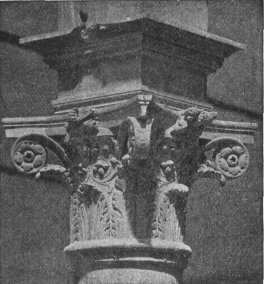
FIG. 158.—EARLY RENAISSANCE CAPITAL, PAL. ZORZI, VENICE.
CONSTRUCTION AND DETAIL. The architects of the Renaissance
occupied themselves more with form than with construction, and rarely
set themselves constructive problems of great difficulty. Although the
new architecture began with the colossal dome of the cathedral of
Florence, and culminated in the stupendous church of St. Peter at Rome,
it was pre-eminently an architecture of palaces and villas, of façades
and of decorative display. Constructive difficulties were reduced to
their lowest terms, and the constructive framework was concealed, not
emphasized, by the decorative apparel of the design. Among the
masterpieces of the early Renaissance are many buildings of small
dimensions, such as gates, chapels, tombs and fountains. In these the
individual fancy had full sway, and produced surprising results by the
beauty of enriched mouldings, of carved friezes with infant genii,
wreaths of fruit, griffins, masks and scrolls; by pilasters covered with
arabesques as delicate in modelling as if wrought in silver; by inlays
of marble, panels of glazed terra-cotta, marvellously carved doors, fine
stucco-work in relief, capitals and cornices of wonderful richness and
variety. The Roman orders appeared only in free imitations, with
panelled and carved pilasters for the most part instead of columns, and
capitals
275
of fanciful design, recalling remotely the Corinthian by their volutes
and leaves (Fig. 158). Instead of the low-pitched classic pediments,
there appears frequently an arched cornice enclosing a sculptured
lunette. Doors and windows were enclosed in richly carved frames,
sometimes arched and sometimes square. Façades were flat and unbroken,
depending mainly for effect upon the distribution and adornment of the
openings, and the design of doorways, courtyards and cornices.
Internally vaults and flat ceilings of wood and plaster were about
equally common, the barrel vault and dome occurring far more frequently
than the groined vault. Many of the ceilings of this period are of
remarkable richness and beauty.
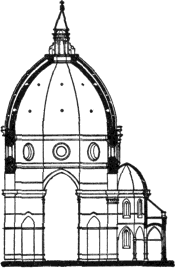
FIG. 159.—SECTION OF DOME OF DUOMO,
FLORENCE.
THE EARLY RENAISSANCE IN FLORENCE: THE DUOMO. In the year 1417
a public competition was held for completing the cathedral of Florence
by a dome over the immense octagon, 143 feet in diameter. Filippo
Brunelleschi, sculptor and architect (1377–1446), who with
Donatello had journeyed to Rome to study there the masterworks of
ancient art, after demonstrating the inadequacy of all the solutions
proposed by the competitors, was finally permitted to undertake the
gigantic task according to his own plans. These provided for an
octagonal dome in two shells, connected
276
by eight major and sixteen minor ribs, and crowned by a lantern at the
top (Fig. 159). This wholly original conception, by which for the first
time (outside of Moslem art) the dome was made an external feature fitly
terminating in the light forms and upward movement of a lantern, was
carried out between the years 1420 and 1464. Though in no wise an
imitation of Roman forms, it was classic in its spirit, in its vastness
and its simplicity of line, and was made possible solely by
Brunelleschi’s studies of Roman design and construction (Fig. 160).
OTHER CHURCHES. From Brunelleschi’s designs were also erected
the Pazzi Chapel in Sta. Croce, a charming design of a Greek
cross covered with a dome at the intersection, and preceded by a
vestibule with a richly decorated vault; and the two great churches of
S. Lorenzo (1425) and S. Spirito
(1433–1476, Fig. 161). Both reproduced in a measure the plan of
the Pisa Cathedral, having a three-aisled nave and transepts, with a low
dome over the crossing. The side aisles were covered with domical vaults
and the central aisles with flat wooden or plaster ceilings. All the
details of columns, arches and mouldings were imitated from Roman
models, and yet the result was something entirely new. Consciously or
unconsciously, Brunelleschi was reviving Byzantine rather than Roman
conceptions in the planning and structural design of these domical
churches, but the garb in which he clothed them was Roman, at least in
detail. The Old Sacristy of S. Lorenzo was another domical
design of great beauty.
277
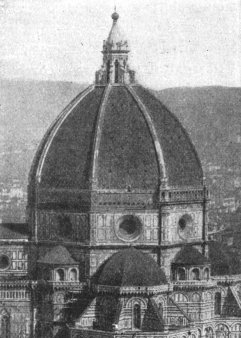
FIG. 160.—EXTERIOR OF DOME OF DUOMO,
FLORENCE.
From this time on the new style was in general use for church
designs. L. B. Alberti (1404–73), who had in Rome
mastered classic details more thoroughly than Brunelleschi, remodelled
the church of S. Francesco at Rimini with Roman
pilasters and arches, and with engaged orders in the façade, which,
however, was never completed. His great work was the church of
S. Andrea at Mantua, a Latin cross in plan, with
a dome at the intersection (the present high dome dating however, only
from the 18th century) and a façade to which the conception of a Roman
triumphal arch was skilfully adapted. His façade of incrusted marbles
for the church of S. M. Novella at Florence was a less successful
work, though its flaring consoles over the side aisles established an
unfortunate precedent frequently imitated in later churches.
A great activity in church-building marked the period between 1475
and 1490. The plans of the churches erected about this time throughout
north Italy display an interesting variety of arrangements, in nearly
all of which the dome is combined with the three-aisled cruciform plan,
either as a central feature at the crossing or as a domical vault over
each bay. Bologna and Ferrara possess a number of churches of this kind.
Occasionally the basilican arrangement was followed, with columnar
arcades separating
278
the aisles. More often, however, the pier-arches were of the Roman type,
with engaged columns or pilasters between them. The interiors,
presumably intended to receive painted decorations, were in most cases
somewhat bare of ornament, pleasing rather by happy proportions and
effective vaulting or rich flat ceilings, panelled, painted and gilded,
than by elaborate architectural detail. A similar scantiness of
ornament is to be remarked in the exteriors, excepting the façades,
which were sometimes highly ornate; the doorways, with columns,
pediments, sculpture and carving, receiving especial attention. High
external domes did not come into general use until the next period. In
Milan, Pavia, and some other Lombard cities, the internal cupola over
the crossing was, however, covered externally by a lofty structure in
diminishing stages, like that of the Certosa at Pavia (Fig. 152), or
that erected by Bramante for the church of S. M. delle Grazie at
Milan. At Prato, in the church of the Madonna delle Carceri
(1495–1516), by Giuliano da S. Gallo, the type of the
Pazzi chapel reappears in a larger scale; the plan is cruciform, with
equal or nearly equal arms covered by barrel vaults, at whose
intersection rises a dome of
279
moderate height on pendentives. This charming edifice, with its
unfinished exterior of white marble, its simple and dignified lines, and
internal embellishments in della-Robbia ware, is one of the masterpieces
of the period.
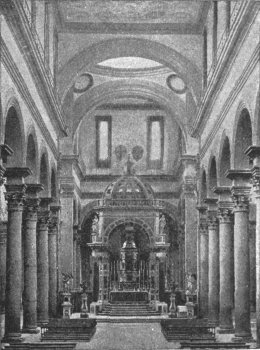
FIG. 161.—INTERIOR OF S. SPIRITO, FLORENCE.
In the designing of chapels and oratories the architects of the early
Renaissance attained conspicuous success, these edifices presenting
fewer structural limitations and being more purely decorative in
character than the larger churches. Such façades as that of
S. Bernardino at Perugia and of the Frati di
S. Spirito at Bologna are among the most delightful products of
the decorative fancy of the 15th century.
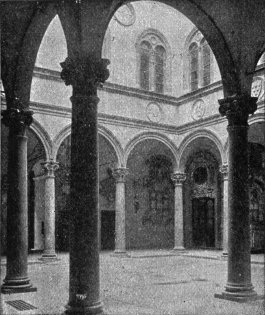
FIG. 162.—COURTYARD OF RICCARDI PALACE, FLORENCE.
FLORENTINE PALACES. While the architects of this period failed
to develop any new and thoroughly satisfactory ecclesiastical type, they
attained conspicuous success in palace-architecture. The Riccardi
palace in Florence (1430) marks the first step of the Renaissance in
this direction. It was built for the great Cosimo di Medici by
Michelozzi (1397–1473), a contemporary of Brunelleschi
and Alberti, and a man of great talent. Its imposing rectangular façade,
with widely spaced mullioned windows in two stories over a massive
basement, is crowned with a classic cornice of unusual and perhaps
excessive size. In
280
spite of the bold and fortress-like character of the rusticated masonry
of these façades, and the mediæval look they seem to present to modern
eyes, they marked a revolution in style and established a type
frequently imitated in later years. The courtyard, in contrast with this
stern exterior, appears light and cheerful (Fig. 162). Its wall is
carried on round arches borne by columns with Corinthianesque capitals,
and the arcade is enriched with sculptured medallions. The Pitti
Palace, by Brunelleschi (1435), embodies the same ideas on a more
colossal scale, but lacks the grace of an adequate cornice.
A lighter and more ornate style appeared in 1460 in the
P. Rucellai, by Alberti, in which for the first time
classical pilasters in superposed stages were applied to a street
façade. To avoid the dilemma of either insufficiently crowning the
edifice or making the cornice too heavy for the upper range of
pilasters, Alberti made use of brackets, occupying the width of the
upper frieze, and converting the whole upper entablature into a cornice.
But this compromise was not quite successful, and it remained for later
architects in Venice, Verona, and Rome to work out more satisfactory
methods of applying the orders to many-storied palace façades. In the
great P. Strozzi (Fig. 163), erected in 1490 by Benedetto
da Majano and Cronaca, the architects reverted to the earlier
type of the P. Riccardi, treating it with greater refinement and
producing one of the noblest palaces of Italy.
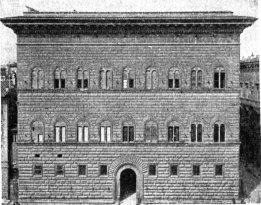
FIG. 163.—FAÇADE OF STROZZI PALACE, FLORENCE.
281
COURTYARDS; ARCADES. These palaces were all built around
interior courts, whose walls rested on columnar arcades, as in the
P. Riccardi (Fig. 162). The origin of these arcades may be found in
the arcaded cloisters of mediæval monastic churches, which often suggest
classic models, as in those of St. Paul-beyond-the-Walls and St. John
Lateran at Rome. Brunelleschi not only introduced columnar arcades into
a number of cloisters and palace courts, but also used them effectively
as exterior features in the Loggia S. Paolo and the
Foundling Hospital (Ospedale degli Innocenti) at Florence. The
chief drawback in these light arcades was their inability to withstand
the thrust of the vaulting over the space behind them, and the
consequent recourse to iron tie-rods where vaulting was used. The
Italians, however, seemed to care little about this disfigurement.
MINOR WORKS. The details of the new style were developed quite
as rapidly in purely decorative works as in monumental buildings.
Altars, mural monuments, tabernacles, pulpits and ciboria
afforded scope for the genius of the most distinguished artists. Among
those who were specially celebrated in works of this kind should be
named Lucca della Robbia (1400–82) and his successors,
Mino da Fiesole (1431–84) and Benedetto da Majano
(1442–97). Possessed of a wonderful fertility of invention, they
and their pupils multiplied their works in extraordinary number and
variety, not only throughout north Italy, but also in Rome and Naples.
Among the most famous examples of this branch of design may be mentioned
a pulpit in Sta. Croce by B. da Majano; a terra-cotta fountain
in the sacristy of S. M. Novella, by the della Robbias; the
Marsupini tomb in Sta. Croce, by Desiderio da Settignano (all in
Florence); the della Rovere tomb in S. M. del Popolo, Rome, by Mino
da Fiesole, and in the Cathedral at Lucca the Noceto tomb and the
Tempietto, by Matteo Civitali. It was in
282
works of this character that the Renaissance oftenest made its first
appearance in a new centre, as was the case in Sienna, Pisa, Lucca,
Naples, etc.
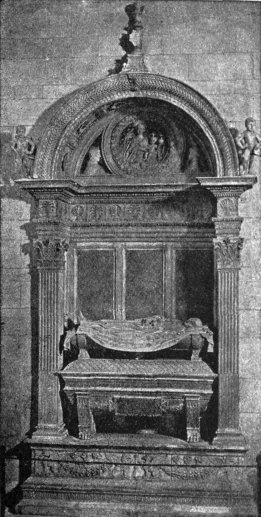
FIG. 164.—TOMB OF PIETRO DI NOCETO, LUCCA.
NORTH ITALY. Between 1450 and 1490 the Renaissance presented
in Sienna, in a number of important palaces, a sharp contrast to
the prevalent Gothic style of that city. The
P. Piccolomini—a somewhat crude imitation of the
P. Riccardi in Florence—dates from 1463; the P. del
Governo was built 1469, and the Spannocchi Palace in 1470. In
1463 Ant. Federighi built there the Loggia del Papa. About
the same time Bernardo di Lorenzo was building for Pope Pius II.
(Æneas Sylvius Piccolomini) an entirely new city, Pienza, with a
cathedral, archbishop’s palace, town hall and Papal residence (the
P. Piccolomini), which are interesting if not strikingly
original works. Pisa possesses few early Renaissance structures, owing
to the utter prostration of her fortunes
283
in the 15th century, and the dominance of Pisan Gothic traditions. In
Lucca, besides a wealth of minor monuments (largely the work of Matteo
Civitali, 1435–1501) in various churches, a number of palaces
date from this period, the most important being the
P. Pretorio and P. Bernardini. To Milan the Renaissance
was carried by the Florentine masters Michelozzi and
Filarete, to whom are respectively due the Portinari
Chapel in S. Eustorgio (1462) and the earlier part of the great
Ospedale Maggiore (1457). In the latter, an edifice of brick with
terra-cotta enrichments, the windows were Gothic in outline—an
unusual mixture of styles, even in Italy. The munificence of the
Sforzas, the hereditary tyrants of the province, embellished the
semi-Gothic Certosa of Pavia with a new marble façade, begun 1476
or 1491, which in its fanciful and exuberant decoration, and the small
scale of its parts, belongs properly to the early Renaissance.
Exquisitely beautiful in detail, it resembles rather a magnified
altar-piece than a work of architecture, properly speaking. Bologna and
Ferrara developed somewhat late in the century a strong local school of
architecture, remarkable especially for the beauty of its courtyards,
its graceful street arcades, and its artistic treatment of brick and
terra-cotta (P. Bevilacqua, P. Fava, at Bologna;
P. Scrofa, P. Roverella, at Ferrara). About the
same time palaces with interior arcades and details in the new style
were erected in Verona, Vicenza, Mantua, and other cities.
VENICE. In this city of merchant princes and a wealthy
bourgeoisie, the architecture of the Renaissance took on a new
aspect of splendor and display. It was late in appearing, the Gothic
style with its tinge of Byzantine decorative traditions having here
developed into a style well suited to the needs of a rich and relatively
tranquil community. These traditions the architects of the new style
appropriated in a measure, as in the marble incrustations of the
exquisite little church of S. M. dei Miracoli
(1480–89), and the façade
284
of the Scuola di S. Marco (1485–1533), both by
Pietro Lombardo. Nowhere else, unless on the contemporary façade
of the Certosa at Pavia, were marble inlays and delicate carving,
combined with a framework of thin pilasters, finely profiled
entablatures and arched pediments, so lavishly bestowed upon the street
fronts of churches and palaces. The family of the Lombardi
(Martino, his sons Moro and Pietro, and grandsons Antonio and Tullio),
with Ant. Bregno and Bart. Buon, were the leaders in the
architectural Renaissance of this period, and to them Venice owes her
choicest masterpieces in the new style. Its first appearance is noted in
the later portions of the church of S. Zaccaria
(1456–1515), partly Gothic internally, with a façade whose
semicircular pediment and small decorative arcades show a somewhat timid
but interesting application of classic details. In this church, and
still more so in S. Giobbe (1451–93) and the Miracoli above
mentioned, the decorative element predominates throughout. It is hard to
imagine details more graceful in design, more effective in the swing of
their movement, or more delicate in execution than the mouldings,
reliefs, wreaths, scrolls, and capitals one encounters in these
buildings. Yet in structural interest, in scale and breadth of planning,
these early Renaissance Venetian buildings hold a relatively inferior
rank.
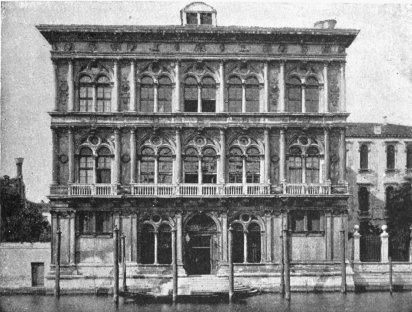
FIG. 165.—VENDRAMINI PALACE, VENICE.
PALACES. The great Court of the Doge’s Palace,
begun 1483 by Ant. Rizzio, belongs only in part to the first
period. It shows, however, the lack of constructive principle and of
largeness of composition just mentioned, but its decorative effect and
picturesque variety elicit almost universal admiration. Like the
neighboring façade of St. Mark’s, it violates nearly every principle of
correct composition, and yet in a measure atones for this capital defect
by its charm of detail. Far more satisfactory from the purely
architectural point of view is the façade of the
P. Vendramini (Vendramin-Calergi), by Pietro Lombardo
(1481). The simple,
285
stately lines of its composition, the dignity of its broad arched and
mullioned windows, separated by engaged columns—the earliest
example in Venice of this feature, and one of the earliest in
Italy—its well-proportioned basement and upper stories, crowned by
an adequate but somewhat heavy entablature, make this one of the finest
palaces in Italy (Fig. 165) It established a type of large-windowed,
vigorously modelled façades which later architects developed, but hardly
surpassed. In the smaller contemporary, P. Dario, another type
appears, better suited for small buildings, depending for effect mainly
upon well-ordered openings and incrusted panelling of colored
marble.
ROME. Internal disorders and the long exile of the popes had
by the end of the fourteenth century reduced Rome to utter
insignificance. Not until the second half of the fifteenth century did
returning prosperity and wealth afford
286
the Renaissance its opportunity in the Eternal City. Pope
Nicholas V. had, indeed, begun the rebuilding of St. Peter’s from
designs by B. Rossellini, in 1450, but the project lapsed shortly
after with the death of the pope. The earliest Renaissance building in
Rome was the P. di Venezia, begun in 1455, together with the
adjoining porch of S. Marco. In this palace and the adjoining
unfinished Palazzetto we find the influence of the old Roman monuments
clearly manifested in the court arcades, built like those of the
Colosseum, with superposed stages of massive piers and engaged columns
carrying entablatures. The proportions are awkward, the details coarse;
but the spirit of Roman classicism is here seen in the germ. The
exterior of this palace is, however, still Gothic in spirit. The
architects are unknown; Giuliano da Majano (1452–90),
Giacomo di Pietrasanta, and Meo del Caprino
(1430–1501) are known to have worked upon it, but it is not
certain in what capacity.
The new style, reaching, and in time overcoming, the conservatism of
the Church, overthrew the old basilican traditions. In
S. Agostino (1479–83), by Pietrasanta, and
S. M. del Popolo, by Pintelli (?), piers with pilasters or
half-columns and massive arches separate the aisles, and the crossing is
crowned with a dome. To the same period belong the Sistine chapel and
parts of the Vatican palace, but the interest of these lies rather in
their later decorations than in their somewhat scanty architectural
merit.
The architectural renewal of Rome, thus begun, reached its
culmination in the following period.
OTHER MONUMENTS. The complete enumeration of even the most
important Early Renaissance monuments of Italy is impossible within our
limits. Two or three only can here be singled out as suggesting types.
Among town halls of this period the first place belongs to the
P. del Consiglio at Verona, by Fra Giocondo
(1435–1515). In this beautiful edifice the façade consists of a
light and graceful
287
arcade supporting a wall pierced with four windows, and covered with
elaborate frescoed arabesques (recently restored). Its unfortunate
division by pilasters into four bays, with a pier in the centre, is a
blemish avoided in the contemporary P. del Consiglio at
Padua. The Ducal Palace at Urbino, by Luciano da Laurano
(1468), is noteworthy for its fine arcaded court, and was highly famed
in its day. At Brescia S. M. dei Miracoli is a remarkable
example of a cruciform domical church dating from the close of this
period, and is especially celebrated for the exuberant decoration of its
porch and its elaborate detail. Few campaniles were built in this
period; the best of them are at Venice. Naples possesses several
interesting Early Renaissance monuments, chief among which are the
Porta Capuana (1484), by Giul. da Majano, the triumphal
Arch of Alphonso of Arragon, by Pietro di Martino, and the
P. Gravina, by Gab. d’Agnolo. Naples is also very
rich in minor works of the early Renaissance, in which it ranks with
Florence, Venice, and Rome.
288
RENAISSANCE ARCHITECTURE IN ITALY—Continued.
THE ADVANCED RENAISSANCE AND DECLINE.
Books Recommended: As before,
Burckhardt, Cicognara, Fergusson, Palustre. Also, Gauthier, Les plus
beaux edifices de Gênes. Geymüller, Les projets primitifs pour la
basilique de St. Pierre de Rome. Gurlitt, Geschichte des
Barockstiles in Italien. Letarouilly, Édifices de Rome
Moderne; Le Vatican. Palladio, The Works of
A. Palladio.
CHARACTER OF THE ADVANCED RENAISSANCE. It was inevitable that
the study and imitation of Roman architecture should lead to an
increasingly literal rendering of classic details and a closer copying
of antique compositions. Toward the close of the fifteenth century the
symptoms began to multiply of the approaching reign of formal
classicism. Correctness in the reproduction of old Roman forms came in
time to be esteemed as one of the chief of architectural virtues, and in
the following period the orders became the principal resource of the
architect. During the so-called Cinquecento, that is, from the close of
the fifteenth century to nearly or quite 1550, architecture still
retained much of the freedom and refinement of the Quattrocento. There
was meanwhile a notable advance in dignity and amplitude of design,
especially in the internal distribution of buildings. Externally the
orders were freely used as subordinate features in the decoration of
doors and windows, and in court arcades of the Roman type. The
lantern-crowned
289
dome upon a high drum was developed into one of the noblest of
architectural forms. Great attention was bestowed upon all subordinate
features; doors and windows were treated with frames and pediments of
extreme elegance and refinement; all the cornices and mouldings were
proportioned and profiled with the utmost care, and the balustrade was
elaborated into a feature at once useful and highly ornate. Interior
decoration was even more splendid than before, if somewhat less delicate
and subtle; relief enrichments in stucco were used with admirable
effect, and the greatest artists exercised their talents in the painting
of vaults and ceilings, as in P. del Té at Mantua, by Giulio
Romano (1492–1546), and the Sistine Chapel at Rome, by Michael
Angelo. This period is distinguished by an exceptional number of great
architects and buildings. It was ushered in by Bramante Lazzari,
of Urbino (1444–1514), and closed during the career of Michael
Angelo Buonarotti (1475–1564); two names worthy to rank with
that of Brunelleschi. Inferior only to these in architectural genius
were Raphael (1483–1520), Baldassare Peruzzi
(1481–1536), Antonio da San Gallo the Younger
(1485–1546), and G. Barozzi da Vignola
(1507–1572), in Rome; Giacopo Tatti Sansovino
(1479–1570), in Venice, and others almost equally illustrious.
This period witnessed the erection of an extraordinary series of
palaces, villas, and churches, the beginning and much of the
construction of St. Peter’s at Rome, and a complete transformation in
the aspect of that city.
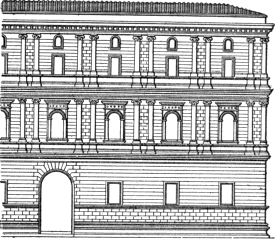
FIG. 166.—FAÇADE OF THE GIRAUD PALACE, ROME.
BRAMANTE’S WORKS. While precise time limits cannot be set to
architectural styles, it is not irrational to date this period from the
maturing of Bramante’s genius. While his earlier works in Milan belong
to the Quattrocento (S. M. delle Grazie, the sacristy of San
Satiro, the extension of the Great Hospital), his later designs show the
classic tendency very clearly. The charming Tempietto in the
court of
290
S. Pietro in Montorio at Rome, a circular temple-like chapel
(1502), is composed of purely classic elements. In the
P. Giraud (Fig. 166) and the great Cancelleria
Palace, pilasters appear in the external composition, and all the
details of doors and windows betray the results of classic study, as
well as the refined taste of their designer.24 The beautiful courtyard of
the Cancelleria combines the Florentine system of arches on columns with
the Roman system of superposed arcades independent of the court wall. In
1506 Bramante began the rebuilding of St. Peter’s for Julius II. (see p. 294) and the construction of a new and
imposing papal palace adjoining it on the Vatican hill. Of this colossal
group of edifices, commonly known as the Vatican, he executed the
greater Belvedere court (afterward divided in two by the Library and the
Braccio Nuovo), the lesser octagonal court of the Belvedere, and the
court of San Damaso, with its arcades afterward frescoed by Raphael and
his school. Besides these, the cloister of S. M. della Pace, and
many other works in and out of Rome, reveal the impress of Bramante’s
genius, alike in their admirable plans and in the harmony and beauty of
their details.
FLORENTINE PALACES. The P. Riccardi long remained the accepted
type of palace in Florence. As we have seen, it was imitated in the
Strozzi palace, as late as 1489, with
291
greater perfection of detail, but with no radical change of conception.
In the P. Gondi, however, begun in the following year by
Giuliano da San Gallo (1445–1516), a more pronounced
classic spirit appears, especially in the court and the interior design.
Early in the 16th century classic columns and pediments began to be used
as decorations for doors and windows; the rustication was confined to
basements and corner-quoins, and niches, loggias, and porches gave
variety of light and shade to the façades (P. Bartolini, by
Baccio d’Agnolo; P. Larderel, 1515, by Dosio;
P. Guadagni, by Cronaca; P. Pandolfini,
1518, attributed to Raphael). In the P. Serristori, by
Baccio d’Agnolo (1510), pilasters were applied to the composition of the
façade, but this example was not often followed in Florence.
ROMAN PALACES. These followed a different type. They were
usually of great size, and built around ample courts with arcades of
classic model in two or three stories. The broad street façade in three
stories with an attic or mezzanine was crowned with a rich cornice. The
orders were sparingly used externally, and effect was sought principally
in the careful proportioning of the stories, in the form and
distribution of the square-headed and arched openings, and in the design
of mouldings, string-courses, cornices, and other details. The piano
nobile, or first story above the basement, was given up to suites of
sumptuous reception-rooms and halls, with magnificent ceilings and
frescoes by the great painters of the day, while antique statues and
reliefs adorned the courts, vestibules, and niches of these princely
dwellings. The Massimi palace, by Peruzzi, is an interesting
example of this type. The Vatican, Cancelleria, and Giraud palaces have
already been mentioned; other notable palaces are the Palma (1506) and
Sacchetti (1540), by A. da San Gallo the Younger; the
Farnesina, by Peruzzi, with celebrated fresco decorations
designed by Raphael;
292
and the Lante (1520) and Altemps (1530), by Peruzzi. But the noblest
creation of this period was the
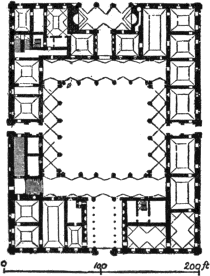
FIG. 167.—PLAN OF FARNESE PALACE.
Larger View
FARNESE PALACE, by many esteemed the finest in Italy. It was
begun in 1530 for Alex. Farnese (Paul III.) by A. da San Gallo the
Younger, with Vignola’s collaboration. The simple but admirable plan is
shown in Fig. 167, and the courtyard, the most imposing in Italy, in
Fig. 168. The exterior is monotonous, but the noble cornice by Michael
Angelo measurably redeems this defect. The fine vaulted columnar
entrance vestibule, the court and the salons, make up an
ensemble worthy of the great architects who designed it. The
loggia toward the river was added by G. della Porta in
1580.
VILLAS. The Italian villa of this pleasure-loving period
afforded full scope for the most playful fancies of the architect,
decorator, and landscape gardener. It comprised usually a dwelling,
a casino or amusement-house, and many minor edifices,
summer-houses, arcades, etc., disposed in extensive grounds laid out
with terraces, cascades, and shaded alleys. The style was graceful,
sometimes trivial, but almost always pleasing, making free use of stucco
enrichments, both internally and externally, with abundance of gilding
and frescoing. The Villa Madama (1516), by Raphael, with
stucco-decorations by Giulio Romano, though incomplete and now
dilapidated, is a noted example of the style. More complete, the
Villa of Pope Julius, by Vignola (1550), belongs by its purity of
style to this period; its façade well exemplifies the simplicity,
293
dignity, and fine proportions of this master’s work. In addition to
these Roman villas may be mentioned the V. Medici (1540, by
Annibale Lippi; now the French Academy of Rome); the Casino
del Papa in the Vatican Gardens, by Pirro Ligorio (1560); the
V. Lante, near Viterbo, and the V. d’Este, at Tivoli, as
displaying among almost countless others the Italian skill in combining
architecture and gardening.
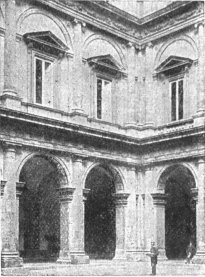
FIG. 168.—ANGLE OF COURT OF FARNESE
PALACE, ROME.
CHURCHES AND CHAPELS. This period witnessed the building of a
few churches of the first rank, but it was especially prolific in
memorial, votive, and sepulchral chapels added to churches already
existing, like the Chigi Chapel of S. M. del Popolo, by
Raphael. The earlier churches of this period generally followed
antecedent types, with the dome as the central feature dominating a
cruciform plan, and simple, unostentatious and sometimes uninteresting
exteriors. Among them may be mentioned: at Pistoia, S. M. del Letto
and S. M. dell’ Umiltà, the latter a fine domical rotunda by
Ventura Vitoni (1509), with an imposing vestibule; at Venice,
S. Salvatore, by Tullio Lombardo (1530), an admirable
edifice with alternating domical and barrel-vaulted bays;
S. Georgio dei Grechi (1536), by Sansovino, and
S. M. Formosa; at Todi, the Madonna della Consolazione
(1510), by Cola da Caprarola, a charming design with a high
dome and four apses; at Montefiascone, the Madonna delle Grazie,
by Sammichele (1523), besides several churches at Bologna,
Ferrara, Prato, Sienna, and Rome of almost or quite equal
294
interest. In these churches one may trace the development of the dome as
an external feature, while in S. Biagio, at Montepulciano,
the effort was made by Ant. da San Gallo the Elder to combine
with it the contrasting lines of two campaniles, of which, however, but
one was completed.
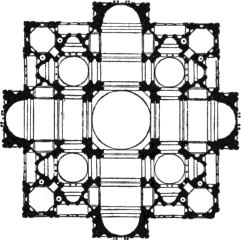
FIG. 169.—ORIGINAL PLAN OF ST. PETER’S, ROME.
ST. PETER’S. The culmination of Renaissance church
architecture was reached in St. Peter’s, at Rome. The original
project of Nicholas V. having lapsed with his death, it was the
intention of Julius II. to erect on the same site a stupendous mausoleum
over the monument he had ordered of Michael Angelo. The design of
Bramante, who began its erection in 1506, comprised a Greek cross with
apsidal arms, the four angles occupied by domical chapels and loggias
within a square outline (Fig. 169). The too hasty execution of this
noble design led to the collapse of two of the arches under the dome,
and to long delays after Bramante’s death in 1514. Raphael, Giuliano da
San Gallo, Peruzzi, and A. da San Gallo the Younger successively
supervised the works under the popes from Leo X. to Paul III., and
devised a vast number of plans for its completion. Most of these
involved fundamental alterations of the original scheme, and were
motived by the abandonment of the proposed monument of Julius II.;
a church, and not a mausoleum, being in consequence required. In
1546 Michael Angelo was assigned by Paul III. to the works, and gave
final form to the general design in a simplified
295
version of Bramante’s plan with more massive supports, a square
east front with a portico for the chief entrance, and the unrivalled
Dome, which is its most striking feature. This dome, slightly
altered and improved in curvature by della Porta after M. Angelo’s
death in 1564, was completed by D. Fontana in 1604. It is
the most majestic creation of the Renaissance, and one of the greatest
architectural conceptions of all history. It measures 140 feet in
internal diameter, and with its two shells rises from a lofty drum,
buttressed by coupled Corinthian columns, to a height of 405 feet to the
top of the lantern. The church, as left by Michael Angelo, was
harmonious in its proportions, though the single order used internally
and externally dwarfed by its colossal scale the vast dimensions of the
edifice. Unfortunately in 1606 C. Maderna was employed by
Paul V. to lengthen the nave by two bays, destroying the
proportions of the whole, and hiding the dome from view on a near
approach. The present tasteless façade was Maderna’s work. The splendid
atrium or portico added (1629–67), by Bernini, as an
approach, mitigates but does not cure the ugliness and pettiness of this
front.
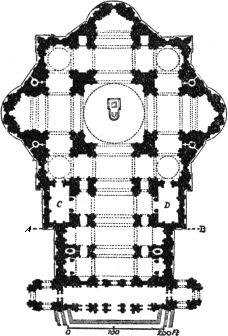
FIG. 170.—PLAN OF ST. PETER’S, ROME, AS NOW STANDING.
The portion below the line A, B, and the side chapels
C, D, were added by Maderna. The remainder represents
Michael Angelo’s plan.
St. Peter’s as thus completed (Fig. 170) is the largest
296
church in existence, and in many respects is architecturally worthy of
its pre-eminence. The central aisle, nearly 600 feet long, with its
stupendous panelled and gilded vault, 83 feet in span, the vast central
area and the majestic dome, belong to a conception unsurpassed in
majestic simplicity and effectiveness. The construction is almost
excessively massive, but admirably disposed. On the other hand the nave
is too long, and the details not only lack originality and interest, but
are also too large and coarse in scale, dwarfing the whole edifice. The
interior (Fig. 171) is wanting in the sobriety of color that befits so
stately a design; it suggests rather a pagan temple than a Christian
basilica. These faults reveal the decline of taste which had already set
in before Michael Angelo took charge of the work, and which appears even
in the works of that master.
THE PERIOD OF FORMAL CLASSICISM. With the middle of the 16th
century the classic orders began to dominate all architectural design.
While Vignola, who wrote a treatise upon the orders, employed them with
unfailing refinement and judgment, his contemporaries showed less
discernment and taste, making of them an end rather than a means. Too
often mere classical correctness was substituted for the fundamental
qualities of original invention and intrinsic beauty of composition. The
innovation of colossal orders extending through several stories, while
it gave to exterior designs a certain grandeur of scale, tended to
coarseness and even vulgarity of detail. Sculpture and ornament began to
lose their refinement; and while street-architecture gained in
monumental scale, and public squares received a more stately adornment
than ever before, the street-façades individually were too often bare
and uninteresting in their correct formality. In the interiors of
churches and large halls there appears a struggle between a cold and
dignified simplicity and a growing tendency toward pretentious sham. But
these pernicious tendencies did
299
not fully mature till the latter part of the century, and the
half-century after 1540 or 1550 was prolific of notable works in both
ecclesiastical and secular architecture. The names of Michael Angelo and
Vignola, whose careers began in the preceding period; of Palladio and
della Porta (1541–1604) in Rome; of Sammichele and Sansovino in
Verona and Venice, and of Galeazzo Alessi in Genoa, stand high in the
ranks of architectural merit.
[297]
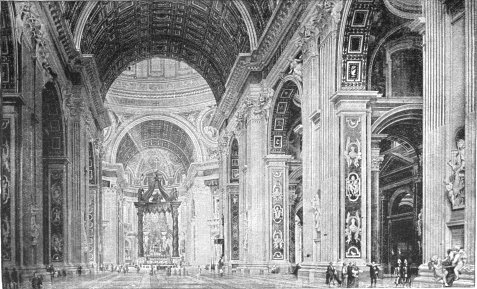
FIG. 171.—INTERIOR OF ST. PETER’S, ROME.
CHURCHES. The type established by St. Peter’s was widely
imitated throughout Italy. The churches in which a Greek or Latin cross
is dominated by a high dome rising from a drum and terminating in a
lantern, and is treated both internally and externally with Roman
Corinthian pilasters and arches, are almost numberless. Among the best
churches of this type is the Gesù at Rome, by Vignola (1568),
with a highly ornate interior of excellent proportions and a less
interesting exterior, the façade adorned with two stories of orders and
great flanking volutes over the sides (see p. 277). Two churches at Venice, by
Palladio—S. Giorgio Maggiore (1560; façade by
Scamozzi, 1575) and the Redentore—offer a strong
contrast to the Gesù, in their cold and almost bare but pure and correct
design. An imitation of Bramante’s plan for St. Peter’s appears in
S. M. di Carignano, at Genoa, by Galeazzo Alessi
(1500–72), begun 1552, a fine structure, though inferior in
scale and detail to its original. Besides these and other important
churches there were many large domical chapels of great splendor added
to earlier churches; of these the Chapel of Sixtus V. in
S. M. Maggiore, at Rome, by D. Fontana
(1543–1607), is an excellent example.
PALACES: ROME. The palaces on the Capitoline Hill, built at
different dates (1540–1644) from designs by Michael Angelo,
illustrate the palace architecture of this period, and the imposing
effect of a single colossal order running through two stories. This
treatment, though well adapted
300
to produce monumental effects in large squares, was dangerous in its
bareness and heaviness of scale, and was better suited for buildings of
vast dimensions than for ordinary street-façades. In other Roman palaces
of this time the traditions of the preceding period still prevailed, as
in the Sapienza (University), by della Porta (1575), which has a
dignified court and a façade of great refinement without columns or
pilasters. The Papal palaces built by Domenico Fontana on the
Lateran, Quirinal, and Vatican hills, between 1574 and 1590, externally
copying the style of the Farnese, show a similar return to earlier
models, but are less pure and refined in detail than the Sapienza. The
great pentagonal Palace of Caprarola, near Rome, by Vignola, is
perhaps the most successful and imposing production of the Roman classic
school.
VERONA. Outside of Rome, palace-building took on various local
and provincial phases of style, of which the most important were the
closely related styles of Verona, Venice, and Vicenza. Michele
Sammichele (1484–1549), who built in Verona the
Bevilacqua, Canossa, Pompei, and Verzi
palaces and the four chief city gates, and in Venice the
P. Grimani, his masterpiece (1550), was a designer of great
originality and power. He introduced into his military architecture, as
in the gates of Verona, the use of rusticated orders, which he treated
with skill and taste. The idea was copied by later architects and
applied, with doubtful propriety, to palace-façades; though Ammanati’s
garden-façade for the Pitti palace, in Florence (cir. 1560), is an
impressive and successful design.
VENICE. Into the development of the maturing classic style
Giacopo Tatti Sansovino (1477–1570) introduced in his
Venetian buildings new elements of splendor. Coupled columns between
arches themselves supported on columns, and a profusion of figure
sculpture, gave to his palace-façades a hitherto unknown magnificence of
effect, as
301
in the Library of St. Mark (now the Royal Palace, Fig. 172), and
the Cornaro palace (P. Corner de Cà Grande), both dating
from about 1530–40. So strongly did he impress upon Venice these
ornate and sumptuous variations on classic themes, that later architects
adhered, in a very debased period, to the main features and spirit of
his work.
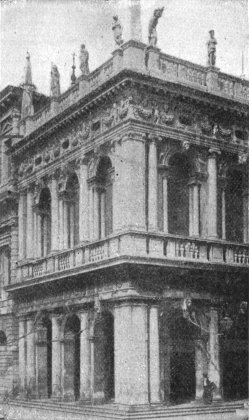
FIG. 172.—LIBRARY OF ST. MARK, VENICE.
VICENZA. Of Palladio’s churches in Venice we have
already spoken; his palaces are mainly to be found in his native city,
Vicenza. In these structures he displayed great fertility of invention
and a profound familiarity with the classic orders, but the degenerate
taste of the Baroque period already begins to show itself in his work.
There is far less of architectural propriety and grace in these
pretentious palaces, with their colossal orders and their affectation of
grandeur, than in the designs of Vignola or Sammichele. Wood and
plaster, used to mimic stone, indicate the approaching reign of sham in
all design (P. Barbarano, 1570; Chieregati, 1560;
Tiene, Valmarano, 1556; Villa Capra). His
masterpiece is the two-storied arcade about the mediæval
Basilica, in which the arches are supported on a minor order
between engaged columns serving
302
as buttresses. This treatment has in consequence ever since been known
as the Palladian Motive.
GENOA. During the second half of the sixteenth century a
remarkable series of palaces was erected in Genoa, especially notable
for their great courts and imposing staircases. These last were given
unusual prominence owing to differences of level in the courts, arising
from the slope of their sites on the hillside. Many of these palaces
were by Galeazzo Alessi (1502–72); others by architects of lesser
note; but nearly all characterized by their effective planning, fine
stairs and loggias, and strong and dignified, if sometimes
uninteresting, detail (P. Balbi, Brignole,
Cambiasi, Doria-Tursi [or Municipio], Durazzo [or
Reale], Pallavicini, and University).
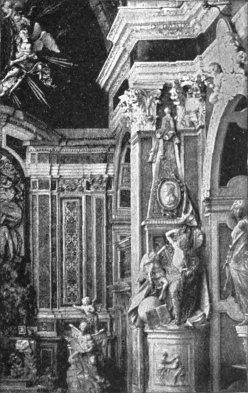
FIG. 173.—INTERIOR OF SAN SEVERO, NAPLES.
THE BAROQUE STYLE. A reaction from the cold classicismo
of the late sixteenth century showed itself in the following period, in
the lawless and vulgar extravagances of the so-called Baroque
style. The wealthy Jesuit order was a notorious contributor to the
debasement of architectural taste. Most of the Jesuit churches and many
others not belonging to the order, but following its pernicious example,
are monuments of bad taste and pretentious sham. Broken
303
and contorted pediments, huge scrolls, heavy mouldings, ill-applied
sculpture in exaggerated attitudes, and a general disregard for
architectural propriety characterized this period, especially in its
church architecture, to whose style the name Jesuit is often
applied. Sham marble and heavy and excessive gilding were universal
(Fig. 173). C. Maderna (1556–1629), Lorenzo
Bernini (1589–1680), and F. Borromini
(1599–1667) were the worst offenders of the period, though Bernini
was an artist of undoubted ability, as proved by his colonnades or
atrium in front of St. Peter’s. There were, however, architects of purer
taste whose works even in that debased age were worthy of
admiration.
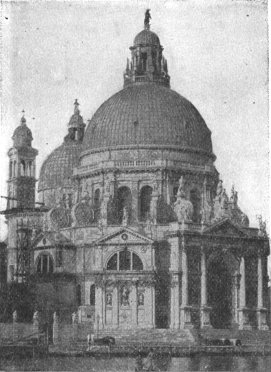
FIG. 174.—CHURCH OF S. M. DELLA SALUTE, VENICE.
BAROQUE CHURCHES. The Baroque style prevailed in church
architecture for almost two centuries. The majority of the churches
present varieties of the cruciform plan crowned by a high dome which is
usually the best part of the design. Everywhere else the vices of the
period appear in these churches, especially in their façades and
internal decoration. S. M. della Vittoria, by Maderna, and
Sta. Agnese, by Borromini, both at Rome, are examples of the
304
style. Naples is particularly full of Baroque churches (Fig. 173),
a few of which, like the Gesù Nuovo (1584), are dignified
and creditable designs. The domical church of S. M. della
Salute, at Venice (1631), by Longhena, is also a majestic edifice in
excellent style (Fig. 174), and here and there other churches offer
exceptions to the prevalent baseness of architecture. Particularly
objectionable was the wholesale disfigurement of existing monuments by
ruthless remodelling, as in S. John Lateran, at Rome, the
cathedrals of Ferrara and Ravenna, and many others.
PALACES. These were generally superior to the churches, and
not infrequently impressive and dignified structures. The two best
examples in Rome are the P. Borghese, by Martino Lunghi
the Elder (1590), with a fine court arcade on coupled Doric and
Ionic columns, and the P. Barberini, by Maderna and
Borromini, with an elliptical staircase by Bernini, one of the few
palaces in Italy with projecting lateral wings. In Venice, Longhena, in
the Rezzonico and Pesaro palaces (1650–80), showed
his freedom from the mannerisms of the age by reproducing successfully
the ornate but dignified style of Sansovino (see p. 301). At Naples D. Fontana, whose works
overlap the Baroque period, produced in the Royal Palace (1600)
and the Royal Museum (1586–1615) designs of considerable
dignity, in some respects superior to his papal residences in Rome. In
suburban villas, like the Albani and Borghese villas near
Rome, the ostentatious style of the Decline found free and congenial
expression.
LATER MONUMENTS. In the few eighteenth-century buildings which
are worthy of mention there is noticeable a reaction from the
extravagances of the seventeenth century, shown in the dignified
correctness of the exteriors and the somewhat frigid splendor of the
interiors. The most notable work of this period is the Royal
Palace at Caserta, by Van Vitelli (1752), an architect
of considerable taste and inventiveness, considering his time. This
great palace, 800
305
feet square, encloses four fine courts, and is especially remarkable for
the simple if monotonous dignity of the well proportioned exterior and
the effective planning of its three octagonal vestibules, its ornate
chapel and noble staircase. Staircases, indeed, were among the most
successful features of late Italian architecture, as in the Scala
Regia of the Vatican, and in the Corsini, Braschi, and Barberini
palaces at Rome, the Royal Palace at Naples, etc.
In church architecture the east front of S. John
Lateran in Rome, by Galilei (1734), and the whole
exterior of S. M. Maggiore, by Ferd. Fuga
(1743), are noteworthy designs: the former an especially powerful
conception, combining a colossal order with two smaller orders in
superposed loggie, but marred by the excessive scale of the
statues which crown it. The Fountain of Trevi, conceived
in much the same spirit (1735, by Niccola Salvi), is a striking
piece of decorative architecture. The Sacristy of St. Peter’s, by
Marchionne (1775), also deserves mention as a monumental and not
uninteresting work. In the early years of the present century the
Braccio Nuovo of the Vatican, by Stern, the imposing
church of S. Francesco di Paola at Naples, by
Bianchi, designed in partial imitation of the Pantheon, and the
great S. Carlo Theatre at Naples, show the same coldly
classical spirit, not wholly without merit, but lacking in true
originality and freedom of conception.
CAMPANILES. The campaniles of the Renaissance and
Decline deserve at least passing reference, though they are neither
numerous nor often of conspicuous interest. That of the
Campidoglio (Capitol) at Rome, by Martino Lunghi, is a good
example of the classical type. Venetia possesses a number of graceful
and lofty bell-towers, generally of brick with marble bell-stages, of
which the upper part of the Campanile of St. Mark and the
tower of S. Giorgio Maggiore are the finest examples.
The Decline attained what the early Renaissance aimed
306
at—the revival of Roman forms. But it was no longer a Renaissance;
it was a decrepit and unimaginative art, held in the fetters of a
servile imitation, copying the letter rather than the spirit of antique
design. It was the mistaken and abject worship of precedent which
started architecture upon its downward path and led to the atrocious
products of the seventeenth century.
MONUMENTS (mainly in addition to those mentioned in the text).
15th Century—Florence: Foundling Hospital (Innocenti), 1421; Old
Sacristy and Cloister S. Lorenzo; P. Quaratesi, 1440;
cloisters at Sta. Croce and Certosa, all by Brunelleschi; façade
S. M. Novella, by Alberti, 1456; Badia at Fiesole, from designs of
Brunelleschi, 1462; Court of P. Vecchio, by Michelozzi, 1464
(altered and enriched, 1565); P. Guadagni, by Cronaca, 1490; Hall
of 500 in P. Vecchio, by same, 1495.—Venice: S. Zaccaria, by Martino Lombardo,
1457–1515; S. Michele, by Moro Lombardo, 1466; S. M. del
Orto, 1473; S. Giovanni Crisostomo, by Moro Lombardo, atrium of
S. Giovanni Evangelista, Procurazie Vecchie, all 1481; Scuola di
S. Marco, by Martino Lombardo, 1490; P. Dario;
P. Corner-Spinelli.—Ferrara:
P. Schifanoja, 1469; P. Scrofa or Costabili, 1485; S. M.
in Vado, P. dei Diamanti, P. Bevilacqua, S. Francesco,
S. Benedetto, S. Cristoforo, all 1490–1500.—Milan: Ospedale Grande (or Maggiore), begun
1457 by Filarete, extended by Bramante, cir. 1480–90 (great court
by Richini, 17th century); S. M. delle Grazie, E. end,
Sacristy of S. Satiro, S. M. presso S. Celso, all by
Bramante, 1477–1499.—Rome:
S. Pietro in Montorio, 1472; S. M. del Popolo, 1475?; Sistine
Chapel of Vatican, 1475; S. Agostino, 1483.—Sienna: Loggia del Papa and P. Nerucci, 1460;
P. del Governo, 1469–1500; P. Spannocchi, 1470; Sta.
Catarina, 1490, by di Bastiano and Federighi, church later by Peruzzi;
Library in cathedral by L. Marina, 1497; Oratory of
S. Bernardino, by Turrapili, 1496.—Pienza: Cathedral, Bishop’s Palace (Vescovado),
P. Pubblico, all cir. 1460, by B. di Lorenzo (or Rosselini?).
Elsewhere (in chronological order):
Arch of Alphonso, Naples, 1443, by P. di Martino; Oratory
S. Bernardino, Perugia, by di Duccio, 1461; Church over Casa-Santa,
Loreto, 1465–1526; P. del Consiglio at Verona, by Fra
Giocondo, 1476; Capella Colleoni, Bergamo, 1476; S. M. in Organo,
Verona, 1481; Porta Capuana, Naples, by Giul. da Majano, 1484; Madonna
della Croce, Crema, by B. Battagli, 1490–1556; Madonna di
Campagna and S. Sisto, Piacenza, both 1492–1511;
P. Bevilacqua, Bologna, by Nardi, 1492 (?); P. Gravina,
Naples; P. Fava, Bologna; P. Pretorio, Lucca; S. M. dei
Miracoli Brescia; all at close of 15th century.
307
16th Century—Rome: P. Sora, 1501; S. M. della Pace and
cloister, 1504, both by Bramante (façade of church by P. da
Cortona, 17th century); S. M. di Loreto, 1507, by A. da San
Gallo the Elder; P. Vidoni, by Raphael; P. Lante, 1520; Vigna
Papa Giulio, 1534, by Peruzzi; P. dei Conservatori, 1540, and
P. del Senatore, 1563 (both on Capitol), by M. Angelo,
Vignola, and della Porta; Sistine Chapel in S. M. Maggiore, 1590;
S. Andrea della Valle, 1591, by Olivieri (façade, 1670, by
Rainaldi).—Florence: Medici
Chapel of S. Lorenzo, new sacristy of same, and Laurentian Library, all
by M. Angelo, 1529–40; Mercato Nuovo, 1547, by B. Tasso;
P. degli Uffizi, 1560–70, by Vasari; P. Giugni, 1560–8.—Venice: P. Camerlinghi, 1525, by Bergamasco;
S. Francesco della Vigna, by Sansovino, 1539, façade by Palladio,
1568; Zecca or Mint, 1536, and Loggetta of Campanile, 1540, by
Sansovino25, Procurazie Nuove, 1584, by Scamozzi.—Verona: Capella Pellegrini in S. Bernardino,
1514; City Gates, by Sammichele, 1530–40 (Porte Nuova, Stuppa,
S. Zeno, S. Giorgio).—Vicenza: P. Porto, 1552; Teatro Olimpico, 1580;
both by Palladio.—Genoa:
P. Andrea Doria, by Montorsoli, 1529; P. Ducale, by Pennone,
1550; P. Lercari, P. Spinola, P. Sauli, P. Marcello
Durazzo, all by Gal. Alessi, cir. 1550; Sta. Annunziata, 1587, by della
Porta; Loggia dei Banchi, end of 16th century.—Elsewhere (in chronological order).
P. Roverella, Ferrara, 1508; P. del Magnifico, Sienna, 1508,
by Cozzarelli; P. Communale, Brescia, 1508, by Formentone;
P. Albergati, Bologna, 1510; P. Ducale, Mantua, 1520–40;
P. Giustiniani, Padua, by Falconetto, 1524; Ospedale del Ceppo,
Pistoia, 1525; Madonna delle Grazie, Pistoia, by Vitoni, 1535;
P. Buoncampagni-Ludovisi, Bologna, 1545; Cathedral, Padua, 1550, by
Righetti and della Valle, after M. Angelo; P. Bernardini,
1560, and P. Ducale, 1578, at Lucca, both by Ammanati.
17th Century: Chapel of the Princes
in S. Lorenzo, Florence, 1604, by Nigetti; S. Pietro, Bologna,
1605; S. Andrea delle Fratte, Rome, 1612; Villa Borghese, Rome,
1616, by Vasanzio; P. Contarini delle Scrigni, Venice, by Scamozzi;
Badia at Florence, rebuilt 1625 by Segaloni; S. Ignazio, Rome,
1626–85; Museum of the Capitol, Rome, 1644–50; Church of Gli
Scalzi, Venice, 1649; P. Pesaro, Venice, by Longhena, 1650;
S. Moisé, Venice, 1668; Brera Palace, Milan; S. M. Zobenigo,
Venice, 1680; Dogana di Mare, Venice, 1686, by Benone; Santi Apostoli,
Rome.
18th and early 19th Century:
Gesuati, at Venice, 1715–30; S. Geremia, Venice, 1753, by
Corbellini; P. Braschi, Rome, by Morelli, 1790; Nuova Fabbrica,
Venice, 1810.
308
RENAISSANCE ARCHITECTURE IN FRANCE.
Books Recommended: As before,
Fergusson, Müntz, Palustre. Also Berty, La Renaissance monumentale en
France. Château, Histoire et caractères de l’architecture en
France. Daly, Motifs historiques d’architecture et de
sculpture. De Laborde, La Renaissance des arts à la cour de
France. Du Cerceau, Les plus excellents bastiments de France.
Lübke, Geschichte der Renaissance in Frankreich. Mathews, The
Renaissance under the Valois Kings. Palustre, La Renaissance en
France. Pattison, The Renaissance of the Fine Arts in France.
Rouyer et Darcel, L’Art architectural en France. Sauvageot,
Choix de palais, châteaux, hôtels, et maisons de France.
ORIGIN AND CHARACTER. The vitality and richness of the Gothic
style in France, even in its decline in the fifteenth century, long
stood in the way of any general introduction of classic forms. When the
Renaissance appeared, it came as a foreign importation, introduced from
Italy by the king and the nobility. It underwent a protracted
transitional phase, during which the national Gothic forms and
traditions were picturesquely mingled with those of the Renaissance. The
campaigns of Charles VIII. (1489), Louis XII. (1499), and
Francis I. (1515), in vindication of their claims to the thrones of
Naples and Milan, brought these monarchs and their nobles into contact
with the splendid material and artistic civilization of Italy, then in
the full tide of the maturing Renaissance. They returned to France,
filled with the ambition to rival the splendid palaces and gardens of
Italy, taking with them Italian artists to teach their arts to the
French. But while these Italians successfully
309
introduced many classic elements and details into French architecture,
they wholly failed to dominate the French master-masons and tailleurs
de pierre in matters of planning and general composition. The early
Renaissance architecture of France is consequently wholly unlike the
Italian, from which it derived only minor details and a certain
largeness and breadth of spirit.
PERIODS. The French Renaissance and its sequent developments
may be broadly divided into three periods, with subdivisions coinciding
more or less closely with various reigns, as follows:
I. The Valois Period, or Renaissance
proper, 1483–1589, subdivided into:
a. The Transition, comprising
the reigns of Charles VIII. and Louis XII. (1483–1515), and the
early years of that of Francis I.; characterized by a picturesque
mixture of classic details with Gothic conceptions.
b. The Style of Francis I.,
or Early Renaissance, from about 1520 to that king’s death in 1547;
distinguished by a remarkable variety and grace of composition and
beauty of detail.
c. The Advanced Renaissance,
comprising the reigns of Henry II. (1547), Francis II. (1559), Charles
IX. (1560), and Henry III. (1574–89); marked by the gradual
adoption of the classic orders and a decline in the delicacy and
richness of the ornament.
II. The Bourbon or Classic Period
(1589–1715):
a. Style of Henry IV.,
covering his reign and partly that of Louis XIII. (1610–45),
employing the orders and other classic forms with a somewhat heavy,
florid style of ornament.
b. Style of Louis XIV.,
beginning in the preceding reign and extending through that of Louis
XIV. (1645–1715); the great age of classic architecture in France,
corresponding to the Palladian in Italy.
310
III. The Decline or Rococo Period,
corresponding with the reign of Louis XV. (1715–74); marked by
pompous extravagance and capriciousness.
During this period a reaction set in toward a severer classicism,
leading to the styles of Louis XVI. and of the Empire, to be treated of
in a later chapter.
THE TRANSITION. As early as 1475 the new style made its
appearance in altars, tombs, and rood-screens wrought by French carvers
with the collaboration of Italian artificers. The tomb erected by
Charles of Anjou to his father in Le Mans cathedral (1475, by
Francesco Laurana), the chapel of St. Lazare in the cathedral of
Marseilles (1483), and the tomb of the children of Charles VIII. in
Tours cathedral (1506), by Michel Columbe, the greatest artist of
his time in France, are examples. The schools of Rouen and Tours were
especially prominent in works of this kind, marked by exuberant fancy
and great delicacy of execution. In church architecture Gothic
traditions were long dominant, in spite of the great numbers of Italian
prelates in France. It was in châteaux, palaces, and dwellings
that the new style achieved its most notable triumphs.
EARLY CHÂTEAUX. The castle of Charles VIII., at Amboise on the
Loire, shows little trace of Italian influence. It was under Louis XII.
that the transformation of French architecture really began. The
Château de Gaillon (of which unfortunately only fragments remain
in the École des Beaux-Arts at Paris), built for the Cardinal George of
Amboise, between 1497 and 1509, by Pierre Fain, was the
masterwork of the Rouen school. It presented a curious mixture of
styles, with its irregular plan, its moat, drawbridge, and round
corner-towers, its high roofs, turrets, and dormers, which gave it, in
spite of many Renaissance details, a mediæval picturesqueness. The
Château de Blois (the east and south wings of the present group),
begun for Louis XII. about 1500, was the first of a remarkable series
311
of royal palaces which are the glory of French architecture. It shows
the new influences in its horizontal lines and flat, unbroken façades of
brick and stone, rather than in its architectural details (Fig. 175).
The Ducal Palace at Nancy and the Hôtel de Ville at
Orléans, by Viart, show a similar commingling of the classic and
mediæval styles.
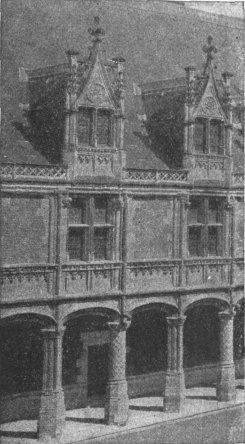
FIG. 175.—BLOIS, COURT FAÇADE OF WING OF
LOUIS XII.
STYLE OF FRANCIS I. Early in the reign of this monarch, and
partly under the lead of Italian artists, like il Rosso, Serlio, and
Primaticcio, classic elements began to dominate the general composition
and Gothic details rapidly disappeared. A simple and effective
system of exterior design was adopted in the castles and palaces of this
period. Finely moulded belt-courses at the sills and heads of the
windows marked the different stories, and were crossed by a system of
almost equally important vertical lines, formed by superposed pilasters
flanking the windows continuously from basement to roof. The façade was
crowned by a slight cornice and open balustrade, above which rose a
steep and lofty roof, diversified by elaborate dormer windows which were
312
adorned with gables and pinnacles (Fig. 178). Slender pilasters, treated like long
panels ornamented with arabesques of great beauty, or with a species of
baluster shaft like a candelabrum, were preferred to columns, and were
provided with graceful capitals of the Corinthianesque type. The
mouldings were minute and richly carved; pediments were replaced by
steep gables, and mullioned windows with stone crossbars were used in
preference to the simpler Italian openings. In the earlier monuments
Gothic details were still used occasionally; and round corner-towers,
high dormers, and numerous turrets and pinnacles appear even in the
châteaux of later date.
CHURCHES. Ecclesiastical architecture received but scant
attention under Francis I., and, so far as it was practised, still
clung tenaciously to Gothic principles. Among the few important churches
of this period may be mentioned St. Etienne du Mont, at Paris
(1517–38), in which classic and Gothic features appear in nearly
equal proportions; the east end of St. Pierre, at Caen, with rich
external carving; and the great parish church of St. Eustache, at
Paris (1532, by Lemercier), in which the plan and construction
are purely Gothic, while the details throughout belong to the new style,
though with little appreciation of the spirit and proportions of classic
art. New façades were also built for a number of already existing
churches, among which St. Michel, at Dijon, is conspicuous, with
its vast portal arch and imposing towers. The Gothic towers of Tours
cathedral were completed with Renaissance lanterns or belfries, the
northern in 1507, the southern in 1547.
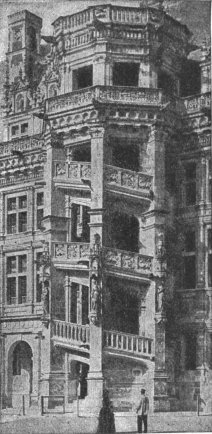
FIG. 176.—STAIRCASE TOWER, BLOIS.
PALACES. To the palace at Blois begun by his predecessor,
Francis I. added a northern and a western wing, completing the
court. The north wing is one of the masterpieces of the style,
presenting toward the court a simple and effective composition, with a
rich but slightly projecting cornice and a high roof with elaborate
dormers. This
313
façade is divided into two unequal sections by the open Staircase
Tower (Fig. 176), a chef-d’œuvre in boldness of
construction as well as in delicacy and richness of carving. The outer
façade of this wing is a less ornate but more vigorous design, crowned
by a continuous open loggia under the roof. More extensive than Blois
was Fontainebleau, the favorite residence of the king and of many
of his successors. Following in parts the irregular plan of the convent
it replaced, its other portions were more symmetrically disposed, while
the whole was treated externally in a somewhat severe, semi-classic
style, singularly lacking in ornament. Internally, however, this palace,
begun in 1528 by Gilles Le Breton, was at that time the most
splendid in France, the gallery of Francis I. being especially
noted. The Château of St. Germain, near Paris (1539, by
Pierre Chambiges), is of a very different character. Built
largely of brick, with flat balustraded roof and deep buttresses
carrying three ranges of arches, it is neither Gothic nor classic,
neither fortress nor palace in aspect, but a wholly unique
conception.
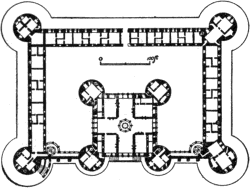
FIG. 177.—PLAN OF CHAMBORD.
The rural châteaux and hunting-lodges erected by Francis I.
display the greatest diversity of plan and treatment,
314
attesting the inventiveness of the French genius, expressing itself in a
new-found language, whose formal canons it disdained. Chief among them
is the Château of Chambord (Figs. 177, 178)—“a Fata Morgana
in the midst of a wild, woody thicket,” to use Lübke’s language. This
extraordinary edifice, resembling in plan a feudal castle with
curtain-walls, bastions, moat, and donjon, is in its architectural
treatment a palace with arcades, open-stair towers, a noble double
spiral staircase terminating in a graceful lantern, and a roof of the
most bewildering complexity of towers, chimneys, and dormers (1526, by
Pierre le Nepveu). The hunting-lodges of La Muette and Chalvau,
and the so-called Château de Madrid—all three demolished
during or since the Revolution—deserve mention, especially
315
the last. This consisted of two rectangular pavilions, connected by a
lofty banquet-hall, and adorned externally with arcades in Florentine
style, and with medallions and reliefs of della Robbia ware (1527, by
Gadyer).
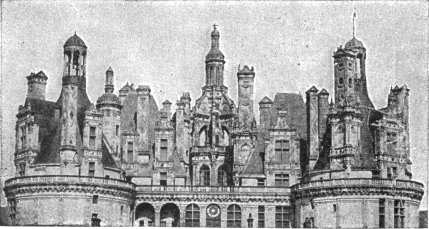
FIG. 178.—VIEW OF CHAMBORD.
THE LOUVRE. By far the most important of all the architectural
enterprises of this reign, in ultimate results, if not in original
extent, was the beginning of a new palace to replace the old Gothic
fortified palace of the Louvre. To this task Pierre Lescot was summoned
in 1542, and the work of erection actually begun in 1546. The new
palace, in a sumptuous and remarkably dignified classic style, was to
have covered precisely the area of the demolished fortress. Only the
southwest half, comprising two sides of the court, was, however,
undertaken at the outset (Fig. 179). It remained for later monarchs to
amplify the original scheme, and ultimately to complete, late in the
present century, the most extensive and beautiful of all the royal
residences of Europe. (See Figs. 181, 208, 209.)
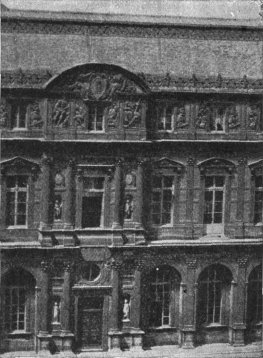
FIG. 179.—DETAIL OF COURT OF LOUVRE, PARIS.
Want of space forbids more than a passing reference to the rural
castles of the nobility, rivalling those of the king. Among them Bury,
La Rochefoucauld, Bournazel, and
316
especially Azay-le-Rideau (1520) and Chenonceaux
(1515–23), may be mentioned, all displaying that love of rural
pleasure, that hatred of the city and its confinement, which so
distinguish the French from the Italian Renaissance.
OTHER BUILDINGS. The Hôtel-de-Ville (town hall), of
Paris, begun during this reign, from plans by Domenico di Cortona
(?), and completed under Henry IV., was the most important edifice of a
class which in later periods numbered many interesting structures. The
town hall of Beaugency (1527) is one of the best of minor public
buildings in France, and in its elegant treatment of a simple
two-storied façade may be classed with the Maison
François I., at Paris. This stood formerly at Moret, whence it
was transported to Paris and re-erected about 1830 in somewhat modified
form. The large city houses of this period are legion; we can mention
only the Hôtel Carnavalet at Paris; the Hôtel Bourgtheroude at Rouen;
the Hôtel d’Écoville at Caen; the archbishop’s palace at Sens, and a
number of houses in Orléans. The Tomb of Louis XII., at St.
Denis, deserves especial mention for its fine proportions and beautiful
arabesques.
THE ADVANCED RENAISSANCE. By the middle of the sixteenth
century the new style had lost much of its earlier charm. The orders,
used with increasing frequency, were more and more conformed to antique
precedents. Façades were flatter and simpler, cornices more pronounced,
arches more Roman in treatment, and a heavier style of carving took the
place of the delicate arabesques of the preceding age. The reigns of
Henry II. (1547–59) and Charles IX. (1560–74) were
especially distinguished by the labors of three celebrated architects:
Pierre Lescot (1515–78), who continued the work on the
southwest angle of the Louvre; Jean Bullant (1515–78), to
whom are due the right wing of Ecouen and the porch of colossal
Corinthian columns in the left wing of the same, built under
Francis I.; and, finally, Philibert de l’Orme
(1515–70). Jean Goujon (1510–72) also
317
executed during this period most of the remarkable architectural
sculptures which have made his name one of the most illustrious in the
annals of French art. Chief among the works of de l’Orme was the palace
of the Tuileries, built under Charles IX. for Cathérine de
Médicis, not far from the Louvre, with which it was ultimately connected
by a long gallery. Of the vast plan conceived for this palace, and
comprising a succession of courts and wings, only a part of one side was
erected (1564–72). This consisted of a domical pavilion, flanked
by low wings only a story and a half high, to which were added two
stories under Henry IV., to the great advantage of the design. Another
masterpiece was the Château d’Anet, built in 1552 by Henry II.
for Diane de Poitiers, of which, unfortunately, only fragments survive.
This beautiful edifice, while retaining the semi-military moat and
bastions of feudal tradition, was planned with classic symmetry, adorned
with superposed orders, court arcades, and rectangular corner-pavilions,
and provided with a domical cruciform chapel, the earliest of its class
in France. All the details were unusually pure and correct, with just
enough of freedom and variety to lend a charm wanting in later works of
the period. To the reign of Henry II. belong also the châteaux of
Ancy-le-Franc, Verneuil, Chantilly (the “petit château,” by Bullant),
the banquet-hall over the bridge at Chenonceaux (1556), several notable
residences at Toulouse, and the tomb of Francis I. at St. Denis.
The châteaux of Pailly and Sully, distinguished by the
sobriety and monumental quality of their composition, in which the
orders are important elements, belong to the reign of Charles IX.,
together with the Tuileries, already mentioned.
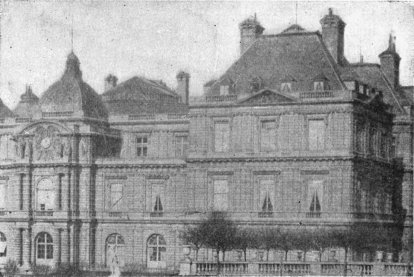
FIG. 180.—THE LUXEMBURG, PARIS.
THE CLASSIC PERIOD: HENRY IV. Under this energetic but
capricious monarch (1589–1610) and his Florentine queen, Marie de
Médicis, architecture entered upon a new period of activity and a new
stage of development. Without the
318
charm of the early Renaissance or the stateliness of the age of Louis
XIV., it has a touch of the Baroque, attributable partly to the
influence of Marie de Médicis and her Italian prelates, and partly to
the Italian training of many of the French architects. The great work of
this period was the extension of the Tuileries by J. B. du
Cerceau, and the completion, by Métézeau and others, of the
long gallery next the Seine, begun under Henry II., with the view of
connecting the Tuileries with the Louvre. In this part of the work
colossal orders were used with indifferent effect. Next in importance
was the addition to Fontainebleau of a great court to the eastward,
whose relatively quiet and dignified style offers less contrast than one
might expect to the other wings and courts dating from Francis I.
More successful architecturally than either of the above was the
Luxemburg palace, built for the queen by Salomon De
Brosse, in 1616 (Fig. 180). Its plan presents the favorite French
arrangement of a main building separated from the street
319
by a garden or court, the latter surrounded on three sides by low wings
containing the dependencies. Externally, rusticated orders recall the
garden front of the Pitti at Florence; but the scale is smaller, and the
projecting pavilions and high roofs give it a grace and picturesqueness
wanting in the Florentine model. The Place Royale, at Paris, and
the château of Beaumesnil, illustrate a type of brick-and-stone
architecture much in vogue at this time, stone quoins decorating the
windows and corners, and the orders being generally omitted.
Under Louis XIII. the Tuileries were extended northward and the
Louvre as built by Lescot was doubled in size by the architect
Lemercier, the Pavillon de l’Horloge being added to form the
centre of the enlarged court façade.
CHURCHES. To this reign belong also the most important
churches of the period. The church of St. Paul-St. Louis, at
Paris (1627, by Derrand), displays the worst faults of the time,
in the overloaded and meaningless decoration of its uninteresting front.
Its internal dome is the earliest in Paris. Far superior was the chapel
of the Sorbonne, a well-designed domical church by
Lemercier, with a sober and appropriate exterior treated with
superposed orders.
PERIOD OF LOUIS XIV. This was an age of remarkable literary
and artistic activity, pompous and pedantic in many of its
manifestations, but distinguished also by productions of a very high
order. Although contemporary with the Italian Baroque—Bernini
having been the guest of Louis XIV.—the architecture of this
period was free from the wild extravagances of that style. In its often
cold and correct dignity it resembled rather that of Palladio, making
large use of the orders in exterior design, and tending rather to
monotony than to overloaded decoration. In interior design there was
more of lightness and caprice. Papier-maché and stucco were freely used
in a fanciful style of relief ornamentation by scrolls, wreaths, shells,
etc., and
320
decorative panelling was much employed. The whole was saved from
triviality only by the controlling lines of the architecture which
framed it. But it was better suited to cabinet-work or to the
prettinesses of the boudoir than to monumental interiors. The Galerie
d’Apollon, built during this reign over the Petite Galerie in the
Louvre, escapes this reproach, however, by the sumptuous dignity of its
interior treatment.
VERSAILLES. This immense edifice, built about an already
existing villa of Louis XIII., was the work of Levau and
J. H. Mansart (1647–1708). Its erection, with the
laying out of its marvellous park, almost exhausted the resources of the
realm, but with results quite incommensurate with the outlay. In spite
of its vastness, its exterior is commonplace; the orders are used with
singular monotony, which is not redeemed by the deep breaks and
projections of the main front. There is no controlling or dominant
feature; there is no adequate entrance or approach; the grand staircases
are badly placed and unworthily treated, and the different elements of
the plan are combined with singular lack of the usual French sense of
monumental and rational arrangement. The chapel is by far the best
single feature in the design.
Far more successful was the completion of the Louvre, in 1688, from
the designs of Claude Perrault, the court physician, whose plans
were fortunately adopted in preference to those of Bernini. For the east
front he designed a magnificent Corinthian colonnade nearly 600 feet
long, with coupled columns upon a plain high basement, and with a
central pediment and terminal pavilions (Fig. 181). The whole forms one
of the most imposing façades in existence; but it is a mere decoration,
having no practical relation to the building behind it. Its height
required the addition of a third story to match it on the north and
south sides of the court, which as thus completed quadrupled the
original area
321
proposed by Lescot. Fortunately the style of Lescot’s work was retained
throughout in the court façades, while externally the colonnade was
recalled on the south front by a colossal order of pilasters. The Louvre
as completed by Louis XIV. was a stately and noble palace, as remarkable
for the surpassing excellence of the sculptures of Jean Goujon as for
the dignity and beauty of its architecture. Taken in connection with the
Tuileries, it was unrivalled by any palace in Europe except the
Vatican.
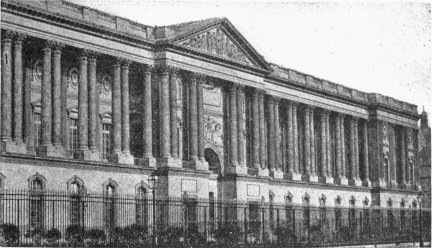
FIG. 181.—COLONNADE OF LOUVRE.
OTHER BUILDINGS. To Louis XIV. is also due the vast but
uninteresting Hôtel des Invalides or veteran’s asylum, at Paris,
by J. H. Mansart. To the chapel of this institution was added, in
1680–1706, the celebrated Dome of the Invalides,
a masterpiece by the same architect. In plan it somewhat resembles
Bramante’s scheme for St. Peter’s—a Greek cross with domical
chapels in the four angles and a dome over the centre. The exterior
(Fig. 182), with the lofty gilded dome on a high drum adorned with
engaged columns, is somewhat high for its breadth, but is a
322
harmonious and impressive design; and the interior, if somewhat cold, is
elegant and well proportioned. The chief innovation in the design was
the wide separation of the interior stone dome from the lofty exterior
decorative cupola and lantern of wood, this separation being designed to
meet the conflicting demands of internal and external effect. To the
same architect is due the formal monotony of the Place Vendôme,
all the houses surrounding it being treated with a uniform architecture
of colossal pilasters, at once monumental and inappropriate. One of the
most pleasing designs of the time is the Château de Maisons
(1658), by F. Mansart, uncle of J. H. Mansart. In this
the proportions of the central and terminal pavilions, the mass and
lines of the steep roof à la Mansarde, the simple and
effective use of the orders, and the refinement of all the details
impart a grace of aspect rare in contemporary works. The same qualities
appear also in the Val-de-Grâce, by F. Mansart and
Lemercier, a domical church of excellent proportions begun under
Louis XIII. The want of space forbids mention of other buildings of this
period.
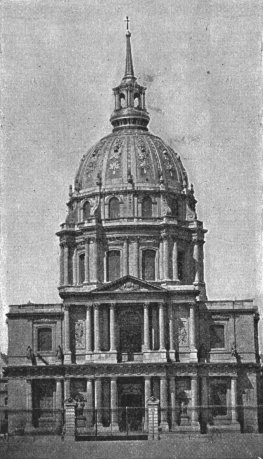
FIG. 182.—DOME OF THE INVALIDES.
323
THE DECLINE. Under Louis XV. the pedantry of the classic
period gave place to a protracted struggle between license and the
severest classical correctness. The exterior designs of this time were
often even more uninteresting and bare than under Louis XIV.; while, on
the other hand, interior decoration tended to the extreme of
extravagance and disregard of constructive propriety. Contorted lines
and crowded scrolls, shells, and palm-leaves adorned the mantelpieces,
cornices, and ceilings, to the almost complete suppression of straight
lines.
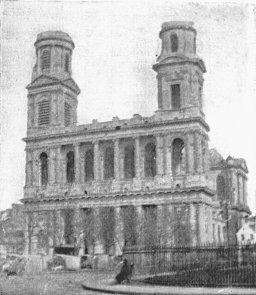
FIG. 183.—FAÇADE OF ST. SULPICE, PARIS.
While these tendencies prevailed in many directions,
a counter-current of severe classicism manifested itself in the
designs of a number of important public buildings, in which it was
sought to copy the grandeur of the old Roman colonnades and arcades. The
important church of St. Sulpice at Paris (Fig. 183) is an
excellent example of this. Its interior, dating from the preceding
century, is well designed, but in no wise a remarkable composition,
following Italian models. The façade, added in 1755 by
Servandoni, is, on the other hand, one of the most striking
architectural objects in the city. It is a correct and well proportioned
classic composition in two stories—an Ionic arcade over a Doric
colonnade, surmounted by two lateral turrets. Other monuments of this
classic revival will be noticed in Chapter XXV.
324
PUBLIC SQUARES. Much attention was given to the embellishment
of open spaces in the cities, for which the classic style was admirably
suited. The most important work of this kind was that on the north side
of the Place de la Concorde, Paris. This splendid square, perhaps, on
the whole, the finest in Europe (though many of its best features belong
to a later date), was at this time adorned with the two monumental
colonnades by Gabriel. These colonnades, which form the
decorative fronts for blocks of houses, deserve praise for the beauty of
their proportions, as well as for the excellent treatment of the arcade
on which they rest, and of the pavilions at the ends.
IN GENERAL. French Renaissance architecture is marked by good
proportions and harmonious and appropriate detail. Its most interesting
phase was unquestionably that of Francis I., so far, at least, as
concerns exterior design. It steadily progressed, however, in its
mastery of planning; and in its use of projecting pavilions crowned by
dominant masses of roof, it succeeded in preserving, even in severely
classic designs, a picturesqueness and variety otherwise
impossible. Roofs, dormers, chimneys, and staircases it treated with
especial success; and in these matters, as well as in monumental
dispositions of plan, the French have largely retained their
pre-eminence to our own day.
MONUMENTS. (Mainly supplementary to text. Ch. = château;
P. = palace; C. = cathedral; Chu. = church; H. = hôtel;
T.H. = town hall.)
Transition: Blois, E. wing, 1499;
Ch. Meillant; Ch. Chaumont; T.H. Amboise, 1502–05.
Francis I.: Ch. Nantouillet,
1517–25; Ch. Blois, W. wing (afterward demolished) and
N. wing, 1520–30; H. Lallemant, Bourges, 1520; Ch.
Villers-Cotterets, 1520–59; P. of Archbishop, Sens,
1521–35; P. Fontainebleau (Cour Ovale, Cour d’Adieux, Gallery
Francis I., 1527–34; Peristyle, Chapel St. Saturnin,
1540–47, by Gilles le Breton; Cour du Cheval Blanc,
1527–31, by P. Chambiges); H. Bernuy, Toulouse,
1528–39; P. Granvelle, Besançon, 1532–40; T.H. Niort,
T.H. Loches, 1532–43: H. de Ligeris (Carnavalet), Paris,
1544, by P. Lescot; churches of Gisors,
325
nave and façade, 1530; La Dalbade, Toulouse, portal, 1530; St.
Symphorien Tours, 1531; Chu. Tillières, 1534–46.
Advanced Renaissance: Fontaine des
Innocents, Paris, 1547–50, by P. Lescot and
J. Goujon; tomb Francis I., at St. Denis, 1555, by
Ph. de l’Orme; H. Catelan, Toulouse, 1555; tomb Henry II.,
at St. Denis, 1560; portal S. Michel, Dijon, 1564; Ch. Sully, 1567;
T.H. Arras, 1573; P. Fontainebleau (Cour du Cheval Blanc
remodelled, 1564–66, by P. Girard; Cour de la
Fontaine, same date); T.H. Besançon, 1582; Ch. Charleval, 1585, by,
J. B. du Cerceau.
Style of Henry IV.:
P. Fontainebleau (Galerie des Cerfs, Chapel of the Trinity,
Baptistery, etc.); P. Tuileries (Pav. de Flore, by du
Cerceau, 1590–1610; long gallery continued); Hôtel Vogüé, at
Dijon, 1607; Place Dauphine, Paris, 1608; P. de Justice, Paris,
Great Hall, by S. de Brosse, 1618; H. Sully, Paris,
1624–39; P. Royal, Paris, by J. Lemercier, for
Cardinal Richelieu, 1627–39; P. Louvre doubled in size, by
the same; P. Tuileries (N. wing, and Pav. Marsan, long gallery
completed); H. Lambert, Paris; T.H. Reims, 1627; Ch. Blois,
W. wing for Gaston d’Orléans, by F. Mansart, 1635;
façade St. Étienne du Mont, Paris, 1610; of St. Gervais, Paris,
1616–21, by S. de Brosse.
Style of Louis XIV.: T.H. Lyons,
1646; P. Louvre, E. colonnade and court completed,
1660–70; Tuileries altered by Le Vau, 1664; observatory at Paris,
1667–72; arch of St. Denis, Paris, 1672, by Blondel; Arch
of St. Martin, 1674, by Bullet; Banque de France, H. de
Luyne, H. Soubise, all in Paris; Ch. Chantilly; Ch. de Tanlay;
P. St. Cloud; Place des Victoires, 1685; Chu. St. Sulpice, Paris,
by Le Vau (façade, 1755); Chu. St. Roch, Paris, 1653, by
Lemercier and de Cotte; Notre Dame des Victoires, Paris,
1656, by Le Muet and Bruant.
The Decline: P. Bourbon, 1722;
T.H. Rouen; Halle aux Blés (recently demolished), 1748; École Militaire,
1752–58, by Gabriel; P. Louvre, court completed, 1754,
by the same; Madeleine begun, 1764; H. des Monnaies (Mint), by
Antoine; École de Médecine, 1774, by Gondouin;
P. Royal, Great Court, 1784, by Louis; Théâtre Français,
1784 (all the above at Paris); Grand Théâtre, Bordeaux, 1785–1800,
by Louis; Préfecture at Bordeaux, by the same; Ch. de Compiegne,
1770, by Gabriel; P. Versailles, theatre by the same;
H. Montmorency, Soubise, de Varennes, and the Petit Luxembourg, all
at Paris, by de Cotte; public squares at Nancy, Bordeaux,
Valenciennes, Rennes, Reims.
326
RENAISSANCE ARCHITECTURE IN GREAT BRITAIN AND THE NETHERLANDS.
Books Recommended: As before,
Fergusson, Palustre. Also, Belcher and Macartney, Later Renaissance
Architecture in England. Billings, Baronial and Ecclesiastical
Antiquities of Scotland. Blomfield, A Short History of
Renaissance Architecture in England. Britton, Architectural
Antiquities of Great Britain. Ewerbeck, Die Renaissance in
Belgien und Holland. Galland, Geschichte der Hollandischen
Baukunst im Zeitalter der Renaissance. Gotch and Brown,
Architecture of the Renaissance in England. Loftie, Inigo
Jones and Wren. Nash, Mansions of England. Papworth,
Renaissance and Italian Styles of Architecture in Great Britain.
Richardson, Architectural Remains of the Reigns of Elizabeth and
James I. Schayes, Histoire de l’architecture en
Belgique.
THE TRANSITION. The architectural activity of the sixteenth
century in England was chiefly devoted to the erection of vast country
mansions for the nobility and wealthy bourgeoisie. In these
seignorial residences a degenerate form of the Gothic, known as the
Tudor style, was employed during the reigns of Henry VII. and Henry
VIII., and they still retained much of the feudal aspect of the Middle
Ages. This style, with its broad, square windows and ample halls, was
well suited to domestic architecture, as well as to collegiate
buildings, of which a considerable number were erected at this time.
Among the more important palaces and manor-houses of this period are the
earlier parts of Hampton Court, Haddon and Hengreave Halls, and the now
ruined castles of Raglan and Wolterton.
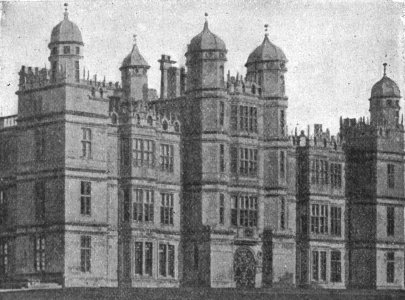
FIG. 184.—BURGHLEY HOUSE.
ELIZABETHAN STYLE. Under Elizabeth (1558–1603) the
progress of classic culture and the employment of Dutch
327
and Italian artists led to a gradual introduction of Renaissance forms,
which, as in France, were at first mingled with others of Gothic origin.
Among the foreign artists in England were the versatile Holbein, Trevigi
and Torregiano from Italy, and Theodore Have, Bernard Jansen, and Gerard
Chrismas from Holland. The pointed arch disappeared, and the orders
began to be used as subordinate features in the decoration of doors,
windows, chimneys, and mantels. Open-work balustrades replaced
externally the heavy Tudor battlements, and a peculiar style of carving
in flat relief-patterns, resembling appliqué designs cut out with
the jigsaw and attached by nails or rivets, was applied with little
judgment to all possible features. Ceilings were commonly finished in
plaster, with elaborate interlacing patterns in low relief; and this,
with the increasing use of interior woodwork, gave to the mansions of
this time a more homelike but less monumental aspect internally. English
328
architects, like Smithson and Thorpe, now began to win the patronage at
first monopolized by foreigners. In Wollaton Hall (1580), by
Smithson, the orders were used for the main composition with mullioned
windows, much after the fashion of Longleat House, completed a
year earlier by his master, John of Padua. During the following period,
however (1590–1610), there was a reaction toward the Tudor
practice, and the orders were again relegated to subordinate uses. Of
their more monumental employment, the Gate of Honor of Caius
College, Cambridge, is one of the earliest examples. Hardwicke and
Charlton Halls, and Burghley, Hatfield, and Holland Houses (Fig. 184),
are noteworthy monuments of the style.
JACOBEAN STYLE. During the reign of James I.
(1603–25), details of classic origin came into more general use,
but caricatured almost beyond recognition. The orders, though much
employed, were treated without correctness or grace, and the ornament
was unmeaning and heavy. It is not worth while to dwell further upon
this style, which produced no important public buildings, and soon gave
way to a more rigid classicism.
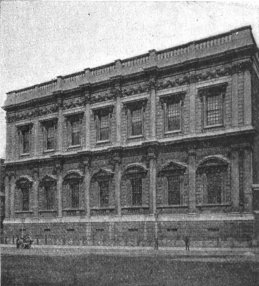
FIG. 185.—BANQUETING HALL, WHITEHALL.
CLASSIC PERIOD. If the classic style was late in its
appearance in England, its final sway was complete and long-lasting. It
was Inigo Jones (1572–1652) who first introduced the
correct and monumental style of the Italian masters of classic design.
For Palladio, indeed, he seems to have entertained a sort of veneration,
and the villa which he designed at Chiswick was a reduced copy of
Palladio’s Villa Capra, near Vicenza. This and other works of his show a
failure to appreciate the unsuitability of Italian conceptions to the
climate and tastes of Great Britain; his efforts to popularize Palladian
architecture, without the resources which Palladio controlled in the way
of decorative sculpture and painting, were consequently not always happy
in their results. His greatest work was the design
329
for a new Palace at Whitehall, London. Of this colossal scheme,
which, if completed, would have ranked as the grandest palace of the
time, only the Banqueting Hall (now used as a museum) was ever
built (Fig. 185). It is an effective composition in two stories,
rusticated throughout and adorned with columns and pilasters, and
contains a fine vaulted hall in three aisles. The plan of the palace,
which was to have measured 1,152 × 720 feet, was excellent, largely
conceived and carefully studied in its details, but it was wholly beyond
the resources of the kingdom. The garden-front of Somerset House
(1632; demolished) had the same qualities of simplicity and dignity,
recalling the works of Sammichele. Wilton House, Coleshill, the Villa at
Chiswick, and St. Paul’s, Covent Garden, are the best known of his
works, showing him to have been a designer of ability, but hardly of the
consummate genius which his admirers attribute to him.
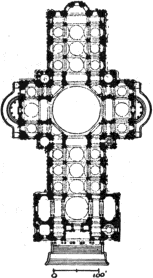
FIG. 186.—PLAN OF ST. PAUL’S, LONDON.
ST. PAUL’S CATHEDRAL. The greatest of Jones’s successors was
Sir Christopher Wren (1632–1723), principally known as the
architect of St. Paul’s Cathedral, London, built to replace the
earlier Gothic cathedral destroyed in the great fire of 1666. It was
begun in 1675, and its designer had the rare good fortune to witness its
completion in 1710. The plan, as finally adopted, retained the general
330
proportions of an English Gothic church, measuring 480 feet in length,
with transepts 250 feet long, and a grand rotunda 108 feet in diameter
at the crossing (Fig. 186). The style was strictly Italian, treated with
sobriety and dignity, if somewhat lacking in variety and inspiration.
Externally two stories of the Corinthian order appear, the upper story
being merely a screen to hide the clearstory and its buttresses. This is
an architectural deception, not atoned for by any special beauty of
detail. The dominant feature of the design is the dome over the central
area. It consists of an inner shell, reaching a height of 216 feet,
above which rises the exterior dome of wood, surmounted by a stone
lantern, the summit of which is 360 feet from the pavement (Fig. 187).
This exterior dome, springing from a high drum surrounded by a
magnificent peristyle, gives to the otherwise commonplace exterior of
the cathedral a signal majesty of effect. Next to the dome the most
successful part of the design is the west front, with its two-storied
porch and flanking bell-turrets. Internally the excessive relative
length, especially that of the choir, detracts from the effect of the
dome, and the poverty of detail gives the whole a somewhat bare aspect.
It is intended to relieve this ultimately by a systematic use of mosaic
decoration, especially in the dome. The central area itself, in spite of
the awkward treatment of the four smaller arches of the eight which
support the dome, is a noble design, occupying the whole width of the
three aisles, like the Octagon at Ely, and producing a striking effect
of amplitude
331
and grandeur. The dome above it is constructively interesting from the
employment of a cone of brick masonry to support the stone lantern which
rises above the exterior wooden shell. The lower part of the cone forms
the drum of the inner dome, its contraction upward being intended to
produce a perspective illusion of increased height.
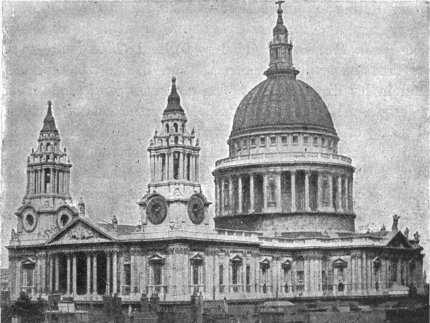
FIG. 187.—EXTERIOR OF ST. PAUL’S
CATHEDRAL.
St. Paul’s ranks among the five or six greatest domical buildings of Europe, and
is the most imposing modern edifice in England.
WREN’S OTHER WORKS. Wren was conspicuously successful in the
designing of parish churches in London. St. Stephen’s, Walbrook,
is the most admired of these, with a dome resting on eight columns. Wren
may be called the inventor of the English Renaissance type of steeple,
in which a conical or pyramidal spire is harmoniously added
332
to a belfry on a square tower with classic details. The steeple of
Bow Church, Cheapside, is the most successful example of the
type. In secular architecture Wren’s most important works were the plan
for rebuilding London after the Great Fire; the new courtyard of Hampton
Court, a quiet and dignified composition in brick and stone; the
pavilions and colonnade of Greenwich Hospital; the Sheldonian
Theatre at Oxford, and the Trinity College Library at Cambridge. Without
profound originality, these works testify to the sound good taste and
intelligence of their designer.
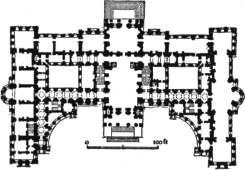
FIG. 188.—PLAN OF BLENHEIM.
Larger View
THE 18TH CENTURY. The Anglo-Italian style as used by Jones and
Wren continued in use through the eighteenth century, during the first
half of which a number of important country-seats and some churches were
erected. Van Brugh (1666–1726), Hawksmoor
(1666–1736), and Gibbs (1683–1751) were then the
leading architects. Van Brugh was especially skilful in his dispositions
of plan and mass, and produced in the designs of Blenheim and Castle
Howard effects of grandeur and variety of perspective hardly equalled by
any of his contemporaries in France or Italy. Blenheim, with its
monumental plan and the sweeping curves of its front (Fig. 188), has an
unusually palatial aspect, though the striving for picturesqueness is
carried too far. Castle Howard is simpler, depending largely for effect
on a somewhat inappropriate dome. To Hawksmoor, his pupil, are due
St. Mary’s, Woolnoth (1715), at London, in which by a bold
rustication of the whole exterior and by windows set in
333
large recessed arches he was enabled to dispense wholly with the orders;
St. George’s, Bloomsbury; the new quadrangle of All Souls at Oxford, and
some minor works. The two most noted designs of James Gibbs are St.
Martin’s-in-the-Fields, at London (1726), and the Radcliffe
Library, at Oxford (1747). In the former the use of a Corinthian
portico—a practically uncalled-for but decorative
appendage—and of a steeple mounted on the roof, with no visible
lines of support from the ground, are open to criticism. But the
excellence of the proportions, and the dignity and appropriateness of
the composition, both internally and externally, go far to redeem these
defects (Fig. 189). The Radcliffe Library is a circular domical hall
surrounded by a lower circuit of alcoves and rooms, the whole treated
with straightforward simplicity and excellent proportions. Colin
Campbell, Flitcroft, Kent and Wood, contemporaries of Gibbs, may be
dismissed with passing mention.
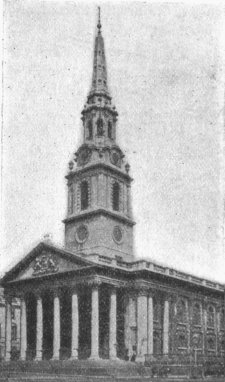
FIG. 189.—ST. MARTIN’S-IN-THE-FIELDS, LONDON.
Sir William Chambers (1726–96) was the greatest of the
later 18th-century architects. His fame rests chiefly on his Treatise
on Civil Architecture, and the extension and remodelling of
Somerset House, in which he retained the general
ordonnance of Inigo Jones’s design, adapting it to a
334
frontage of some 600 feet. Robert Adams, the designer of
Keddlestone Hall, Robert Taylor (1714–88), the architect of
the Bank of England, and George Dance, who designed the Mansion
House and Newgate Prison, at London—the latter a vigorous and
appropriate composition without the orders—close the list of noted
architects of the eighteenth century. It was a period singularly wanting
in artistic creativeness and spontaneity; its productions were nearly
all dull and respectable, or at best dignified, but without charm.
BELGIUM. As in all other countries where the late Gothic style
had been highly developed, Belgium was slow to accept the principles of
the Renaissance in art. Long after the dawn of the sixteenth century the
Flemish architects continued to employ their highly florid Gothic alike
for churches and town-halls, with which they chiefly had to do. The
earliest Renaissance buildings date from 1530–40, among them being
the Hôtel du Saumon, at Malines, at Bruges the Ancien Greffe, by Jean
Wallot, and at Liège the Archbishop’s Palace, by
Borset. The last named, in the singular and capricious form of
the arches and baluster-like columns of its court, reveals the taste of
the age for what was outré and odd; a taste partly due, no
doubt, to Spanish influences, as Belgium was in reality from 1506 to
1712 a Spanish province, and there was more or less interchange of
artists between the two countries. The Hôtel de Ville, at
Antwerp, by Cornelius de Vriendt or Floris
(1518–75), erected in 1565, is the most important monument of the
Renaissance in Belgium. Its façade, 305 feet long and 102 feet high, in
four stories, is an impressive creation in spite of its somewhat
monotonous fenestration and the inartistic repetition in the third story
of the composition and proportions of the second. The basement story
forms an open arcade, and an open colonnade or loggia runs along under
the roof, thus imparting to the composition a considerable play of light
and shade, enhanced by the picturesque
335
central pavilion which rises to a height of six stories in diminishing
stages. The style is almost Palladian in its severity, but in general
the Flemish architects disdained the restrictions of classic canons,
preferring a more florid and fanciful effect than could be obtained by
mere combinations of Roman columns, arches, and entablatures. De
Vriendt’s other works were mostly designs for altars, tabernacles and
the like; among them the rood screen in Tournay Cathedral. His influence
may be traced in the Hôtel de Ville at Flushing
(1594).
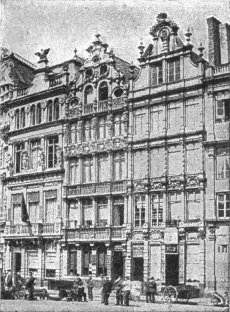
FIG. 190.—RENAISSANCE HOUSES, BRUSSELS.
The ecclesiastical architecture of the Flemish Renaissance is almost
as destitute of important monuments as is the secular. Ste. Anne,
at Bruges, fairly illustrates the type, which is characterized in
general by heaviness of detail and a cold and bare aspect internally.
The Renaissance in Belgium is best exemplified, after all, by minor
works and ordinary dwellings, many of which have considerable artistic
grace, though they are quaint rather than monumental (Fig. 190). Stepped
gables, high dormers, and volutes flanking each diminishing stage of the
design, give a certain piquancy to the street architecture of the
period.
HOLLAND. Except in the domain of realistic painting, the Dutch
have never manifested pre-eminent artistic endowments, and the
Renaissance produced in Holland few monuments of consequence. It began
there, as in many
336
other places, with minor works in the churches, due largely to Flemish
or Italian artists. About the middle of the 16th century two native
architects, Sebastian van Noye and William van Noort,
first popularized the use of carved pilasters and of gables or steep
pediments adorned with carved scallop-shells, in remote imitation of the
style of Francis I. The principal monuments of the age were
town-halls, and, after the war of independence in which the yoke of
Spain was finally broken (1566–79), local administrative
buildings—mints, exchanges and the like. The Town Hall of
The Hague (1565), with its stepped gable or great dormer, its
consoles, statues, and octagonal turrets, may be said to have
inaugurated the style generally followed after the war. Owing to the
lack of stone, brick was almost universally employed, and stone imported
by sea was only used in edifices of exceptional cost and importance. Of
these the Town Hall at Amsterdam holds the first place. Its
façade is of about the same dimensions as the one at Antwerp, but
compares unfavorably with it in its monotony and want of interest. The
Leyden Town Hall, by the Fleming, Lieven de Key (1597),
the Bourse or Exchange and the Hanse House at Amsterdam, by Hendrik
de Keyser, are also worthy of mention, though many lesser buildings,
built of brick combined with enamelled terra-cotta and stone, possess
quite as much artistic merit.
DENMARK. In Denmark the monuments of the Renaissance may
almost be said to be confined to the reign of Christian IV.
(1588–1648), and do not include a single church of any importance.
The royal castles of the Rosenborg at Copenhagen (1610) and the
Fredericksborg (1580–1624), the latter by a Dutch
architect, are interesting and picturesque in mass, with their fanciful
gables, mullioned windows and numerous turrets, but can hardly lay claim
to beauty of detail or purity of style. The Exchange at Copenhagen,
built of brick and stone in the same general
337
style (1619–40), is still less interesting both in mass and
detail.
The only other important Scandinavian monument deserving of special
mention in so brief a sketch as this is the Royal Palace at
Stockholm, Sweden (1698–1753), due to a foreign architect,
Nicodemus de Tessin. It is of imposing dimensions, and although
simple in external treatment, it merits praise for the excellent
disposition of its plan, its noble court, imposing entrances, and the
general dignity and appropriateness of its architecture.
MONUMENTS (in addition to those mentioned in text). England, Tudor Style: Several palaces by
Henry VIII., no longer extant; Westwood, later rebuilt; Gosfield Hall;
Harlaxton.—Elizabethan:
Buckhurst, 1565; Kirby House, 1570, both by Thorpe; Caius College,
1570–75, by Theodore Have; “The Schools,” Oxford, by Thomas Holt,
1600; Beaupré Castle, 1600.—Jacobean: Tombs of Mary of Scotland and of Elizabeth
in Westminster Abbey; Audsley Inn; Bolsover Castle, 1613; Heriot’s
Hospital, Edinburgh, 1628.—Classic or Anglo-Italian: St. John’s College, Oxford; Queen’s
House, Greenwich; Coleshill; all by Inigo Jones, 1620–51;
Amesbury, by Webb; Combe Abbey; Buckingham and Montague Houses; The
Monument, London, 1670, by Wren; Temple Bar, by the same; Winchester
Palace, 1683; Chelsea College; Towers of Westminster Abbey, 1696; St.
Clement Dane’s; St. James’s, Westminster; St. Peter’s, Cornhill, and
many others, all by Wren.—18th
Century: Seaton Delaval and Grimsthorpe, by Van Brugh; Wanstead
House, by Colin Campbell; Treasury Buildings, by Kent.
The most important Renaissance buildings of Belgium and Holland
have been mentioned in the text.
338
RENAISSANCE ARCHITECTURE IN GERMANY, SPAIN, AND PORTUGAL.
Books Recommended: As before,
Fergusson, Palustre Also, von Bezold, Die Baukunst der Renaissance in
Deutschland, Holland, Belgien und Dänemark
(in Hdbuch. d. Arch.). Caveda (tr. Kugler), Geschichte der
Baukunst in Spanien. Fritsch, Denkmäler der deutschen
Renaissance (plates). Junghändel, Die Baukunst Spaniens.
Lambert und Stahl, Motive der deutschen Architektur. Lübke,
Geschichte der Renaissance in Deutschland. Prentice,
Renaissance Architecture and Ornament in Spain. Uhde,
Baudenkmäler in Spanien. Verdier et Cattois, Architecture
civile et domestique. Villa Amil, Hispania Artistica y
Monumental.
AUSTRIA; BOHEMIA. The earliest appearance of the
Renaissance in the architecture of the German states was in the eastern
provinces. Before the close of the fifteenth century Florentine and
Milanese architects were employed in Austria, Bohemia, and the Tyrol,
where there are a number of palaces and chapels in an unmixed Italian
style. The portal of the castle of Mahrisch-Trübau dates from 1492;
while to the early years of the 16th century belong a cruciform chapel
at Gran, the remodelling of the castle at Cracow, and the chapel of the
Jagellons in the same city—the earliest domical structure of the
German Renaissance, though of Italian design. The Schloss Porzia
(1510), at Spital in Carinthia, is a fine quadrangular palace,
surrounding a court with arcades on three sides, in which the open
stairs form a picturesque interruption with their rampant arches. But
for the massiveness of the details it might be a Florentine palace. In
addition to this, the famous Arsenal at Wiener-Neustadt (1524),
the portal of the Imperial
339
Palace (1552), and the Castle Schalaburg on the Danube
(1530–1601), are attributed to Italian architects, to whom must
also be ascribed a number of important works at Prague. Chief among
these the Belvedere (1536, by Paolo della Stella),
a rectangular building surrounded by a graceful open arcade, above
which it rises with a second story crowned by a curved roof; the
Waldstein Palace (1621–29), by Giov. Marini, with its
imposing loggia; Schloss Stern, built on the plan of a
six-pointed star (1459–1565) and embellished by Italian artists
with stucco ornaments and frescoes; and parts of the palace on the
Hradschin, by Scamozzi, attest the supremacy of Italian art in
Bohemia. The same is true of Styria, Carinthia, and the Tyrol;
e.g. Schloss Ambras at Innsbrück (1570).
GERMANY: PERIODS. The earliest manifestation of the
Renaissance in what is now the German Empire, appeared in the works of
painters like Dürer and Burkmair, and in occasional buildings previous
to 1525. The real transformation of German architecture, however, hardly
began until after the Peace of Augsburg, in 1555. From that time on its
progress was rapid, its achievements being almost wholly in the domain
of secular architecture—princely and ducal castles, town halls or
Rathhäuser, and houses of wealthy
burghers or corporations. It is somewhat singular that the German
emperors should not have undertaken the construction of a new imperial
residence on a worthy scale, the palaces of Munich and Berlin being
aggregations of buildings of various dates about a nucleus of mediæval
origin, and with no single portion to compare with the stately châteaux
of the French kings. Church architecture was neglected, owing to the
Reformation, which turned to its own uses the existing churches, while
the Roman Catholics were too impoverished to replace the edifices they
had lost.
The periods of the German Renaissance are less well
340
marked than those of the French; but its successive developments follow
the same general progression, divided into three stages:
I. The Early Renaissance,
1525–1600, in which the orders were infrequently used, mainly for
porches and for gable decoration. The conceptions and spirit of most
monuments were still strongly tinged with Gothic feeling.
II. The Late Renaissance,
1600–1675, characterized by a dry, heavy treatment, in which too
often neither the fanciful gayety of the previous period nor the simple
and monumental dignity of classic design appears. Broken curves, large
scrolls, obelisks, and a style of flat relief carving resembling the
Elizabethan are common. Occasional monuments exhibit a more correct and
classic treatment after Italian models.
III. The Decline or Baroque Period,
1675–1800, employing the orders in a style of composition
oscillating between the extremes of bareness and of Rococo
over-decoration. The ornament partakes of the character of the Louis XV.
and Italian Jesuit styles, being most successful in interior decoration,
but externally running to the extreme of unrestrained fancy.
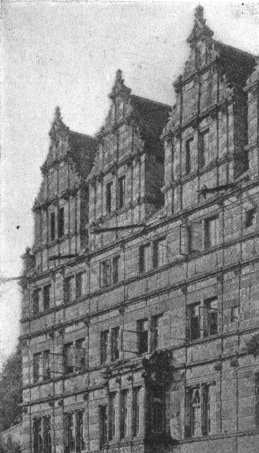
FIG. 191.—SCHLOSS HÄMELSCHENBURG.
CHARACTERISTICS. In none of these periods do we meet with the
sober, monumental treatment of the Florentine or Roman schools.
A love of picturesque variety in masses and sky-lines, inherited
from mediæval times, appears in the high roofs, stepped gables and lofty
dormers which are universal. The roofs often comprise several stories,
and are lighted by lofty gables at either end, and by dormers carried up
from the side walls through two or three stories. Gables and dormers
alike are built in diminishing stages, each step adorned with a console
or scroll, and the whole treated with pilasters or colonnettes and
entablatures breaking over each support (Fig. 191). These roofs,
dormers, and gables contribute the most noticeable element to the
general
341
effect of most German Renaissance buildings, and are commonly the
best-designed features in them. The orders are scantily used and usually
treated with utter disregard of classic canons, being generally far too
massive and overloaded with ornament. Oriels, bay-windows, and turrets,
starting from corbels or colonnettes, or rarely from the ground,
diversify the façade, and spires of curious bulbous patterns give added
piquancy to the picturesque sky-line. The plans seldom had the
monumental symmetry and largeness of Italian and French models;
courtyards were often irregular in shape and diversified with balconies
and spiral staircase-turrets. The national leaning was always toward the
quaint and fantastic, as well in the decoration as in the composition.
Grotesques, caryatids, gaînes (half-figures terminating below in
sheath-like supports), fanciful rustication, and many other details give
a touch of the Baroque even to works of early date. The same principles
were applied with better success to interior decoration, especially in
the large halls of
342
the castles and town-halls, and many of their ceilings were sumptuous
and well-considered designs, deeply panelled, painted and gilded in wood
or plaster.
CASTLES. The Schloss or Burg of the German
prince or duke retained throughout the Renaissance many mediæval
characteristics in plan and aspect. A large proportion of these
noble residences were built upon foundations of demolished feudal
castles, reproducing in a new dress the ancient round towers and vaulted
guard-rooms and halls, as in the Hartenfels at Torgau, the Heldburg
(both in Saxony), and the castle of Trausnitz, in Bavaria, among many
others. The Castle at Torgau (1540) is one of the most
imposing of its class, with massive round and square towers showing
externally, and court façades full of picturesque irregularities. In the
great Castle at Dresden the plan is more symmetrical, and
the Renaissance appears more distinctly in the details of the
Georgenflügel (1530–50), though at that early date the classic
orders were almost ignored. The portal of the Heldburg, however, built
in 1562, is a composition quite in the contemporary French vein, with
superposed orders and a crowning pediment over a massive basement.
Another important series of castles or palaces are of more regular
design, in which the feudal traditions tend to disappear. The majority
belong to the end of the 16th and beginning of the 17th centuries. They
are built around large rectangular courts with arcades in two or three
stories on one or more sides, but rarely surrounding it entirely. In
these the segmental arch is more common than the semicircular, and
springs usually from short and stumpy Ionic or Corinthian columns. The
rooms and halls are arranged en suite, without corridors, and a
large and lofty banquet hall forms the dominant feature of the series.
The earliest of these regularly planned palaces are of Italian design.
Chief among them is the Residenz at Landshut
(1536–43),
343
with a thoroughly Roman plan, by pupils of Giulio Romano, and exterior
and court façades of great dignity treated with the orders. More German
in its details, but equally interesting, is the Fürstenhof at Wismar, in brick and terra-cotta, by
Valentino di Lira and Van Aken (1553); while in the
Piastenschloss at Brieg (1547–72), by Italian architects,
the treatment in parts suggests the richest works of the style of
Francis I. In other castles the segmental arch and stumpy columns
or piers show the German taste, as in the Plassenburg, by
Kaspar Vischer (1554–64), the castle at Plagnitz, and the
Old Castle at Stuttgart, all dating from about
1550–55. Heidelberg Castle, in spite of its mediæval aspect
from the river and its irregular plan, ranks as the highest achievement
of the German Renaissance in palace design. The most interesting parts
among its various wings built at different dates—the earlier
portions still Gothic in design—are the Otto Heinrichsbau
(1554) and the Friedrichsbau (1601). The first of these appears
somewhat simpler in its lines than the second, by reason of having lost
its original dormer-gables. The orders, freely treated, are superposed
in three stories, and twin windows, niches, statues, gaînes,
medallions and profuse carving produce an effect of great gayety and
richness. The Friedrichsbau (Fig. 192), less quiet in its lines, and
with high scroll-gabled and stepped dormers, is on the other hand more
soberly decorated and more characteristically German. The Schloss
Hämelschenburg (Fig. 191) is designed in
somewhat the same spirit, but with even greater simplicity of
detail.
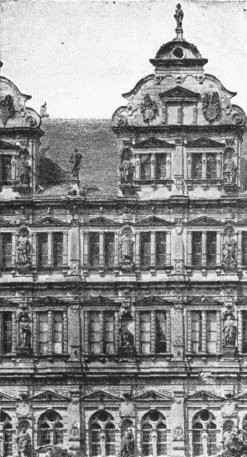
FIG. 192.—THE FRIEDRICHSBAU, HEIDELBERG.
TOWN HALLS. These constitute the most interesting class of
Renaissance buildings in Germany, presenting a considerable variety of
types, but nearly all built in solid blocks without courts, and adorned
with towers or spires. A high roof crowns the building, broken by
one or more high gables or many-storied dormers. The majority of these
town
344
halls present façades much diversified by projecting wings, as at Lemgo
and Paderborn, or by oriels and turrets, as at Altenburg
(1562–64); and the towers which dominate the whole terminate
usually in bell-shaped cupolas, or in more capricious forms with
successive swellings and contractions, as at Dantzic (1587). A few,
however, are designed with monumental simplicity of mass; of these that
at Bremen (1612) is perhaps the finest, with its beautiful
exterior arcade on strong Doric columns. The town hall of Nuremberg is
one of the few with a court, and presents a façade of almost Roman
simplicity (1613–19); that at Augsburg (1615) is equally
classic and more pleasing; while at Schweinfurt, Rothenburg (1572),
Mülhausen, etc., are others worthy of mention.
CHURCHES. St. Michael’s, at Munich, is almost the only
important church of the first period in Germany (1582), but it is worthy
to rank with many of the most notable contemporary Italian churches.
A wide nave covered by a majestic barrel vault, is flanked by side
chapels, separated from each other by massive piers and
345
forming a series of gallery bays above. There are short transepts and a
choir, all in excellent proportion and treated with details which, if
somewhat heavy, are appropriate and reasonably correct. The
Marienkirche at Wolfenbüttel (1608) is a
fair sample of the parish churches of the second period. In the exterior
of this church pointed arches and semi-Gothic tracery are curiously
associated with heavy rococo carving. The simple rectangular mass,
square tower, and portal with massive orders and carving are
characteristic features. Many of the church-towers are well proportioned
and graceful structures in spite of the fantastic outlines of their
spires. One of the best and purest in style is that of the University
Church at Würzburg (1587–1600).
HOUSES. Many of the German houses of the sixteenth and
seventeenth centuries would merit extended notice in a larger work, as
among the most interesting lesser monuments of the Renaissance.
Nuremberg and Hildesheim are particularly rich in such houses, built
either for private citizens or for guilds and corporations. Not a few of
the half-timbered houses of the time are genuine works of art, though
interest chiefly centres in the more monumental
346
dwellings of stone. In this domestic architecture the picturesque
quality of German design appears to better advantage than in more
monumental edifices, and their broadly stepped gables, corbelled oriels,
florid portals and want of formal symmetry imparting a peculiar and
undeniable charm. The Kaiserhaus and Wedekindsches Haus at Hildesheim;
Fürstenhaus at Leipzig; Peller, Hirschvogel, and Funk houses at
Nuremberg; the Salt House at Frankfurt, and Ritter House at Heidelberg,
are a few of the most noted among these examples of domestic
architecture.
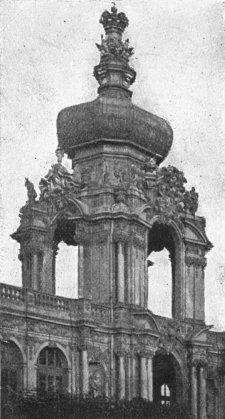
FIG. 193.—ZWINGER PALACE, DRESDEN.
LATER MONUMENTS. The Zwinger Palace at Dresden (Fig.
193), is the most elaborate and wayward example of the German palace
architecture of the third period. Its details are of the most
exaggerated rococo type, like confectioner’s work done in stone; and yet
the building has an air of princely splendor which partly atones for its
details. Besides this palace, Dresden possesses in the domical
Marienkirche (Fig. 194) a very meritorious example of late
design. The proportions are good, and the detail, if not interesting, is
at least inoffensive, while the whole is
347
a dignified and rational piece of work. At Vienna are a number of
palaces of the third period, more interesting for their beautiful
grounds and parks than for intrinsic architectural merit. As in Italy,
this was the period of stucco, and although in Vienna this cheap and
perishable material was cleverly handled, and the ornament produced was
often quaint and effective, the results lack the permanence and dignity
of true building in stone or brick, and may be dismissed without further
mention.
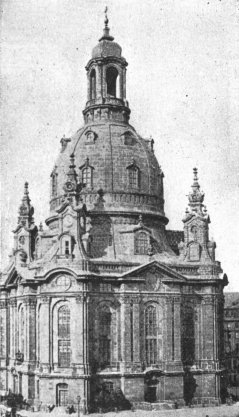
FIG. 194.—CHURCH OF ST. MARY (MARIENKIRCHE), DRESDEN.
In minor works the Germans were far less prolific than the Italians
or Spaniards. Few of their tombs were of the first importance, though
one, the Sebald Shrine, in Nuremberg, by Peter Vischer
(1506–19), is a splendid work in bronze, in the transitional
style; a richly decorated canopy on slender metal colonnettes
covering and enclosing the sarcophagus of the saint. There are a large
number of fountains in the squares of German and Swiss cities which
display a high order of design, and are among the most characteristic
minor products of German art.
SPAIN. The flamboyant Gothic style sufficed for a while to
meet the requirements of the arrogant and luxurious period which in
Spain followed the overthrow of the Moors and the discovery of America.
But it was inevitable that the Renaissance should in time make its
influence felt in the arts of the Iberian peninsula, largely through the
employment of Flemish artists. In jewelry and silverwork, arts which
received a great impulse from the importation of the precious metals
from the New World, the forms of the Renaissance found special
acceptance, so that the new style received the name of the
Plateresque (from platero, silversmith). This was a not
inept name for the minutely detailed and sumptuous decoration of the
early Renaissance, which lasted from 1500 to the accession of Philip II.
in 1556. It was characterized by surface-decoration spreading over broad
areas, especially around doors and windows,
348
florid escutcheons and Gothic details mingling with delicately chiselled
arabesques. Decorative pilasters with broken entablatures and carved
baluster-shafts were employed with little reference to constructive
lines, but with great refinement of detail, in spite of the exuberant
profusion of the ornament.
To this style, after the artistic inaction of Philip II.’s reign,
succeeded the coldly classic style practised by Berruguete and
Herrera, and called the Griego-Romano. In spite of the
attempt to produce works of classical purity, the buildings of this
period are for the most part singularly devoid of originality and
interest. This style lasted until the middle of the seventeenth century,
and in the case of certain works and artists, until its close. It was
followed, at least in ecclesiastical architecture, by the so-called
Churrigueresque, a name derived from an otherwise
insignificant architect, Churriguera, who like Maderna and
Borromini in Italy, discarded all the proprieties of architecture, and
rejoiced in the wildest extravagances of an untrained fancy and debased
taste.
EARLY MONUMENTS. The earliest ecclesiastical works of the
Renaissance period, like the cathedrals of Salamanca, Toledo, and
Segovia, were almost purely Gothic in style. Not until 1525 did the new
forms begin to dominate in cathedral design. The cathedral at
Jaen, by Valdelvira (1525), an imposing structure with
three aisles and side chapels, was treated internally with the
Corinthian order throughout. The Cathedral of Granada (1529, by
Diego de Siloe) is especially interesting for its great domical
sanctuary 70 feet in diameter, and for the largeness and dignity of its
conception and details. The cathedral of Malaga, the church of San
Domingo at Salamanca, and the monastery of San Girolamo in the same city
are either wholly or in part Plateresque, and provided with portals of
especial richness of decoration. Indeed, the portal of S. Domingo
practically forms the whole façade.
349
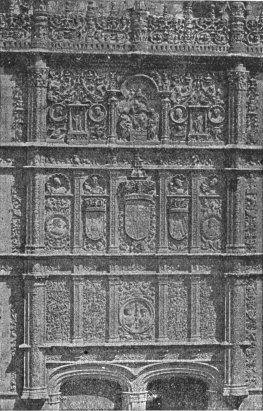
FIG. 195.—DOOR OF THE UNIVERSITY,
SALAMANCA.
In secular architecture the Hospital of Santa Cruz at
Toledo, by Enrique de Egaz (1504–16), is one of the
earliest examples of the style. Here, as also in the University
at Salamanca (Fig. 195), the portal is the most notable feature,
suggesting both Italian and French models in its details. The great
College at Alcala de Heñares is another important early
monument of the Renaissance (1500–17, by Pedro Gumiel). In
most designs the preference was for long façades of moderate height,
with a basement showing few openings, and a bel étage lighted by
large windows widely spaced. Ornament was chiefly concentrated about the
doors and windows, except for the roof balustrades, which were often
exceedingly elaborate. Occasionally a decorative motive is spread over
the whole façade, as in the Casa de las Conchas at Salamanca,
adorned with cockle-shells carved at intervals all over the
front—a bold and effective device; or the Infantada palace
with its spangling of carved diamonds. The courtyard or patio was
an indispensable feature of these buildings, as in all hot countries,
and was surrounded
350
by arcades frequently of the most fanciful design overloaded with minute
ornament, as in the Infantado at Guadalajara, the Casa de
Zaporta, formerly at Saragossa (now removed to Paris; Fig. 196), and
the Lupiana monastery. The patios in the Archbishop’s Palace at
Alcala de Heñares and the Collegio de los Irlandeses at Salamanca
are of simpler design; that of the Casa de Pilatos at Seville is
almost purely Moorish. Salamanca abounds in buildings of this
period.
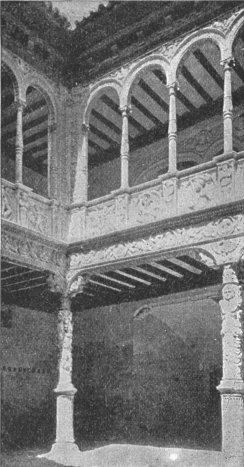
FIG. 196.—CASA DE ZAPORTA: COURTYARD.
THE GRIEGO-ROMANO. The more classic treatment of architectural
designs by the use of the orders was introduced by Alonzo
Berruguete (1480–1560?), who studied in Italy after 1503. The
Archbishop’s Palace and the Doric Gate of San Martino,
both at Toledo, were his work, as well as the first palace at Madrid.
The Palladio of Spain was, however, by Juan de Herrera (died
1597), the architect of Valladolid Cathedral, built under
Philip V. This vast edifice follows the general lines of the
earlier cathedrals of Jaen and Granada, but in a style of classical
correctness almost
351
severe in aspect, but well suited to the grand scale of the church. The
masterpiece of this period was the monastery of the Escurial,
begun by Juan Battista of Toledo, in 1563, but not completed
until nearly one hundred and fifty years later. Its final architectural
aspect was largely due to Herrera. It is a vast rectangle of 740 × 580
feet, comprising a complex of courts, halls, and cells, dominated by the
huge mass of the chapel. This last is an imposing domical church
covering 70,000 square feet, treated throughout with the Doric order,
and showing externally a lofty dome and campaniles with domical
lanterns, which serve to diversify the otherwise monotonous mass of the
monastery. What the Escurial lacks in grace or splendor is at least in a
measure redeemed by its majestic scale and varied sky-lines. The
Palace of Charles V. (Fig. 197), adjoining the Alhambra at
Granada, though begun as early as 1527 by Machuca, was mainly due
to Berruguete, and is an excellent example of the Spanish Palladian
style. With its circular court, admirable proportions and well-studied
details, this often maligned edifice deserves to be ranked among the
most successful examples of the style. During this period the cathedral
of Seville received many alterations, and the upper part of the
adjoining
352
Moorish tower of the Giralda, burned in 1395, was rebuilt by
Fernando Ruiz in the prevalent style, and with considerable
elegance and appropriateness of design.
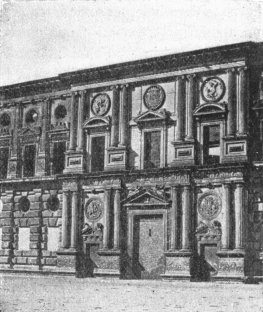
FIG. 197.—PALACE OF CHARLES V., GRANADA.
Of the Palace at Madrid, rebuilt by Philip V.
after the burning of the earlier palace in 1734, and mainly the work of
an Italian, Ivara; the Aranjuez palace (1739, by Francisco
Herrera), and the Palace at San Ildefonso, it need only be
said that their chief merit lies in their size and the absence of those
glaring violations of good taste which generally characterized the
successors of Churriguera. In ecclesiastical design these violations of
taste were particularly abundant and excessive, especially in the
façades and in the sanctuary—huge aggregations of misplaced and
vulgar detail, with hardly an unbroken pediment, column, or arch in the
whole. Some extreme examples of this abominable style are to be found in
the Spanish-American churches of the 17th and 18th centuries, as at
Chihuahua (Mexico), Tucson (Arizona), and other places. The least
offensive features of the churches of this period were the towers,
usually in pairs at the west end, some of them showing excellent
proportions and good composition in spite of their execrable
details.
Minor architectural works, such as the rood screens in the churches
of Astorga and Medina de Rio Seco, and many tombs at Granada, Avila,
Alcala, etc., give evidence of superior skill in decorative design,
where constructive considerations did not limit the exercise of the
imagination.
PORTUGAL. The Renaissance appears to have produced few notable
works in Portugal. Among the chief of these are the Tower, the
church, and the Cloister, at Belem. These display a riotous
profusion of minute carved ornament, with a free commingling of late
Gothic details, wearisome in the end in spite of the beauty of its
execution (1500–40?). The church of Santa Cruz at Coimbra,
and that of Luz, near Lisbon, are among the most noted of the
religious
353
monuments of the Renaissance, while in secular architecture the royal
palace at Mafra is worthy of mention.
MONUMENTS. (Mainly supplementary to preceding text.) Austria, Bohemia, etc.: At Prague, Schloss Stern,
1459–1565; Schwarzenburg Palace, 1544; Waldstein Palace, 1629;
Salvator Chapel, Vienna, 1515; Schloss Schalaburg, near Mölk,
1530–1601; Standehaus, Gratz, 1625. At Vienna: Imperial palace,
various dates; Schwarzenburg and Lichtenstein palaces, 18th century.
Germany, First Period: Schloss Baden, 1510–29 and part
1569–82; Schloss Merseburg, 1514, with late 16th-century portals;
Fuggerhaus at Augsburg, 1516; castles of Neuenstein, 1530–64;
Celle, 1532–46 (and enlarged, 1665–70); Dessau, 1533;
Leignitz, portal, 1533; Plagnitz, 1550; Schloss Gottesau, 1553–88;
castle of Güstrow, 1555–65; of Oels, 1559–1616; of Bernburg,
1565; of Heiligenburg, 1569–87; Münzhof at Munich, 1575; Lusthaus
(demolished) at Stuttgart, 1575; Wilhelmsburg Castle at Schmalkald,
1584–90; castle of Hämelschenburg, 1588–1612.—Second Period: Zunfthaus at Basle, 1578, in
advanced style; so also Juleum at Helmstädt, 1593–1612; gymnasium
at Brunswick, 1592–1613; Spiesshof at Basle, 1600; castle at
Berlin, 1600–1616, demolished in great part; castle Bevern, 1603;
Dantzic, Zeughaus, 1605; Wallfahrtskirche at Dettelbach, 1613; castle
Aschaffenburg, 1605–13; Schloss Weikersheim,
1600–83.—Third Period:
Zeughaus at Berlin, 1695; palace at Berlin by Schlüter, 1699–1706;
Catholic church, Dresden. (For Classic Revival, see next
chapter.)—Town Halls: At
Heilbronn, 1535; Görlitz, 1537; Posen, 1550; Mülhausen, 1552; Cologne,
porch with Corinthian columns and Gothic arches, 1569; Lübeck
(Rathhaushalle), 1570; Schweinfurt, 1570; Gotha, 1574; Emden,
1574–76; Lemgo, 1589; Neisse, 1604; Nordhausen, 1610; Paderborn,
1612–16; Gernsbach, 1617.
Spain, 16th Century: Monastery San Marcos at Leon; palace of
the Infanta, Saragossa; Carcel del Corte at Baez; Cath. of Malaga,
W. front, 1538, by de Siloë; Tavera Hospital, Toledo, 1541, by de
Bustamente; Alcazar at Toledo, 1548; Lonja (Town Hall) at Saragossa,
1551; Casa de la Sal, Casa Monterey, and Collegio de los Irlandeses, all
at Salamanca; Town Hall, Casa de los Taveras and upper part of Giralda,
all at Seville.—17th Century:
Cathedral del Pilar, Saragossa, 1677; Tower del Seo, 1685.—18th Century: palace at Madrid, 1735; at
Aranjuez, 1739; cathedral of Santiago, 1738; Lonja at Barcelona,
1772.
354
THE CLASSIC REVIVALS IN EUROPE.
Books Recommended: As before,
Fergusson. Also Chateau, Histoire et caractères de l’architecture en
France; and Lübke, Geschichte der Architektur. (For the most
part, however, recourse must be had to the general histories of
architecture, and to monographs on special cities or buildings.)
THE EIGHTEENTH CENTURY. By the end of the seventeenth century
the Renaissance, properly speaking, had run its course in Europe. The
increasing servility of its imitation of antique models had exhausted
its elasticity and originality. Taste rapidly declined before the growth
of the industrial and commercial spirit in the eighteenth century. The
ferment of democracy and the disquiet of far-reaching political changes
had begun to preoccupy the minds of men to the detriment of the arts. By
the middle of the eighteenth century, however, the extravagances of the
Rococo, Jesuit, and Louis XV. styles had begun to pall upon the popular
taste. The creative spirit was dead, and nothing seemed more promising
as a corrective for these extravagances than a return to classic models.
But the demand was for a literal copying of the arcades and porticos of
Rome, to serve as frontispieces for buildings in which modern
requirements should be accommodated to these antique exteriors, instead
of controlling the design. The result was a manifest gain in the
splendor of the streets and squares adorned by these highly decorative
frontispieces, but at the expense of convenience
355
and propriety in the buildings themselves. While this academic spirit
too often sacrificed logic and originality to an arbitrary symmetry and
to the supposed canons of Roman design, it also, on the other hand, led
to a stateliness and dignity in the planning, especially in the
designing of vestibules, stairs, and halls, which render many of the
public buildings it produced well worthy of study. The architecture of
the Roman Revival was pompous and artificial, but seldom trivial, and
its somewhat affected grandeur was a welcome relief from the dull
extravagance of the styles it replaced.
THE GREEK REVIVAL. The Roman revival was, however, displaced
in England and Germany by the Greek Revival, which set in near the close
of the eighteenth century. This was the result of a newly awakened
interest in the long-neglected monuments of Attic art which the
discoveries of Stuart and Revett—sent out in 1732 by the London
Society of Dilettanti—had once more made known to the world. It
led to a veritable furore in England for Greek Doric and Ionic
columns, which were applied indiscriminately to every class of
buildings, with utter disregard of propriety. The British taste was at
this time at its lowest ebb, and failed to perceive the poverty of Greek
architecture when deprived of its proper adornments of carving and
sculpture, which were singularly lacking in the British examples.
Nevertheless the Greek style in England had a long run of popular favor,
yielding only during the reign of the present sovereign to the so-called
Victorian Gothic, a revival of mediæval forms. In Germany the Greek
Revival was characterized by a more cultivated taste and a more rational
application of its forms, which were often freely modified to suit
modern needs. In France, where the Roman Revival under Louis XV. had
produced fairly satisfactory results, and where the influence of the
Royal School of Fine Arts (École des Beaux-Arts) tended to
perpetuate the
356
principles of Roman design, the Greek Revival found no footing. The
Greek forms were seen to be too severe and intractable for present
requirements. About 1830, however, a modified style of design,
known since as the Néo-Grec, was introduced by the exertions of a
small coterie of talented architects; and though its own life was short,
it profoundly influenced French art in the direction of freedom and
refinement for a long time afterward. In Italy there was hardly anything
in the nature of a true revival of either Roman or Greek forms. The few
important works of the late eighteenth and early nineteenth centuries
were conceived in the spirit of the late Renaissance, and took from the
prevalent revival of classicism elsewhere merely a greater correctness
of detail, not any radical change of form or spirit.
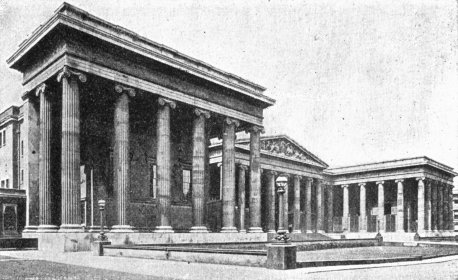
FIG. 198.—BRITISH MUSEUM, LONDON.
ENGLAND. There was, strictly speaking, no Roman revival in
Great Britain. The modified Palladian style of Wren and Gibbs and their
successors continued until superseded by the Greek revival. The first
fruit of the new movement seems to have been the Bank of England
at London, by Sir John Soane (1788). In this edifice the
Greco-Roman order of the round temple at Tivoli was closely copied, and
applied to a long façade, too low for its length and with no sufficient
stylobate, but fairly effective with its recessed colonnade and
unpierced walls. The British Museum, by Robert Smirke
(Fig. 198), was a more ambitious essay in a more purely Greek style. Its
colossal Ionic colonnade was, however, a mere frontispiece, applied
to a badly planned and commonplace building, from which it cut off
needed light. The more modest but appropriate columnar façade to the
Fitzwilliam Museum at Cambridge, by Bassevi, was a more
successful attempt in the same direction, better proportioned and
avoiding the incongruity of modern windows in several stories. These
have always been the stumbling-block of the revived Greek style. The
357
difficulties they raise are avoided, however, in buildings presenting
but two stories, the order being applied to the upper story, upon a high
stylobate serving as a basement. The High School and the Royal
Institution at Edinburgh, and the University at London, by
Wilkins, are for this reason, if for no other, superior to the
British Museum and other many-storied Anglo-Greek edifices. In spite of
all difficulties, however, the English extended the applications of the
style with doubtful success not only to all manner of public buildings,
but also to country residences. Carlton House, Bowden Park, and Grange
House are instances of this misapplication of Greek forms. Neither did
it prove more tractable for ecclesiastical purposes. St.
Pancras’s Church at London, and several churches by Thomson
(1817–75), in Glasgow, though interesting as experiments in such
adaptation, are not to be commended for imitation. The most successful
of all British Greek designs is perhaps St. George’s
358
Hall at Liverpool (Fig. 199), whose imposing peristyle and porches
are sufficiently Greek in spirit and detail to class it among the works
of the Greek Revival. But its great hall and its interior composition
are really Roman and not Greek, emphasizing the teaching of experience
that Greek architecture does not lend itself to the exigencies of modern
civilization to nearly the same extent as the Roman.
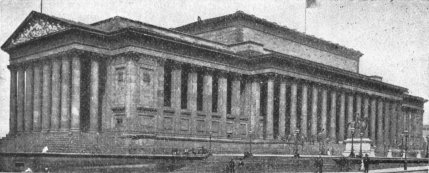
FIG. 199.—ST. GEORGE’S HALL, LIVERPOOL.
GERMANY. During the eighteenth century the classic revival in
Germany, which at first followed Roman precedents (as in the columns
carved with spirally ascending reliefs in front of the church of St.
Charles Borromeo, at Vienna), was directed into the channel of Greek
imitation by the literary works of Winckelmann, Lessing, Goethe, and
others, as well as by the interest aroused by the discoveries of Stuart
and Revett. The Brandenburg Gate at Berlin (1784, by Langhans)
was an early example of this Hellenism in architecture, and one of its
most successful applications to civic purposes. Without precisely
copying any Greek structure, it was evidently inspired from the Athenian
Propylæa, and nothing in its purpose is foreign to the style employed.
The greatest activity in the style came later, however, and was greatly
stimulated by the achievements of Fr. Schinkel (1771–1841),
one of the greatest of modern German architects.
359
While in the domical church of St. Nicholas at Potsdam, he employed
Roman forms in a modernized Roman conception, and followed in one or two
other buildings the principles of the Renaissance, his predilections
were for Greek architecture. His masterpiece was the Museum at
Berlin, with an imposing portico of 18 Ionic columns (Fig. 200). This
building with its fine rotunda was excellently planned, and forms, in
conjunction with the New Museum by Stuhler
(1843–55), a noble palace of art, to whose monumental
requirements and artistic purpose the Greek colonnades and pediments
were not inappropriate. Schinkel’s greatest successor was Leo von
Klenze (1784–1864), whose more textual reproductions of Greek
models won him great favor and wide employment. The Walhalla near
Ratisbon is a modernized Parthenon, internally vaulted with glass;
elegant externally, but too obvious a plagiarism to be greatly admired.
The Ruhmeshalle at Munich, a double L partly enclosing a colossal statue of Bavaria, and
devoted to the commemoration of Bavaria’s great men, is copied from no
Greek building, though purely Greek in design and correct to the
smallest detail. In the Glyptothek (Sculpture Gallery), in the
same city, the one distinctively
360
Greek feature introduced by Klenze, an Ionic portico, is also the one
inappropriate note in the design. The Propylæa at Munich, by the
same (Fig. 201), and the Court Theatre at Berlin, by Schinkel,
are other important examples of the style. The latter is externally one
of the most beautiful theatres in Europe, though less ornate than many.
Schinkel’s genius was here remarkably successful in adapting Greek
details to the exigent difficulties of theatre design, and there is no
suggestion of copying any known Greek building.
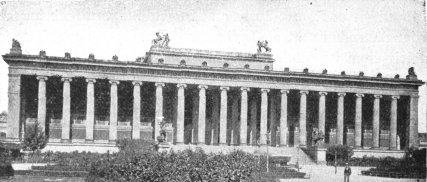
FIG. 200.—THE OLD MUSEUM, BERLIN.
In Vienna the one notable monument of the Classic Revival is the
Reichsrathsgebäude or Parliament House, by Th. Hansen
(1843), an imposing two-storied composition with a lofty central
colonnade and lower side-wings, harmonious in general proportions and
pleasingly varied in outline and mass.
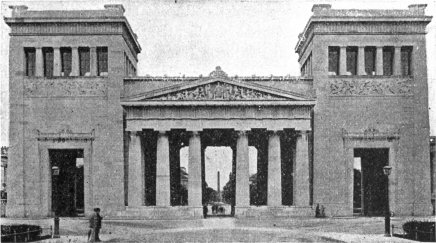
FIG. 201.—THE PROPYLÆA, MUNICH.
In general, the Greek Revival in Germany presents the aspect of a
sincere striving after beauty, on the part of a limited number of
artists of great talent, misled by the idea
361
that the forms of a dead civilization could be galvanized into new life
in the service of modern needs. The result was disappointing, in spite
of the excellent planning, admirable construction and carefully studied
detail of these buildings, and the movement here as elsewhere was
foredoomed to failure.
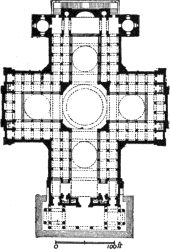
FIG. 202.—PLAN OF PANTHÉON, PARIS.
FRANCE. In France the Classic Revival, as we have seen, had
made its appearance during the reign of Louis XV. in a number of
important monuments which expressed the protest of their authors against
the caprice of the Rococo style then in vogue. The colonnades of the
Garde-Meuble, the façade of St. Sulpice, and the coldly beautiful
Panthéon (Figs. 202, 203) testified to the conviction in the most
cultured minds of the time that Roman grandeur was to be attained only
by copying the forms of Roman architecture with the closest possible
approach to correctness. In the Panthéon, the greatest ecclesiastical
monument of its time in France (otherwise known as the church of Ste.
Genéviève), the spirit of correct classicism dominates the interior as
well as the exterior. It is a Greek cross, measuring 362 × 267 feet,
with a dome 265 feet high, and internally 69 feet in diameter. The four
arms have domical vaulting and narrow aisles separated by Corinthian
columns. The whole interior is a cold but extremely elegant composition.
The most notable features of the exterior are its imposing portico of
colossal Corinthian columns and the fine peristyle which surrounds the
drum of the dome, giving it great dignity and richness of effect.
362
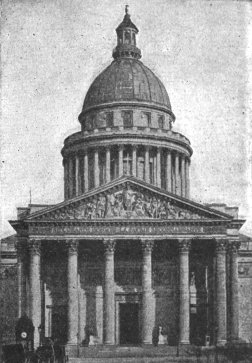
FIG. 203.—EXTERIOR OF PANTHÉON,
PARIS.
The dome, which is of stone throughout, has three shells, the
intermediate shell serving to support the heavy stone lantern. The
architect was Soufflot (1713–81). The Grand Théâtre,
at Bordeaux (1773, by Victor Louis), one of the largest and
finest theatres in Europe, was another product of this movement, its
stately colonnade forming one of the chief ornaments of the city. Under
Louis XVI. there was a temporary reaction from this somewhat pompous
affectation of antique grandeur; but there were few important buildings
erected during that unhappy reign, and the reaction showed itself mainly
in a more delicate and graceful style of interior decoration. It was
reserved for the Empire to set the seal of official approval on the
Roman Revival.
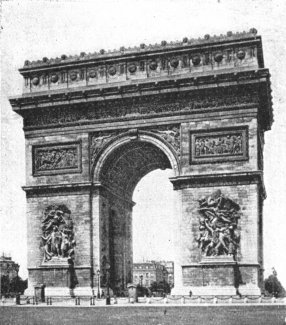
FIG. 204.—ARC DE L’ÉTOILE, PARIS.
The Arch of Triumph of the Carrousel, behind the Tuileries, by
Percier and Fontaine, the magnificent Arc de l’Étoile, at the
summit of the Avenue of the Champs Elysées, by Chalgrin; the wing
begun by Napoleon to connect the Tuileries with the Louvre on the land
side, and the church of the Madeleine, by Vignon, erected as a
temple to the heroes of the Grande Armée, were all designed, in
accordance with the expressed will of the Emperor himself, in a style as
Roman as the requirements
363
of each case would permit. All these monuments, begun between 1806 and
1809, were completed after the Restoration. The Arch of the
Carrousel is a close copy of Roman models; that of the
Étoile (Fig. 204) was a much more original design, of colossal
dimensions. Its admirable proportions, simple composition and striking
sculptures give it a place among the noblest creations of its class. The
Madeleine (Fig. 205), externally a Roman Corinthian temple of the
largest size, presents internally an almost Byzantine conception with
the three pendentive domes that vault its vast nave, but all the details
are Roman. However suitable for a pantheon or mausoleum, it seems
strangely inappropriate as a design for a Christian church. To these
monuments should be added the Bourse or Exchange, by
Brongniart, heavy in spite of its Corinthian peristyle, and the
river front of the Corps Législatif or Palais Bourbon, by
Poyet, the only extant example of a dodecastyle portico with a
pediment. All of these designs are characterized by great elegance of
detail and excellence of execution, and however inappropriate in style
to modern uses, they add immensely to the splendor of the French
capital. Unquestionably no feature can take the place of a Greek or
Roman
364
colonnade as an embellishment for broad avenues and open squares, or as
the termination of an architectural vista.
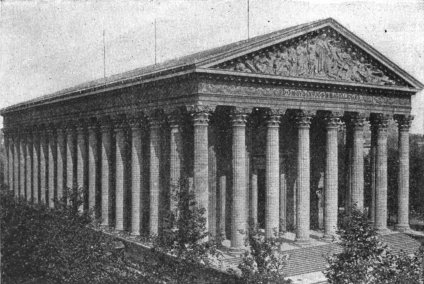
FIG. 205.—THE MADELEINE, PARIS.
The Greek revival took little hold of the Parisian imagination. Its
forms were too cold, too precise and fixed, too intractable to modern
requirements to appeal to the French taste. It counts but one notable
monument, the church of St. Vincent de Paul, by Hittorff,
who sought to apply to this design the principles of Greek external
polychromy; but the frescoes and ornaments failed to withstand the
Parisian climate, and were finally erased. The Néo-Grec movement already
referred to, initiated by Duc, Duban, and Labrouste about 1830, aimed
only to introduce into modern design the spirit and refinement, the
purity and delicacy of Greek art, not its forms (Fig. 206). Its chief
monuments were the remodelling, by Duc, of the Palais de
Justice, of which the new west façade is the most striking single
feature; the beautiful Library of the École des Beaux-Arts, by
Duban; the
365
library of Ste. Genéviève, by Labrouste, in which a long
façade is treated without a pilaster or column, simple arches over a
massive basement forming the dominant motive, while in the interior a
system of iron construction with glazed domes controls the design; and
the commemorative Colonne Juillet, by Duc, the most elegant and
appropriate of all modern memorial columns. All these buildings, begun
between 1830 and 1850 and completed at various dates, are distinguished
by a remarkable purity and freedom of conception and detail, quite
unfettered by the artificial trammels of the official academic style
then prevalent.
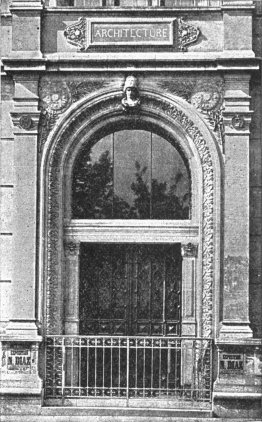
FIG. 206.—DOORWAY, ÉCOLE DES BEAUX-ARTS, PARIS.
THE CLASSIC REVIVAL ELSEWHERE. The other countries of Europe
have little to show in the way of imitations of classic monuments or
reproductions of Roman colonnades. In Italy the church of
S. Francesco di Paola, at Naples, in quasi-imitation of the
Pantheon at Rome, with wing-colonnades, and the Superga, at Turin
(1706, by Ivara); the façade of the San Carlo Theatre, at Naples,
and the Braccio Nuovo of the Vatican (1817, by Stern) are the
monuments which come the nearest to the spirit and style of the Roman
366
Revival. Yet in each of these there is a large element of originality
and freedom of treatment which renders doubtful their classification as
examples of that movement.
A reflection of the Munich school is seen in the modern public
buildings of Athens, designed in some cases by German architects, and in
others by native Greeks. The University, the Museum buildings, the
Academy of Art and Science, and other edifices exemplify fairly
successful efforts to adapt the severe details of classic Greek art to
modern windowed structures. They suffer somewhat from the too liberal
use of stucco in place of marble, and from the conscious affectation of
an extinct style. But they are for the most part pleasing and monumental
designs, adding greatly to the beauty of the modern city.
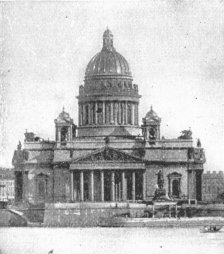
FIG. 207.—ST. ISAAC’S CATHEDRAL, ST. PETERSBURG.
In Russia, during and after the reign of Peter the Great
(1689–1725), there appeared a curious mixture of styles.
A style analogous to the Jesuit in Italy and the Churrigueresque in
Spain was generally prevalent, but it was in many cases modified by
Muscovite traditions into nondescript forms like those of the
Kremlin, at Moscow, or the less extravagant Citadel Church and
Smolnoy Monastery at St. Petersburg. Along with this heavy and barbarous
style, which prevails generally in the numerous palaces of the capital,
finished in stucco with atrocious details, a more severe and
classical spirit is met with. The church of the Greek Rite at St.
Petersburg
367
combines a Roman domical interior with an exterior of the Greek Doric
order. The Church of Our Lady of Kazan has a semicircular
colonnade projecting from its transept, copying as nearly as may be the
colonnades in front of St. Peter’s. But the greatest classic monument in
Russia is the Cathedral of St. Isaac (Fig. 207), at St.
Petersburg, a vast rectangular edifice with four Roman Corinthian
pedimental colonnades projecting from its faces, and a dome with a
peristyle crowning the whole. Despite many defects of detail, and the
use of cast iron for the dome, which pretends to be of marble, this is
one of the most impressive churches of its size in Europe. Internally it
displays the costliest materials in extraordinary profusion, while
externally its noble colonnades go far to redeem its bare attic and the
material of its dome. The Palace of the Grand Duke Michael, which
reproduces, with improvements, Gabriel’s colonnades of the Garde Meuble
at Paris on its garden front, is a nobly planned and commendable design,
agreeably contrasting with the debased architecture of many of the
public buildings of the city. The Admiralty with its Doric pilasters,
and the New Museum, by von Klenze of Munich, in a skilfully
modified Greek style, with effective loggias, are the only other
monuments of the classic revival in Russia which can find mention in a
brief sketch like this. Both are notable and in many respects admirable
buildings, in part redeeming the vulgarity which is unfortunately so
prevalent in the architecture of St. Petersburg.
The MONUMENTS of the Classic Revival have been referred to in
the foregoing text at sufficient length to preclude the necessity of
further enumeration here.
368
RECENT ARCHITECTURE IN EUROPE.
Books Recommended: As before, Chateau,
Fergusson. Also Barqui, L’Architecture moderne en
France.—Berlin und seine Bauten (and a series of
similar works on the modern buildings of other German cities). Daly,
Architecture privée du XIXe siècle. Garnier, Le nouvel
Opéra. Gourlier, Choix d’édifices publics. Licht,
Architektur Deutschlands. Lübke, Denkmäler der Kunst.
Lützow und Tischler, Wiener Neubauten. Narjoux, Monuments
élevés par la ville de Paris, 1850–1880. Rückwardt, Façaden
und Details modernen Bauten.—Sammelmappe hervorragenden
Concurrenz-Entwurfen. Sédille, L’Architecture moderne.
Selfridge, Modern French Architecture. Statham, Modern
Architecture. Villars, England, Scotland, and Ireland (tr.
Henry Frith). Consult also Transactions of the Royal Institute of
British Architects, and the leading architectural journals of recent
years.
MODERN CONDITIONS. The nineteenth century
has been pre-eminently an age of industrial progress. Its most striking
advances have been along mechanical, scientific, and commercial lines.
As a result of this material progress the general conditions of mankind
in civilized countries have undoubtedly been greatly bettered. Popular
education and the printing-press have also raised the intellectual level
of society, making learning the privilege of even the poorest.
Intellectual, scientific, and commercial pursuits have thus largely
absorbed those energies which in other ages found exercise in the
creation of artistic forms and objects. The critical and sceptical
spirit, the spirit of utilitarianism and realism, has checked the free
and general development of the creative imagination, at least in the
plastic arts. While
369
in poetry and music there have been great and noble achievements, the
plastic arts, including architecture, have only of late years attained a
position at all worthy of the intellectual advancement of the times.
Nevertheless the artistic spirit has never been wholly crushed out by
the untoward pressure of realism and commercialism. Unfortunately it has
repeatedly been directed in wrong channels. Modern archæology and the
publication of the forms of historic art by books and photographs have
too exclusively fastened attention upon the details of extinct styles as
a source of inspiration in design. The whole range of historic art is
brought within our survey, and while this has on the one hand tended
toward the confusion and multiplication of styles in modern work, it has
on the other led to a slavish adherence to historic precedent or a
literal copying of historic forms. Modern architecture has thus
oscillated between the extremes of archæological servitude and of an
unreasoning eclecticism. In the hands of men of inferior training the
results have been deplorable travesties of all styles, or meaningless
aggregations of ill-assorted forms.
An important factor in this demoralization of architectural design
has been the development of new constructive methods, especially in the
use of iron and steel. It has been impossible for modern designers, in
their treatment of style, to keep pace with the rapid changes in the
structural use of metal in architecture. The roofs of vast span, largely
composed of glass, which modern methods of trussing have made possible
for railway stations, armories, and exhibition buildings; the immense
unencumbered spaces which may be covered by them; the introduction and
development, especially in the United States, of the post-and-girder
system of construction for high buildings, in which the external walls
are a mere screen or filling-in; these have revolutionized architecture
so rapidly and completely
370
that architects are still struggling and groping to find the solution of
many of the problems of style, scale, and composition which they have
brought forward.
Within the last thirty years, however, architecture has, despite
these new conditions, made notable advances. The artistic emulation of
repeated international exhibitions, the multiplication of museums and
schools of art, the general advance in intelligence and enlightenment,
have all contributed to this artistic progress. There appears to be more
of the artistic and intellectual quality in the average architecture of
the present time, on both sides of the Atlantic, than at any previous
period in this century. The futility of the archæological revival of
extinct styles is generally recognized. New conditions are gradually
procuring the solution of the very problems they raise. Historic
precedent sits more lightly on the architect than formerly, and the
essential unity of principle underlying all good design is coming to be
better understood.26
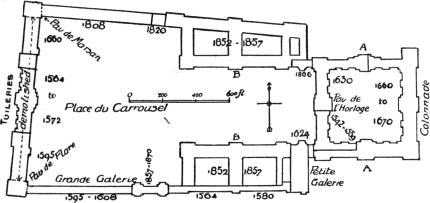
FIG. 208.—PLAN OF LOUVRE AND TUILERIES, PARIS.
A, A, the Old Louvre, so called; B, B, the New
Louvre.
FRANCE. It is in France, Germany (including Austria), and
England that the architectural progress of this period in Europe has
been most marked. We have already noticed the results of the classic
revivals in these three countries. Speaking broadly, it may be said that
in France the influence of the École des Beaux-Arts, while it has
tended to give greater unity and consistency to the national
architecture, and has exerted a powerful influence in behalf of
refinement of taste and correctness of style, has also stood in the way
of a free development of new ideas. French architecture has throughout
adhered to the principles of the Renaissance, though the style has
during this century been modified by various influences. The first of
these was the Néo-Grec movement, alluded to in the last chapter, which
broke the grip of Roman tradition in matters of detail and gave greater
elasticity to the national style. Next should be mentioned the Gothic
movement represented by Viollet-le-Duc,
371
Lassus, Ballu, and their followers. Beginning about 1845, it produced
comparatively few notable buildings, but gave a great impulse to the
study of mediæval archæology and the restoration of mediæval monuments.
The churches of Ste. Clothilde and of St. Jean de Belleville, at Paris,
and the reconstruction of the Château de Pierrefonds, were among its
direct results. Indirectly it led to a freer and more rational treatment
of constructive forms and materials than had prevailed with the academic
designers. The church of St. Augustin, by Baltard, at
Paris, illustrates this in its use of iron and brick for the dome and
vaulting, and the College Chaptal, by E. Train, in
its decorative treatment of brick and tile externally. The general
adoption of iron for roof-trusses and for the construction of markets
and similar buildings tended further in the same direction, the
Halles Centrales at Paris, by Baltard, being a notable
example.
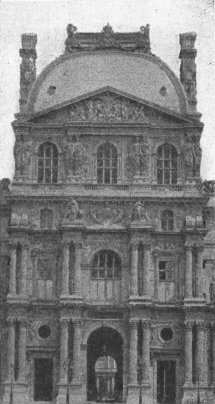
FIG. 209.—PAVILION OF RICHELIEU, LOUVRE.
THE SECOND EMPIRE. The reign of Napoleon III. (1852–70)
was a period of exceptional activity, especially in Paris. The greatest
monument of his reign was the completion of the Louvre and
Tuileries, under Visconti and
372
Lefuel, including the remodelling of the pavilions de Flore and
de Marsan. The new portions constitute the most notable example of
modern French architecture, and the manner in which the two palaces were
united deserves high praise. In spite of certain defects, this work is
marked by a combination of dignity, richness, and refinement, such as
are rarely found in palace architecture (Figs. 208, 209). The New
Opera (1863–75), by Garnier (d. 1898), stands next to the Louvre in importance as a national
monument. It is by far the most sumptuous building for amusement in
existence, but in purity of detail and in the balance and restraint of
its design it is inferior to the work of Visconti and Lefuel (Fig. 210).
To this reign belong the Palais de l’Industrie, by Viel, built
for the exhibition of 1855, and several great railway stations (Gare du
Nord, by Hitorff, Gare de l’Est, Gare d’Orléans, etc.), in which the
modern French version of the Renaissance was applied with considerable
skill to buildings largely constructed of iron and glass. Town halls and
theatres were erected in great numbers, and in decorative works like
fountains and monuments the French were particularly successful. The
fountains of St. Michel, Cuvier, and Molière, at Paris, and of
Longchamps, at Marseilles (Fig. 211),
373
illustrate the fertility of resource and elegance of detailed treatment
of the French in this department. Mention should also here be made of
the extensive enterprises carried out by Napoleon III., in rectifying
and embellishing the street-plan of Paris by new avenues and squares on
a vast scale, adding greatly to the monumental splendor of the city.
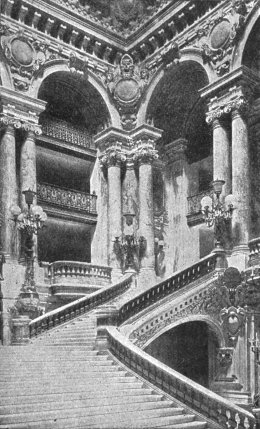
FIG. 210.—GRAND STAIRCASE OF THE OPERA,
PARIS.
THE REPUBLIC. Since the disasters of 1870 a number of
important structures have been erected, and French architecture has
shown a remarkable vitality and flexibility under new conditions. Its
productions have in general been marked by a refined taste and a
conspicuous absence of eccentricity and excess; but it has for the most
part trodden in well-worn paths. The most notable recent monuments are,
in church architecture, the Sacré-Cœur, at Montmartre, by
Abadie, a votive church inspired from the Franco-Byzantine
style of Aquitania; in civil architecture the new Hôtel de Ville,
at Paris, by Ballu and Déperthes, recalling the original
structure destroyed by the Commune, but in reality an original creation
of great merit; in scholastic
374
architecture the new École de Médecine, and the new Sorbonne, by
Nénot, and in other branches of the art the metal-and-glass
exhibition buildings of 1878, 1889, and 1900. In the last of these the
striving for originality and the effort to discard traditional forms
reached the extreme, although accompanied by much very clever detail and
a masterly use of color-decoration. To these should
be added many noteworthy theatres, town-halls, court-houses, and
préfectures in provincial cities, and commemorative columns and
monuments almost without number. In street architecture there is now
much more variety and originality than formerly, especially in private
houses, and the reaction against the orders and against traditional
methods of design has of late been growing stronger.
375
The chief excellence of modern French architecture lies in its rational
planning, monumental spirit, and refinement of detail (Fig. 212).
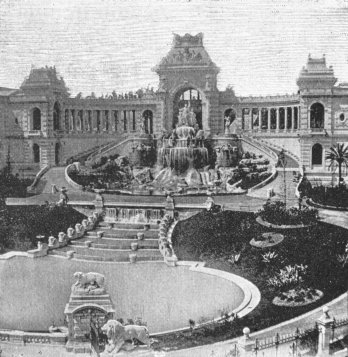
FIG. 211.—FOUNTAIN OF LONGCHAMPS, MARSEILLES.
GERMANY AND AUSTRIA. German architecture has been more
affected during the past fifty years by the archæological spirit than
has the French. A pronounced mediæval revival partly accompanied,
partly followed the Greek revival in Germany, and produced a number of
churches and a few secular buildings in the basilican, Romanesque, and
Gothic styles. These are less interesting than those
in the Greek style, because mediæval forms are even more foreign to
modern needs than the classic, being compatible only with systems of
design and construction which are no longer practicable. At Munich the
Auekirche, by Ohlmuller, in an attenuated Gothic style; the
Byzantine Ludwigskirche, and Ziebland’s Basilica following Early
Christian models; the Basilica by Hübsch, at Bulach, and the Votive Church at Vienna (1856) by
H. Von Ferstel (1828–1883) are notable neo-mediæval
monuments. The last-named church may be classed with Ste. Clothilde at
Paris (see p. 371), and St. Patrick’s
Cathedral at New York, all three being of approximately the same size
and general style, recalling St. Ouen at Rouen. They are correct and
elaborate, but more or less cold and artificial.
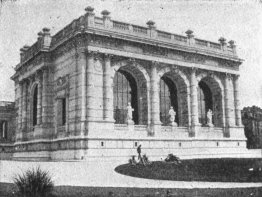
FIG. 212.—MUSÉE GALLIÉRA, PARIS.
More successful are many of the German theatres and concert halls, in
which Renaissance and classic forms have been freely used. In several of
these the attempt has been
376
made to express by the external form the curvilinear plan of the
auditorium, as in the Dresden Theatre, by Semper (1841;
Fig. 213), the theatre at Carlsruhe, by Hübsch, and the double
winter-summer Victoria Theatre, at Berlin, by Titz. But
the practical and æsthetic difficulties involved in this treatment have
caused its general abandonment. The Opera House at Vienna, by
Siccardsburg and Van der Null (1861–69), is
rectangular in its masses, and but for a certain triviality of detail
would rank among the most successful buildings of its kind. The new
Burgtheater in the same city is a more elaborately ornate
structure in Renaissance style, somewhat florid and overdone.
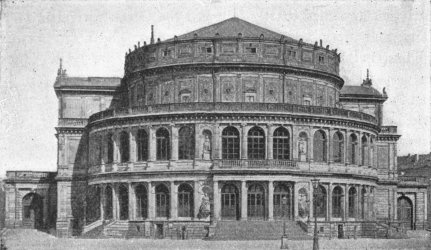
FIG. 213.—THEATRE AT DRESDEN.
Modern German architecture is at its best in academic and residential
buildings. The Bauschule, at Berlin, by Schinkel, in
which brick is used in a rational and dignified design without the
orders; the Polytechnic School, at Zürich, by Semper; university
buildings, and especially buildings for technical instruction, at
Carlsruhe, Stuttgart, Strasburg, Vienna, and other cities, show a
monumental
377
treatment of the exterior and of the general distribution, combined with
a careful study of practical requirements. In administrative buildings
the Germans have hardly been as successful; and the new Parliament
House, at Berlin, by Wallot, in spite of its splendor and
costliness, is heavy and unsatisfactory in detail. The larger cities,
especially Berlin, contain many excellent examples of house
architecture, mostly in the Renaissance style, sufficiently monumental
in design, though usually, like most German work, inclined to heaviness
of detail. The too free use of stucco in imitation of stone is also open
to criticism.
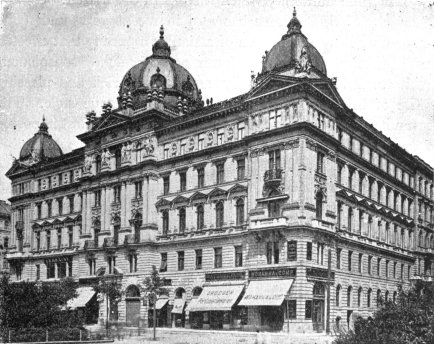
FIG. 214.—BLOCK OF DWELLINGS (MARIE-THERESIENHOF), VIENNA.
VIENNA. During the last thirty years Vienna has undergone a
transformation which has made it the rival of Paris as a stately
capital. The remodelling of the central portion, the creation of a
series of magnificent boulevards and
378
squares, and the grouping of the chief state and municipal buildings
about these upon a monumental scheme of arrangement, have given the city
an unusual aspect of splendor. Among the most important monuments in
this group are the Parliament House, by Hansen (see p. 360), and the Town Hall, by
Schmidt. This latter is a Neo-Gothic edifice of great size and
pretentiousness, but strangely thin and meagre in detail, and quite out
of harmony with its surroundings. The university and museums are massive
piles in Renaissance style; and it is the Renaissance rather than the
classic or Gothic revival which prevails throughout the new city. The
great blocks of residences and apartments (Fig. 214) which line its
streets are highly ornate in their architecture, but for the most part
done in stucco, which fails after all to give the aspect of solidity and
durability which it seeks to counterfeit.
The city of Buda-Pesth has also in recent years undergone a
phenomenal transformation of a similar nature to that effected in
Vienna, but it possesses fewer monuments of conspicuous architectural
interest. The Synagogue is the most noted of these, a rich
and pleasing edifice of brick in a modified Hispano-Moresque style.
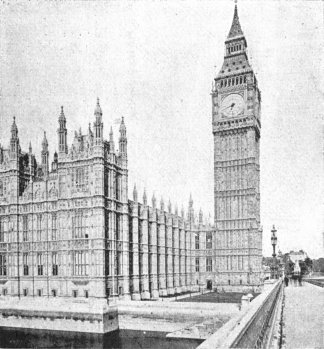
FIG. 215.—HOUSES OF PARLIAMENT, WESTMINSTER,
LONDON.
GREAT BRITAIN. During the closing years of the Anglo-Greek
style a coterie of enthusiastic students of British mediæval
monuments—archæologists rather than architects—initiated a
movement for the revival of the national Gothic architecture. The first
fruits of this movement, led by Pugin, Brandon, Rickman, and others
(about 1830–40), were seen in countless pseudo-Gothic structures
in which the pointed arches, buttresses, and clustered shafts of
mediæval architecture were imitated or parodied according to the
designer’s ability, with frequent misapprehension of their proper use or
significance. This unintelligent misapplication of Gothic forms was,
however, confined to the earlier stages of the movement. With increasing
light and experience
379
came a more correct and consistent use of the mediæval styles, dominated
by the same spirit of archæological correctness which had produced the
classicismo of the Late Renaissance in Italy. This spirit,
stimulated by extensive enterprises in the restoration of the great
mediæval monuments of the United Kingdom, was fatal to any free and
original development of the style along new lines. But it rescued church
architecture from the utter meanness and debasement into which it had
fallen, and established a standard of taste which reacted on all other
branches of design.
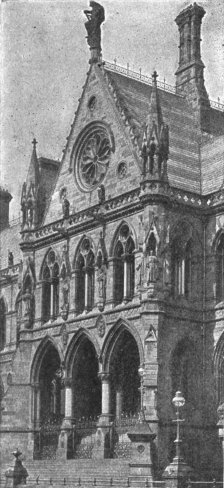
FIG. 216.—ASSIZE COURTS, MANCHESTER. DETAIL.
THE VICTORIAN GOTHIC. Between 1850 and 1870 the striving after
archæological correctness gave place to the more rational effort to
adapt Gothic principles to modern
380
requirements, instead of merely copying extinct styles. This effort,
prosecuted by a number of architects of great intelligence, culture, and
earnestness (Sir Gilbert Scott, George Edmund Street, William Burges,
and others), resulted in a number of extremely interesting buildings.
Chief among these in size and cost stand the Parliament Houses at
Westminster, by Sir Charles Barry (begun 1839), in the
Perpendicular style. This immense structure (Fig. 215), imposing in its
simple masses and refined in its carefully studied detail, is the most
successful monument of the Victorian Gothic style. It suffers, however,
from the want of proper relation of scale between its decorative
elements and the vast proportions of the edifice, which belittle its
component elements. It cannot, on the whole, be claimed as a successful
vindication of the claims of the promoters of the style as to the
adaptability of Gothic forms to structures planned and built after the
modern fashion. The Assize Courts at Manchester (Fig. 216), the
New Museum at Oxford, the gorgeous Albert Memorial at
London, by Scott, and the New Law Courts at London, by
Street, are
381
all conspicuous illustrations of the same truth. They are conscientious,
carefully studied designs in good taste, and yet wholly unsuited in
style to their purpose. They are like labored and scholarly verse in a
foreign tongue, correct in form and language, but lacking the
naturalness and charm of true and unfettered inspiration. A later
essay of the same sort in a slightly different field is the Natural
History Museum at South Kensington, by Waterhouse (1879), an
imposing building in a modified Romanesque style (Fig. 217).
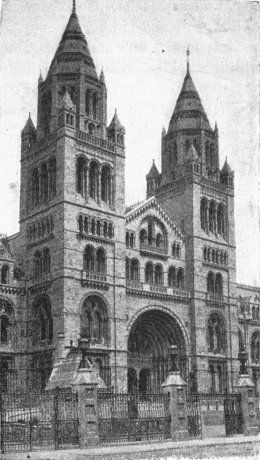
FIG. 217.—NATURAL HISTORY MUSEUM, LONDON.
OTHER WORKS. The Victorian Gothic style responded to no deep
and general movement of the popular taste, and, like the Anglo-Greek
style, was doomed to failure from the inherent incongruity between
modern needs and mediæval forms. Within the last twenty years there has
been a quite general return to Renaissance principles, and the result is
seen in a large number of town-halls, exchanges, museums, and colleges,
in which Renaissance forms, with and without the orders, have been
treated with increasing freedom and skilful
382
adaptation to the materials and special requirements of each case. The
Albert Memorial Hall (1863, by General Scott) may be taken as an early
instance of this movement, and the Imperial Institute (Colonial
offices), by Collcutt, and Oxford Town Hall, by Aston Webb, as among its
latest manifestations. In domestic architecture the so-called Queen Anne
style has been much in vogue, as practised by Norman Shaw, Ernest
George, and others. It is really a modern style, originating in the
imitation of the modified Palladian style as used in the brick
architecture of Queen Anne’s time, but freely and often artistically
altered to meet modern tastes and needs.
In its emancipation from the mistaken principles of archæological
revivals, and in its evidences of improved taste and awakened
originality, contemporary British architecture shows promise of good
things to come. It is still inferior to the French in the monumental
quality, in technical resource and refinement of decorative detail.
ELSEWHERE IN EUROPE. In other European countries recent
architecture shows in general increasing freedom and improved good
taste, but both its opportunities and its performance have been nowhere
else as conspicuous as in France, Germany, and England. The costly
Bourse and the vast but overloaded Palais de Justice at Brussels, by
Polaert, are neither of them conspicuous for refined and
cultivated taste. A few buildings of note in Switzerland, Russia,
and Greece might find mention in a more extended review of architecture,
but cannot here even be enumerated. In Italy, especially at Rome, Milan,
Naples, and Turin, there has been a great activity in building since
1870, but with the exception of the Monument to Victor Emmanuel
and the National Museum at Rome, monumental arcades and passages at
Milan and Naples, and Campi Santi or monumental cemeteries at
Bologna, Genoa, and one or two other places, there has been almost
nothing of real importance built in Italy of late years.
383
ARCHITECTURE IN THE UNITED STATES.
Books Recommended: As before,
Fergusson, Statham. Also, Chandler, The Colonial Architecture of
Maryland, Pennsylvania, and Virginia. Cleaveland and Campbell,
American Landmarks. Corner and Soderholz, Colonial
Architecture in New England. Crane and Soderholz, Examples of
Colonial Architecture in Charleston and Savannah. Drake, Historic
Fields and Mansions of Middlesex. Everett, Historic Churches of
America. King, Handbook of Boston; Handbook of New
York. Little, Early New England Interiors. Schuyler,
American Architecture. Van Rensselaer, H. H. Richardson
and His Works. Wallis, Old Colonial Architecture and
Furniture.
GENERAL REMARKS. The colonial architecture of modern times
presents a peculiar phenomenon. The colonizing nation, carrying into its
new habitat the tastes and practices of a long-established
civilization, modifies these only with the utmost reluctance, under the
absolute compulsion of new conditions. When the new home is virgin soil,
destitute of cultivation, government, or civilized inhabitants, the
accompaniments and activities of civilization introduced by the
colonists manifest themselves at first in curious contrast to the
primitive surroundings. The struggle between organized life and chaos,
the laborious subjugation of nature to the requirements of our complex
modern life, for a considerable period absorb the energies of the
colonists. The amenities of culture, the higher intellectual life, the
refinements of art can, during this period, receive little
384
attention. Meanwhile a new national character is being formed; the
people are undergoing the moral training upon which their subsequent
achievements must depend. With the conquest of brute nature, however,
and the gradual emergence of a more cultivated class, with the growth of
commerce and wealth and the consequent increase of leisure, the
humanities find more place in the colonial life. The fine arts appear in
scattered centres determined by peculiarly favorable conditions. For a
long time they retain the impress, and seek to reproduce the forms, of
the art of the mother country. But new conditions impose a new
development. Maturing commerce with other lands brings in foreign
influences, to which the still unformed colonial art is peculiarly
susceptible. Only with political and commercial independence, fully
developed internal resources, and a high national culture do the arts
finally attain, as it were, their majority, and enter upon a truly
national growth.
These facts are abundantly illustrated by the architectural history
of the United States. The only one among the British colonies to attain
political independence, it is the only one among them whose architecture
has as yet entered upon an independent course of development, and this
only within the last twenty-five or thirty years. Nor has even this
development produced as yet a distinctive local style. It has, however,
originated new constructive methods, new types of buildings, and a
distinctively American treatment of the composition and the masses; the
decorative details being still, for the most part, derived from historic
precedents. The architecture of the other British colonies has retained
its provincial character, though producing from time to time individual
works of merit. In South America and Mexico the only buildings of
importance are Spanish, French, or German in style, according to the
nationality of the architects employed. The following
385
sketch of American architecture refers, therefore, exclusively to its
development in the United States.
FORMATIVE PERIOD. Buildings in stone were not undertaken by
the early English colonists. The more important structures in the
Southern and Dutch colonies were of brick imported from Europe. Wood
was, however, the material most commonly employed, especially in New
England, and its use determined in large measure the form and style of
the colonial architecture. There was little or no striving for
architectural elegance until well into the eighteenth century, when
Wren’s influence asserted itself in a modest way in the Middle and
Southern colonies. The very simple and unpretentious town-hall at
Williamsburg, Va., and St. Michael’s, Charleston, are attributed to him;
but the most that can be said for these, as for the brick churches and
manors of Virginia previous to 1725, is that they are simple in design
and pleasing in proportion, without special architectural elegance. The
same is true of the wooden houses and churches of New England of the
period, except that they are even simpler in design.
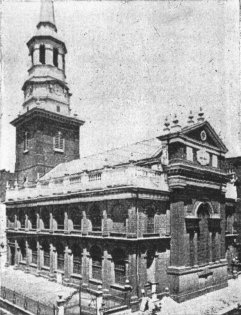
FIG. 218.—CHRIST CHURCH, PHILADELPHIA.
From 1725 to 1775 increased population and wealth along the coast
brought about a great advance in architecture, especially in churches
and in the dwellings of the wealthy. During this period was developed
the Colonial style, based on that of the reigns of Anne and the
first two Georges in England, and in church architecture on the models
set by Wren and Gibbs. All the details were, however, freely modified by
the general employment of wood. The scarcity of architects trained in
Old World traditions contributed to this departure from classic
precision of form. The style, especially in interior design, reflected
the cultured taste of the colonial aristocracy in its refined treatment
of the woodwork. But there was little or no architecture of a truly
monumental character. Edifices of stone were singularly few, and
administrative buildings were small and modest,
386
owing to insufficient grants from the Crown, as well as to the poverty
of the colonies.
The churches of this period include a number of interesting designs,
especially pleasing in the forms of their steeples. The “Old
South” at Boston (now a museum), Trinity at Newport, and St.
Paul’s at New York—one of the few built of stone
(1764)—are good examples of the style. Christ Church at
Philadelphia (1727–35, by Dr. Kearsley) is another example,
historically as well as architecturally interesting (Fig. 218); and
there are scores of other churches almost equally noteworthy, scattered
through New England, Maryland, Virginia, and the Middle States.
DWELLINGS. These reflect better than the churches the varying
tastes of the different colonies. Maryland and Virginia abound in fine
brick manor-houses, set amid extensive grounds walled in and entered
through iron gates of artistic design. The interior finish of these
houses was often elaborate in conception and admirably executed.
Westover (1737), Carter’s Grove (1737) in Virginia, and the Harwood and
Hammond Houses at Annapolis, Md. (1770), are examples. The majority of
the New England houses were of wood, more compact in plan, more varied
and picturesque in design than those of the South, but wanting somewhat
of their stateliness.
387
The interior finish of wainscot, cornices, stairs, and mantelpieces
shows, however, the same general style, in a skilful and artistic
adaptation of classic forms to the slender proportions of wood
construction. Externally the orders appear in porches and in colossal
pilasters, with well designed entablatures, and windows of Italian
model. The influence of the Adams and Sheraton furniture is
doubtless to be seen in these quaint and often charming versions of
classic motives. The Hancock House, Boston (of stone, demolished); the
Sherburne House, Portsmouth (1730); Craigie House, Cambridge (1757, Fig.
219); and Rumford House, North Woburn (Mass.), are typical examples.
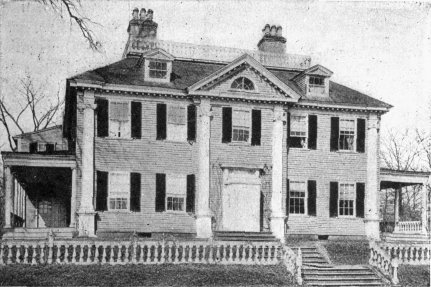
FIG. 219.—CRAIGIE (LONGFELLOW) HOUSE, CAMBRIDGE.
In the Middle States architectural activity was chiefly centred in
Philadelphia and New York, and one or two other towns, where a number of
manor-houses, still
388
extant, attest the wealth and taste of the time. It is noticeable that
the veranda or piazza was confined to the Southern States, but that the
climate seems to have had little influence on the forms of roofs. These
were gambrelled, hipped, gabled, or flat, alike in the North and South,
according to individual taste.
PUBLIC BUILDINGS. Of public and monumental architecture this
period has little to show. Large cities did not exist; New York, Boston,
and Philadelphia were hardly more than overgrown villages. The public
buildings—court-houses and town-halls—were modest and
inexpensive structures. The Old State House and Faneuil Hall at Boston,
the Town Hall at Newport (R.I.), and Independence Hall at Philadelphia,
the best known of those now extant, are not striking architecturally.
Monumental design was beyond the opportunities and means of the
colonies. It was in their churches, all of moderate size, and in their
dwellings that the colonial builders achieved their greatest successes;
and these works are quaint, charming, and refined, rather than
impressive or imposing.
To the latter part of the colonial period belong a number of
interesting buildings which remain as monuments of Spanish rule in
California, Florida, and the Southwest. The old Fort S. Marco, now
Fort Marion (1656–1756), and the Catholic cathedral (1793; after
the fire of 1887 rebuilt in its original form with the original façade
uninjured), both at St. Augustine, Fla.; the picturesque buildings of
the California missions (mainly 1769–1800), the majority of them
now in ruins; scattered Spanish churches in California, Arizona, and New
Mexico, and a few unimportant secular buildings, display among their
modern and American settings a picturesque and interesting Spanish
aspect and character, though from the point of view of architectural
detail they represent merely a crude phase of the Churrigueresque
style.
389
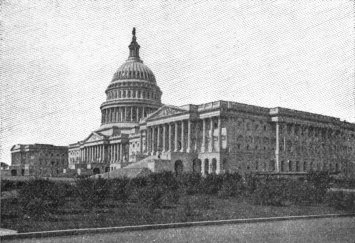
FIG. 220.—NATIONAL CAPITOL, WASHINGTON.
EARLY REPUBLICAN PERIOD. Between the Revolution and the War of
1812, under the new conditions of independence and self-government,
architecture took on a more monumental character. Buildings for the
State and National administrations were erected with the rapidly
increasing resources of the country. Stone was more generally used;
colonnades, domes, and cupolas or bell-towers, were adopted as
indispensable features of civic architecture. In church-building the
Wren-Gibbs type continued to prevail, but with greater correctness of
classic forms. The gambrel roof tended to disappear from the houses of
this period, and there was some decline in the refinement and delicacy
of the details of architecture. The influence of the Louis XVI. style is
traceable in many cases, as in the New York City Hall (1803–12, by
McComb and Mangin), one of the very best designs of the
time, and in the delicate stucco-work and interior finish of many
houses, The original Capitol at Washington—the central
portion of the present edifice—by Thornton, Hallet,
and B. H. Latrobe (1793–1830; Fig. 220),
390
the State House at Boston (1795, by Bulfinch), and the
University of Virginia, at Charlotteville, by Thomas Jefferson
(1817; recently destroyed in part by fire), are the most interesting
examples of the classic tendencies of this period. Their freedom from
the rococo vulgarities generally prevalent at the time in Europe is
noticeable.
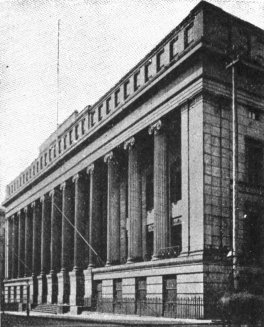
FIG. 221.—CUSTOM HOUSE, NEW YORK.
THE CLASSIC REVIVAL. The influence of the classic revivals of
Europe began to appear before the close of this period, and reached its
culmination about 1830–40. It left its impress most strongly on
our Federal architecture, although it invaded domestic architecture,
producing countless imitations, in brick and wooden houses, of Grecian
colonnades and porticos. One of its first-fruits was the White House, or
Executive Mansion, at Washington, by Hoban (1792), recalling the
large English country houses of the time. The Treasury and
Patent Office buildings at Washington, the Philadelphia Mint, the
Sub-treasury and Custom House at New York (the latter
erected originally for a bank; Fig. 221), and the Boston Custom
House are among the important Federal buildings of this period.
Several State capitols were also erected under the same influence; and
the Marine Exchange and Girard College at Philadelphia should
also be mentioned
391
as conspicuous examples of the pseudo-Greek style. The last-named
building is a Corinthian dormitory, its tiers of small windows
contrasting strangely with its white marble columns. These classic
buildings were solidly and carefully constructed, but lacked the grace,
cheerfulness, and appropriateness of earlier buildings. The Capitol at
Washington was during this period greatly enlarged by terminal wings
with fine Corinthian porticos, of Roman rather than Greek design. The
Dome, by Walters, was not added until 1858–73; it is
a successful and harmonious composition, nobly completing the building.
Unfortunately, it is an afterthought, built of iron painted to simulate
marble, the substructure being inadequate to support a dome of masonry.
The Italian or Roman style which it exemplified, in time superseded the
less tractable Greek style.
THE WAR PERIOD. The period from 1850 to 1876 was one of
intense political activity and rapid industrial progress. The former
culminated in the terrible upheaval of the civil war; the latter in the
completion of the Pacific Railroad (1869) and a remarkable development
of the mining resources and manufactures of the country. It was a period
of feverish commercial activity, but of artistic stagnation, and
witnessed the erection of but few buildings of architectural importance.
A number of State capitols, city halls and churches, of
considerable size and cost but of inferior design, attest the decline of
public taste and architectural skill during these years. The huge
Municipal Building at Philadelphia and the still unfinished Capitol at
Albany are full of errors of planning and detail which twenty-five years
of elaboration have failed to correct. Next to the dome of the Capitol
at Washington, completed during this period, of which it is the most
signal architectural achievement, its most notable monument was the
St. Patrick’s Cathedral at New York, by Renwick;
a Gothic church which, if somewhat cold and mechanical in detail,
is
392
a stately and well-considered design. Its west front and spires
(completed 1886) are particularly successful. Trinity Church (1843, by
Upjohn) and Grace Church (1840, by Renwick), though of earlier
date, should be classed with this cathedral as worthy examples of modern
Gothic design. Indeed, the churches designed in this style by a few
thoroughly trained architects during this period are the most creditable
and worthy among its lesser productions. In general an undiscriminating
eclecticism of style prevailed, unregulated by sober taste or technical
training. The Federal buildings by Mullett were monuments of
perverted design in a heavy and inartistic rendering of French
Renaissance motives. The New York Post Office and the State, Army and
Navy Department building at Washington are examples of this style.
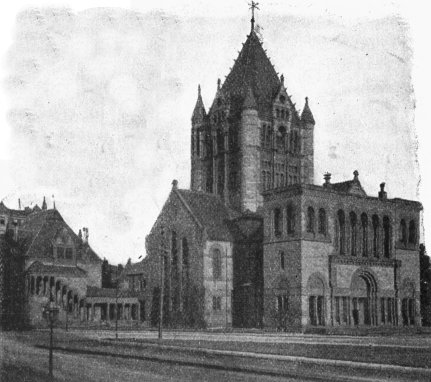
FIG. 222.—TRINITY CHURCH, BOSTON.
THE ARTISTIC AWAKENING. Between 1870 and 1880 a remarkable
series of events exercised a powerful influence on the artistic life of
the United States. Two terrible conflagrations in Chicago (1871) and
Boston (1872) gave unexampled opportunities for architectural
improvement and greatly stimulated the public interest in the art. The
feverish and abnormal industrial activity which followed the war and the
rapid growth of the parvenu spirit were checked by the disastrous
“panic” of 1873. With the completion of the Pacific railways and the
settlement of new communities in the West, industrial prosperity, when
it returned, was established on a firmer basis. An extraordinary
expansion of travel to Europe began to disseminate the seeds of artistic
culture throughout the country. The successful establishment of schools
of architecture in Boston (1866) and other cities, and the opening or
enlargement of art museums in New York, Boston, Philadelphia, Baltimore,
Detroit, Milwaukee, and elsewhere, stimulated the artistic awakening
which now manifested itself. In architecture the personal influence of
two men, trained in the Paris École des Beaux-Arts,
393
was especially felt—of R. M. Hunt (1827–95)
through his words and deeds quite as much as through his works; and of
H. H. Richardson (1828–86) predominantly through his
works. These two men, with others of less fame but of high ideals and
thorough culture, did much to elevate architecture as an art in the
public esteem. To all these influences new force was added by the
Centennial Exhibition at Philadelphia (1876). Here for the first time
the American people were brought into contact, in their own land, with
the products of European and Oriental art. It was to them an artistic
revelation, whose results were prompt and far-reaching. Beginning first
in the domain of industrial and decorative art, its stimulating
influence rapidly extended to painting and architecture, and with
permanent consequences. American students began to throng the centres of
Old World art, while the setting of higher standards of artistic
excellence at home, and the development of important art-industries,
were other fruits of this artistic awakening. The recent Columbian
Exhibition at Chicago (1893), its latest and most important
manifestation, has added a new impulse to the movement, especially in
architecture.
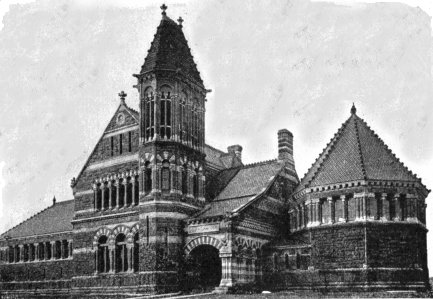
FIG. 223.—LIBRARY AT WOBURN, MASS.
STYLE IN RECENT ARCHITECTURE. The rapid increase in the number
of American architects trained in Paris or under the indirect influence
of the École des Beaux-Arts has been an important factor in recent
architectural progress. Yet it has by no means imposed the French
academic formulæ upon American architecture. The conditions, materials,
and constructive processes here prevailing, and above all the
eclecticism of the public taste, have prevented this. The French
influence is perceived rather in a growing appreciation of monumental
design in the planning, composition, and setting of buildings, than in
any direct imitation of French models. The Gothic revival which
prevailed more or less widely from 1840 to 1875, as already noticed, and
of which the State Capitol at Hartford
394
(Conn.; 1875–78), and the Fine Arts Museum at Boston, were
among the last important products, was generally confined to church
architecture, for which Gothic forms are still largely employed, as in
the Protestant Cathedral of All Saints now building at
Albany (N.Y.), by an English architect. For the most part the works of
the last twenty years show a more or less judicious eclecticism, the
choice of style being determined partly by the person and training of
the designer, partly by the nature of the building. The powerfully
conceived works of Richardson, in a free version of the French
Romanesque, for a time exercised a wide influence, especially among the
younger architects. Trinity Church, Boston (Fig. 222), his earliest important work; many public
libraries and business buildings, and finally the impressive County
Buildings at Pittsburgh (Pa.), all
395
treated in this style, are admirable rather for the strong individuality
of their designer, displayed in their vigorous composition, than on
account of the historic style he employed (Fig. 223). Yet it appeared in
his hands so flexible and effective that it was widely imitated. But if
easy to use, it is most difficult to use well; its forms are too massive
for ordinary purposes, and in the hands of inferior designers it was so
often travestied that it has now lost its wide popularity. While a
number of able architects have continued to use it effectively in
ecclesiastical, civic, and even commercial architecture, it is being
generally superseded by various forms of the Renaissance. Here also a
wide eclecticism prevails, the works of the same architect often varying
from the gayest Francis I. designs in domestic architecture, or
free adaptations of Quattrocento details for theatres and street
architecture, to the most formal classicism in colossal
exhibition-buildings, museums, libraries, and the like. Meanwhile there
are many more or less successful ventures in other historic
396
styles applied to public and private edifices. Underlying this apparent
confusion, almost anarchy in the use of historic styles, the careful
observer may detect certain tendencies crystallizing into definite form.
New materials and methods of construction, increased attention to
detail, a growing sense of monumental requirements, even the
development of the elevator as a substitute for the grand staircase, are
leaving their mark on the planning, the proportions, and the artistic
composition of American buildings, irrespective of the styles used. The
art is with us in a state of transition, and open to criticism in many
respects; but it appears to be full of life and promise for the
future.
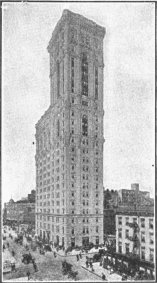
FIG. 224.—“TIMES” BUILDING, NEW YORK.
COMMERCIAL BUILDINGS. This class of edifices has in our great
cities developed wholly new types, which have taken shape under four
imperative influences. These are the demand for fire-proof construction,
the demand for well-lighted offices, the introduction of elevators, and
the concentration of business into limited areas, within which land has
become inordinately costly. These causes have led to the erection of
buildings of excessive height (Fig. 224); the more recent among them
constructed with a framework of iron or steel columns and beams, the
visible walls being a mere filling-in. To render a building of twenty
stories attractive to the eye, especially when built on an irregular
site, is a difficult problem, of which a wholly satisfactory solution
has yet to be found. There have been, however, some notable achievements
in this line, in most of which the principle has been clearly recognized
that a lofty building should have a well-marked
397
basement or pedestal and a somewhat ornate crowning portion or capital,
the intervening stories serving as a die or shaft and being treated with
comparative simplicity. The difficulties of scale and of handling one
hundred and fifty to three hundred windows of uniform style have been
surmounted with conspicuous skill (American Surety Building and
Broadway Chambers, New York; Ames Building, Boston; Carnegie Building,
Pittsburgh; Union Trust, St. Louis). In some cases, especially in
Chicago and the Middle West, the metallic framework is suggested by
slender piers between the windows, rising uninterrupted from the
basement to the top story. In others, especially in New York and the
East, the walls are treated as in ordinary masonry buildings. The
Chicago school is marked by a more utilitarian and unconventional
treatment, with results which are often extremely bold and effective,
but rarely as pleasing to the eye as those attained by the more
conservative Eastern school. In the details of American office-buildings
every variety of style is to be met with; but the Romanesque and the
Renaissance, freely modified, predominate. The tendency towards two or
three well-marked types in the external composition of these buildings,
as above suggested, promises, however, the evolution of a style in which
the historic origin of the details will be a secondary matter. Certain
Chicago architects have developed an original treatment of architectural
forms by exaggerating some of the structural lines, by suppressing the
mouldings and more familiar historic forms, and by the free use of flat
surface ornament. The Schiller, Auditorium, and Fisher Buildings, all at
Chicago, Guaranty Building, Buffalo, and Majestic Building, Detroit, are
examples of this personal style, which illustrates the untrammelled
freedom of the art in a land without traditions.27
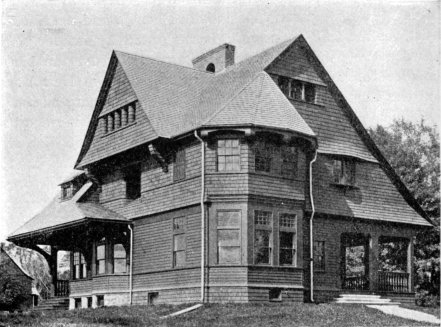
FIG. 225.—COUNTRY HOUSE, MASSACHUSETTS.
DOMESTIC ARCHITECTURE. It is in this field that the most
characteristic and original phases of American architecture
398
are to be met with, particularly in rural and suburban residences. In
these the peculiar requirements of our varying climates and of American
domestic life have been studied and in large measure met with great
frankness and artistic appreciation. The broad staircase-hall, serving
often as a sort of family sitting-room, the piazza, and a picturesque
massing of steep roofs, have been the controlling factors in the
evolution of two or three general types which appear in infinite
variations. The material most used is wood, but this has had less
influence in the determination of form than might have been expected.
The artlessness of the planning, which is arranged to afford the maximum
of convenience rather than to conform to any traditional type, has been
the element of greatest artistic success. It has resulted in exteriors
which are the natural outgrowth of
399
the interior arrangements, frankly expressed, without affectation of
style (Fig. 225). The resulting picturesqueness has, however, in many
cases been treated as an end instead of an incidental result, and the
affectation of picturesqueness has in such designs become as detrimental
as any affectation of style. In the internal treatment of American
houses there has also been a notable artistic advance, harmony of color
and domestic comfort and luxury being sought after rather than
monumental effects. A number of large city and country houses
designed on a palatial scale have, however, given opportunity for a more
elaborate architecture; notably the Vanderbilt, Villard, and Huntington
residences at New York, the great country-seat of Biltmore, near
Asheville (N.C.), in the Francis I. style (by R. M. Hunt), and
many others.
OTHER BUILDINGS. American architects have generally been less
successful in public, administrative, and ecclesiastical architecture
than in commercial and domestic work. The preference for small parish
churches, treated as audience-rooms rather than as places of worship,
has interfered with the development of noble types of church-buildings.
Yet there are signs of improvement; and the new Cathedral of
St. John the Divine at New York, in a modified Romanesque style,
promises to be a worthy and monumental building. In semi-public
architecture, such as hotels, theatres, clubs, and libraries, there are
many notable examples of successful design. The Ponce de Leon
Hotel at St. Augustine, a sumptuous and imposing pile in a free
version of the Spanish Plateresco; the Auditorium Theatre at Chicago,
the Madison Square Garden and the Casino at New York, may be cited as
excellent in general conception and well carried out in detail,
externally and internally. The Century and Metropolitan Clubs at New
York, the Boston Public Library, the Carnegie Library at
Pittsburgh, the Congressional Library at Washington, and the
recently
400
completed Minnesota State Capitol at St. Paul, exemplify in
varying degrees of excellence the increasing capacity of American
architects for monumental design. This was further shown in the
buildings of the Columbian Exposition at Chicago in 1893. These,
in spite of many faults of detail, constituted an aggregate of
architectural splendor such as had never before been seen or been
possible on this side the Atlantic. They further brought architecture
into closer union with the allied arts and formed an object lesson in
the value of appropriate landscape gardening as a setting to monumental
structures.
It should be said, in conclusion, that with the advances of recent
years in artistic design in the United States there has been at least as
great improvement in scientific construction. The sham and flimsiness of
the Civil War period are passing away, and solid and durable building is
becoming more general throughout the country, but especially in the
Northeast and in some of the great Western cities, notably in Chicago.
In this onward movement the Federal buildings—post-offices,
custom-houses, and other governmental edifices—have not, till
lately, taken high rank. Although solidly and carefully constructed,
those built during the period 1875–1895 were generally inferior to
the best work produced by private enterprise, or by State and municipal
governments. This was in large part due to enactments devolving upon the
supervising architect at Washington the planning of all Federal
buildings, as well as a burden of supervisory and clerical duties
incompatible with the highest artistic results. Since 1898, however,
a more enlightened policy has prevailed, and a number of notable
designs for Federal buildings have been secured by carefully-conducted
competitions.
401
ORIENTAL ARCHITECTURE.
INDIA, CHINA, AND JAPAN.
Books Recommended: Cole, Monographs
of Ancient Monuments of India. Conder, Notes on Japanese
Architecture (in Transactions of R.I.B.A., for 1886). Cunningham,
Archæological Survey of India. Fergusson, Indian and Eastern
Architecture; Picturesque Illustrations of Indian
Architecture. Le Bon, Les Monuments de l’Inde. Morse,
Japanese Houses. Stirling, Asiatic Researches. Consult
also the Journal and the Transactions of the Royal Asiatic
Society.
INTRODUCTORY NOTE. The architecture of the non-Moslem
countries and races of Asia has been reserved for this closing chapter,
in order not to interrupt the continuity of the history of European
styles, with which it has no affinity and scarcely even a point of
contact. Among them all, India alone has produced monuments of great
architectural importance. The buildings of China and Japan, although
interesting for their style, methods, and detail, and so deserving at
least of brief mention, are for the most part of moderate size and of
perishable materials. Outside of these three countries there is little
to interest the general student of architecture.
INDIA: PERIODS. It is difficult to classify the non-Mohammedan
styles of India, owing to their frequently overlapping, both
geographically and artistically; while the lack of precise dates in
Indian literature makes the chronology of many of the monuments more or
less doubtful. The
402
divisions given below are a modification of those first established by
Fergusson, and are primarily based on the three great religions, with
geographical subdivisions, as follows:
THE BUDDHIST STYLE, from the reign
of Asoka, cir. 250 B.C., to the
7th century A.D. Its monuments occupy
mainly a broad band running northeast and southwest, between the Indian
Desert and the Dekkan. Offshoots of the style are found as far north as
Gandhara, and as far south as Ceylon.
THE JAINA STYLE, akin to the
preceding if not derived from it, covering the same territory as well as
southern India; from 1000 A.D. to the
present time.
THE BRAHMAN or HINDU STYLES, extending over the whole peninsula.
They are sub-divided geographically into the NORTHERN BRAHMAN, the CHALUKYAN in the Dekkan, and the DRAVIDIAN in the south; this last style being
coterminous with the populations speaking the Tamil and cognate
languages. The monuments of these styles are mainly subsequent to the
10th century, though a few date as far back as the 7th.
The great majority of Indian monuments are religious—temples,
shrines, and monasteries. Secular buildings do not appear until after
the Moslem conquests, and most of them are quite modern.
GENERAL CHARACTER. All these styles possess certain traits in
common. While stone and brick are both used, sandstone predominating,
the details are in large measure derived from wooden prototypes.
Structural lines are not followed in the exterior treatment, purely
decorative considerations prevailing. Ornament is equally lavished on
all parts of the building, and is bewildering in its amount and
complexity. Realistic and grotesque sculpture is freely used, forming
multiplied horizontal bands of extraordinary richness and minuteness of
execution. Spacious and lofty
403
interiors are rarely attempted, but wonderful effects are produced by
seemingly endless repetition of columns in halls, and corridors, and by
external emphasis of important parts of the plan by lofty tower-like
piles of masonry.
The source of the various Indian styles, the origin of the forms
used, the history of their development, are all wrapped in obscurity.
All the monuments show a fully developed style and great command of
technical resources from the outset. When, where, and how these were
attained is as yet an unsolved mystery. In all its phases previous to
the Moslem conquest Indian architecture appears like an indigenous art,
borrowing little from foreign styles, and having no affinities with the
arts of Occidental nations.
BUDDHIST STYLE. Although Buddhism originated in the sixth
century B.C., the earliest
architectural remains of the style date from its wide promulgation in
India under Asoka (272–236 B.C.). Buddhist monuments comprise three chief
classes of structures: the stupas or topes, which are
mounds more or less domical in shape, enclosing relic-shrines of Buddha,
or built to mark some sacred spot; chaityas, or temple halls, cut
in the rock; and viharas, or monasteries. The style of the detail
varies considerably in these three classes, but is in general simpler
and more massive than in the other styles of India.
TOPES. These are found in groups, of which the most important
are at or near Bhilsa in central India, at Manikyala in the northwest,
at Amravati in the south, and in Ceylon at Ruanwalli and Tuparamaya. The
best known among them is the Sanchi Tope, near Bhilsa, 120 feet
in diameter and 56 feet high. It is surrounded by a richly carved stone
rail or fence, with gateways of elaborate workmanship, having three
sculptured lintels crossing the carved uprights. The tope at Manikyala
is larger, and dates from the 7th century. It is exceeded in size by
many in Ceylon, that at Abayagiri measuring 360 feet in
404
diameter. Few of the topes retain the tee, or model of a shrine,
which, like a lantern, once crowned each of them.
Besides the topes there are a few stupas of tower-like form, square
in plan, of which the most famous is that at Buddh Gaya, near the
sacred Bodhi tree, where Buddha attained divine light in 588 B.C.
CHAITYA HALLS. The Buddhist speos-temples—so far as
known the only extant halls of worship of that religion, except one at
Sanchi—are mostly in the Bombay Presidency, at Ellora, Karli,
Ajunta, Nassick, and Bhaja. The earliest, that at Karli, dates from 78
B.C., the latest (at Ellora),
cir. 600 A.D. They consist
uniformly of a broad nave ending in an apse, and covered by a roof like
a barrel vault, and two narrow side aisles. In the apse is the
dagoba or relic-shrine, shaped like a miniature tope. The front
of the cave was originally adorned with an open-work screen or frame of
wood, while the face of the rock about the opening was carved into the
semblance of a sumptuous structural façade. Among the finest of these
caverns is that at Karli, whose massive columns and impressive
scale recall Egyptian models, though the resemblance is superficial and
has no historic significance. More suggestive is the affinity of many of
the columns which stand before these caves to Persian prototypes (see Fig. 21). It is not improbable that
both Persian and classic forms were introduced into India through the
Bactrian kingdom 250 years B.C.
Otherwise we must seek for the origin of nearly all Buddhist forms in a
pre-existing wooden architecture, now wholly perished, though its
traditions may survive in the wooden screens in the fronts of the caves.
While some of these caverns are extremely simple, as at Bhaja, others,
especially at Nassick and Ajunta, are of great splendor
and complexity.
VIHARAS. Except at Gandhara in the Punjab, the structural
monasteries of the Buddhists were probably all of wood and have long ago
perished. The Gandhara monasteries
405
of Jamalgiri and Takht-i-Bahi present in plan three or four courts
surrounded by cells. The centre of one court is in both cases occupied
by a platform for an altar or shrine. Among the ruins there have been
found a number of capitals whose strong resemblance to the Corinthian
type is now generally attributed to Byzantine rather than Bactrian
influences. These viharas may therefore be assigned to the 6th or 7th
century A.D.
The rock-cut viharas are found in the neighborhood of the chaityas
already described. Architecturally, they are far more elaborate than the
chaityas. Those at Salsette, Ajunta, and Bagh are particularly
interesting, with pillared halls or courts, cells, corridors, and
shrines. The hall of the Great Vihara at Bagh is 96 feet
square, with 36 columns. Adjoining it is the school-room, and the whole
is fronted by a sumptuous rock-cut colonnade 200 feet long. These caves
were mostly hewn between the 5th and 7th centuries, at which time
sculpture was more prevalent in Buddhist works than previously, and some
of them are richly adorned with figures.
JAINA STYLE. The religion and the architecture of the Jainas
so closely resemble those of the Buddhists, that recent authorities are
disposed to treat the Jaina style as a mere variation or continuation of
the Buddhist. Chronologically they are separated by an interval of some
three centuries, cir. 650–950 A.D., which have left us almost no monuments of
either style. The Jaina is moreover easily distinguished from the
Buddhist architecture by the great number and elaborateness of its
structural monuments. The multiplication of statues of Tirthankhar in
the cells about the temple courts, the exuberance of sculpture, the use
of domes built in horizontal courses, and the imitation in stone of
wooden braces or struts are among its distinguishing features.
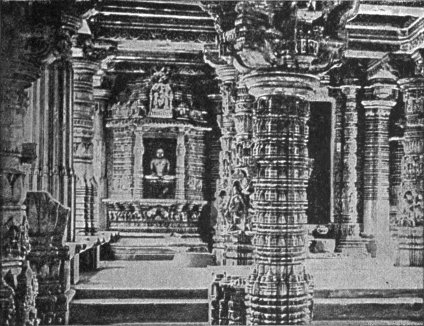
FIG. 226.—PORCH OF TEMPLE ON MOUNT ABU.
JAINA TEMPLES. The earliest examples are on Mount Abu
406
in the Indian Desert. Built by Vimalah Sah in 1032, the chief of these
consists of a court measuring 140 × 90 feet, surrounded by cells and a
double colonnade. In the centre rises the shrine of the god, containing
his statue, and terminating in a lofty tower or sikhra. An
imposing columnar porch, cruciform in plan, precedes this cell (Fig.
226). The intersection of the arms is covered by a dome supported on
eight columns with stone brackets or struts. The dome and columns are
covered with profuse carving and sculptured figures, and the total
effect is one of remarkable dignity and splendor. The temple of
Sadri is much more extensive, twenty minor domes and one of
larger size forming cruciform porches on all four sides of the central
sikhra. The cells about the court are each covered by a small
sikhra, and these, with the twenty-one domes (four of which are
407
built in three stories), all grouped about the central tower and adorned
with an astonishing variety of detail, constitute a monument of the
first importance. It was built by Khumbo Rana, about 1450. At
Girnar are several 12th-century temples with enclosed instead of
open vestibules. One of these, that of Neminatha, retains intact
its court enclosure and cells, which in most other cases have perished.
The temple at Somnath resembles it, but is larger; the dome of
its porch, 33 feet in diameter, is the largest Jaina dome in India.
Other notable temples are at Gwalior, Khajuraho, and Parasnatha.
In all the Jaina temples the salient feature is the sikhra or
vimana. This is a tower of approximately square plan, tapering by
a graceful curve toward a peculiar terminal ornament shaped like a
flattened melon. Its whole surface is variegated by horizontal bands and
vertical breaks, covered with sculpture and carving. Next in importance
are the domes, built wholly in horizontal courses and resting on stone
lintels carried by bracketed columns. These same traits appear in
relatively modern examples, as at Delhi.

FIG. 227.—TOWER OF VICTORY, CHITTORE.
TOWERS. A similar predilection for minutely broken surfaces
marks the towers which sometimes adjoin the temples, as at Chittore
(tower of Sri Allat, 13th century), or were erected as trophies
of victory, like that of Khumbo Rana in
408
the same town (Fig. 227). The combination of horizontal and vertical
lines, the distribution of the openings, and the rich ornamentation of
these towers are very interesting, though lacking somewhat in structural
propriety of design.
HINDU STYLES: NORTHERN BRAHMAN. The origin of this style is as
yet an unsolved problem. Its monuments were mainly built between 600 and
1200 A.D., the oldest being in Orissa,
at Bhuwanesevar, Kanaruk, and Puri. In northern India the temples are
about equally divided between the two forms of Brahmanism—the
worship of Vishnu or Vaishnavism, and that of Siva or
Shaivism—and do not differ materially in style. As in the
Jaina style, the vimana is their most striking feature, and this
is in most cases adorned with numerous reduced copies of its own form
grouped in successive stages against its sides and angles. This curious
system of design appears in nearly all the great temples, both of Vishnu
and Siva. The Jaina melon ornament is universal, surmounted generally by
an urn-shaped finial.
In plan the vimana shrine is preceded by two or three chambers,
square or polygonal, some with and some without columns. The foremost of
these is covered by a roof formed like a stepped pyramid set cornerwise.
The fine porch of the ruined temple at Bindrabun is cruciform in
plan and forms the chief part of the building, the shrine at the further
end being relatively small and its tower unfinished or ruined. In some
modern examples the antechamber is replaced by an open porch with a
Saracenic dome, as at Benares; in others the old type is completely
abandoned, as in the temple at Kantonnuggur (1704–22). This
is a square hall built of terra-cotta, with four three-arched porches
and nine towers, more Saracenic than Brahman in general aspect.
The Kandarya Mahadeo, at Khajuraho, is the most noted example
of the northern Brahman style, and one of the most splendid structures
extant. A strong and lofty basement
409
supports an extraordinary mass of roofs, covering the six open porches
and the antechamber and hypostyle hall, which precede the shrine, and
rising in successive pyramidal masses until the vimana is reached which
covers the shrine. This is 116 feet high, but seems much loftier, by
reason of the small scale of its constituent parts and the marvellously
minute decoration which covers the whole structure. The vigor of its
masses and the grand stairways which lead up to it give it a dignity
unusual for its size, 60 × 109 feet in plan (cir. 1000 A.D.).
At Puri, in Orissa, the Temple of Jugganat, with its
double enclosure and numerous subordinate shrines, the Teli-ka-Mandir at
Gwalior, and temples at Udaipur near Bhilsa, at Mukteswara
in Orissa, at Chittore, Benares, and Barolli, are important examples.
The few tombs erected subsequent to the Moslem conquest, combining Jaina
bracket columns with Saracenic domes, and picturesquely situated palaces
at Chittore (1450), Oudeypore (1580), and Gwalior, should also be
mentioned.
CHALUKYAN STYLE. Throughout a central zone crossing the
peninsula from sea to sea about the Dekkan, and extending south to
Mysore on the west, the Brahmans developed a distinct style during the
later centuries of the Chalukyan dynasty. Its monuments are mainly
comprised between 1050 and the Mohammedan conquest in 1310. The most
notable examples of the style are found along the southwest coast, at
Hullabid, Baillur, and Somnathpur.
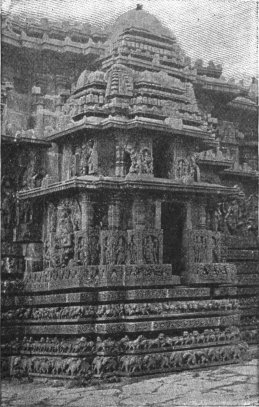
FIG. 228.—TEMPLE AT HULLABÎD. DETAIL.
TEMPLES. Chalukyan architecture is exclusively religious and
its temples are easily recognized. The plans comprise the same elements
as those of the Jainas, but the Chalukyan shrine is always star-shaped
externally in plan, and the vimana takes the form of a stepped pyramid
instead of a curved outline. The Jaina dome is, moreover, wholly
wanting. All the details are of extraordinary richness and beauty, and
the breaking up of the surfaces by rectangular
410
projections is skilfully managed so as to produce an effect of great
apparent size with very moderate dimensions. All the known examples
stand on raised platforms, adding materially to their dignity. Some are
double temples, as at Hullabid (Fig. 228); others are triple in plan.
A noticeable feature of the style is the deeply cut stratification
of the lower part of the temples, each band or stratum bearing a
distinct frieze of animals, figures or ornament, carved with masterly
skill. Pierced stone slabs filling the window openings are also not
uncommon.
The richest exemplars of the style are the temples at Baillur
and Somnathpur, and at Hullabîd the Kait Iswara and the
incomplete Double Temple. The Kurti Stambha, or gate at Worangul,
and the Great Temple at Hamoncondah should also be mentioned.
DRAVIDIAN STYLE. The Brahman monuments of southern India
exhibit a style almost as strongly marked as the Chalukyan. This appears
less in their details than in their general plan and conception. The
Dravidian temples are not single structures, but aggregations of
buildings of varied size and form, covering extensive areas enclosed by
walls
411
and entered through gates made imposing by lofty pylons called
gopuras. As if to emphasize these superficial resemblances to
Egyptian models, the sanctuary is often low and insignificant. It is
preceded by much more imposing porches (mantapas) and hypostyle
halls or choultries, the latter being sometimes of extraordinary
extent, though seldom lofty. The choultrie, sometimes called the Hall of
1,000 Columns, is in some cases replaced by pillared corridors of great
length and splendor, as at Ramisseram and Madura. The
plans are in most cases wholly irregular, and the architecture, so far
from resembling the Egyptian in its scale and massiveness, is marked by
the utmost minuteness of ornament and tenuity of detail, suggesting wood
and stucco rather than stone. The Great Hall at Chillambaram is
but 10 to 12 feet high, and the corridors at Ramisseram, 700 feet long,
are but 30 feet high. The effect of ensemble of the Dravidian
temples is disappointing. They lack the emphasis of dominant masses and
the dignity of symmetrical and logical arrangement. The very loftiness
of the gopuras makes the buildings of the group within seem low by
contrast. In nearly every temple, however, some one feature attracts
merited admiration by its splendor, extent, or beauty. Such are the
Choultrie, built by Tirumalla Nayak at Madura (1623–45),
measuring 333 × 105 feet; the corridors already mentioned at Ramisseram
and in the Great Temple at Madura; the gopuras at Tarputry
and Vellore, and the Mantapa of Parvati at Chillambaram
(1595–1685). Very noticeable are the compound columns of this
style, consisting of square piers with slender shafts coupled to them
and supporting brackets, as at Chillambaram, Peroor, and Vellore; the
richly banded square piers, the grotesques of rampant horses and
monsters, and the endless labor bestowed upon minute carving and
ornament in superposed bands.
OTHER MONUMENTS. Other important temples are at Tiruvalur,
Seringham, Tinevelly, and Conjeveram, all alike
412
in general scheme of design, with enclosures varying from 300 to 1,000
feet in length and width. At Tanjore is a magnificent temple with
two courts, in the larger of which stands a pagoda or shrine with
a pyramidal vimana, unusual in Dravidian temples, and beside it the
smaller Shrine of Soubramanya (Fig. 229), a structure
of unusual beauty of detail. In both, the vertical lower story with its
pilasters and windows is curiously suggestive of Renaissance design. The
pagoda dates from the 14th, the smaller temple from the 15th
century.
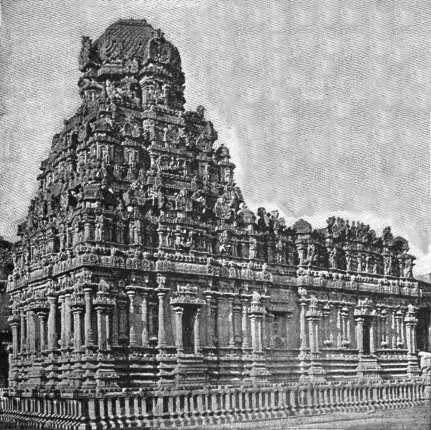
FIG. 229.—SHRINE OF SOUBRAMANYA, TANJORE.
ROCK-CUT RATHS. All the above temples were built subsequently
to the 12th century. The rock-cut shrines date in some cases as far back
as the 7th century; they are called kylas and raths, and
are not caves, but isolated edifices,
413
imitating structural designs, but hewn bodily from the rock. Those at
Mahavellipore are of diminutive size; but at Purudkul there is an
extensive temple with shrine, choultrie, and gopura surrounded by a
court enclosure measuring 250 × 150 feet (9th century). More famous
still is the elaborate Kylas at Ellora, of about the same
size as the above, but more complex and complete in its details.
PALACES. At Madura, Tanjore, and Vijayanagar are Dravidian
palaces, built after the Mohammedan conquest and in a mixed style. The
domical octagonal throne-room and the Great Hall at Madura (17th
century), the most famous edifices of the kind, were evidently inspired
from Gothic models, but how this came about is not known. The Great Hall
with its pointed arched barrel vault of 67 feet span, its cusped arches,
round piers, vaulting shafts, and triforium, appears strangely foreign
to its surroundings.
CAMBODIA. The subject of Indian architecture cannot be
dismissed without at least brief mention of the immense temple of
Nakhon Wat in Cambodia. This stupendous creation covers an area
of a full square mile, with its concentric courts, its encircling moat
or lake, its causeways, porches, and shrines, dominated by a central
structure 200 feet square with nine pagoda-like towers. The corridors
around the inner court have square piers of almost classic Roman type.
The rich carving, the perfect masonry, and the admirable composition of
the whole leading up to the central mass, indicate architectural ability
of a high order.
CHINESE ARCHITECTURE. No purely Mongolian nation appears ever
to have erected buildings of first-rate importance. It cannot be denied,
however, that the Chinese are possessed of considerable decorative skill
and mechanical ingenuity; and these qualities are the most prominent
elements in their buildings. Great size and splendor, massiveness and
originality of construction, they do not possess. Built in large measure
of wood, cleverly framed and decorated
414
with a certain richness of color and ornament, with a large element of
the grotesque in the decoration, the Chinese temples, pagodas, and
palaces are interesting rather than impressive. There is not a single
architectural monument of imposing size or of great antiquity, so far as
we know. The celebrated Porcelain Tower of Nankin is no longer
extant, having been destroyed in the Tæping rebellion in 1850. It was a
nine-storied polygonal pagoda 236 feet high, revetted with porcelain
tiles, and was built in 1412. The largest of Chinese temples, that of
the Great Dragon at Pekin, is a circular structure of moderate
size, though its enclosure is nearly a mile square. Pagodas with
diminishing stories, elaborately carved entrance gates and successive
terraces are mainly relied upon for effect. They show little structural
art, but much clever ornament. Like the monasteries and the vast
lamaseries of Thibet, they belong to the Buddhist religion.
Aside from the ingenious framing and bracketing of the carpentry, the
most striking peculiarity of Chinese buildings is their broad-spreading
tiled roofs. These invariably slope downward in a curve, and the tiling,
with its hip-ridges, crestings, and finials in terra-cotta or metal,
adds materially to the picturesqueness of the general effect. Color and
gilding are freely used, and in some cases—as in a summer pavilion
at Pekin—porcelain tiling covers the walls, with brilliant effect.
The chief wonder is that this resource of the architectural decorator
has not been further developed in China, where porcelain and earthenware
are otherwise treated with such remarkable skill.
JAPANESE ARCHITECTURE. Apparently associated in race with the
Chinese and Koreans, the Japanese are far more artistic in temperament
than either of their neighbors. The refinement and originality of their
decorative art have given it a wide reputation. Unfortunately the
prevalence of earthquakes has combined with the influence of the
traditional
415
habits of the people to prevent the maturing of a truly monumental
architecture. Except for the terraces, gates, and enclosures of their
palaces and temples, wood is the predominant building material. It is
used substantially as in China, the framing, dovetailing, bracketing,
broad eaves and tiled roofs of Japan closely resembling those of China.
The chief difference is in the greater refinement and delicacy of the
Japanese details and the more monumental disposition of the temple
terraces, the beauty of which is greatly enhanced by skillful landscape
gardening. The gateways recall somewhat those of the Sanchi Tope in
India (p. 403), but are commonly of wood.
Owing to the danger from earthquakes, lofty towers and pagodas are
rarely seen.
The domestic architecture of Japan, though interesting for its
arrangements, and for its sensible and artistic use of the most flimsy
materials, is too trivial in scale, detail, and construction to receive
more than passing reference. Even the great palace at Tokio,28 covering an
immense area, is almost entirely composed of one-storied buildings of
wood, with little of splendor or architectural dignity.
MONUMENTS (additional to those in text). BUDDHIST: Topes at Sanchi, Sonari, Satdara, Andher,
in Central India; at Sarnath, near Benares; at Jelalabad and Salsette;
in Ceylon at Anuradhapura, Tuparamaya, Lankaramaya.—Grotto temples
(chaityas), mainly in Bombay and Bengal Presidencies; at Behar,
especially the Lomash Rishi, and Cuttack; at Bhaja, Bedsa, Ajunta, and
Ellora (Wiswakarma Cave); in Salsette, the Kenheri Cave.—Viharas:
Structural at Nalanda and Sarnath, demolished; rock-cut in Bengal, at
Cuttack, Udayagiri (the Ganesa); in the west, many at Ajunta, also at
Bagh, Bedsa, Bhaja, Nassick (the Nahapana, Vadnya Sri, etc.), Salsette,
Ellora (the Dekrivaria, etc.). In Nepâl, stupas of Swayanbunath and
Bouddhama.
JAINA: Temples at Aiwulli, Kanaruc
(Black Pagoda), and Purudkul;
416
groups of temples at Palitana, Gimar, Mount Abu, Somnath, Parisnath; the
Sas Bahu at Gwalior, 1093; Parswanatha and Ganthai (650) at Khajuraho;
temple at Gyraspore, 7th century; modern temples at Ahmedabad
(Huttising), Delhi, and Sonaghur; in the south at Moodbidri, Sravana
Belgula; towers at Chittore.
NORTHERN BRAHMAN: Temples,
Parasumareswara (500 A.D.),
Mukteswara, and Great Temple (600–650), all at Bhuwaneswar, among
many others; of Papanatha at Purudkul; grotto temples at Dhumnar,
Ellora, and Poonah; temples at Chandravati, Udaipur, and Amritsur (the
last modern); tombs of Singram Sing and others at Oudeypore; of Rajah
Baktawar at Ulwar, and others at Goverdhun; ghâts or landings at Benares
and elsewhere.
CHALUKYAN: Temples at Buchropully
and Hamoncondah, 1163; ruins at Kalyani; grottoes of Hazar Khutri.
DRAVIDIAN: Rock-cut temples (raths)
at Mahavellipore; Tiger Cave at Saluvan Kuppan; temples at Pittadkul
(Purudkul), Tiruvalur, Combaconum, Vellore, Peroor, Vijayanagar;
pavilions at Tanjore and Vijayanagar.
There are also many temples in the Kashmir Valley difficult of
assignment to any of the above styles and religions.
417
A. PRIMITIVE GREEK
ARCHITECTURE.—The researches of Schliemann commented by
Schuchardt, of Dörpfeld, Stamakis, Tsoundas, Perrot, and others, in
Troy, Mycenæ, and Tiryns, and the more recent discoveries of Evans at
Gnossus, in Crete, have greatly extended our knowledge of the
prehistoric art of Greece and the Mediterranean basin, and established
many points of contact on the one hand with ancient Egyptian and
Phœnician art, and on the other, with the art of historic Greece. They
have proved the existence of an active and flourishing commerce between
Egypt and the Mediterranean shores and Aegean islands more than 2000
B.C., and of a flourishing material
civilization in those islands and on the mainland of Greece, borrowing
much, but not everything, from Egypt. While the origin of the Doric
order in the structural methods of the pre-Homeric architecture of
Tiryns and Mycenæ, as set forth by Dörpfeld and by Perrot and Chipiez,
can hardly be regarded as proved in all details, since much of the
argument advanced for this derivation rests on more or less conjectural
restorations of the existing remains, it seems to be fairly well
established that the Doric order, and historic Greek architecture in
general, trace their genesis in large measure back in direct line to
this prehistoric art. The remarkable feature of this early architecture
is the apparently complete absence of temples. Fortifications, houses,
palaces, and tombs make up the ruins thus far discovered, and seem to
indicate clearly the derivation of the temple-type of later Greek art
from the primitive house, consisting of a hall or megaron with
four columns about the central hearth (whence
418
no doubt, the atrium and peristyle of Roman houses, through their Greek
intermediary prototypes) and a porch or aithousa, with or without
columns in antis, opening directly into the megaron, or
indirectly through an ante-room called the prodomos. Here we have
the prototypes of the Greek temple in antis, with its naos
having interior columns, whether roofed over or hypæthral (see pp. 54,
55). It is probable also that the evidently liberal use of timber for
many of the structural details led in time to many of the forms later
developed in stone in the entablature of the Doric order. But it is hard
to discover, as Dörpfeld would have it, in the slender Mycenæan columns
with their inverted taper, the prototype of the massive Doric column
with its upward taper. The Mycenæan column was evidently derived from
wooden models; the sturdy Doric column—the earliest being the most
massive—seems plainly derived from stone or rubble piers (see p. 50), and thus to have come from a
different source from the Mycenæan forms.
The gynecæum, or women’s apartments, the men’s apartments, and
the bath were in these ancient palaces grouped in varying relations
about the megaron: their plan, purpose, and arrangement are
clearly revealed in the ruins of Tiryns, where they are more complete
and perfect than either at Troy or Mycenæ.
B. CAMPANILES IN
ITALY.—Reference is made on page 264 to the towers or campaniles of the
Italian Gothic style and period, and six of these are specifically
mentioned; and on page 305 mention is also made
of those of the Renaissance in Italy. The number and importance of the
Italian campaniles and the interest attaching to their origin and
design, warrant a more extended notice than has been assigned them in
the pages cited.
The oldest of these bell-towers appear to be those adjoining
419
the two churches of San Apollinare in and near Ravenna (see p. 114), and date presumably from the
sixth century. They are plain circular towers with few and small
openings, except in the uppermost story, where larger arched openings
permit the issue of the sound of the bells. This type, which might have
been developed into a very interesting form of tower, does not seem to
have been imitated. It was at Rome, and not till the ninth or tenth
century, that the campanile became a recognized feature of church
architecture. It was invariably treated as a structure distinct from the
church, and was built of brick upon a square plan, rising with little or
no architectural adornment to a height usually of a hundred feet or
more, and furnished with but a few small openings below the belfry
stage, where a pair of coupled arched windows separated by a simple
column opened from each face of the tower. Above these windows a
pyramidal roof of low pitch terminated the tower. In spite of their
simplicity of design these Roman bell-towers often possess a noticeable
grace of proportions, and furnish the prototype of many of the more
elaborate campaniles erected during the Middle Ages in other central and
north Italian cities. The towers of Sta. Maria in Cosmedin, Sta. Maria
in Trastevere, and S. Giorgio in Velabro are examples of this type.
Most of the Roman examples date from the eleventh and twelfth
centuries.
In other cities, the campanile was treated with some variety of form
and decoration, as well as of material. In Lombardy and Venetia the
square red-brick shaft of the tower is often adorned with long, narrow
pilaster strips, as at Piacenza (p. 158, Fig. 91) and Venice, and an arcaded cornice
not infrequently crowns the structure. The openings at the top may be
three or four in number on each face, and even the plan is sometimes
octagonal or circular. The brick octagonal campanile of
S. Gottardo at Milan is one of the finest Lombard church
towers. At Verona the
420
brick tower on the Piazza dell’ Erbe and
that of S. Zeno are conspicuous; but every important town of
northern Italy possesses one or more examples of these structures dating
from the eleventh, twelfth, or thirteenth century.
Undoubtedly the three most noted bell-towers in Italy are those of
Venice, Pisa, and Florence. The great Campanile of St.
Mark at Venice, first begun in 874, carried higher in the twelfth
and fourteenth centuries, and finally completed in the sixteenth century
with the marble belvedere and wooden spire so familiar in pictures of
Venice, was formerly the highest of all church campaniles in Italy,
measuring approximately 325 feet to the summit. But this superb historic
monument, weakened by causes not yet at this writing fully understood,
fell in sudden ruin on the 14th of July, 1902, to the great loss not
only of Venice, but of the world of art, though fortunately without
injuring the neighboring buildings on the Piazza and Piazzetta of St.
Mark. Since then the campanile of S. Stefano, in the same city, has
been demolished to forestall another like disaster. The Leaning
Tower of Pisa (see p. 160, Fig. 92) dates from 1174, and is unique in
its plan and its exterior treatment with superposed arcades. Begun
apparently as a leaning tower, it seems to have increased this lean to a
dangerous point, by the settling of its foundations during construction,
as its upper stages were made to deviate slightly towards the vertical
from the inclination of the lower portion. It has always served rather
as a watch-tower and belvedere than as a bell-tower. The
Campanile adjoining the Duomo at Florence is described on
p. 263 and illustrated in Fig. 154, and does not require
further notice here. The black-and-white banded towers of Sienna, Lucca,
and Pistoia, and the octagonal lanterns crowning those of Verona and
Mantua, also referred to in the text on p. 264, need here only be mentioned again
as illustrating the variety of treatment of these Italian towers.
421
The Renaissance architects developed new types of campanile, and in
such variety that they can only be briefly referred to. Some, like a
brick tower at Perugia, are simple square towers with pilasters; more
often engaged columns and entablatures mark the several stories, and the
upper portion is treated either with an octagonal lantern or with
diminishing stages, and sometimes with a spire. Of the latter class the
best example is that of S. Biagio, at Montepulciano,—one of
the two designed to flank the façade of Ant. da S. Gallo’s
beautiful church of that name. One or two good late examples are to be
found at Naples. Of the more massive square type there are examples in
the towers of S. Michele, Venice; of the cathedral at Ferrara, Sta.
Chiara at Naples, and Sta. Maria dell’ Anima—one of the
earliest—at Rome. The most complete and perfect of these square
belfries of the Renaissance is that of the Campidoglio at Rome,
by Martino Lunghi, dating from the end of the sixteenth century, which
groups so admirably with the palaces of the Capitol.
C. BRAMANTE’S WORKS.—A
more or less animated controversy has arisen regarding the authenticity
of many of the works attributed to Bramante, and the tendency has of
late been to deny him any part whatever in several of the most important
of these works. The first of these to be given a changed assignment was
the church of the Consolazione at Todi (p. 293), now believed to be by Cola di Caprarola;
and it is now denied by many investigators that either the Cancelleria
or the Giraud palace (p. 290) is his work,
or any one of two or three smaller houses in Rome showing a somewhat
similar architectural treatment. The evidence adduced in support of this
denial is rather speculative and critical than documentary, but is not
without weight. The date 1495 carved on a doorway of the Cancelleria
palace is thought to forbid its attribution to
422
Bramante, who is not known to have come to Rome till 1503; and there is
a lack of positive evidence of his authorship of the Giraud palace and
the other houses which seem to be by the same hand as the Cancelleria.
To the advocates of this view there is not enough resemblance in style
between this group of buildings and his acknowledged work either in
Milan or in the Vatican to warrant their being attributed to him.
It must, however, be remarked, that this notable group of works,
stamped with the marks and even the mannerisms of a strong personality,
reveal in their unknown author gifts amounting to genius, and heretofore
deemed not unworthy of Bramante. It is almost inconceivable that they
should have been designed by a mere beginner previously utterly unknown
and forgotten soon after. It is incumbent upon those who deny the
attribution to Bramante to find another name, if possible, on which to
fasten the credit of these works. Accordingly, they have been variously
attributed to Alberti (who died in 1472) or his followers; to Bernardo
di Lorenzo, and to other later fifteenth-century artists. The difficulty
here is to discover any name that fits the conditions even as well as
Bramante’s; for the supposed author must have been in Rome between 1495
and 1505, and his other works must be at least as much like these as
were Bramante’s. No name has thus far been found satisfactory to careful
critics; and the alternative theory, that there existed in Rome, before
Bramante’s coming, a group of architects unknown to later fame,
working in a common style and capable of such a masterpiece as the
Cancelleria, does not harmonize with the generally accepted facts of
Renaissance art history. Moreover, the comparison of these works with
Bramante’s Milanese work on the one hand and his great Court of the
Belvedere in the Vatican on the other, yields, to some critics,
conclusions quite opposed to those of the advocates of another
authorship than Bramante’s.
423
The controversy must be considered for the present as still open.
There are manifest difficulties with either of the two opposed views,
and these can hardly be eliminated, except by the discovery of documents
not now known to exist, whose testimony will be recognized as
unimpeachable.
D. L’ART NOUVEAU.—Since
1896, and particularly since the Paris Exposition of 1900,
a movement has manifested itself in France and Belgium, and spread
to Germany and Austria and even measurably to England, looking towards a
more personal and original style of decorative and architectural design,
in which the traditions and historic styles of the past shall be
ignored. This movement has received from its adherents and the public
the name of “L’Art Nouveau,” or, according to some, “L’Art Moderne”; but
this name must not be held to connote either a really new style or a
fundamentally new principle in art. Indeed, it may be questioned whether
any clearly-defined body of principles whatever underlies the movement,
or would be acknowledged equally by all its adherents. It appears to be
a reaction against a too slavish adherence to traditional forms and
methods of design (see pp. 370, 375), a striving to ignore or forget the past rather
than a reaching out after any well-understood, positive end; as such, it
possesses the negative strength of protest rather than the affirmative
strength of a vital principle. Its lack of cohesion is seen in the
division of its adherents into groups, some looking to nature for
inspiration, while others decry this as a mistaken quest; some seeking
to emphasize structural lines, and others to ignore them altogether.
All, however, are united in the avoidance of commonplace forms and
historic styles, and this preoccupation has developed an amazing amount
of originality and individualism of style, frequently reaching the
extreme of eccentricity. The results have therefore been, as might be
expected, extremely varied in
424
merit, ranging from the most refined and reserved in style to the most
harshly bizarre and extravagant. As a rule, they have been most
successful in small and semi-decorative objects—jewelry,
silverware, vases, and small furniture; and one most desirable feature
of the movement has been the stimulus it has given (especially in France
and England), to the organization and activity of “arts-and-crafts”
societies which occupy themselves with the encouragement of the
decorative and industrial arts and the diffusion of an improved taste.
In the field of the larger objects of design, in which the dominance of
traditional form and of structural considerations is proportionally more
imperious, the struggle to evade these restrictions becomes more
difficult, and results usually in more obvious and disagreeable
eccentricities, which the greater size and permanence of the object tend
further to exaggerate. The least successful achievements of the movement
have accordingly been in architecture. The buildings designed by its
most fervent disciples (e.g. the Pavillon Bleu at the Exposition
of 1900, the Castel Béranger, Paris, by H. Guimard, the
houses of the artist colony at Darmstadt, and others) are for the most
part characterized by extreme stiffness, eccentricity, or ugliness. The
requirements of construction and of human habitation cannot easily be
met without sometimes using the forms which past experience has
developed for the same ends; and the negation of precedent is not the
surest path to beauty or even reasonableness of design. It is
interesting to notice that in the intermediate field of furniture-design
some of the best French productions recall the style of Louis XV.,
modified by Japanese ideas and spirit. This singular but not unpleasing
combination is less surprising when we reflect that the style of Louis
XV. was itself a protest against the formalism of the heavy classic
architecture of preceding reigns, and achieved its highest successes in
the domain of furniture and interior decoration.
425
It may be fair to credit the new movement with one positive
characteristic in its prevalent regard for line, especially for the
effect of long and swaying lines, whether in the contours or
ornamentation of an object. This is especially noticeable in the Belgian
work, and in that of the Viennese “Secessionists,” who have, however,
carried eccentricity to a further point of extravagance than any
others.
Whether “L’Art Nouveau” will ever produce permanent results time
alone can show. Its present vogue is probably evanescent and it cannot
claim to have produced a style; but it seems likely to exert on European
architecture an influence, direct and indirect, not unlike that of the
Néo-Grec movement of 1830 in France (p. 364), but even more lasting and beneficial. It
has already begun to break the hold of rigid classical tradition in
design; and recent buildings, especially in Germany and Austria, like
the works of the brilliant Otto Wagner in Vienna, show a pleasing
freedom of personal touch without undue striving after eccentric
novelty. Doubtless in French and other European architecture the same
result will in time manifest itself.
The search for novelty and the desire to dispense wholly with
historic forms of design which are the chief marks of the Art Nouveau, were
emphatically displayed in many of the remarkable buildings of the Paris
Exhibition of 1900, in which a striking fertility and facility of
design in the decorative details made more conspicuous the failure to
improve upon the established precedents of architectural style in the
matters of proportion, scale, general composition, and contour. As usual
the metallic construction of these buildings was almost without
exception admirable, and the decorative details, taken by themselves,
extremely clever and often beautiful, but the combined result was not
satisfactory.
In the United States the movement has not found a firm foothold
because there has been no dominant, enslaving tradition to protest
against. Not a few of the ideas, not a
426
little of the spirit of the movement may be recognized in the work of
individual architects and decorative artists in the United States,
executed years before the movement took recognizable form in Europe: and
American decorative design has generally been, at least since 1880 or
1885, sufficiently free, individual and personal, to render unnecessary
and impossible any concerted movement of artistic revolt against slavery
to precedent.
E. RECENT AMERICAN
ARCHITECTURE.—Architectural activity in the United States
continues to share in the general prosperity which has marked the years
since 1898, and this activity has by no means been confined to
industrial and commercial architecture. Indeed, while the erection of
“sky scrapers” or excessively lofty office-buildings has continued to be
a feature of this activity in the great commercial centres, the most
notable architectural enterprises of recent years have been in the field
of educational buildings, both in the East and West. In 1898 a great
international competition resulted in the selection of the design of Mr.
E. Bénard of Paris for a magnificent group of buildings for
the University of California on a scale of unexampled grandeur,
and the erection of this colossal project has been begun. An almost
equally ambitious project, by a firm of Philadelphia architects, has
been adopted for the Washington University at St. Louis; and many other
universities and colleges have either added extensively to their
existing buildings or planned an entire rebuilding on new designs. Among
these the national military and naval academies at West Point and
Annapolis take the first rank in the extent and splendor of the
projected improvements. Museums and libraries have also been erected or
begun in various cities, and the New York Public Library, now
building, will rank in cost and beauty with those already erected in
Boston and Washington.
427
In other departments mention should be made of recent Federal
buildings (custom-houses, post-offices, and court-houses) erected under
the provisions of the Tarsney act from designs secured by competition
among the leading architects of the country; among those the New York
Custom House is the most important, but other buildings, at
Washington, Indianapolis, and elsewhere, are also conspicuous, and many
of them worthy of high praise. The tendency to award the designing of
important public buildings, such as State capitols, county court houses,
city halls, libraries, and hospitals, by competition instead of by
personal and political favor, has resulted in a marked improvement in
the quality of American public architecture.
F. THE ERECHTHEUM: RECENT
INVESTIGATIONS.—During the past two years, extensive repairs
and partial restorations of the Erechtheum at Athens, undertaken by the
Greek Archæological Society, have afforded opportunities for a new and
thoroughgoing study of the existing portions of the building and of the
surrounding ruins. In these investigations a prominent part has been
borne by Mr. Gorham P. Stevens, representing the Archæological
Institute of America, to whom must be credited, among other things, the
demonstration of the existence, in the east wall of the original
structure, of two windows previously unknown. Other peculiarities of
design and construction were also discovered, which add greatly to the
interest of the building. These investigations are reported in the
American Journal of Archæology, Second Series; Journal of the
Archæological Institute of America, Vol. X., No. 1, et
seq. The illustrations, Figures 35 and 36, are, by Mr. Stevens’
courtesy, based upon, though not reproductions of, his original
drawings.
435
A
B
C
D
E
F
G
H
I
J
K
L
M
N
O
P
R
S
T
U
V
W
X
Y
Z
Highlighted names link back to the beginning of this Index. Page and
figure numbers link to the referenced page or figure.
The buildings are arranged according to location. Those which appear
only in the lists of monuments at the ends of chapters are omitted.
Numerals in parentheses refer to illustrations.
Abayagiri.
Tope, 403
Abbeville.
St. Wulfrand, 209,
213
Abu-Seir.
Stepped pyramid, 9
Abydos.
Columns, 12.
Temple, 19,
21.
Tombs, 11
(5)
Addeh.
Grotto-temple, 22
Æmilia.
Churches in, 157,
262
Agra,
149.
Pearl Mosque, 148.
Taj Mahal, 148
(86)
Agrigentum.
Temple of Zeus, 56,
61
(33)
Ahmedabad,
148
Aix-la-Chapelle.
Minster (palatine Chapel),
172.
Palace of Charlemagne,
176
Aizanoi.
Temple of Zeus, 67.
Theatre, 70
Ajmir,
148
Ajunta.
Brahman Chaityas, 404;
viharas, 405
Albano.
Tomb, 89
Albany.
All Saints’ Cathedral,
394.
Capitol, 391
Alby Cathedral,
185,
205,
206,
212,
249
(123)
Alcala de Heñares,
352.
Archepiscopal Palace, 350.
College, 349
Alcantara.
Bridge, 108
Alençon Cathedral,
209,
213
Alexandria Troas.
Palæstra, 71.
Allahabad.
Akbar’s Palace, 148
Altenburg Cathedral,
242.
Town hall, 344
Amada.
Columns, 12
Amboise Castle,
310
Amiens Cathedral,
189,
197,
201,
203,
205,
206,
219,
232
(122);
west front of, 207,
208,
212,
227
Amravati.
Topes, 403
Amsterdam.
Bourse (Exchange) Hanse House, Town hall, 336
Ancy le Franc.
Château, 317
Anet.
Château, 317
Angers.
Cathedral S. Maurice, 200.
Hospital, 214
Angora (Ancyra),
118
Angoulême Cathedral,
164
Ani,
134
Annapolis.
Harwood and Hammond Houses, 386
Antioch,
115
Antiphellus.
Theatre, 70.
Tombs, 72
Antwerp
Cathedral,
190,
246,
247.
Town Hall, 334,
336
Aquitania.
Churches of, 164,
167,
168,
179,
373
Aranjuez.
Palace, 352
Arezzo Cathedral,
257.
Sta. Maria della Pieve,
159
436
Argos.
Gates, 45
Arizona.
Spanish churches in, 388
Arles.
St. Trophime, 165
Aschaffenburg.
Church, 243
Asheville.
Biltmore House, 399
Asia Minor,
53,
55,
58,
62,
66,
122
Aspendus.
Theatre, 70
Assisi.
Church of St. Francis (S. Francesco), 255,
256,
258
Assos,
55.
Public cquare, 69.
Temple, 61
Asti.
Church, 256
Astorga.
Rood-screen, 352
Athens.
Academy, 365.
Acropolis, 65,
69.
Agora Gate, 68.
Cathedral, 134.
Choragic Monument of Lysicrates,
66
(30,
38).
Erechtheum, 64
(35,
36).
Museum, 365.
Odeion of Regilla (of Herodes Atticus),
68,
69,
70.
Parthenon, 56,
58,
63,
64,
131,
359
(Frontispiece,
31 d,
34).
Propylæa, 58,
65,
69,
358
(37).
Stoa of Attalus, 67.
Temple of Nike Apteros,
64,
65.
Temple of Olympian Zeus,
68
(39).
Theatre of Dionysus, 69,
70.
Theseum (Temple of Theseus or Heracles),
62.
Tower of Winds (Clepsydra of Cyrrhestes),
53,
67.
University, 365
Attica,
50,
55
Augsburg.
Town hall, 344
Austria,
330
Autun Cathedral,
166,
167
Auvergne.
Churches, 204
Auxerre Cathedral,
197,
201
Avignon.
Notre Dame Des Doms, 165
Avila.
S. Vincente, 180,
247;
Tombs in, 352
Azay-le-rideau.
Château, 316
Baalbec
(Heliopolis), 83.
Circular Temple, 94.
Temple of Sun, 92
Bab-el-Molouk,
14
Bagdad.
Tombs, etc., 145,
146
Bagh.
Viharas, Great Vihara, 405
Baillur.
Temples, 409,
410
Bamberg.
Church, 243
Barcelona.
Cathedral, 189,
249.
Sta. Maria del Pi, 249
Barolli.
Hindu Temple, 409
Basle.
Spahlenthor, 246
Bassæ (Phigalæa).
Temple of Apollo Epicurius,
65
Batalha.
Church, mausoleum, 251
Bavaria,
342
Bayeux Cathedral,
197,
205
Bayonne Cathedral,
197
Beaugency.
Town hall, 316
Beaumesnil.
Château, 319
Beaune.
Hospital, 214
Beauvais Cathedral,
189,
197,
211,
219;
chapels, 205;
size, 206,
211,
212,
243
Beit-el-wali.
Rock-cut Temple, 22
Belem.
Church, 251,
352.
Cloister, tower, 352
Belgium,
334.
Benares.
Hindu Temples, 408,
409
Beni Hassan.
Columns, 11,
24,
50.
Speos Artemidos, 22.
Tombs, 11
(6,
7)
Bergamo.
Town Hall, 266
Berlin.
Bauschule,
376.
Brandenburg Gate, 358.
Old Museum, 359
(200).
New Museum, 359.
Alphabetized as shown; body text has “Museum” and “New
Museum”.
Parliament House, 377.
Theatres, 360,
376
Bethlehem.
Church of the Nativity, 115
Bhaja.
Chaityas, 404
437
Bhilsa.
Topes, 403
Bhuwaneswar.
Hindu temples, 408
Bidar,
146
Bijapur.
Tomb of Mahmud, 148,
153
(85).
Jumma Musjid, 148.
Mogul architecture, 149
Biltmore House,
399
Bindrabun.
Ruined temple, 408
Birs Nimroud.
Stepped pyramid, 31
Blenheim House,
332
(188)
Blois.
Château of, 216,
310,
313
(175,
176)
Bohemia,
338
Bologna,
157.
Brick houses, 266.
Campo Santo, 382.
Frati di S. Spirito, 279.
Local style, 283.
Pal. Bevilacqua, Pal. Fava,
283.
Palazzo Communale (town Hall),
266.
Renaissance churches in,
277,
293.
S. Francesco, 256,
263.
S. Petronio, 257,
258,
259,
263.
Sta. Maria dei Servi, 263
Bonn.
Minster, 174.
Baptistery, 175
Bordeaux.
Cathedral, spires, 209.
Grand Théatre, 362
Boston.
Ames Building, 397.
Custom House, 390.
Faneuil Hall, 388.
Fine Arts Museum, 394.
Hancock House, 387.
Old State House, 388.
Old South Church, 386.
Public Library, 399.
State House, 390.
Trinity Church, 394
(222)
Bourges Cathedral,
189,
197,
199,
202,
249;
chapels, 205;
size, 206;
portals, 208.
House of Jacques Cœur,
215
(127)
Bournazel.
Château, 315
Bowden Park,
357
Bozrah Cathedral,
117
(70)
Brandenburg.
St. Catherine, St. Godehard, 244
Bremen.
Town hall, 246,
344
Brescia.
Sta. Maria dei Miracoli, 287
Brieg.
Piastenschloss, 343
Bristol Cathedral, piers,
178
Bruges.
Ancien Greffe, 334.
Cloth hall, 247.
Ste. Anne, 334.
Town hall, 247
Brunswick.
Burg Dankwargerode, 176.
Town hall, 246
Brusa,
150
Brussels.
Bourse, 382.
Cathedral (ste. Gudule),
246.
Pal. de Justice, 382.
Renaissance Houses, 335
(190).
Town Hall, 247
Bubastis.
Temple, 13
Buda-Pesth.
Synagogue, 378
Buddh Gaya.
Tope or stupa, 404
Buffalo.
Guaranty Building, 397
Bulach.
Basilica, 375
Burgundy.
Cathedrals in, 197
Burghley House,
328
(184)
Bury.
Château, 315
Burgos Cathedral,
248,
249,
251
(145)
Byzantium,
92;
See Constantinople
Caen.
Churches, 167,
178;
St. Étienne (Abbaye aux Hommes) and Ste. Trinité (Abbaye aux Dames),
168;
St. Pierre, 312.
Hôtel D’Écoville, 316
Cahors Cathedral,
164
Cairo.
Karafah (Tombs of Khalîfs),
137,
138,
139.
Mohammedan monuments (list),
136,
153.
Mosque of Amrou, 136;
of Ibn Touloun, 136;
of Barkouk, 137;
of Kalaoun, 137;
of Sultan Hassan, 137,
138
(80);
of El Muayyad, 137;
of Kaîd Bey, 137
(81)
438
California.
Spanish missions and churches, 388
Cambodia.
Temple of Nakhon Wat, 413
Cambray Cathedral,
197
Cambridge.
Caius College, Gate of Honor,
328.
Fitzwilliam Museum, 356.
King’s College Chapel,
223,
227,
234.
Trinity College Library,
332
Cambridge (Mass.).
Craigie (Longfellow) House,
387
(219)
Canterbury Cathedral,
219;
central tower of, 228;
chapels, 231;
transepts, 232;
minor works in, 234
Caprarola.
Palace of, 300
Capua.
Amphitheatre, 103
Caria,
71;
see Halicamassus
Carinthia,
338,
339
Carlton House,
357
Carter’s Grove,
386
Caserta.
Royal Palace, 304
Castle Howard,
332
Cérisy-la-Forêt.
Church, 178
Ceylon.
Topes, 403
Chaise-Dieu.
Cloister, 213
Châlons (Châlons-sur-Marne)
Cathedral,
205
Chalvau.
Château, 314
Chambord.
Château, 314
(177,
178)
Chantilly.
“Petit Château,” 317
Charleston.
St. Michael’s, 385
Charlotteville.
University of Virginia, 390
Charlton Hall,
328
Charlton-on-Oxmore.
Plate tracery (110)
Chartres
Cathedral,
197,
201,
203;
chapels of, 205;
size of, 206;
W. front, 207;
transept porches, 208;
spires, 209;
capital from (126 C).
hospital, 214
Chemnitz Cathedral,
245
Chenonceaux.
Château, 316,
317
Chiaravalle.
Certosa, 255
Chicago.
Auditorium Theatre, 399.
Columbian Exposition, 393,
399.
Masonic Building, 396.
Fisher Building, Schiller Building,
397
Chichester Cathedral, spire,
229
Chihuahua.
Church, 352
Chillambaram.
Dravidian Temple, Mantapa of Parvati, 411
Chiswick.
Villa, 328,
329
Chittore.
Hindu temples, 409.
Palace, 409.
Towers, 407,
408
(227)
Clermont (Clermont-Ferrand)
Cathedral, 197;
chapels of, 205,
212.
Notre-Dame-du-Port, 165,
204
(96,
97)
Cluny.
Abbey Church, 166.
Houses at, 214.
Hôtel de (at Paris), 216
Coblentz.
Church of St. Castor, 237
Coimbra.
Sta. Cruz, 352
Coleshill.
House, 329
Cologne.
Apostles’ Church, 174,
243
(101).
Cathedral, 189,
192,
205,
243,
249;
vaulting of, 239;
spires, 240,
241;
plan, 189,
205,
242
(141).
Church of St. Mary-in-the-Capitol,
174.
Great St. Martin’s, 174,
243.
Romanesque Houses, Etc.,
176
Como.
Town hall (broletto), 266
Compostella.
St. Iago, 180
Conjeveram.
Dravidian temple, 411
439
Constantine.
Amphitheatre, 92
Constantinople,
120.
Byzantine monuments (list),
134.
Church of Hagia Sophia (Santa Sophia, Divine Wisdom),
111,
123,
124,
127–131,
132,
133,
150,
151
(72,
75,
76,
77).
Church of the Apostles,
132.
Early Christian monuments (list),
119.
Fountains, Fountain of Ahmet III.,
152,
153.
Mosque of Ahmet II. (Ahmediyeh),
151
(88);
of Mehmet II., 150,
151
(87);
of Osman III. (Nouri Osman),
151;
of Soliman (Suleimaniyeh),
151
(89);
of Yeni Djami, 151.
Palaces, 153.
St. Bacchus, 127.
St. John Studius (Emir Akhor mosque),
118.
St. Sergius, 117,
127
(74).
Tchinli Kiosque (Imperial Museum),
153;
sarcophagi in, 66.
Tombs, 152.
Turkish mosques, 150
Copenhagen.
Exchange, Fredericksborg,
336
Cordova,
141;
Great Mosque, 142,
143
(83)
Corinth.
Temple of Zeus, 60
Coutances Cathedral,
197;
chapels of, 205;
spires, 209
Cracow Castle,
338.
Chapel of Jagellons, 338
Cremona.
Town hall, 266
Ctesiphon.
Tâk-kesra, 145
Damascus,
Mosque of El-walîd, 136
Dantzic.
Town hall, 344
Dashour.
Pyramid, 9
Deir-el-bahari.
Tomb-temple of Hatasu,
15,
21
Deir-el-medineh.
Temple of Hathor, 19
Delhi.
Jaina Temples, 407.
Jumma Musjid, 148.
Mogul Architecture of,
149.
Palace of Shah Jehan, 148.
Pathan arches, Etc., 148
Delos.
Gates, 45;
Portico of Philip, 67
Denderah.
Temple of Hathor, 17.
Group of Temples, 22,
24.
Hathoric columns, 24
Detroit.
Majestic Building, 397
Dieppe.
Church of St. Jacques,
213
Dijon.
St. Michel, 312
Dol Cathedral, east end,
205
Dresden.
Castle, Georgenflügel,
342.
Church of St. Mary (Marienkirche) 346
(194).
Theatre, 376
(213).
Zwinger Palace, 346
(193)
Drügelte.
Circular church, 175
Durham Cathedral,
177,
178,
220,
221
(102);
central tower of, 228;
Chapel of Nine Altars,
232
Earl’s Barton.
Tower, 176
Ecouen.
Château, 316
Edfou.
Great Temple, 16,
17,
22
(9,
10,
14).
Peripteral Temple, 22
Edinburgh.
High School, Royal Institution,
357
Egypt.
Early Christian buildings in,
118
Elephantine.
Temple of Amenophis III.,
22
El Kab.
Temple of Amenophis III.; 18
Eleusis.
Propylæa, 69
Ellora.
Chaityas, 404.
Dravidian Kylas, 413
Elne.
Cloister, 170,
213
Ely Cathedral,
220;
choir vault, 222;
octagon, 224,
330;
clearstory, 225;
towers, 228;
interior, 229;
size, 232;
Lady Chapel, 234
440
Ephesus.
Temple of Artemis (Artemisium),
66;
Ionic Order, 53.
Palæstra, 71
Erech,
31
Escurial.
Monastery, 351
Esneh.
Hathoric columns, 25.
Temple, 23.
Essen.
Nun’s choir, 172
Esslingen.
Church spire, 240
Etchmiadzin.
Byzantine monuments, 134
Evreux Cathedral,
197
Exeter Cathedral,
221
(129)
Ezra.
Church of St. George, 117
Feraig.
Rock-cut Temple, 22
Ferrara Cathedral,
261,
304.
Churches, 277,
293.
Palaces Scrofa, Roverella,
283
Firouzabad.
Sassanian Buildings, 144
Florence.
Baptistery, 162.
Bartolini, Guadagni, Larderel, Pandolfini, Serristori palaces,
291.
Campanile, 263,
264
(147 a).
Cathedral (Duomo, Santa Maria del Fiore),
257,
258,
263;
façade, 261;
marble incrustation, 263;
dome,
273–275
(147,
148,
159,
160).
Church
of San Miniato, 115,
161,
162;
of Or San Michele, 264.
Gondi Palace, 291.
Loggia dei Lanzi, 266.
Loggia di San Paolo, 281.
Minor works, 287.
Ospedale degli Innocenti,
281.
Palazzo Vecchio, 265.
Pitti Palace, 280,
300,
319.
Riccardi Palace, 279,
280,
281,
290
(162).
Rucellai Palace, 280,
282.
Santa Croce, 258;
Pazzi Chapel of, 276;
pulpit in, 281;
Marsupini tomb, 281.
San Lorenzo, 276.
San Spirito, 276
(161),
Santa Maria Novella, 256,
258;
façade, 277;
fountain in sacristy of,
281.
Strozzi Palace, 280,
290
(163)
Flushing.
Town hall (Hôtel de Ville),
335
Fontainebleau.
Palace, 313,
318
Fontevrault.
Abbey, 164
Fontfroide.
Cloister, 213
France.
Romanesque monuments (list),
170,
171;
Gothic monuments (list),
216,
217;
Renaissance monuments (list),
324,
325
Frankfort.
Salt House, 346
Freiburg Cathedral,
239,
242,
243;
Spire, 240
Freiberg im Erzgebirge.
Golden portal, 242
Fritzlar.
Church, 243
Fulda.
Monastery, 172,
173,
175
Furness.
Abbey, pointed arches,
219
Futtehpore Sikhri.
Mosque of Akbar, 148
Gandhara.
Monasteries, 404
Gaillon.
Château, 310
Gelnhausen.
Abbey Church,
243. Castle ruins,
176
Genoa.
Campo Santo, 382.
Cathedral, west front,
261.
Palaces:—
Balbi, Brignole, Cambiasi, Doria-tursi (municipio), Durazzo (reale),
Pallavicini, University,
302.
Sta. Maria Di Carignano,
299
Germany.
Mediæval, 172.
Romanesque monuments (list),
180.
Gothic monuments (list),
252.
Renaissance monuments (list),
353
441
Gernrode.
Romanesque church, 173
Gerona Cathedral,
185,
249,
250
Ghent (Gand).
Cloth hall, 247
Gherf Hossein.
Rock-cut temple, 22
Ghertashi (Kardassy).
Temple, 23
Ghizeh.
Pyramids, 4;
Pyramid of Cheops, 7
(1,
2);
of Chephren, 8;
of Mycerinus, 8.
Sphinx, Sphinx temple,
10
(3,
4)
Girnar.
Jaina temples, 407.
Temple of Neminatha, 407
Glasgow.
Churches in Greek style,
357
Gloucester Cathedral,
178,
220,
222;
cloisters, 222;
east window, 227;
central tower, 228;
Lady Chapel, 234
Goslar.
Palace of Henry III., 176
Gournah.
Columns, 24.
Temple, 21
Gran.
Cruciform Chapel, 338
Granada,
141.
Alhambra, 142,
143,
144,
351
(84).
Cathedral, 348,
350;
minor works in, 352.
Palace of Charles V., 352
(197)
Grange House,
357
Great Britain.
Gothic monuments (list),
235,
236.
Norman monuments (list),
181.
Renaissance monuments (list),
337
Guadalajara.
Infantado, 350
Gujerat,
146
Gwalior.
Jaina Temples, 407.
Palace, 409.
Teli-ka-mandir, 409
Haddon Hall,
326
Hague, The.
Town hall, 336
Hämelschenburg Castle,
343
(191)
Halberstadt Cathedral,
244.
Town hall, 245
Halicarnassus.
Mausoleum, 4,
53,
71,
72
(41)
Hamoncondah.
Temple, 410
Hampton Court,
326,
332
Hartford.
State Capitol, 393
Hauran.
Roman works in, 92;
domestic buildings, 118
Hardwicke Hall,
328
Hatfield House,
328
Hecklingen.
Romanesque church, 173
Heidelberg Castle,
343
(192).
Ritter House, 346
Heilsberg Castle,
245
Heldburg Castle,
342
Hengreave Hall,
326
Herculanum,
86.
Amphitheatre, 92.
Houses, 107.
Theatre, (61)
Hereford Cathedral,
220
Hierapolis.
Early Christian buildings in,
118
Hildesheim.
Kaiserhaus, 346.
Renaissance houses, 345.
St. Godehard, 173.
Town hall, 245.
Wedekindsches Haus, 346
Holland House,
328
Howard Castle,
332
Hullabîd.
Temples, 409;
double temple, 410
(228);
Kaît Iswara, 410
Iffley.
Church, 179(104)
India,
146–149.
Moslem monuments (list),
154.
Non-moslem monuments (list),
415
Innsbrück, Schloss Ambras,
339
Ipsamboul.
(Abou Simbel). Grotto temples,
21,
22
(13)
442
Ireland.
Celtic Towers, 176
Ispahan.
Meidan (Meidan-Shah), Mesjid-Shah, Bazaar, Medress,
146
Issoire.
Church of St. Paul, 165,
204
Italy.
Early Christian monuments (list),
119;
Romanesque monuments (list),
170;
Gothic monuments (list),
268–269;
Renaissance monuments (list),
306–307
Jaen Cathedral,
348,
350
Jamalgiri.
Monastery, 405
Jerusalem.
Church of the Ascension, 115.
Early Christian churches, 111.
Herod’s temple, 41,
83.
Mosque of Omar (Dome of the Rock, Kubbet-es-sakhrah),
116,
136.
Octagonal church on temple site,
115,
116.
Tombs of the Kings, Etc., 39.
Tomb of Absalom, of Hezekiah, Golden Gate, Solomon’s temple,
40.
Wall of Lamentations, 41.
Zerubbabel’s temple, 41
Jaunpore,
146
Kalabshé.
Columns, 12.
Temple, 23
Kalb Louzeh.
Church, 117(69)
Kalburgah,
146
Kanaruk.
Hindu temples, 408
Kantonnuggur.
Hindu temple, 408
Kardassy (Ghertashi).
Temple, 23
Karli.
Chaityas, 404
Karlstein Castle,
245
Karnak,
50.
Great Temple (of Amen Ra) and Hypostyle Hall,
xxiii.,
17,
18,
19,
24,
36
(11,
12).
Ancient temple, 13.
Temple of Khonsu, 16,
20
Kaschau Cathedral,
245
Kasr.
Mound, 31
Keddlestone Hall,
334
Kelat Seman.
Church of St. Simeon
Stylites, 117
Khajuraho.
Jaina temples, 407.
Kandarya Mahadeo, 408
Khorsabad.
Palace of Sargon, 31,
32
(18).
City Gate, 32,
33,
(19)
Kirkstall Abbey, pointed arches,
219
Königsberg.
Church At, 244
Koyunjik.
Palaces of Sennacherib and Assur-bani-pal,
31
Kuttenberg.
Church of St. Barbara,
239,
240
Laach.
Abbey of, 174
Labyrinth (of Moeris or Fayoum in
Egypt),
26
La Muette.
Château, 314
Landshut.
Residenz, 342.
St. Martin’s, 240,
244
Langres Cathedral,
167
Laon Cathedral,
197,
205,
206,
210;
porches, 208
La Rochefoucauld.
Château, 315
Laval Cathedral (La Trinité),
201
Le Mans Cathedral,
197,
200,
205,
206
(118);
tomb in, 310
Leon.
Cathedral, 189,
249.
Panteon of S. Isidore,
179,
180
Le Puy (Puy-en-Vélay).
Church, 204;
cloister of same, 213
Leipzig.
Fürstenhaus,
346
Lemgo.
Town hall, 344
Leyden.
Town hall, 336
Lichfield Cathedral,
225,
229
(135);
west front, 228
(134);
spire, 229
443
Liège.
Archbishop’s Palace, 334.
Church of St. Jacques,
247
Limburg-on-the-Hardt.
Church, 193
Limburg-on-Lahn.
Abbey Church, 174.
Cathedral of St. George,
239
(139)
Limoges Cathedral,
197,
205,
212
Lincoln Cathedral,
219,
225,
229,
232;
west front, 227;
central tower, 228;
chapter-house, 223
Lisbon,
352
Lisieux Cathedral,
197
Liverpool.
St. George’s Hall, 358(199)
Loire Valley.
Churches of, 165
Lombardy.
Romanesque Monuments In,
157
London.
Albert Memorial, 380.
Albert Memorial Hall, 382.
Bank of England, 334,
356.
British Museum, 356
(198);
Elgin marbles in, 57;
mausoleum fragments in,
71.
Cathedral (St. Paul’s),
329–331
(186,
187).
Chapel Royal (Banqueting Hall, Whitehall),
329
(185).
Churches:—
Bow Church, 332;
St. George’s, Bloomsbury,
333;
St. Martin’s-in-the-Fields,
333
(189);
St. Mary’s, Woolnoth, 332;
St. Pancras’s, 357;
St. Paul’s Cathedral,
329–331
(186,
187);
St. Paul’s, Covent Garden,
329;
St. Stephen’s, Walbrook,
331;
St. Stephen’s Chapel, Westminster,
234;
Temple Church, pointed arches in,
219;
Westminster Abbey, 220
(137);
Henry VII.’s chapel in same,
192,
223,
227,
229,
234
(136).
Greenwich Hospital, 332.
Mansion House, 334.
Natural History Museum, South Kensington,
381
(216).
New Law Courts, 380.
Newgate Prison, 334.
Parliament Houses, 234,
380
(215).
Somerset House, 329,
333.
South Kensington Museum, new building,
382.
University, 357.
Westminster Abbey, see above.
Westminster Hall, 233.
Whitehall Palace, 329;
Banqueting Hall (Chapel Royal) in same,
329
(185)
Longleat House,
328
Louvain
Cathedral, 246,
247.
Cloth hall, 247.
Town hall, 248
(144)
Lübeck.
City Gates, 246.
St. Mary’s, 242,
244.
St. Catharine’s, 244.
Town hall, 246
Lucca.
Campanile, 264.
Cathedral (S. Martino),
161,
257,
258,
260
(149);
tempietto in same, 281;
tomb of P. di Noceto in same,
281
(164).
S. Frediano, S. Michele,
161.
Minor works, 282,
283.
Palazzo Pretorio, Pal. Bernardini,
283
Lupiana Monastery,
350
Luxor,
50.
Temple, 19,
20.
Osirid Piers, 24
Luz.
Church at, 352
Lycia.
Tombs, 37,
39,
52
Madrid.
First Palace, 350.
New Palace, 352
Madrid, Château de (at Boulogne),
314
Madura.
Choultrie of Tirumalla Nayak,
411.
Great Temple, corridors,
411.
Palace, 413
Mafra.
Palace, 353
Magdeburg Cathedral,
189,
242,
243
444
Mahrisch Trübau.
Castle portal, 338
Maisons.
Château, 322
Malaga.
Alcazar, 142,
143.
Cathedral, 348
Malines (Mechlin).
Cathedral of St. Rombaut,
246,
247.
Cloth hall, 247.
Hôtel du Saumon, 324
Manchester.
Assize Courts, 380(216)
Manikyala.
Tope, 403
Manresa.
Collegiate Church, 249
Mantinæa.
Theatre, 69
Mantua.
Campanile, 264.
Church of S. Andrea, 279.
Early Renaissance palaces,
283.
Palazzo del Té, 289
Marburg.
St. Elizabeth, 240,
242
(140)
Marienburg Castle, Great Hall,
245
Marienwerder.
Castle, 245
Marseilles.
Chapel of St. Lazare, 310.
Fountain of Longchamps,
372
(211)
Mashita.
Palace of Chosroes, 145
Massachusetts.
Country house in (225)
Maulbronn.
Monastery, 176
Mayence Cathedral,
174
Meaux Cathedral,
212
Mecca.
Kaabah, 136
Medina de Rio Seco.
Rood-screen, 352
Medinet Abou.
Osirid piers, 24(15).
Pavilion of Rameses III.,
26.
Peripteral temple, 22.
Tomb-temple of Rameses III.,
15,
21
Meissen.
Albrechtsburg, 245
Meroë.
Pyramids, 9
Metz Cathedral,
244
Meydoum.
Stepped Pyramid, 9
Milan,
157.
Arcade, 382.
Cathedral, 243,
255,
257,
260,
261,
262,
263,
264.
Domical churches, 278.
Ospedale Maggiore, 283.
S. Ambrogio, 158,
159
(90).
S. Eustorgio, Portinari Chapel in,
283.
S. Satiro, sacristy of,
289.
Sta. Maria delle Grazie,
278,
289
Miletus.
Temple of Apollo Didymæus,
53,
66
(28,
29)
Minden Cathedral,
244
Mœris.
Labyrinth of, 26
Moissac.
Cloister, 170,
213
Monreale.
Churches, cathedral, 162
Mons.
Cathedral, St. Wandru,
246,
247
Montepulciano.
Church of S. Biagio, 294
Montmajour.
Cloister, 170,
213
Mont St. Michel.
Abbey, 167,
168,
213,
214;
cloister of same, 213
Moret.
House of Francis I., 316
Moscow.
The Kremlin, 366
Mosul,
33
Mount Abu.
Jaina temples, Temple of Vimalah Sah,
405,
406
(226)
Mount Athos.
Monastery, 134
Mugheir.
Temple of Sin Or Hurki, 30
Mujelibeh.
Mound, 31
Mukteswara.
Hindu temples, 409
Mülhausen.
Town Hall, 344
Munich,
366.
Auekirche, 375.
Basilica, 375.
Cathedral, 240,
242.
Glyptothek, 359.
Ludwigskirche, 375.
Propylæa, 360
(201).
Ruhmeshalle, 359.
St. Michael’s, 344.
445
Münster.
Church at, 243.
Town hall, 245
Münzenberg.
Castle ruins, 176
Mycenæ.
Fortifications, 44(23).
Lion Gate, 44
(22).
Tholos of Atreus, 45,
46,
148
(24,
25).
Tombs, 4
Mylassa.
Tomb, 72
Myra.
Theatre, 69.
Tombs, 72
Nakhon Wat,
Temple of, 413
Naksh-i-roustam (persepolis),
36.
Tomb of Darius, 37
Nancy.
Ducal Palace, 216,
311
Nankin.
Porcelain Tower, 414
Naples.
Arcade, 382.
Arch of Alphonso, 287.
Church
of Gesù Nuovo, 304;
of S. Francesco di Paola, 305,
365;
of S. Lorenzo, 263;
of S. Severo (173).
Minor works, 281,
282.
Pal. Gravina, Porta Capuana,
287.
Royal Museum, 304.
Royal Palace, 304,
305.
Theatre of S. Carlo, 305,
365
Narbonne Cathedral,
197,
205,
211
Nassick.
Chaityas, 404
Naukratis,
44
Naumburg.
Church At, 243
Netherlands,
146.
Gothic monuments (list),
252–253
Neuweiler.
Church of St. Peter And St. Paul,
243
Nevers.
St. Étienne, 165
New Mexico.
Spanish churches, 388
Newport.
Town hall, 388.
Trinity Church, 386
New York.
American Surety Building, Broadway Chambers,
397.
Casino, 399.
Cathedral
of St. John the Divine, 399;
of St. Patrick, 375,
391.
Century Club, 399.
City Hall, 389.
Custom House, 390
(221).
Grace Church, 392.
Huntington house, 399.
Madison Square Garden, Metropolitan Club,
399.
St. Paul’s, 386.
Sub-Treasury, 390.
Times Building, (224).
Trinity Church, 392.
Vanderbilt and Villard houses,
399
Nîmes.
Amphitheatre, 92.
Maison Carrée, 93,
94
Nimroud.
Palaces of Assur-nazir-pal and Shalmaneser,
31,
32
Nineveh,
31
Nippur (Niffer).
Ruins of, 29,
31
Normandy.
Romanesque churches in,
167,
177;
cathedrals in, 197,
213
North Germany.
Brick churches in, 244
North Woburn.
Rumford House, 387
Norwich Cathedral,
177,
178,
220
Noyon Cathedral,
197,
200,
203,
205,
246
Nubia.
Early Christian buildings,
118
Nuremberg,
238.
Churches of St. Sebald, St. Lorenz,
245.
Funk, Hirschvogel, and Keller houses,
346.
Renaissance houses, 345.
Town hall, 344.
Shrine of St. Sebald, 347
Olympia.
Altis, Echo Hall, 69.
Heraion, 50,
62.
Temples, 55;
sculptures from, 57.
Temple of Zeus, 62
Oppenheim.
St. Catharine’s, 239,
242,
244
Oudeypore.
Hindu temples, palace,
409
Orange.
Theatre, 101
Orchomenos.
Ceiling, 47
446
Orléans.
Houses, 316.
Town hall (hôtel de ville),
311
Orvieto Cathedral,
257,
259,
261;
façade of same, 260
Osnabrück.
Church at, 243
Ottmarsheim.
Church at, 172
Oudenärde.
Town hall, 247
Ourscamp.
Hospital, 214
Oxford.
All Souls’ College, 333.
Cathedral (Christ Church),
220,
222.
Christ Church Hall, 233,
234.
Merton College Chapel,
234.
Radcliffe Library, 333.
Sheldonian Theatre, 332
Paderborn.
Town hall, 344
Padua.
Arena chapel, 258.
Palazzo del Consiglio,
287
Pæstum.
Basilica, 69.
Temples, 61
Pailly.
Château, 317
Palermo.
Churches of Eremitani, La Martorana,
162
Palmyra,
83.
Temple of the Sun, 92.
Ceiling panels (50 a)
Parasnatha.
Jaina temples, 407
Paris.
Arch of Triumph of the Carrousel,
362,
363;
of l’Étoile, 362,
363
(204).
Bourse (Exchange), 363.
Cathedral (Notre Dame),
189,
197–202,
249
(116,
117,
124);
rose windows, 203,
212;
chapels, 205;
size, 206,
232;
west front, 207,
227
(124);
capital from (126
b);
early carving (114).
Churches:—
Chapel and Dome of the Invalides, 321
(182);
Madeleine, 362,
363
(205);
Panthéon, 361,
362
(202,
203);
Sacré-Cœur at Montmartre,
373;
Sainte Chapelle, 185,
203,
224
(106,
121);
capital from same (126
a);
Sorbonne, 319;
St. Augustin, 371;
Ste. Clothilde, 371,
375;
St. Étienne-du-Mont, St. Eustache,
312;
St. Jean de Belleville,
371;
St. Merri, St. Sévérin,
213;
St. Paul-St. Louis, 319;
St. Sulpice, 323,
361
(183);
St. Vincent-de-Paul, 364;
Val-de-Grâce, 322.
Collège Chaptal, 371.
Colonnades of the Garde-Meuble,
361,
367.
Column of July (Colonne Juillet),
365.
Corps Législatif (Palais Bourbon),
363.
École des Beaux-Arts, 355,
370,
392,
393;
library of same, 364;
door (206).
École de Médecine, new buildings,
374.
Exhibition buildings, 374.
Fountains:—
of Cuvier, Molière, St. Michel, 372.
Halles Centrales, 371.
Hôtel-de-Ville (town hall),
316;
new building, 373.
Hôtels:—
Carnavalet (de Ligeris), 316;
de Cluny, 216;
des Invalides, 321.
House of Francis I. (Maison François I.),
316.
Library of the Beaux-Arts,
364;
of Ste. Genéviève, 365.
Louvre (see palaces). Museum (Musée) Galliéra (212).
Opera House (Nouvel Opéra),
372
(210).
Palaces:—
Palais Bourbon (Corps Législatif), 363;
Palais de l’Industrie, 364;
Pal. de Justice, 364;
Louvre and Tuileries, 215,
315–319,
321,
362,
371,
372
(179,
208,
209);
Luxemburg Palace, 318
(180).
Places (Squares):—
de la Concorde, 324;
Royale, 319;
Vendôme, 322.
Railway stations (du Nord, de l’Est, d’Orléans),
372.
Sorbonne, new academic buildings,
374.
447
Paulinzelle.
Romanesque church, 173
Pavia,
157.
Certosa, 255,
262,
263,
278,
283,
284
(152,
153).
Church of S. Michele, 159.
Domical churches, 278
Pekin.
Summer pavilion, Temple of Great Dragon,
414
Pergamon (Pergamus).
Altar of Eumenes II., 67.
Christian buildings, 118
Perigueux.
St. Front, 164(94,
95)
Peroor.
Temple, 411
Persepolis,
145.
Columns, 37,
38
(21).
Hall of Xerxes, 36,
37.
Palaces, 35,
69
Persia.
Moslem architecture, 145,
146
(list 154).
Sassanian buildings, 144,
145
Perugia.
Oratory of San Bernardino,
279.
Town hall (Pal. Communale),
266.
Roman Gates, 88
Peterborough Cathedral,
178,
220;
retro-choir, 222;
west front, 227
Phigalæa (Bassæ).
Gate, 45.
Sculptures from, 57.
Temple of Apollo Epicurius,
65
Philadelphia.
Christ Church, 386(218).
Girard College, 390,
391.
Independence Hall, 388.
Marine Exchange, Mint,
390.
Municipal Building, 391
Philæ.
Great Temple, 22.
Peripteral temple, 22
Piacenza,
157. Campanile,
159
(91).
Cathedral (91).
Town hall, 266
Piastenschloss at Brieg,
343
Pienza.
Palazzo Piccolomini, etc.,
282
Pierrefonds.
Château, 371
Pisa.
Churches in, 115,
261;
minor works in, 282;
early Renaissance in,
282–283.
Baptistery, 160
(92).
Cathedral (Duomo), 159,
160,
276
(92,
93).
Leaning Tower, 160
(92).
Sta. Maria della Spina,
264
Pistoia.
Campanile, 264.
Churches, 161,
261.
Podestà, Palazzo Communale,
266.
Sta. Maria dell’ Umiltà,
293
Pittsburgh.
Carnegie Building, 397.
Carnegie Library, 399.
County Buildings, 394
Plagnitz.
Castle, 343
Plassenburg.
Castle, 343
Poitiers Cathedral,
197,
201,
205
Pola.
Amphitheatre, 92,
102
Pompeii.
Amphitheatre, 92.
Baths, 86.
Houses, 72,
107,
108;
House of Pansa (65).
Theatre, 101.
Tombs, 105
Pont Du Gard.
Bridge, 108
Portsmouth.
Sherburne House, 387
Portugal,
352.
Gothic monuments (list), 253
Potsdam.
St. Nicholas Church, 359
Prague.
Belvedere, 339.
Cathedral, 239,
242,
244.
Palace on Hradschin, Schloss Stern, Waldstein palace,
339
Prato.
Churches in, 161,
293.
Madonna delle Carceri,
278
Prentzlau.
Church, 244
Priene.
Ionic order, 53;
Propylæa, 69
Provence,
164.
Provins.
Houses at, 214
Puri.
Temples, 408.
Temple of Jugganât, 409
Purudkul.
Rock-cut raths, 413
448
Ramesseum
(Thebes). Tomb-temple of Rameses II.,
15,
21,
24
(8)
Ramisseram.
Temple, corridors, 411
Ratisbon (Regensburg) Cathedral,
239,
241,
244.
Town hall, 245.
Walhalla, 359
Ravenna,
114.
Baptistery of St. John,
119.
Byzantine monuments (list),
134.
Cathedral, 304.
Early Christian monuments (list),
119.
S. Apollinare Nuovo, S. Apollinare in Classe,
114.
S. Vitale, 117,
122,
127,
172
(73)
Reggio.
Amphitheatre, 92
Reims Cathedral,
189,
197,
201,
202,
203,
205;
size, 206;
west front, 207,
213,
227;
towers, 209;
portals, 208,
210
Rimini.
S. Francesco, 277
Rochester Cathedral,
220
Rodez Cathedral,
197,
212
Rome.
Ancient monuments, (list) 108,
109.
Amphitheatre of Statilius Taurus,
102.
Arches:—
in general, 77,
103;
of Constantine, 80,
103
(63);
of Septimius Severus, 103;
of Titus, 92,
103;
of Trajan, 97,
103.
Basilicas:—
in general, 97,
98;
Basilica Æmilia, 98;
of Constantine, xxiii,
80,
82,
98,
99
(50 b,
58,
59);
Julian Basilica, 98;
Sempronian, 98;
Ulpian, 97,
98
(57).
(For Early Christian Basilicas, see Churches.)
Baths (Thermæ):—
in general, 71,
92,
99;
of Agrippa, 91,
100;
of Caracalla, 87,
92
(60);
of Diocletian, 92,
100,
101;
of Titus, 86,
91,
100,
105.
Campanile of Campidoglio (Capitol),
305.
Capitol, 91;
palaces on, 299.
Churches:—
in general, 293;
Church of Gesù, 299;
Sistine Chapel of Vatican,
286,
289;
Sta. Agnese
(basilica), 112
(modern church), 303;
S. Agostino, 286;
S. Clemente, 114;
Sta. Costanza, 111
(66);
St. John Lateran, 113,
251,
304,
305;
cloister of same, 281;
S. Lorenzo, 112;
S. Lorenzo in Miranda,
93;
Sta. Maria degli Angeli,
101;
Sta. Maria Maggiore, 113,
305;
Chapel of Sixtus V. in same,
299;
Sta. Maria del Popolo,
286,
287;
Chigi Chapel in same, 293;
Sta. Maria della Vittoria,
303;
Sta. Maria sopra Minerva,
256;
St. Paul-beyond-the-Walls,
113,
281
(67,
68);
St. Peter’s, original basilica,
113;
existing church of, 274,
286,
289,
290,
294–296,
299,
321
(169,
170,
171);
colonnade of same, 295,
303,
367;
sacristy of same, 305;
S. Pietro in Montorio, Tempietto in court of,
209.
Circuses:—
Maximus, 103;
of Caligula and Nero, 103,
113.
Cloaca Maxima, 81,
90.
Colosseum (Flavian amphitheatre) 91,
92,
102
(45,
62).
Columns:—
103;
of Marcus Aurelius, 104;
of Trajan, 97,
104.
Early Christian monuments,
111; (list),
118,
119.
Fora:—
in general, 97;
of Augustus, 91,
97;
of Julius, Nerva, Vespasian,
97;
Forum Romanum (Magnum),
97,
98;
Forum of Trajan, 97,
98
(57).
Fountain of Trevi, 305.
Houses:—
in general, 105,
106,
108;
of Vestals (Atrium Vestæ),
94,
106;
of Livia, 107.
Lateran, carved ornament from Museum of (49);
palace of, 300.
449
Mausoleum of Augustus, of Hadrian,
104.
Minor Works in Rome, 287.
Monument to Victor Emmanuel,
382.
National Museum, 382.
Palaces (Ancient):—
of Cæsars on Palatine Hill, 86,
91,
105;
of Nero (Golden House),
91,
92,
100,
105;
Septizonium, 105.
Palaces (Renaissance):—
Altemps, 292;
Barberini, 304,
305;
Borghese, 304;
Braschi, 305;
of Capitol, 299;
Cancelleria, 290,
291;
Corsini, 305;
Farnese, 292
(167,
168);
Farnesina, 291;
Giraud, 290,
291
(166);
Lante, 292;
Massimi, Palma, 291;
Quirinal, 300;
Sacchetti, 291;
Vatican, Belvedere, greater and lesser court, Court of S. Damaso,
Loggie,
209,
291;
Braccio Nuovo, 305,
365;
Casino del Papa in gardens,
293;
papal residence, 300;
Scala Reggia, 305;
palazzo di Venezia, 286.
Pantheon of Agrippa, 82,
91,
94–96,
100,
118,
122,
127,
365
(54,
55,
56).
Pons Ælius (Ponte S. Angelo),
108.
Porta Maggiore, 108.
Portico of Octavia, 91.
Temples:—
Of Castor and Pollux (Dioscuri), 84,
91,
94
(44);
of Concord, 94;
of Faustina, 93;
of Fortuna Virilis, 89,
90,
93;
of Hercules or Vesta, 90;
of Julius, 94;
of Jupiter Capitolinus,
68,
89,
91;
of Jupiter Stator, so called (see Temple of Castor and Pollux);
of Jupiter Tonans, 91;
of Mars Ultor, 91;
of Minerva Medica, 127;
of Peace, 98;
of Trajan, 97;
of Venus and Rome, 94
(53);
of Vesta, in Forum, 94;
of Vesta, so called, or Hercules,
90.
Theatres:—
Of Marcellus, 91,
101
(42);
of Mummius, of Pompey,
101.
Tombs:—
86,
104;
of Caius Cestius, of Cecilia Metella,
104;
of Helena, 118
Rosenborg Castle,
336
Rosheim.
Church façade, 175
Rothenburg.
Town hall, 344
Rouen,
310.
Cathedral, 192,
197,
201,
202,
205;
size of, 206;
west front, 207;
rose windows, 212.
Hôtel Bourgtheroude, 316.
Palais de Justice, 214.
St. Maclou, 209.
St. Ouen, 212,
213,
375;
rose window from (112)
Rouheiha.
Early Christian church,
117
Royal Domain,
166,
167,
197
Ruanwalli.
Topes, 403
Russia,
367.
Byzantine monuments (list),
134
Sadri.
Temple, 406
Sakkarah.
Pyramid, 9
Salamanca.
Casa de las Conchas, 349.
Cathedral (old), 180,
248;
(new), 250,
348.
Monastery of S. Girolamo,
348.
S. Domingo, 348.
University, 349;
portal of (195)
Salisbury
Cathedral, 219,
223,
225,
229,
232
(128);
west front, 228;
spire, 228,
229.
Market cross, 234
Salonica.
Church of St. George, 118.
Other monuments (list),
134
Salsette.
Viharas, 405
Salzburg.
Church of St. Francis,
242
Samos.
Gate, 45
Sanchi.
Brahman temple, 404.
Tope, 403
450
San Ildefonso.
Royal Palace, 352
Sabagossa.
Casa de Zaporta, 350(196)
Saxony,
173
Schalaburg.
Castle, 339
Schlettstadt Cathedral,
239
Schloss Hämelschenburg,
343
(191)
Schloss Porzia at Spital,
338
Schloss Stern at Prague,
339
Schwarz-Rheindorf.
Church, 174
Schweinfürth.
Town hall, 344
Scinde,
146
Secundra.
Tomb of Akbar, 148
Sedinga.
Hathoric columns, 24
Séez Cathedral,
197
Segovia Cathedral,
190,
249,
348.
Church of S. Millan, of Templars,
180
Selinus.
Temples, 49;
northern temple, 60;
Temple of Zeus, 61
Semneh.
Pavilion, 26
Senlis Cathedral, 197,
200,
209
Sens.
Archbishop’s palace, 317.
Cathedral, 203,
219
Serbistan.
Sassanian buildings, 144
Seville.
Alcazar, 142,
143.
Casa de Pilato (House of Pilate),
142,
350.
Cathedral, 244,
250,
257,
351.
Giralda, 142,
143,
352
Sheepree.
Pathan arches, 148
Sienna.
Brick houses, 266.
Campanile, 264.
Cathedral (Duomo), 257,
259,
263
(150);
west front, 260
(151).
Loggia del Papa, 282.
Minor works, 282.
Palaces:—
Del Governo, Piccolomini, Spannocchi, 282;
Palazzo Pubblico, 266.
Renaissance churches, 293.
S. Giovanni in Fonte, 260
Silsileh.
Grotto temple, 22
Soissons Cathedral,
197,
200,
203,
205,
243
Somnath.
Jaina temple, 407
Somnathpur.
Chalukyan temples, 409,
410
Southwell Minster, carving from, (115)
Spain,
347.
Gothic monuments (list),
253.
Romanesque churches,
179–180
Spalato.
Palace of Diocletian, 92,
106,
113
(64)
Spital.
Schloss Porzia, 338
Spires (Speyer) Cathedral,
174
(100)
St. Alban’s Abbey, tombs, etc., in,
234
St. Augustine.
Fort Marion (S. Marco),
388.
Ponce de Leon Hotel, 399.
Roman Catholic cathedral,
388.
St. Benoît-sur-Loire.
Antechurch, 177
St. Denis.
Abbey, 197,
198,
200,
202,
203
(120);
tomb of Louis XII. in,
316;
of Francis I., 317
St. Germain-en-Laye.
Château,
313;
Royal chapel in, 204
St. Gilles.
Church, 165
St. Louis.
Union Trust Bdg., 397
St. Paul.
State Capitol, 400
St. Petersburg,
366,
367.
Admiralty, 367.
Cathedral of St. Isaac,
367
(207).
Churches:—
of the Citadel, of the Greek Rite, 366;
of Our Lady of Kazan, 367.
New Museum, Palace of Grand Duke Michael,
367.
Smolnoy Monastery, 366.
St. Rémy.
Tombs, 105
Stabiæ,
92
Stockholm.
Palace, 337
451
Strasburg
Cathedral, 243;
spire of, 238,
240,
241,
243.
University Buildings, 376
Stuttgart.
Old Castle, 343.
Technical School, 376
Styria,
339
Sully.
Château, 317
Sultaniyeh.
Tomb, 145
Sunium.
Propylæa, 69
Susa,
145.
Palaces, 35
Syracuse.
Theatre, 70
Syria,
122;
early Christian churches in,
115,
116,
117; (list),
119
Tabriz.
Ruined Mosque, 145
Tafkhah.
Early Christian Church,
117
Takht-i-Bahi.
Monastery, 405
Tängermünde.
Church, 244
Tanjore.
Great temple, 412.
Palace, 413.
Shrine of Soubramanya,
412
(229)
Tarputry.
Gopura, 411
Teheran,
146
Tel-el-Amarna,
27
Tewkesbury Abbey,
222
(130)
Thebes.
Amenopheum, 15.
Ramesseum, 15
(8)
Thoricus.
Gate, 45;
Stoa Diple, 69
Tinnevelly.
Dravidian temples, 411
Tiruvalur.
Dravidian temples, 411
Tiryns,
44
Tivoli.
Circular temple, 90,
356
(52).
Villas:—
D’Este, 293;
of Hadrian, 87,
106
Tokio.
Great Palace, 415
Toledo.
Archbishop’s Palace, 360.
Cathedral, 189,
248,
348.
Gate of S. Martino, 350.
Hospital of Sta. Cruz,
349.
S. Juan de los Reyes, 251
Tonnerre.
Hospital, 214
Torgau.
Hartenfels Castle, 342
Toro.
Collegiate church, 180
Toulouse Cathedral,
212.
Church of St. Sernin, 204.
Houses, 317
Tournay Cathedral,
190,
197,
205,
209;
rood-screen in, 335
Tours,
310.
Cathedral, 197,
205,
209;
towers of, 312;
tomb of children of Charles VIII. in,
310,
342
Trausnitz Castle,
342
Treves (Trier).
Cathedral, 174.
Frauenkirche (Liebfrauenkirche, Church of Our Lady),
189,
242,
243
(142)
Troyes
Cathedral, 197,
201,
205;
size, 206;
west portals, 209.
St. Urbain, 212
Tucson.
Church, 352
Tuparamaya.
Topes, 403
Turin.
Church of La Superga, 365
Turkey,
149.
Monuments (list), 154
Tusculum.
Amphitheatre, 92
Tyrol,
338,
339
Udaipur
(near Bhilsa). Hindu temples,
409
Ulm Cathedral,
238,
239,
241,
243;
spire, 241
Ur,
30
Urbino.
Ducal palace, 287
Utrecht Cathedral,
244
Valencia Cathedral,
249
Valladolid.
Cathedral, 350.
S. Gregorio, portal (146)
Vellore.
Gopura, 411
Vendôme Cathedral, portal,
209
452
Venetia,
157,
262,
305
Venice,
300.
Campaniles of St. Mark, of S. Giorgio Maggiore,
305.
Churches:—
Frari (S. M. Gloriosa dei Frari),
256;
Redentore, 299;
S. Giobbe, 284;
S. Giorgio dei Grechi,
293;
S. Giorgio Maggiore, 299,
305;
SS. Giovanni e Paolo, 256;
Sta. Maria Formosa, 293;
S. M. dei Miracoli, 283;
S. M. della Salute, 304,
(174);
St. Mark’s, 132,
164
(78,
79);
Library of same (Royal Palace),
301
(172);
S. Salvatore, 293;
S. Zaccaria, 284.
Doge’s Palace, 267,
284
(157).
Minor works, 287.
Palaces:—
267,
283,
284;
Cà d’Oro, Cavalli, Contarini-Fasan,
268;
Cornaro (Corner de Cà Grande) 301;
Dario, 285;
Ducale (Doge’s Palace),
267,
284
(157);
Foscari, 268;
Grimani, 300;
Pesaro, 304;
Pisani, 268;
Rezzonico, 304;
Vendramini (Vendramin-Calergi),
284,
285
(165);
Zorzi, capital, 275
(158)
Vercelli.
S. Andrea, 256,
263
Verneuil.
Château, 317
Verona,
157.
Amphitheatre, 92,
102.
Campanile, 264.
Church
of Sta. Anastasia, 256,
258;
of S. Zeno, 159,
175.
Palaces:—
283;
Bevilacqua, Canossa, 300;
del Consiglio, 286;
Pompeii, Verzi, 300.
Tombs of Scaligers, 264
Versailles Palace,
320
Vézélay.
Abbey, 166,
198,
203
Vicenza,
300,
301.
Basilica, 301.
Palaces:—
283;
Barbarano, Chieregati, Tiene, Valmarano,
301;
Villa Capra, 301,
328
Vienna,
347.
Arsenal at Wiener Neustadt,
338.
Burgtheater, 376.
Cathedral (St. Stephen),
239,
240,
241;
spire of, 240,
241.
Church of St. Charles Borromeo,
358.
Imperial Palace, portal,
339.
Museums, 378.
Opera House, 376.
Parliament House, or Reichsrathsgebäude,
360,
378.
Residence-block (Maria-Theresienhof),
378
(214).
Sta. Maria in Gestade,
245.
Town hall, University,
378.
Votiv Kirche, 375
Vijayanagar.
Palace, 413
Vincennes.
Royal chapel, 204
Viterbo.
Houses, 267.
Town hall (Palazzo Communale),
266.
Villa Lante, 293
Volterra (Volaterræ).
Gate, 88
Waltham.
Abbey, 178.
Eleanor’s Cross, 234
Warfield.
St. Michael’s, window
(111)
Warkah (Erech).
Palace terraces, 31
Wartburg Castle,
176
Washington.
Capitol, 389,
391
(220).
Congressional Library,
399.
Patent Office, 390.
State, Army, and Navy Building,
392.
White House, 390
Wells Cathedral,
222,
225,
232;
west front, 228;
chapter house of, 223
(131)
Westminster.
See London
Westonzoyland.
Ceiling of St. Mary’s
(138)
Westover House,
386
Wiener-neustadt.
See Vienna
Williamsburg.
Town hall, 385
453
Wilton House,
329
Winchester Cathedral,
178,
220,
222,
226,
229
(103);
tombs, etc., in, 234
Windsor.
St. George’s Chapel, 223,
227,
234
Wismar.
Castle (Fürstenhof), 343.
City Gates, 246
Woburn.
Public Library (223)
Wollaton Hall,
328
Wolfenbüttel.
Marienkirche, 345
Wolterton Castle,
326
Worangul.
Kurti Stambha, 410
Worcester Cathedral,
232
Worms.
Minster (cathedral), 174
(99)
Würzburg.
University Church, 345
Xanten.
Church, 242
Xanthus.
Nereid monument, 71
York Cathedral,
192,
225,
226;
west front, 227;
tower, 228;
minor works in, 234
Ypres.
Cloth hall, 247
Zurich.
Polytechnic School, 376
Zwettl Cathedral,
242








































































































































































































































